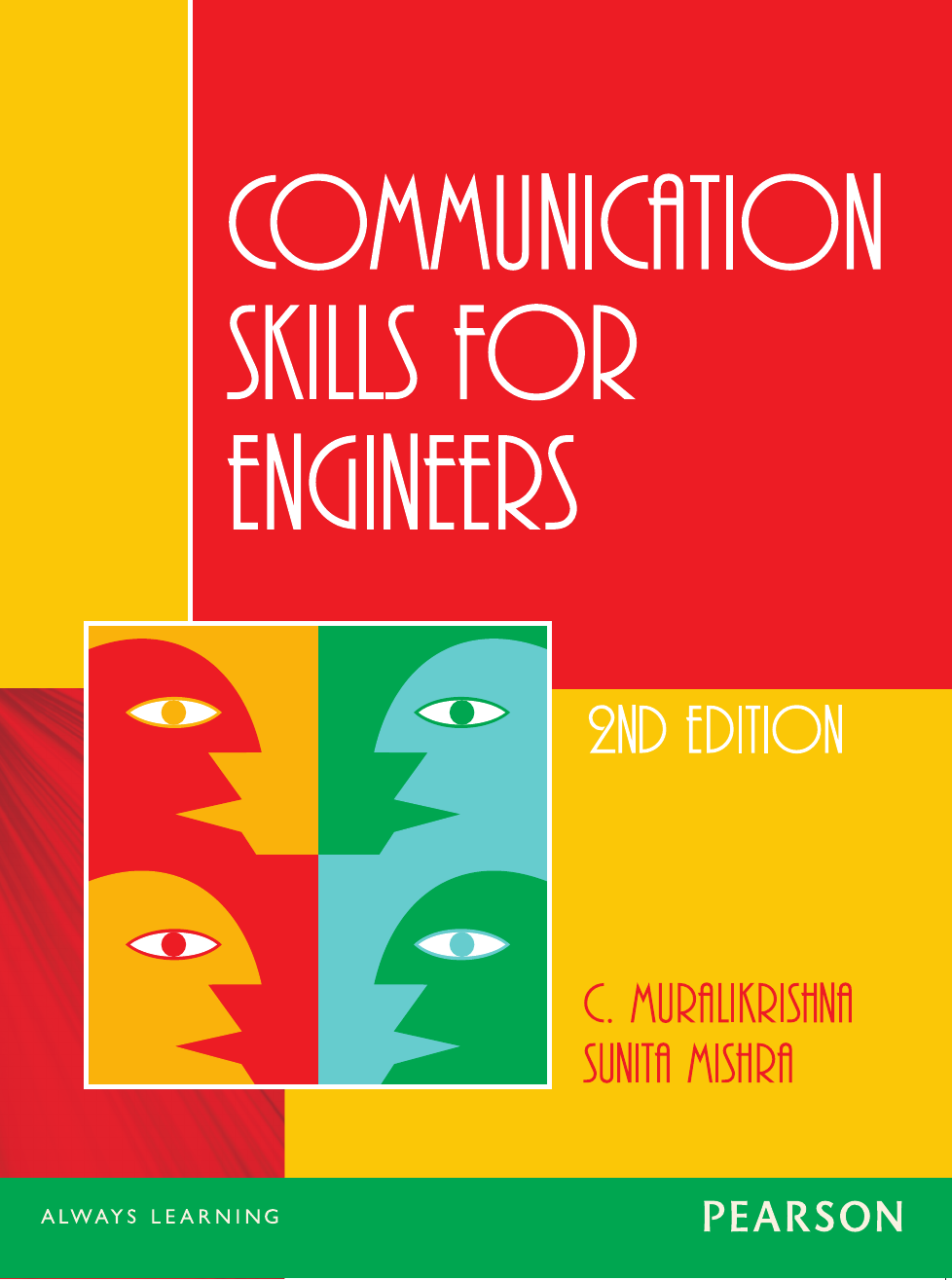

COMMUNICATION SKILLS
FOR
ENGINEERS
SECOND EDITION
'U6XQLWD0LVKUD
8QLYHUVLW\RI+\GHUDEDG
'U&0XUDOLNULVKQD
2VPDQLD8QLYHUVLW\
&RS\ULJKW'RUOLQJ.LQGHUVOH\,QGLD3YW/WG
/LFHQVHHVRI3HDUVRQ(GXFDWLRQLQ6RXWK$VLD
1RSDUWRIWKLVH%RRNPD\EHXVHGRUUHSURGXFHGLQDQ\PDQQHUZKDWVRHYHUZLWKRXWWKH
SXEOLVKHU¶VSULRUZULWWHQFRQVHQW
7KLVH%RRNPD\RUPD\QRWLQFOXGHDOODVVHWVWKDWZHUHSDUWRIWKHSULQWYHUVLRQ7KHSXEOLVKHU
UHVHUYHVWKHULJKWWRUHPRYHDQ\PDWHULDOSUHVHQWLQWKLVH%RRNDWDQ\WLPH
,6%1
H,6%19789332501348
+HDG2IILFH$$6HFWRU.QRZOHGJH%RXOHYDUGWK)ORRU12,'$,QGLD
5HJLVWHUHG2IILFH/RFDO6KRSSLQJ&HQWUH3DQFKVKHHO3DUN1HZ'HOKL,QGLD

CONTENTS
Preface vii
INTRODUCTION INFORMATION TECHNOLOGY AND
COMMUNICATION 1
Information Technology In India and the Process of Communication 1
Communication: Aspects and Issues 2
Vitals of Communication 3
Creativity in Communication 5
Communicating with Concern and Empathy 6
The Johari Window 8
Interpersonal Communication 9
Body Language 11
Persuasive Communication and Negotiation 12
Roles We Take on During Negotiation 13
Summary 14
Review Questions 15
PART I GRAMMAR MATTERS 17
CHAPTER 1 TENSES, THE ACTIVE AND THE PASSIVE VOICE, AND
REPORTED SPEECH 19
Tenses 19
The Passive 31
Reported Speech 34
Summary 37
PART II COMMUNICATION MATTERS 39
CHAPTER 2 NON-VERBAL COMMUNICATION: BODY LANGUAGE 41
The Communicating Body 41
Studying Body Language 42
Distance and Positioning 49
Body Orientation 50
Summary 54
Review Questions 54
iii

CHAPTER 3 LISTENING SKILLS 56
The Lynchpin of Communication 56
Hearing and Listening 56
Active Listening 57
Kinds of Listening 58
Barriers to Good Listening 61
Chinese Whisper 64
Good Listening 65
Summary 67
Review Questions 68
CHAPTER 4 SPEAKING AND NEGOTIATION SKILLS 69
The Art of Speaking 69
Speech Styles 70
Presentation Skills 73
Negotiation Skills 90
Summary 95
Review Questions 95
CHAPTER 5 READING SKILLS 96
Eye Movements and Chunking 96
Speed Reading 98
The SQ3R Method 102
Summary 104
Review Questions 104
CHAPTER 6 WRITING SKILLS 105
The Basics of Writing 105
The Process of Writing 107
Paragraph 109
Instructional Writing 112
Précis Writing 114
Abstract Writing 116
Note-Taking 119
Summary 121
Review Questions 122
CHAPTER 7 CREATIVITY AND MIND-MAPPING 123
Creativity 123
Times When We Are Creative 124
Contents
iv

Ways in Which You can be Creative 125
Developing Your Creativity 126
Factors that Block Creativity 128
Mind-Mapping: The Networking of Ideas 129
Mind-Mapping and the Learning Process 130
Mind-Mapping: Some Do’s and Don’t’s 134
Summary 136
Review Questions 136
CHAPTER 8 RÉSUMÉ WRITING, CURRICULUM VITAE (CV) AND
STATEMENT OF PURPOSE (SOP) 137
Deę nition of a Résumé 137
Guidelines for Eě ective Résumé Writing 140
Curriculum Vitae (CV) 143
Statement of Purpose (SOP) 148
Summary 152
Review Questions 153
CHAPTER 9 TEAM-TALK, GROUP DISCUSSION AND INTERVIEWS 154
Importance of Talk in a Team 154
ConĚ ict Management 156
Communication in Teams 157
Group Discussions (GD) 159
Structuring the GD 160
Interviews 162
Techniques of Interviewing 164
Preparing for an Interview 165
Kinds of Questions Expected at Interviews 168
The Interview Process 169
Summary 171
Review Questions 172
CHAPTER 10 TELEPHONE SKILLS, MEETINGS AND MINUTES 174
Telephonic Communication 174
Meetings 176
Minutes Writing 179
Summary 184
Review Questions 184
Contents
v

CHAPTER 11 BUSINESS LETTERS, TECHNICAL WRITING, E-MAIL WRITING 185
Business LeĴ ers 185
Business LeĴ er: Samples 190
Characteristics of a Good Business LeĴ er 193
Forms of Layout 197
Technical Writing 203
E-mail Writing 209
Summary 216
Review Questions 217
CHAPTER 12 REPORT WRITING, PROJECT AND PROPOSAL WRITING 218
Report Writing: Theory and Practice 218
Methods of Reporting 224
Proposal Writing 235
Summary 238
Review Questions 238
APPENDIX 239
Appendix A Vocabulary Expansion 241
Appendix B Common Errors in English Communication 254
Appendix C Practice Exercises 258
Appendix D Model Question Papers 264
Bibliography 275
Contents
vi

PREFACE
The learning and teaching of communications has generally been limited to the spoken and
the wriĴ en skills—presentations, group discussions, writing of leĴ ers, reports, etc. For stu-
dents enrolled in professional courses, it extends to document writing or maybe, project writ-
ing. Experience, however, shows that a good communicator has more than just these skill sets.
It is primarily an aĴ itude, a willingness to communicate, share one’s ideas and information
that makes one a good communicator. Language and the knowledge of the various formalities
associated with speaking and writing do maĴ er. However, given the right aĴ itudinal input,
communication becomes much easier and one emerges as an eě ective communicator.
This book discusses additionally these aĴ itudinal factors that make one a good commu-
nicator and links them up with the skill sets that enable eě ective communication. It speaks
of the writing and the speaking skills in the context of creativity, negotiation, interpersonal
skills and problem solving. Specię cally, the book aims at developing the communication skills
of Engineering and other professional students. For this target group, good communication
skills are necessary for recruitment and to enhance their opportunity for further growth in the
profession.
The book aĴ empts to locate the common communication needs of this group in diě erent
situations and to guide and equip the readers and learners to fulę ll them appropriately. The
book follows a skill-based approach. It isolates the skill sets required in diě erent communi-
cative situations, gives the students a comprehensive view of the requirements and ę nally
reinforces them further through exercises and activities.
Communication Skills for Engineers (CSE) thus is a comprehensive book that focuses on
the communication needs of users from the Engineering and other professional areas. It does
not look at “communications”—Ě uency in speaking and writing—in isolation but discusses
the whole aĴ itudinal framework that enables eě ective and purposeful exchange of informa-
tion. It aims at enabling students to identify and develop skill sets necessary to succeed in
their profession.
This second edition of CSE covers some additional topics that include a discussion of
grammar dynamics and activities thereof; information technology (IT) and communication;
the niĴ y-griĴ y of e-mail writing, interview skills; designing SOPs, a CV and Resumé writing,
and aspects of improving reading skills among others. This has been done to cater to a wider
range of felt needs among Engineering students and other professional students. To accom-
modate these additions, some of the earlier chapters have been collated appropriately. In this
process, we have tried our best to keep the book’s main points as well as its pedagogy intact.
We hope that the second edition of CSE will continue to help the students, teachers and
trainers from Engineering and other professional streams.
Acknowledgements
This book is a combined eě ort of many minds. It was conceived when we were teaching MBA,
and MCA students and took shape in the course of our lectures to B.Tech., B.E., B.A., B.Sc. and
B.Com. graduates. However, many inĚ uences have gone into its making. We would specially
like to thank the following people:
• Our teacher, Prof. N. Krishnaswamy, for his encouraging inĚ uence and useful advice.
He was instrumental in planting the idea of this book in our minds.
vii

• Late Prof. G. V. Raj for his valuable role in giving us the English language teaching
(ELT) orientation in our early days of teaching.
• Our students from Osmania University, Jawaharlal Nehru Technical University (JNTU)
and University of Hyderabad, whose responses and reactions helped to shape the con-
tents of the book in a big way.
• Prof. Tutun Mukherjee for her timely appreciation and for her assessment of our book
proposal.
• Dear friends like Vħ aya, Joy, Seetha and Srinivas for goading us to persevere in our ef-
forts and giving valuable suggestions and ideas.
• K. Srinivas, the then commissioning editor of Pearson Education who is now the pub-
lishing manager, for his relevant, practical and timely suggestions in the formative stag-
es of the book.
• Brig. Sambhi, former Principal of Karshak Engineering College, for his creative ideas
and suggestions.
• Our dear daughter, Shivani, for her growing understanding, and support and for hav-
ing put up with our preoccupied minds during the long months of writing.
Dr Sunita Mishra
Prof. C. Muralikrishna
Acknowledgements
viii

INTRODUCTION
Information Technology
and Communication
Objectives
This introductory section takes an overview of the role of Information Technology in communication
and also on the subject of communication. It discusses the different aspects and issues relating to com-
munication. It underpins the value of creativity in communication in addition to delving on interper-
sonal communication, body language, persuasive communication and negotiation.
INFORMATION TECHNOLOGY IN INDIA AND
THE PROCESS OF COMMUNICATION
Many outstanding technologies have come into the lives of people towards the end of the 20
th
century. This is especially true in the ę eld of electronics. Many electronic types of equipment
like mainframe computers, mini computers, personal computers, e-mail, cell phones, i-pods,
and other gadgets have become part of our lives. In this informaton age, we come across a lot
of personal or oĜ ce data that needs to be processsed by computers and this is called informa-
tion technology or IT.
Information technology (IT) accounts for a signię cant part of India’s GDP and export earn-
ings, while providing employment to a large number of its tertiary sector workforce. Techni-
cally equipped immigrants from India have been seeking jobs in the western world since the
1950s as India’s education system produced more engineers than its industry could absorb.
Thus, India’s growing stature in the information age enabled it to form close relations with
both the United States of America and the European Union.
Out of around 400,000 engineers produced per year in the country, approximately, about
100,000 are well equipped in both technical competency and the English language skills. India
has developed a number of outsourcing companies specializing in customer support through
the Internet or telephone. For instance, by 2008, India had a total of 49,750,000 telephone lines
in use, a total of 233,620,000 mobile phone connections, a total of 60,000,000 Internet users—
comprising 6.0% of the country’s population, and 4,010,000 people in the country had access
to broadband Internet— making it the 18th largest country in the world in terms of broadband
Internet users. Total ę xed-line and wireless subscribers reached 325.78 million in June, 2008.

Communication Skills for Engineers
2
On the other hand, from the dynamics point of view, it needs to be mentioned that Manage-
ment Information Systems (MIS) has assumed vital importance. MIS is the application of IT to
the communication process in organizations. Generally, in MIS most of the information pro-
cessing is done by the computers. The span of activities undertaken by MIS includes among
others generating, processing and transmiĴ ing information. MIS is used for interpersonal and
organizational communication in addition to strategy planning and improving customer care.
Thus, managers can seek vital clarię cations, information from and give instructions and direc-
tions to fellow-personnel of the organization through the systems.
An important eě ect of IT on organizations is one of leveling. Personnel in organizations,
whether they are superiors or subordinates, work in an information-sharing ambience where
everybody is involved non-hierarchically in the developmental work of the organization. In-
terestingly, the IT age continues to demand proę ciency in English communication skills from
most of its initiators, mid-level force and end-users. It is in this context that one needs to look
at the niĴ y-griĴ y of communication.
COMMUNICATION: ASPECTS AND ISSUES
When American playwright and diplomat Clare Boothe Luce visited George
Bernard Shaw in his London Ě at years ago, she found him writing at his desk.
To express her admiration, she began, “Mr Shaw, you are the only reason I’m
standing here.”
Shaw looked up and replied, “Who did you say your mother was, my child?”
(Reader’s Digest)
Communication, as we see it here, can be a complicated process of give-and-take with
innumerable intricacies and dimensions. OĞ en, however, it is seen as a set of competencies,
primarily including the wriĴ en and the spoken mode. It is taught as a package involving
training in skills pertaining to writing, speaking, reading and listening (L. S. R. W). But gen-
eral observation shows that eě ective communication involves a lot more than proę ciency in
the L. S. R. W skills. More than language, it needs an aĴ itude, a willingness to give and take; to
open up to others and accept others; to have empathy and capacity to look at situations from
varied perspectives. Given these aĴ itudinal factors, language becomes just an aid to promote
communication. This chapter aims to give an overall view of most of these important factors
and show how they enable communication.
A complicated process in itself, communication takes place all around us all the time. In
fact, we all spend around 70% of our time receiving or sending messages. Essentially, it in-
volves the sender or the communicator, and the receiver. It is sent in a certain medium through
encoded messages. The receiver, in turn, decodes the message and sends back the reactions
to the sender in the form of feedback. The beauty of the whole process, however, lies in the
nature of communication itself. Language, be it in any form, has the potential to mean many
things at the same time. Thus, the sender sends a message, which the receiver is free to make
meaning of depending on the mode of transmission, the kind of encoding and of course, more
importantly, the receiver’s own state of mind while receiving the message.

Introduction
3
VITALS OF COMMUNICATION
The features that have been looked into in this section are, function of language and elements
of human communication.
The Function of Language
Language embodies and conveys thought. It is an important means that we rely on to convey
our thoughts and feelings. In its spoken and wriĴ en forms, language is the commonest and
most important means of communication in all social activities among human beings. Along
with language there are other elements, which contribute to communication. In the following
section, some of these elements are brieĚ y examined.
Elements of Human Communication
Human communication, as a process, is not a dull and passive process. It is a dynamic and
active process comprising several important elements. These elements may be enumerated
as follows:
1. Initiation: Communication begins when a source initiates a statement. A statement is ini-
tiated in order to transmit some thought, need, idea or information. The receiver aĴ ends
to the statement transmiĴ ed by the source, interprets the statement and decides how to
respond.
2. Feedback: The response of the receiver that is sent back to the source forms the feedback.
The source modię es further statements based on the feedback. Feedback helps the source
to know if the message was received correctly or not.
3. Channel: Channel connects the source (e.g. a speaker) and the receiver (e.g. listener). A
speaker and a listener are connected to each other by sound waves and (or) the light
waves. That is, language carried by sound waves; and facial expressions and body ges-
tures carried by light waves.
4. Situation: Situation is the place or seĴ ing in which a communicative event occurs.
5. Purpose: Purpose consists of the intention of the source, or speaker. It is the communica-
tive aim of the speaker.
6. AĴ itudes: The speaker and the listener, carry with them certain ideologies, world-views,
beliefs, likes, dislikes and aptitudes. They are also under the inĚ uence of varying emo-
tional and mental states. These factors aě ect the aĴ itudes of the speaker and the listener
at the time of communication.
7. Knowledge: The speaker has to possess adequate knowledge of the message that is to be
transmiĴ ed. Knowledge that is based on observation, study and personal experience
helps the speaker to communicate eě ectively.
8. Expression: Expression consists of the ability to transmit or communicate. Fluency, clar-
ity and intelligibility of expression pave the way to eě ective communication. The Ě ow of
information, as embodied in the message that is transmiĴ ed, is smooth when expression

Communication Skills for Engineers
4
is clear. This helps the speaker and the listener to avoid communication gaps and also
arrive at consensus and decisions. Improper or faulty expression leads to breakdown of
communication.
9. Language: Language is one of the most important elements of the communication process.
The eě ective use of language consists in selecting appropriate words and paĴ erns of sen-
tences while communicating. These linguistic paĴ erns, suitably supported by facial and
body gestures, enable eě ective communication.
10. Intellectualism: Communication is sustained and it becomes eě ective only in an intellec-
tual ambience. That is, the speaker and the listener have to express and understand views
calmly, rationally, reĚ ectively, precisely and eĜ ciently. When intellectualism is absent,
thoughts and ideas are likely to be ineě ectual.
See What This Communicates!
Once upon a time, there were four people. Their names were Everybody, Some-
body, Nobody and Anybody. Whenever there was an important job to be done,
Everybody was sure that Somebody would do it. Anybody could have done it,
but Nobody did it. Everybody got angry because it was Everybody’s job. Ev-
erybody thought that Somebody would do it, but Nobody realized that nobody
would do it. So consequently, Everybody blamed Somebody when nobody did
what Anybody could have done in the ę rst place.
ACTIVITIES
1. Read the sentences below (A) and see in how many diě erent contexts you can use
them. Create small contexts around them and use them to illustrate the given modes
of expression(B). Add more to the list if you can.
A B
a. The door is open. Giving information
Making an oě er
Rejection
Acceptance
b. You are joking! This can’t be true. Extreme happiness
Shock
Anger
c. The possibilities are endless. Appreciation /Frustration
Amazement /Confusion

Introduction
5
2. Try to read the following groups of sentences separately stressing the underlined word.
Make a note of the diě erent meanings that emerge.
(A)
Even he does not write regularly.
Even he does not write regularly.
Even he does not write regularly.
(B)
You don’t know me?
You don’t know me?
You don’t know me?
(C)
Yes. I don’t remember.
Yes. I don’t remember
Yes. I don’t remember
(D)
Is this possible?
Is this possible?
(E)
I can’t write the examination.
I can’t write the examination
I can’t write the examination
CREATIVITY IN COMMUNICATION
While doing the above exercises, you must have realized that responding to a communica-
tional situation needs creativity. The meaning has to be always put together like the pieces of a
jigsaw puzzle. One always has to “make” the ę nal picture for oneself. When we talk of creativ-
ity in communication, we mean the capacity to read hidden messages, to see a link not seen
before, to infer the unsaid, unspelt consequences or even to tailor a response that can alter a
communication situation to one’s advantage! A wiĴ y creative receiver can create meanings in
the encoded message the sender had never imagined. Creativity in day-to-day interactions is
also one’s ability to break out of stereotyped reactions, to see beyond the set, accepted paĴ erns
and give a novel twist to existing “reality” or beĴ er still, create a “reality”!
Albert Einstein was travelling to universities in a chauě eur driven car, deliver-
ing lectures on his theory of relativity. One day while in transit, the chauě eur
remarked:
“Dr.Einstein, I have heard you deliver that lecture thirty times. I know it by
heart and bet I could give it myself”. “Well, I will give you the chance,” said
Einstein. “They don’t know me at the next college, so when we get there I’ll put

Communication Skills for Engineers
6
on your cap, and you introduce yourself as me and give the lecture”. The chauf-
feur delivered Einstein’s lecture Ě awlessly. When he ę nished, he started to leave,
but one of the professors stopped him and asked a complex question ę lled with
mathematical equations and formulas. The chauě eur thought fast. “The solu-
tion to that problem is so simple”, he said, “I’m surprised you have to ask me. In
fact, to show you just how simple it is, I’m going to ask my chauě eur to come up
here and answer your question.”
— Readers Digest
ACTIVITIES
3. Given below, is a list of ten sentences. Take one minute to think about each and talk on
it for a couple of minutes.
The sky is blue
The height of success.
The ceiling is very high.
Bicycling under water is fun.
Classes are not to be aĴ ended.
It is fun to fail.
Among the stars.
Children are mean.
The blackboard is green.
My useless fridge.
4. Try to establish links between the pairs of objects given and talk about each of the
pairs.
Apple // Computer
Horse // House
Armchair // Fridge
Star // College
Pigs // Saints
Trees // Chocolates
Hill // Eagle
Insect // Money
Bird // Ceiling
Chair // Piano.
COMMUNICATING WITH CONCERN AND EMPATHY
Very oĞ en we come across managers who would say: “I do a lot for my employees. I expect a
lot out of them. I work hard to be friendly towards them and treat them right. However, I feel

Introduction
7
they are ungrateful. I think if I stayed back at home for a single day they would waste time at
the oĜ ce canteen. What can I do to make them independent and responsible?”
Problems like this are common. A large part of it is because we fail to communicate our
concern or empathy. A very closely related quality that plays an equally important role in com-
munication is empathy. Empathy is a quality that will allow you to understand the mental
and psychological state of the person we are communicating with. This will help us to adapt
our response and pitch it at an acceptable and appropriate level. Important here is the con-
cept of empathetic listening, which can be explained as listening with a view to understand.
We generally listen with an intent to reply. Most of the times, we are either talking or geĴ ing
ready to talk. When we listen, we generally listen at one of the four levels. We may be ignor-
ing the person, not really listening at all. We may be pretending to listen. We may be doing
selective listening, hearing only certain parts of the conversation, or we may be practising at-
tentive listening, paying aĴ ention to every word that is being uĴ ered with utmost care. What
is required oĞ en, however, is empathetic listening that forms the ę Ğ h grade of listening.
This is something beyond the skill-based acquisition of the skill. Here listening is done with
a purpose to understand, to see the world from the speaker’s perspective intellectually and
emotionally, but not necessarily agree with the speaker. This kind of listening has an almost
therapeutic eě ect on both the speaker and the listener, primarily because it gives a person a
“psychological air”. This “psychological air” deeply impacts communication, expanding both
the speaker’s and the listener’s area of inĚ uence on one another. Paradoxically, this kind of
listening is also risky. To listen deeply, one also has to open oneself up and become vulnerable.
To have inĚ uence, thus, one has to risk being inĚ uenced.
The poet doesn’t invent. He listens.
—Jean Cocteau
Listening to a Disturbed Person
At some point or the other, all of us have been disturbed or we have interacted
with people who are disturbed. It could be a friend who feels that injustice has
been done to him/her at the workplace, or a neighbour whose feelings have been
wounded.
Some people are good at expressing their hurt feelings, some are not. Some-
times, we even try to suppress them and push them to the back of our mind. But
unexpressed feelings do not disappear. They are like springs. You push them
down but they express themselves sooner or later, may be at the wrong place or
time.
A person who has suppressed feelings cannot act or think straight because
he/she does not feel straight. Only aĞ er the feelings are released can the per-
son think straight and look into the problem objectively. Above everything else,
more than advice, evaluation or judgement, a disturbed friend needs to fulę ll
the desire to be understood.
Do not listen to their words, listen to their feelings. Respond with the whole of
yourself. The best way to ‘talk’ to a disturbed person is to listen.

Communication Skills for Engineers
8
THE JOHARI WINDOW
The concept of the Johari window is an important idea that explains factors behind mutu-
al understanding. Named aĞ er Joseph LuĞ and Harry Ingram, it explains communications
along two dimensions: exposure and feedback. Exposure is the extent to which the individual
is willing to divulge his feelings and information in trying to communicate. Feedback is the
extent to which the individual manages to elicit exposure from others. They translate these
factors into four windows—open, blind, hidden and unknown (see Fig.1). The “open” win-
dow is the information about you, which you as well as others can see. The “blind” window
encompasses the factors about you that others can see but not you.
This, oĞ en, is the result of your defensive behaviour that prevents
others from telling you things about yourself. The “hidden” win-
dow is the information known to you but unknown to others. These
include facts about yourself that you hide from others. Finally, the
“unknown” constitutes factors that that neither you nor others are
aware of. Advocates of the Johari window see openness, authentic-
ity and honesty as valued qualities in interpersonal relationship.
They also imply that it is in the interest of the individual to expand
the size of the “open” window, increase self-disclosure and be more
willing to listen to feedback from others about oneself.
ACTIVITIES
5. Select a relationship in your life where your emotional account is nil. Write ę ve reasons
from your perspective on why you think the situation is so. Now try and approach the
problem from the other person’s point of view and review the situation. Were your as-
sumptions all correct?
6. Give ę ve reasons for and against the statements given below.
1. Siblings can be your best Siblings are one’s greatest
friends because, enemies because,
a.
a.
b. b.
c. c.
d. d.
e e.
2. You are your greatest friend You are your greatest enemy
because, because,
a. a.
b. b.
c. c.
d. d.
e. e.
Open Blind
Hidden Unknown
Figure 1: Johari Window

Introduction
9
3. Holidays are wonderful Holidays are not wonderful
a. a.
b. b.
c. c.
d. d.
e. e.
4. Higher education should be Higher education should not be
subsidized subsidized
a. a.
b. b.
c. c.
d. d.
e. e.
5. Children are cruel Children are not cruel
a. a.
b. b.
c. c.
d. d.
e e.
7. Recall any incident in your life, which brought forth in you something that, belonged
to the “unknown window” till then. How have you been managing that aspect/quality
since then?
8. Imagine, you have just died and your friends want to put up your picture in your class
with the following words wriĴ en below:
“Here was a person who… ”
Complete the paragraph in about 30 words.
INTERPERSONAL COMMUNICATION
I can live two months on a good compliment.
—Mark Twain
Possessing good knowledge of interpersonal relations and being able to achieve the delicate
balance that communication requires goes a long way in ę ne-tuning our reĚ exes to achieve
eě ective communication. For instance, it would be extremely inappropriate on our part to
complain to a new recruit at our oĜ ce against the boss or a nagging spouse at home. It is very
important to be able to decide who should be told what, when and how.
Communication is generally divided into ę ve levels, depending on the nature, scope and
depth of interaction:

Communication Skills for Engineers
10
Passing Communication
This refers to the daily niceties or phatic communication paĴ erns like “hello, good morning”
and “good night” etc. The purpose here is to merely acknowledge the person’s presence. Here
a detailed response is neither expected nor given. When somebody wishes you in oĜ ce say-
ing “Hello! How are you?” you deę nitely do not sit back and say, “Not well at all! Know what
happened on the road today?…”
Factual Communication
OĞ en, most of the organizational work depends on the exchange of factual information. Giv-
ing instructions, evaluating and passing on information accurately and concisely fall under
this category. Interpersonal communication is carried on here with minimal possible emo-
tional risk. Examples of such communication are: Is the report ready? Has the new employee
joined today? How many more customers are there to meet?
Thoughts and Ideas
Here, the exchange is at a slightly higher level of communication. This includes exchange of
ideas that suggests a more involved interpersonal communication. However, it also throws
open the possibility of rejections – hence, the risk involved is more.
Feelings
The feeling level of communication involves a higher degree of risk. During this kind of in-
teraction, there is exchange of sentiments and feelings making the sender vulnerable to rejec-
tion.
Peak Communication
This is the highest level of communication that is most diĜ cult to achieve. It ensures perfect
understanding between two individuals or a group of individuals. Creativity and a synchro-
nized work culture are the building blocks of this kind of communication.
A bore is a man who, when
you ask him how he is, tells you.
—Bert Leston
ACTIVITIES
9. Look at the statements given below and categorize them into the diě erent communica-
tion levels.
1. Oh God! It’s late already.

Introduction
11
2. Will you ever learn to see straight?
3. I think we have reached the end of the road.
4. How do you do?
5. It’s rather late, isn’t it?
6. I agree that capitalism has its merits but we can’t overlook its demerits.
7. We all agree. We can achieve this together.
8. Have you received any answer to the leĴ er?
9. It is a pleasure working together. How else do you think we have survived our
boss?
`10. I strongly believe that the developed countries are causing more harm to humanity
than the underdeveloped ones.
10. Complete the following incomplete dialogue using three diě erent situations illustrat-
ing the 2
nd
and 3
rd
levels of communication:
A.
B. Oh yes! I know.
A.
B.
A . Sure. I’ll remember.
People who feel good about themselves produce good results.
—Henneth Blanchard and Spencer Johnson.
BODY LANGUAGE
Body language is an important factor that one has to keep in mind while communicating.
Most of our communication in every day maĴ ers takes place through body language. Most
important are the gestures, the tone and the facial expression. If the spoken words do not
match the body language, it is the message covered by the body language that creates the ę nal
and lasting impression.
The body language of the person who is being spoken to is of immense importance for a
good communicator. It is an important feedback not only to decide how one’s message has
been accepted but also to determine whether it is the right time to convey the message at all!
Arms folded around one’s chest, for example, can signify a defensive aĴ itude. It could
mean “I don’t want to know” or “I feel vulnerable as you talk to me”. If the ę sts are clenched,
in addition, it suggests holding back of emotion or information; ę nger on the lips while speak-
ing can show incongruence of thought or speech. Looking away while someone is speaking or
rubbing the eye deę nitely suggests avoidance. The siĴ ing posture also can signify the aĴ itude

Communication Skills for Engineers
12
of the speaker. Reversing the chair and siĴ ing, or leaning over the back can indicate power
and control. Slumping with arms folded or clasped on the lap can convey dejection or submis-
siveness, while leaning back on the chair with legs crossed and hands behind the back signify
authority, the “I don’t need to fear you at all!” aĴ itude.
While it is necessary to consider body language as an important clue in the communicative
process, one should also remember that it is largely situational. They do not mean anything by
themselves, but acquire their precise meaning only in association with other symbols.
ACTIVITY
11. Given below is a list of ten activities. Form groups of two and enact the situations with-
out talking. Ask the class to guess the situation. Discuss the responses and clues on the
basis of which they formed their opinion.
a. A father is indignant because he feels his son is going astray and not concentrating
on his studies. The son feels his father is unnecessarily pressurizing him.
b. Two friends have met aĞ er a long time at a party. They are overjoyed to ę nd one
another and are engrossed in their talk.
c. You are trying your best to convince your client that the soĞ ware you have newly
developed will work. He, however, is sceptical about the whole product.
d. Your teacher is trying hard to explain a concept to you. In between, he forgets a
name and is trying hard to recollect it.
e. Your subordinate is trying hard to Ě aĴ er and praise you. You, however, are very
suspicious of his motive .You want to tell him so, but you are holding back out of
courtesy.
f. Your friend has come to you with a grave professional problem. You are thinking
hard of the possible solutions. Your friend, too, is troubled.
g. You are a junior employee in a company. The company is facing a ę nancial crisis and
laying oě people. You have been called into the boss’s room and asked to sit. The
boss looks grave and you are nervous.
h. A colleague is very enthusiastically trying to explain a plan to you. You are alert,
eager and taking in every word.
i. You are wild with your employee but trying to control your anger. Your employee is
conscious of his guilt and is apprehensive.
j. You are worried, tensed and very confused. Your friend is trying to cool you down
and comfort you. She is strong, cool and conę dent, but very concerned.
PERSUASIVE COMMUNICATION AND NEGOTIATION
In the ę lm titled “The Shop Around the Corner”, a character says, “when my
boss calls me an idiot, I agree. AĞ er all, I’m no fool.”
—Readers Digest.

Introduction
13
OĞ en we judge situations, decide our role in the context and react in the way we consider
appropriate. A very important skill that is used subtly in all communication situations is “ne-
gotiation”. To be able to negotiate during communications, one has to be ę rst conscious of
one’s role and also see how others perceive it. This is followed by each participant demarcat-
ing his area of operation and negotiating space, and deciding whether and how much to em-
power the other participant. The next stage is one where the exchange is decided. The terms
and conditions here are largely a fallout of the ę rst two factors.
The nature of exchange one proposes or accepts depends on the role one has ę xed for
oneself and also the degree of empowerment that has been negotiated and agreed upon. The
next and ę nal stage can be called the disclosure stage that comes by if the ę rst three stages
have been positively set. At this stage, participants let down their barriers and are willing to
disclose information about themselves. This stage is risky, but it also paves way for successful
“peak” communication. Participants moving through exchange and disclosure stage commu-
nicate with a high sense of interpersonal rapport.
ROLES WE TAKE ON DURING NEGOTIATION
Psychologists believe that the roles we take up during interaction are either that of the parent,
the adult or the child. The parent role largely constitutes the “that is how it is” aĴ itude. It also
includes admonitions, giving rules, laws and value judgments. The child is the impulsive and
emotional aspect of a person that can throw tantrums and get depressed. Simultaneously, it
also includes creativity and curiosity of a person. The third side to an individual is his adult
– the aspect that weighs, decides and displays appropriate emotions and expressions. During
interpersonal communication, transaction can take place between similar roles in individuals
or between diě erent roles. The negotiation could be between the parents in two individuals,
between the parent in one and child in another or between the adult in one and parent in the
other. What is important here is that, during negotiations one should be conscious of the role
he himself is playing, recognize the role the other is adopting and react accordingly. Some of
the factors that play an important role while negotiating successfully are given below:
• Be conscious of the way you and your participants have positioned yourselves and the
factors that each is looking for in the communication situation.
• It helps oĞ en if the participants are fair and willing to commit themselves. A commu-
nication situation built on a sense of fairness and trust can result in strong, satisfying,
lasting relationships.
• We oĞ en conclude that our win depends on somebody’s loss and we work towards a
win-loose situation. Eě ective communication situations however are oĞ en built around
win-win situations. The situation allows both parties to beneę t or empower themselves,
either materially or emotionally.
Two Most Common Traits of Managers Who Failed
1. Rigidity: they were unable to adapt their style to changes. They were unable to re-
spond to feedback. They couldn’t listen or learn.
2. Poor relationships: they were harshly critical, insensitive or demanding. They alien-
ated those when they worked with.

Communication Skills for Engineers
14
ACTIVITY
12. Given below are two situations. Analyze them, discuss what kind of negotiation situa-
tion they project and think of solutions.
a. An old piano is for sale. The prospective buyer and the seller agree on the cost. The
buyer ę rst wants the chair and then the musical pages to be given free. The seller
agrees. Encouraged, the buyer next wants the delivery also to be done free.
b. Ravi is the head of a designing team in a company producing electrical equipments.
He has a good team, he gives innovative ideas and leads them from the center. Of
late, however, he has been experiencing burn out, and exhaustion. He has spoken to
the boss and arranged for a two-week vacation with his family. A week before leav-
ing, the company gets the news that top executives from an internationally reputed
company will be coming for a visit to see the prototypes developed. Ravi’s boss
feels that he should stay back and take care of the presentation since he himself has
designed most of the products and is the backbone of the team. He even thinks that
with his impressive persuasion he might be able to increase the budgetary alloca-
tions for the department. Ravi, however, feels that he must go because the team can
take care of the presentation. His wife too has arranged for leave in her oĜ ce and it
will not be possible to postpone it for a later time.
SUMMARY
• The IT age reinforces the continuing demand for proę ciency in English communication
skills from most of its initiators, mid-level force and end-users.
• Communication is a complicated process of give-and-take with innumerable intricacies
and dimensions.
• For communication, more than language, what is needed is an aĴ itude, a willingness to
give and take; to open up to others and accept others; to have empathy and a capacity
to look at situations from varied perspectives.
• Creativity in day-to-day communication is one’s ability to break out of stereotyped re-
actions, to see beyond the set and accepted paĴ erns.
• Empathy is a quality that will allow one to understand the mental and psychological
state of the person we are communicating with.
• The two dimensions of communication, according to the Johari window are, exposure
and feedback. These can be looked at through four windows—open, blind, hidden and
unknown.
• It is always desirable to expand the size of the ‘open window’, increase self-disclosure
and be more willing to listen to feedback from others about oneself.
• Passing communication, factual communication, thoughts and ideas, feelings and peak
communication are the ę ve levels of communications based on the nature, scope and
depth of interaction.

Introduction
15
• Much of eě ective communication is non-verbal. Body language is an important factor
of the non-verbal communication.
• Negotiation depends on the nature of exchange one proposes or accepts. It depends on
the role one has ę xed for oneself and the degree of empowerment that has been negoti-
ated and agreed upon.
• The roles people take during interaction can be that of the parent, the adult or the
child.
• Eě ective interpersonal communication depends on appropriate handling of these three
roles.
REVIEW QUESTIONS
1. What is Information Technology?
2. What are the eě ects of MIS on organizations?
3. What is communication?
4. What factors are necessary for eě ective communication?
5. What is creativity in the context of day-to-day communication?
6. What is the function of language?
7. What are the elements of human communication?
8. What is empathy?
9. What do you understand by the term ‘Johari window’?
10. What are the implications of the Johari window?
11. What are the diě erent levels of communication?
12. How are these levels of communication related to interaction?
13. How is the nature of a specię c interaction determined?
7KLVSDJHLVLQWHQWLRQDOO\OHIWEODQN
PART 1
Grammar Matters
7KLVSDJHLVLQWHQWLRQDOO\OHIWEODQN

CHAPTER 1
Tenses, the Active and the Passive
Voice, and Reported Speech
Like everything metaphysical,
the harmony between thought and reality
is to be found in
the grammar of the language.
—Ludwig WiĴ genstein
Chapter Objectives
This section aims to give the students the basics of grammar. It deals with tenses, the active and the
passive voice and the reported speech. It also deals with the main and auxiliary verbs, the fi nite and the
non-fi nite verbs and the way they are used in the different tense forms. The chapter deals with grammar
within very limited space. Hence, only some of the very important concepts have been dealt with.
TENSES
The verb The verb is one of the most important elements of English grammar. It can be de-
scribed as a word that expresses action in a sentence. Look at the following expressions.
a. You wait patiently.
b. You wait.
c. Wait patiently.
d. Wait.
e. patiently
f. you

Communication Skills for Engineers
20
The fi rst four here can be seen as complete expressions. They can stand alone. The last two, however,
cannot be independent. The main difference between them, if you see closely, is that the last two do not
have a verb. It is the verb that forms the nucleus of a sentence. Hence, it makes the sentence meaningful.
We can have a sentence with only the verb but there cannot be any sentence without a verb.
The Main and the Auxiliary Verbs
Now, look at the following sentences:
a. Children play happily.
b. We can do the work in three days.
c. The workers have been working overtime.
d. The typed papers had been lying on the table for months when the enquiry was made.
In the ę rst sentence, the verb is “play”. It expresses the action in the sentence. But in the
second sentence, the verbs are, “can” and “do”. And in the third sentence, “have”, “been” and
“working’ are verbs. These verbs, however, are not similar. They are either the main or the
auxiliary verb. Generally, words like “play”, “do” or “work” are the main verbs. And words
like “can”, “have”, “been”, etc, are the auxiliary verbs. It could be said that words that express
the action in a sentence are the main verbs while verbs that help determine the time frame are
auxiliary verbs. The following are the categories of words we use as auxiliaries.
“Modal” forms -- can, could; will, would; shall, should; may, might; must, ought to.
“Be” forms – is, am, was were, are.
“Have” forms—have, has, had.
Now, change the tense of the sentences given above:
a. Children played happily.
b. We could do the work in three days.
c. The workers had been working overtime.
d. The typed papers have been lying on the table.
We ę nd in each of the cases that one of the words identię ed as the auxiliary verb changes
the form in case of a tense change. But in case there is no auxiliary verb, the main verb changes
its form (as in the case of the ę rst sentence).
A sentence will always have only one main verb. But it can have one or more than one
auxiliary verbs.
Look at some more sentences:
a. Man is mortal.
b. This city has an eĜ cient government.
c. All children are creative by nature.
d. Dinosaurs were both vegetarian and non-vegetarian.

Tenses, the Active and the Passive Voice, and Reported Speech
21
These sentences have the words we have earlier identię ed as auxiliary verbs. But as you
see, they are the only verbs in the sentence. Hence, they are the main verbs in these sentences.
One proof of this is that, in case of a change of tense too, these forms will undergo change.
ACTIVITY
1. Look at the following sentences and identify the main and the auxiliary verbs in each.
Point out when the main verb is changing its tense.
a. The identities of the people were not revealed.
b. The glaciers in the north and the south pole are melting fast.
c. The atmosphere is geĴ ing polluted very fast.
d. The rare birds had leĞ their habitat before the team of experts could reach them.
e. I have broken my hand.
f. This building has stood the test of time.
g. We have been waiting for the bus since ę ve o’ clock.
The Finite and the Non-Finite Verb
One more distinction you should keep in mind is that between the ę nite and the non-ę nite
verb. The verb which carries the tense in a sentence is always the Finite verb and the others are
the non-ę nite verbs. Look at the following pairs of sentences—
a. the grass on the other side is always green.
b. the grass on the other side was always green.
c. the grass on the other side has been always green.
d. the grass on the other side had been always green until we crossed over and saw it for our-
selves.
We ę nd that in the ę rst pair, there is only one verb and naturally, it caries the tense. But in
the second pair, there is more than one verb, and when there is an auxiliary verb, it is the auxil-
iary that caries the tense. In a sentence, the verb which carries the tense is called the ę nite verb
and the others are called the non-ę nite verbs. If a sentence has only one verb, the main verb is
the ę nite verb. But if there is more than one verb, the verb carrying the tense is the ę nite and
the rest are non-ę nite verbs. It is necessary for you to be clear about these two types of verbs
to master the tenses that follow in the later sections.
The Forms of the Verb
Look at the following sentences:
a. We walk to the ground every morning.
b. The bus generally arrives on time.
c. The children played the whole day yesterday.
d. The executive members are planning for a meeting next month.
e. The students have seen the exhibition.

Communication Skills for Engineers
22
These ę ve sentences use the ę ve forms of the verbs that are used in diě erent ways to ex-
press the tenses. The ę ve forms are the following:
a. The base form: walk
b. The –es form (the third person singular): arrives
c. The past tense form: played
d. The be –ing form: planning
e. The have –en form: seen
These are the ę ve forms of the verb in English. It is important to note that these are the dif-
ferent grammatical forms of tenses. The tenses in English do not necessarily coordinate with
the times they express. Hence, it is important to see how these diě erent forms express the
diě erent time sequences. Given in the units that follow, are descriptions of the tense form and
the time sequences they express.
The verb “be” has ę ve forms—”is” “am” “are” “were” “was”. The ę rst three are
used for the present tense form and the last two for the past tense form.
The Simple Present Form
Look at the following sentences:
Rammohan drives the buses in this route.
Mahanadi Ě ows into the Bay of Bengal.
We experience the eě ects of ozone depletion every day.
He/she feels it is good in the long run.
They/we feel it is good in the long run.
The simple present tense, we have seen, uses two forms—the third person singular –es
form and the base form. We use it to indicate things that happen all the time and to show uni-
versal truths:
a. The earth goes around the sun.
b. The moon reĚ ects the rays of the sun.
c. The Ě ight takes oě at 5 pm.
d. Continuous working leaves one tired and exhausted.
Sometimes we also use the simple present to show how oĞ en we do things or how oĞ en
things happen.
a. Rohit sometimes plays cricket.
b. How oĞ en do you go to the dentist?
c. We usually take the road to the right of the park.

Tenses, the Active and the Passive Voice, and Reported Speech
23
We use do/does to express questions and negative sentences:
a. Do you believe in Darwin’s theory of evolution?
b. Rice doesn’t grow in cold countries.
c. We don’t oĞ en do things according to others wishes. Do we?
ACTIVITY
2. Fill in the blanks by using the right form of the verb given in brackets.
a. The shopping mall
(open) at 9am everyday.
b. We oĞ en
(see)
c. I have a jeep but I
(do) drive it oĞ en.
d. The river Amazon (Ě ow) into the Pacię c Ocean.
e. How oĞ en
(do) you write to your parents?
The Present Continuous Form
Look at the following sentences:
Don’t make so much noise. I am studying.
It is not possible to go out now. It is raining.
Have you heard the latest? Ram is ę nally writing the report.
Can you call the children inside? They are making a lot of noise.
The present continuous uses the “be (is, am, are)—ing” form of the verb. It is used to denote
action continuing the present at the moment of speaking.
a. Talk slowly. The patients are resting.
b. We have to go soon. Sheela is leaving.
c. Take an umbrella with you. It is raining.
d. Be careful. The vehicle is still moving.
It is also used to show action around the time of speaking.
a. You are working a lot today. Do you have a deadline to meet?
b. The population is rising very fast.
c. Your English is geĴ ing beĴ er. Keep trying.
ACTIVITY
3. Fill in the blanks, using either the simple present or the present continuous(be —ing
form of the verbs put in brackets. Indicate which of these situations are temporary and
which are permanent.

Communication Skills for Engineers
24
a. Arundhati is in India now. She (stay) at the Taj Banjara. She generally
(stay) there whenever she visits.
b. My parents
(live)in Delhi now. But we are from Bhubaneswar.
c. I
(teach) Physics. But this semester, I (teach) Mathemat-
ics too!
d. I generally
(drive) the bike. But because of a shoulder pain I
(drive) the car these days.
e. He never
(smoke) in public. Looks like something is diě erent today.
We ę nd in these sentences, that the combination of the simple present and present continuous
is also used to show the diě erence between the permanent and the temporary. There are some
verbs in English that can be used in the simple present form only, even when they denote the
present continuous action. For example, we can say
a. “I don’t understand you.” Not, “I am not understanding you.”
b. “I believe you.” Not, “I am believing you.”
The following are some of the verbs that cannot be used in the present continuous form.
want need like love belong see hear
realize mean forget remember prefer seem know
Simple Past
Look at the following sentences:
a. Look! it is raining again.
b. Yea. And it rained the whole of yesterday too!
c. I am hiring a taxi to go to work today. What about you?
d. I usually work from home on such days. Guess I’ll do the same.
The simple present generally uses the “–ed” to form the past tense. However, there are
many important verbs that are irregular.
a. leave—leĞ We leĞ for the party at 6 pm yesterday.
b. go—went I went to Chennai to see a friend of mine.
c. cost—cost This dress cost me a packet.
Questions and negatives in the simple present use did/ didn’t.
a. We walked home.
b. Did you walk home?
c. They didn’t walk home.
ACTIVITIES
4. A friend of yours has just come back from a holiday. You are asking her about it. Make
complete sentences, using the clues given.

Tenses, the Active and the Passive Voice, and Reported Speech
25
a. stay/cousin
b. what/place/see
c. meet/old friends
d. visit /library
5. Fill in the blanks, using past tense forms.
a. Rakesh
(not/bath) this morning before going to work. He simply
(not/have) time.
b. AĞ er the party, we (decide) not to eat anything because we
(be) not hungry.
c. She (be) not interested in the book because she
(not/understand) it.
Past Continuous
Look at the following sentences:
a. I saw Ramesh in the garden. He was reading a book.
b. We could not go out yesterday. It was raining all night.
c. Tom burnt his hand when he was cooking dinner
Like the present continuous, the past continuous too uses the “be—ing” form. But while
the former uses the “is”, “am”, “are” (the present tense forms) , the laĴ er uses “was” and
“were”(the past tense forms).
The past continuous is used to show action that continued for some time in the past. look
at the following sentences.
a. The child is tired. She was playing all day.
b. I have seen the plane. It was Ě ying very low in this area.
The past continuous is also used to show that some action was continuing when something
else happened and intervened.
a. I was working when the door bell rang.
b. We were walking when the car hit us from behind.
c. Mohan was cooking when I reached home.
ACTIVITIES
6. Make sentences using the words in brackets. Use them in the simple past or the past
continuous form.
a. (phone/ring/have/a shower)
My phone
.

Communication Skills for Engineers
26
b. (watch/a ę lm/television/news Ě ashed)
We were
.
c. (sleep/lightening/struck)
I was
.
d. (discuss/ the issue/ director/walk in)
We were .
7 Fill in the blanks using either the simple past or the past continuous.
a. Raghu
(fall) oě the ladder while he (paint) the
roof.
b. Smita
(take) a photograph when I (not/look).
c. I (break) a plate last night when I (wash).
d. Susan (wait) for me when I (arrive).
Present Perfect
Look at the following sentences:
a. Sita is looking for her keys. She cannot ę nd it.
b. She has lost the keys.
c. I have seen the ę lm. I am not really interested in seeing it again.
The present perfect tense uses the “have –en” form, or the past participle form with “have/
has”. It is used to show action that happened in the past but is connected with the present.
a. I have lost my papers. (I am still searching for them.)
b. Sonia has gone to Delhi. (She is still in Delhi.)
c. The team has arrived. (They are still here.)
Contrast this with the simple past tense.
a. I lost my papers. (But I managed the situation somehow)
b. Sonia went to Delhi. (She has come back last week)
c. The team arrived. (But they had to leave for security reasons)
We see in these sentences that both the present perfect and the simple past show past ac-
tion. But while present perfect suggests that the impact of the past action is still there in the
present, the simple past might simply focus on the fact that the action is over.
The simple present is oĞ en used with “just” to show that the action in question has
just been completed.
“Sheela has just completed the assignment.”

Tenses, the Active and the Passive Voice, and Reported Speech
27
ACTIVITY
8. This exercise has situations. Read them and write a suitable sentence using the verb
given in brackets.
a. Rupa’s table was dirty. Now it is clean. (arrange)
She
.
b. Yesterday Sapan was playing cricket. But today his leg is in a cast. (break)
He .
c. The car has stopped. There is no petrol in it. (run out of)
The car has .
The present perfect is also used to show that you have not done something during a period
of time which continues up to the present.
a. I have never been to the 3D theatre.
b. I haven’t smoked for a year now.
c. I haven’t acted in a play since last September.
d. Suman hasn’t wriĴ en to me for a year now.
OĞ en, we use “for” and “since” with the present perfect tense.
“For” is used to show a period of time.
“Since” is used to show a point of time when the action began.
Present perfect is used with expressions like this morning/this evening/today/this week/
this term etc., especially when the period is not ę nished at the time of speaking.
a. I have wriĴ en ten pages since today morning.
b. We have seen ę ve accidents this week.
c. Sheela has taken twelve classes a week this term.
d. We have driven thirty kilometers this evening.
The present perfect is also called the tense of indeę nite time. It cannot be used with the
mention of specię c time. So when a specię c time has to be mentioned, we use the simple past
instead. Look at the following examples:
I ate out with my friends last week (not)
I have eaten out with my friends last week.
I saw the movie last week (not)
I have seen the movie last week.
I spoke to Meena on Wednesday (not)
I have spoken to Meena on Wednesday.

Communication Skills for Engineers
28
ACTIVITY
9. Answer the questions given, and ę ll in the blanks using the clues.
a. Have you seen the new canteen?
I
yet, but I’m .
b. Have you been to the new block of the department?
I
once, but I seen it for
now.
c. Have you bought your new car?
Oh yes! I have it with me since .
Present Perfect Continuous
Look at the following sentences:
a. i. Has the bus come?
ii. No, we all have been waiting.
b. i. The ground is wet. Did it rain?
ii. Yes, it has been raining since morning.
The present perfect continuous uses both the “have –en” and the “be—ing” form. It is gen-
erally used to show action that began and has continued for some time in the past. These are
actions that might have just got over or still continuing at the point of speaking. Look at some
more examples:
a. You are out of breath. Have you been running?
b. I have been talking to your teachers about your problem. They feel that………….
c. The roads are Ě ooded. It has been raining for four hours now.
d. I have been watching the TV since ę ve O’clock.
e. Aren’t you tired? You have been talking the whole evening.
Now, look at the following sentences:
a. Ranga’s clothes are soiled. He has been painting the ceiling.
b. The ceiling was white. Ranga has painted it.
In the ę rst sentence here, the emphasis is on the action itself. But the second emphasizes on
the completion of action.
a. There are dark circles around Rekha’s eyes. She has been working hard to complete the book.
b. Rekha has ę nished working on the book.
In the ę rst sentence here, the emphasis is on the act of Rekha’s working on the book. But in
the second, the emphasis is on the completion of the action.
The present perfect continuous, thus, is used when we want to stress on the act of doing
something. And only the present perfect is used when it is necessary to highlight the comple-
tion of the action.

Tenses, the Active and the Passive Voice, and Reported Speech
29
You can be a liĴ le ungrammatical if you come from the right part of the country.
—Robert Frost
ACTIVITIES
10. In the sentences given below, ę ll in the blanks by puĴ ing the verbs in the correct form
— present perfect or the present perfect continuous.
a. Look! Somebody
(spoil) the freshly painted wall.
b. I smell cooked food. Have you (cook).
c. Shekhar is an actor. He (appear) in several ę lms.
d. I (read) the book you gave me. But I (ę n-
ish) it yet.
e. I (loose) my key. Can you help me look for it?
11. Given below are some situations. Read them and make sentences using the words giv-
en. Use the have –en form for this.
a. Rupa is from Maharastra. Now she is traveling all over India to raise funds for char-
ity.
Rupa, from Maharastra, (traveling) all over India.
b. Jagan is a tennis champion. He began playing when he was 11. He is playing for
India still.
Jagan tennis since he was 11.
c. Jane and DiĴ y started making advertisements when they were in college. They are
still working together on several projects.
Jane and DiĴ y (work) together since their college days.
Past Perfect
Look at the following sentences:
a. When I arrived at the party, most of the guests had leĞ .
b. By the time we found the umbrella, the rain had stopped.
c. The car broke down yesterday. The brakes had failed earlier.
The past perfect tense uses the past form (had) of the “have—en” form to make sentences.
In the ę rst sentence here, we ę nd two time sequences. One is “arriving at the party”, and the
other is “leaving of the guests”. If “arriving at the party” is a past, the “leaving of the guests” hap-
pens before this past. The past of the past here uses the past perfect tense. Hence, it is the past
of the past. The same is found in the other two sentences too. In all these sentences, there are
two time sequences. One—the past, and the other—the past of the past. The past perfect is
used to show the past of the past.

Communication Skills for Engineers
30
Look at some more examples:
a. i. Was Sheela there when you reached the spot?
ii. No. she had already leĞ .
b. i. Could the police catch the thief yesterday?
ii. They tried their best but thief had leĞ much before they could arrive.
ACTIVITY
12. Fill in the blanks using the right form of the verbs given below.
a. Jim was not at home when I reached.
He
(already/leave)
b. The man was a complete stranger to me.
I (never/ see/before)
c. I was very tired when I reached home.
I
(play/tennis/wholemorning)
d. Mr Mathur no longer had his car.
He
(sell/last month)
d. I invited Margaret for dinner. But she could not come.
She
(promise/someone else)
The Future
In English, the future tense does not have a specię c form. It is generally expressed by using
a combination of various other tenses. Some of the ways of expressing the future time are as
follows:
By using the present continuous form with a future word.
a. I am going to meet the principal tomorrow.
b. The plane is leaving in an hour’s time.
c. We have to increase the speed. The shops are closing in an hour.
By using the modals to show possibility or probability in future.
a. It might rain in the evening.
b. The train should reach in two hours time.
c. I shall write the ę nal exams this year.
Both “will” and “is going to” express action one intends to do in future. But with a diě erence.
— will expresses impulsive decision, taken on the spot.
I will see to it that we don’t fail again.
— is going to expresses scheduled future action.
We are going to write to the Principal about this.

Tenses, the Active and the Passive Voice, and Reported Speech
31
ACTIVITIES
13. In these sentences you have to talk about your future plans. Use the right words to an-
swer these questions.
a. i. Which car are you going to buy?
ii. I am not sure. I
(Maruti Suzuki)
b. i. Is Raghu coming with us to the picnic tomorrow?
ii. He said he would try to. He
(even/bring/his sister) along
with him.
c. The computer is troubling me a lot. I
(take it/workshop.)
d. i. Where are you going to be transferred to?
ii. I
(have to/shiĞ /Bangalore).
14. Fill in the blanks in the following sentences.
a. I wanted to be the ę rst one to give the news. But I was too late. Someone
her. (already/tell).
b. I couldn’t open the door because someone
it. (lock)
c. Seema and Hari . I could hear them.(argue)
d. I about this for some time now. (know)
e. I signed the register and
to my room. (go)
f. I couldn’t take the bike because Ravi
it. (use)
g. When he warned them about the police, they the country.
(leave)
h. I think I
him somewhere before. (see)
i. when I reached her room, she the assignment. (do)
j. We for hours when I suddenly realized that something was wrong
with the engine. (drive)
THE PASSIVE
Look at the following sentences:
a. Rajiv has completed the experiment.
b. The experiment has been completed.
a. Many of the residents saw the Ě ying saucer.
b. The Ě ying saucer was seen by many.
In the passive form of the sentence, it is the object of the action that is highlighted rather
than the agent or instrument of action.

Communication Skills for Engineers
32
In the passive form, we use the correct form of the “be” verb (is/are/were/was) along with
the past participle form of the verb in the sentence. So we have forms like:
a. the work was done ...
b. the room was cleaned …
c. the house was built …
d. the inę ltrators were seen …
Apart from the “be” form, the passive also uses the “have / has been ………..” form. We
have forms like:
a. My bicycle must have been stolen.
b. All the trees in the area have been cut.
c. The monitor has been repaired.
d. The whole class has been punished.
Compare this to the active forms of the sentences:
a. The boys next door must have stolen my bicycle.
b. The illegal traders have cut all the trees in the area.
c. The new service engineer has repaired the monitor.
d. The Principal has punished the whole class.
As mentioned before, the active forms of the sentences focus on the agent of the action—
who has done the action is as important or sometimes more important than the action. In the
passive however, the action, not the doer, becomes important.
ACTIVITY
15. Fill in the blanks, using verbs of your choice in the appropriate passive form.
a. No decision on this maĴ er can
till next morning.
b. The book will have to
as soon as possible.
c. The injured man
to the hospital.
d. It is customary for the luggage to by the customs oĜ cials.
e. We all wanted to
before day break tomorrow.
The Passive is used when:
a. The doer of the action is not known.
b. The doer of the action is not important
c. The doer of the action prefers not to be known.

Tenses, the Active and the Passive Voice, and Reported Speech
33
Forms of the Passive
The following are some of the commonly used forms of the passive:
Simple present:
a. The rooms are cleaned everyday
b. People are injured in accidents everyday.
(Everyday, routine action.)
Simple past:
a. The documents were destroyed.
b. Patients were neglected.
(Action in the past.)
Present continuous:
a. Shops are being closed down everyday.
b. Problems in policy implementation are being discussed in detail.
(Action taking place at the time or around the time of speaking.)
Past continuous:
a. We suddenly realized that we were being followed.
b. Diě erent ways of lessening the border tension were being discussed when the war
broke out.
(Action that continued for some time in the past.)
Present perfect:
a. All of us have been invited to the party
b. Shyama has been elected president.
(Action was in the past time but it is still valid at the time of speaking.)
Past perfect:
a. The rooms looked much beĴ er. They had been cleaned.
b. We simply could not voice our protest. We had been asked to keep quiet.
(Action that took place before the past action mentioned in the sentences.)
ACTIVITY
16. Given below are some sentences. Read them and write down another sentence with the
same meaning. begin the sentence the way it has been suggested and note whether you
are using the active or the passive voice.
a. All the students should enter their suggestions in the register kept in the oĜ ce.
Suggestions
.
b. The Principal postponed the meeting due to his ill health.
The meeting .

Communication Skills for Engineers
34
c. Somebody might have issued the book if it was in the library.
The book .
d. A short circuit might have caused the breakdown.
The breakdown .
e. The architects are redoing the oĜ ce. It cannot be used right now.
The oĜ ce .
Grammar is a piano I play by ear. All I know about grammar is its power.
—J o a n D i d i o n
REPORTED SPEECH
Look at the following sentences:
a. i. “I am going home”, he says
ii. He says that he is going home
b. i. They said, “we are going on a picnic”
ii. They said that they were going on a picnic.
Direct speech is the actual speech of a speaker reported without any intervention. This is in-
dicated by puĴ ing the actual words within inverted commas, and separating it from the main
sentence with a comma. (see the sentences given above in the box). The reporting of this direct
speech to someone else needs a slight alteration of structure. This is called Reported speech.
Look at some more examples:
Charlie said, “I am thinking of going to Canada.”
Charlie said that he was thinking of going to Canada.
Raghu said, “I have been playing a lot of tennis.”
Raghu said that he has been playing a lot of tennis.
Sheela said, “I don’t know what Rajiv is doing.”
Sheela said that she did not know what Rajiv was doing.
Reported speech, we ę nd here, introduces a “that…“ form and changes the tense of the
reported clause. But this does not always happen. Diě erent tense forms make their reported
speeches diě erently. Remember that in a sentence where a speech is being quoted or reported,
there are two clauses with two ę nite verbs – one is the main verb that is linked with who did
the saying and the other talks of what was said. Given below are some verb forms and the
way they are transformed into the reported speech.
• When the main verb of the sentence is in the present, the present perfect or the future
tense, there is no change in the reported statement.

Tenses, the Active and the Passive Voice, and Reported Speech
35
“I haven’t done my homework,” she says.
She says that she hasn’t done her homework.
“The plane will land in ę Ğ een minutes,” the pilot has just announced.
The pilot has just announced that the plane will land in ę Ğ een minutes.
• When the main verb of the sentence is in the past tense, the verb of the reported speech
also is changed into the past. Look at the following sentences:
a. “The washing machine is broken,” he said
He said that the washing machine was broken.
b. “We have never been to Berlin,” they said.
They said that they had never been to Berlin.
c. “I am not feeling very well,” Shilpa said.
Shilpa said that she was not feeling very well.
d. “It was raining very heavily yesterday,” she said.
She said that it had rained very heavily that day before.
The following are the tense changes we ę nd when direct speech is converted to
reported speech:
simple present simple past
present continuous past continuous
past continuous past perfect continuous
present perfect past perfect
simple past past perfect
While changing the direct speech into the reported form the following changes too are
necessary.
shall should
will would
must had to
can could
tomorrow the next day
yesterday the day before
today that day
here there
this/that the
ACTIVITY
17. Change these sentences into reported speech, changing the words where necessary.
a. “I’m listening to the radio,” he said.
b. “I stayed awake the whole night aĞ er the party,” she said.
c. “We can phone home once we reach the airport,” they said.

Communication Skills for Engineers
36
d. “I have to see you tomorrow,” my project leader said.
e. “I met her about three months ago,” the stranger told.
f. “Rajiv is bringing some new records to the party tonight,” Suraj said.
g. She said, “we went swimming today.”
Reported speech and “wh” words
When sentences have a “wh” word, they change their word order when changed into reported
speech. Look at the following sentences:
“What’s the time?” she asked.
She asked what time it was.
“How’s your mother”? He asked.
He asked me how my mother was.
Reported speech and commands
Reported commands also undergo change. They can use a number of verbs like “order”,
“command”, “warn’, “instruct’.
“Don’t get worried”, she told.
She requested them not to get worried.
“Finish the job tonight please”, my boss told me.
My boss requested me to ę nish the job tonight.
ACTIVITY
18. Read the sentences given in direct speech and make them into reported speech with
similar meanings.
a. “Listen carefully to the music,” he told us all.
b. “Don’t you ever come before 6 o’clock,” she told him sternly.
c. “Open the door please,” my mother told me.
d. “My parents are arriving tomorrow,” she said.
e. “We visited her this morning,” the nurse told.
f. “I am going to visit the Unites States next year,” the PM announced.
g. “I don’t smoke,” Rekha said.
h. “I haven’t seen my mother for years,” Zeenat said.
i. “It is diĜ cult for me focus on things,” my mother says.
j. “It is diĜ cult to escape one’s fate,” it has been told.

Tenses, the Active and the Passive Voice, and Reported Speech
37
SUMMARY
• Tenses express the action in a sentence.
• The main verb gives the content of the action, while the auxiliary verb gives the appro-
priate framework of the action.
• The ę nite verb carries the tense in a sentence.
• The “be” verb has ę ve forms—is, am, are, were, was.
• The simple present and the present continuous when juxtaposed, show the diě erence
between the permanent and temporary action.
• The present perfect does not express deę nite time.
• The passive voice highlights the action or the process involved, whereas the active voice
emphasizes on the agent or instrument of action.
• Passive voice is used when the doer is either unknown, unimportant or obvious.
• Reported speech is used when there is the need to report what has been stated indi-
rectly.
• The tense of the reported speech undergoes change only when the main verb is in the
past tense.
7KLVSDJHLVLQWHQWLRQDOO\OHIWEODQN
PART II
Communication Matters
7KLVSDJHLVLQWHQWLRQDOO\OHIWEODQN

CHAPTER 2
Non-Verbal Communication:
Body Language
Get in touch with the way the other person feels. Feelings are 55% body language,
38% tone and 7% words
—Anon
Chapter Objectives
This chapter introduces the subject of body language. It discusses the communicating potential of our
body along with its gestures. It looks especially into the communicating ability of the face, hands and
the feet. The chapter also examines the concepts of distance and positioning, orientation of the body
and mirror imaging.
THE COMMUNICATING BODY
Communication, as we have seen before, can be both verbal and non-verbal. If verbal commu-
nication deals with words, sentences or spoken expressions, non-verbal language constitutes
body-movements, gestures and facial expressions. In fact, research has proved that only 7%
of our communication takes place through words. About 38% of the message is conveyed
through the tone, voice and inĚ ection while and non-verbal, physical behaviour accounts for
around 55% of our communication. Very oĞ en, body language is unintentional and involun-
tary. Ironically, it is these signals that primarily determine the quality of communication, the
meaning that is ę nally read into what we want to say.
Body language forms a very important part of our day-to-day communication. They
express our inner feelings, our conĚ icts and interpersonal aĴ itudes. OĞ en, when we fail to
express our feelings in words, a warm handshake or a hug, conveys intimacy much more

Communication Skills for Engineers
42
eě ectively and powerfully. Similarly, loss of eye contact, yawning, or slumping in the chair
can express boredom or loss of interest, even though verbally we still say that we are inter-
ested.
Too oĞ en we underestimate the power of a touch, a smile, a kind word, a listening ear, an
honest compliment, or the smallest act of caring, all of which have the potential to turn
a life around.
—Leo Buscaglia
STUDYING BODY LANGUAGE
Discussed below, are three widely studied categories of body language. They are: 1) The facial
expressions, 2) Movements and positioning of the hands, 3). Movements and positioning of
the legs.
The Face
In any communication situation, the face is generally said to be the most eě ective indicator of
emotions. Most of our reactions as a speaker are dependent on the feedback we get from the
face of the listener. Many professionals who directly deal with people like teachers, counsel-
ors, doctors, businessmen and artists take a lot of clue from the faces of the person they are
dealing with. Researchers have found generally eight basic facial emotions: surprise, interest,
joy, rage, fear, disgust, shame and anguish. These are universally found in all cultures. Some-
times, the face may even show a blend of two diě erent emotions like, for example, pleasant
surprise, which can manifest as a pleasant smile combined with raised eyebrows.
Given below is a list of the facial expressions and the emotions they suggest.
a. Surprise or astonishment - Raised eyebrows.
b. Anger or frustration - Furrowed forehead.
c. Displeasure or confusion - Frowning.
d. Antagonism - Tightening of the jaw muscles or squinting of the
eyes.
e. Deę ance - Thrusting out of the chin.
f. Dislike, rejection or contempt - Turning up of the nose.
g. Extreme shock - An open-mouthed reaction. (This can also hap-
pen if someone is concentrating very intensely. In
this case, all the facial muscles below the eyes are
completely relaxed and sometimes even the tongue
protrudes).
h. Aggression - Here, the eyes will be wide-open and the lips tightly
closed. The corners of the eyebrows will be turned
down and teeth clenched.
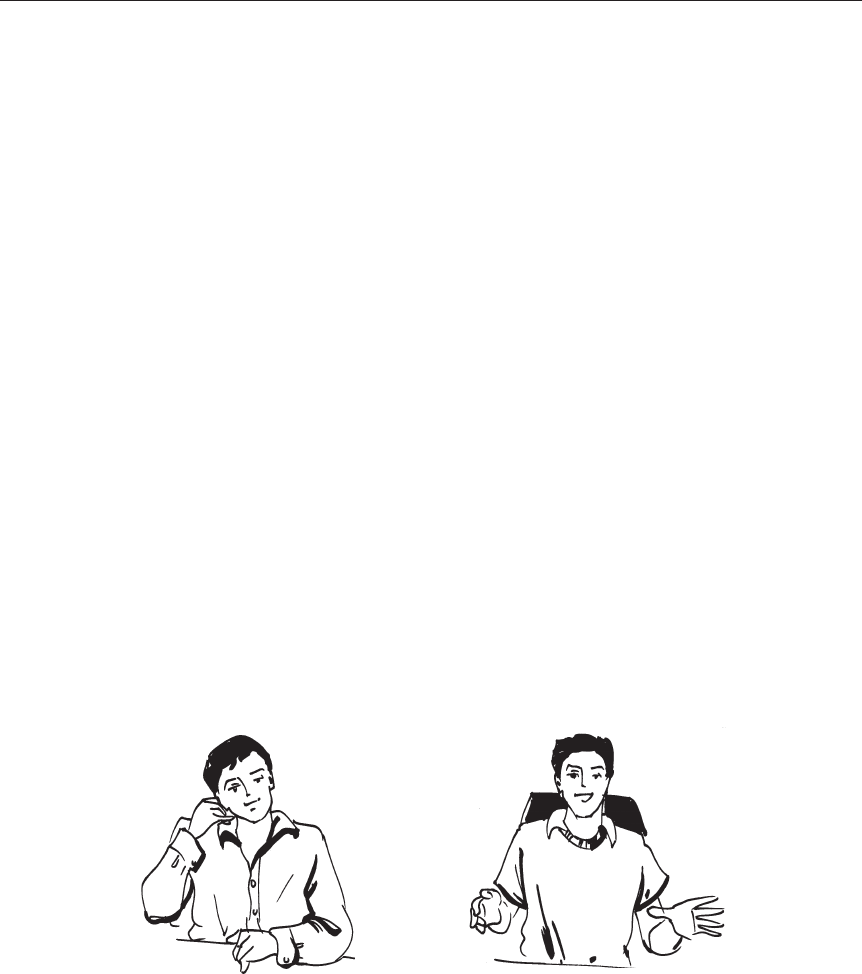
Non-Verbal Communication: Body Language
43
i. Disinterest in a deal - Eyes down-cast with the face turned away.
j. Interest - The opposite can be a relaxed mouth, a smile and a
projected chin. This can suggest that a customer is
considering a deal and is obviously interested.
k. The blank face - This is the ‘dead pan’ face or the emotionless face
that is completely relaxed. This is a typical reaction
when a person is withdrawn, completely into him-
self or herself. The strong emotional signal that
this face sends is, “Do not disturb”.
Most of the facial reactions we have discussed here are a combination of two or more fea-
tures. Sometimes a single aspect of the facial expression too can convey a lot.
The head nod: A small head nod generally signię es aĴ ention whereas a more vigorous and re-
peated movement signię es strong agreement with some viewpoint being expressed.
Head movements are generally very signię cant in communication. If a person shakes his/
her head from side the side but says—“Of course I do agree” or “This is really interesting” one
cannot deę nitely take the words at their face value. The feeling one is leĞ with is that, either
the speaker in lying or being sarcastic.
The head tilt: Slight tilt of the listener’s head is always seen as a sign of keen listening and in-
terest. The nodding of the head accompanied by the head-tilt position can suggest empathy
and complete agreement with the speaker. In contrast, the straight head, more oĞ en than not,
shows a neutral aĴ itude.
During a lecture session, if heads are not tilted it might be an indication that suĜ cient in-
terest has not been evoked. If from a head tilt position people move on to a straight position
and then begin to slouch, it is a clear indication that there has been too much of information
loading and that it is now time to stop.
Head tilt Open hands
The Hands
Our hands are among the most expressive parts of our body during communication. In a big
way, they indicate our mental process. Scientists have observed that there is more number
of links between our brain and our hands than any other part of the body. They signal our
thoughts, show our feelings and our mental state.
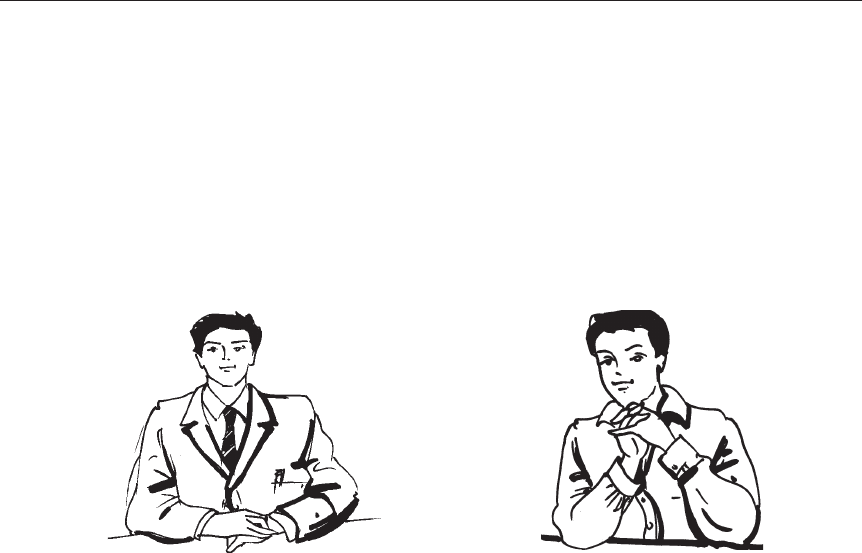
Communication Skills for Engineers
44
Open hands: Open hands are always a sign of trust, a desire to communicate and an invitation
to share his/her point of view. Some even believe that it allows positive energy to Ě ow from
the speaker to the listeners, making the listeners more receptive to what the speaker is say-
ing.
Upfacing flat hand: A Ě at hand with the palm facing up or outward is always deę nitely a silent
question. It says, ‘why?’ or “I don’t understand’
Relaxed hands: A calm, conę dent, self-assured person’s hand will deę nitely be relaxed. The
hands would gracefully rest one on top of the other. Even though they are involved in doing
something else, their movement will be steady and controlled.
Relaxed hands Clenched hands
Restless hands: An uneasy, jiĴ ery or nervous person’s hands will also be restless and jiĴ ery.
Even when apparently calm, the hands can be restlessly picking, scribbling, biting or even
sucking. Such movements show anxiety or a lot of nervous energy.
Clenched hands: Invariably, clenched hands are a sign of negative emotion. In diě erent con-
texts, they signify diě erent emotions. Sometimes, they signify a feeling of tension and frustra-
tion (a feeling of being tied down). During negotiations, they can even signify a closed mind,
a persons who will no longer accept suggestions or see your point of view. Clenched hands
with the rubbing of the thumb or picking the cuticle of one thumb, sometimes shows need for
reassurance. They signify a nervous, uncertain mind, unable to resolve a problem.
Clinging hands: Sometimes, when we cling to the armrest of the chair, a table, ę les or books, we
indicate insecurity, or nervous anxiety.
Wringing hands: Pressing, twisting and squeezing of one hand with the other is again a sure
sign of discomfort, feeling of insecurity or need for reassurance.
The Arms
Crossed Arms: Crossed arms form a kind of barrier, a guard against perceived threat. It can be
seen as a defensive posture. Sometimes, it may even mean that the person being spoken to
has a closed mind to the topic being spoken. He/she is determined to take up a certain stance
and is subconsciously bracing up against any opposition.
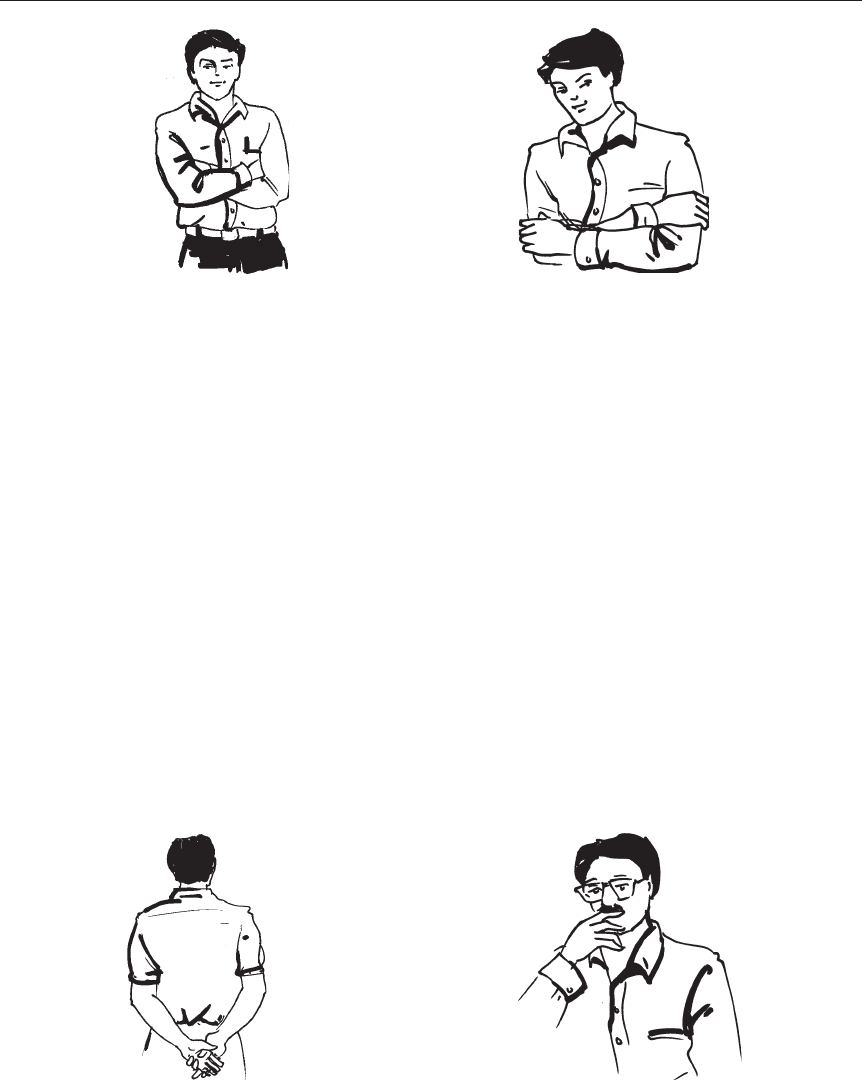
Non-Verbal Communication: Body Language
45
Crossed arms Arm gripping
The gesture also stands for relaxation. It can be seen as a way of resting the arms. How-
ever, generally it has also been seen that the person who takes up this posture is less likely to
listen or accept the viewpoint of others. In a group, generally, people who have their arms
relaxed by their sides are more likely to be ready to listen, accept or understand.
Arm gripping: Arm gripping, similarly is seen as a negative aĴ itude. In this posture the hands
grip the upper arms tightly to prevent their sliding down to a relaxed position. More oĞ en
than not, this posture shows a negative, suppressed aĴ itude. It signię es fear or sometimes de-
pression. This also is a subconscious protective posture the body assumes when there is any
psychological threat or perception of insecurity.
Arms behind the back: If a person tightly clenches his ę st behind his back or tightly holds the
wrist of one hand, it either shows that he/she is trying to disguise emotions or facing inner
conĚ ict. The same gesture – arms at the back – but with unclenched hands can, on the other
hand, show superiority and conę dence.
Unconsciously, here, the person has exposed his vulnerable areas like throat, heart and
stomach. The gesture thus shows fearlessness, authority and easy conę dence.
Apart from these basic kinds of hand and arm movement, there are numerous hand-to-face
gestures that signify certain moods or aĴ itudes.
Arms behind the back Hand covering mouth
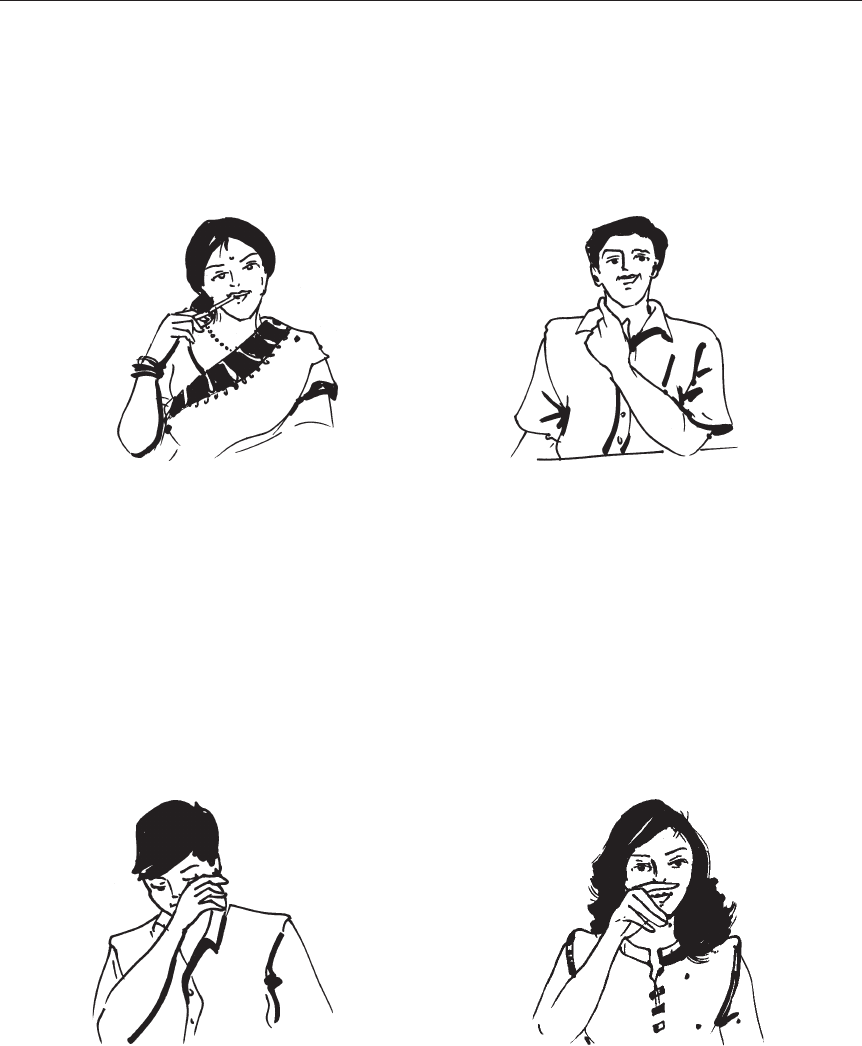
Communication Skills for Engineers
46
Hand covering the mouth: This gesture might show that the person is lying, trying to hide a feel-
ing, or deliberately not expressing his views.
Putting something in the mouth: This is done in many ways. A person may bite his nails, put
pens, pencils or even the arms of spectacles into his mouth. All these are seen as movements
that show the need of reassurance. They can indicate anything from nervousness, indecisive-
ness and anxiety to a decision-delaying tactic.
PuĴ ing something in the mouth Scratching the neck
Scratching the neck: A sustained scratch accompanied by the person looking down or away
could mean that he/she is searching his/her memory. Scratching the neck just below the ear
lobe lightly, would mean uncertainty. It shows discomfort.
Neck stroking: This is more oĞ en found in women. They stroke the neck or feel the necklace.
It would mean disbelief, discomfort or even signify indecisiveness or a decision making pro-
cess.
Rubbing the eye: ShuĴ ing the eye with a ę nger or rubbing the eyes during a conversation could
mean that the person is in doubt or is trying to deceive.
Rubbing the eyes
Rubbing the nose
Rubbing the nose: Rubbing or touching the nose slightly during a conversation might be a sign
of rejection or a gesture of doubt.
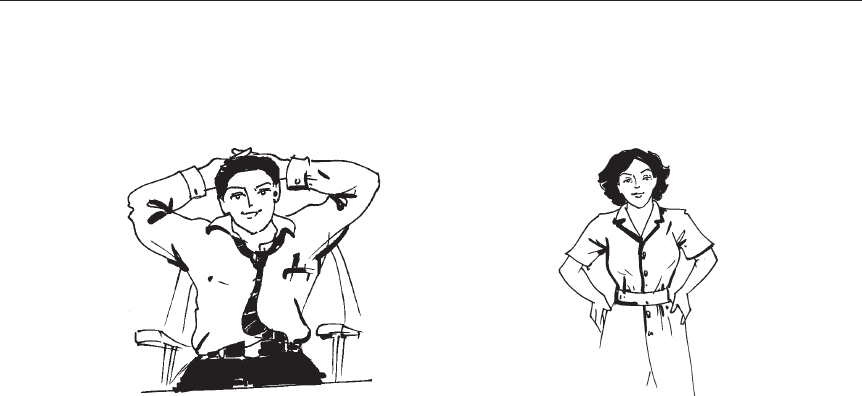
Non-Verbal Communication: Body Language
47
Hand behind the back of the head: This is a gesture that signię es conę dence, dominance or a feel-
ing of superiority. OĞ en people are found assuming this posture during conversation with
their subordinates but is done rarely in the presence of their superiors. It is a typical gesture
that means “Everything is under control”.
Hands at the back of the head Hands on hips
Hands on hips: This is a gesture that could show aggressiveness or a non-verbal challenge.
Very oĞ en,however, it shows readiness for action, readiness to take up or tackle targets.
Sometimes, people adopt this posture to appear bigger, move powerful or dominant.
The Legs
The placing and positioning of the legs too, play an important role in body language. Given
below are some of the big postures we commonly make.
Cross-leg gesture: This is a gesture when the legs are crossed, with one knee resting on the thigh
of the other. It is generally done when a person is occupying a chair, siĴ ing in the same un-
comfortable position for a long time. Variation of this posture is one leg crossed almost hori-
zontally, with the ankle resting on the other knee. Like the crossed hand position, both these
positions show a defensive aĴ itude. The person might be nervous, withdrawn, or geared up
to face a perceived threat. It is generally observed in meetings that when there is a discussion
or negotiation many of the participants will cross their legs. When an agreement is reached,
and the issue has been amicably seĴ led, many of them will most probably uncross their legs
and move or tilt towards one another. Generally, it may be concluded that crossed legs signify
defensiveness, a propensity to not accept the other viewpoint. Uncrossed legs, on the other
hand, show a more receptive frame of mind, in tune with what the speaker is proposing. If the
crossed-legged position is coupled with the crossed hand position, the resistance is deę nitely
intense. In a meeting or during discussions, this is most surely a sign that there is an argu-
ment or resistance ahead.
Crossed legs with the foot moving in small kicking motion, again, signify boredom in a
given situation. This, combined with the foot pointing towards the exit is a clear sign that the
person wants to leave the place.
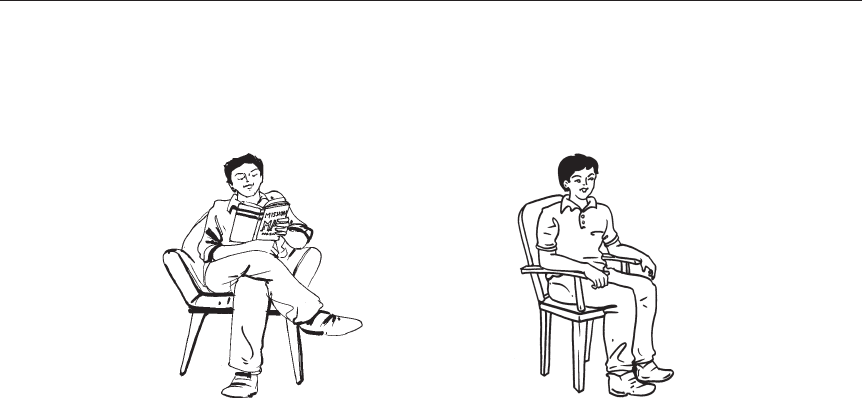
Communication Skills for Engineers
48
While analyzing crossed legs, however, one has to be a liĴ le careful. In Europe, for ex-
ample, women are expected to sit with their legs crossed or tightly held together. EtiqueĴ e
demands it. In this context, therefore, it need not be inferred that the women are defensive or
in a mood to disagree.
Crossed legs Relaxed siĴ ing pose
Sitting Styles
The relaxed sitting pose: SiĴ ing in a chair with legs relaxed and apart, the hands resting Ě at on
the arms of the chair signię es an open, relaxed aĴ itude. Two people siĴ ing in this posture fac-
ing one another and discussing, is deę nitely a sign that the two are in tune with one another’s
thought. There is hardly any disagreement or resistance.
Sitting on the edge of the chair: From a relaxed siĴ ing posture, moving to the front of the chair
can signify that the people involved are ready to compromise, co-operate or agree. Some-
times, it can even signify that the people are ready to ę nally reject and abandon the discus-
sion. SiĴ ing forward in a chair with feet on the tiptoe shows readiness for acceptance, readi-
ness for action.
Sometimes, when siĴ ing on the edge of the chair is accompanied by stiě hands placed on
the knees or gripping the sides of the chair, it can signify fear, tension or a desire to be free
from the situation. This is generally coupled with very tense facial expression.
Leg over the arm of the chair: Apparently, a person with the leg over the arm of the chair ap-
pears relaxed and informal, in a mood to enjoy. But sometimes,the posture can also be taken
to signify a defensive aĴ itude saying ‘”I don’t care!”. It can denote indiě erence, hostility and
sometimes a dominant, superior aĴ itude.
Straddling the chair: SiĴ ing with the chair around so that its back faces the people one is talk-
ing to can signify an informal, relaxed mood. In a diě erent context, however, it could even
signify a defensive mood, an aĴ empt to shield or protect oneself against imagined hostility.
A straddle can show aggression, especially when faced with resistance or bored with the con-
versation. In such a context, turning around and going to the back of the person one is talking
to can make the laĴ er feel vulnerable. And most probably he/she will turn around to face the
speaker, if it is a swivel chair.

Non-Verbal Communication: Body Language
49
Stradling the chair
DISTANCE AND POSITIONING
In our day-to-day life, very oĞ en our aĴ itude is signię ed by the spaces we occupy – both in
relation to others or ourselves. We stand in particular places, occupy particular chairs and
maintain specię c distances vis-à-vis specię c people. Space or distance can, in general, be di-
vided into these broad categories.
Intimate distance: Each of us guards our own territory. We allow only certain people into very
close proximity. This could be from real physical contact to about six inches from our body.
This distance we reserve only for people with whom we are emotionally close. It could in-
clude one’s child or parent, close friends, relatives or a lover. Here, the sense of physical prox-
imity is intense. But visibility is low.
Personal distance: This, too, is a relatively close distance zone. It involves a certain area a person
reserves around oneself. In case of informal, outgoing people, this distance might be less. Stiě
and reserved people however might maintain a larger area as their personal distance. This is
typically the space within which a person maintains privacy or social intimacy. This distance
becomes obvious in social gatherings or parties. Sometimes two or more people gather in a
public place but get together within one another’s personal zone. This is in striking contrast to
the longer distance which people maintain with others with whom they don’t feel particularly
close.
Social distance: This is the distance we maintain with people we interact, but don’t know very
well. It could be a new employee, a colleague or sometimes people staying in the same neigh-
borhood. The distance could be between four to seven feet depending on whether it is a close
or distant social contact. People with a ę rmly established hierarchical relationship also gener-
ally maintain this kind of distance.
Public distance: This could be a distance between twelve and twenty ę ve feet -- a distance suit-
able for lectures or conferences. Such distance is also maintained by politicians while address-
ing people and by actors on the stage.

Communication Skills for Engineers
50
BODY ORIENTATION
Sometimes, the way we stand in relation to one another also shows our aĴ itude and frame of
mind. Two people with the upper part of the body inclined towards one another deę nitely
means agreement. The distance between the two people could suggest how close or far they
are but they deę nitely agree or at least are tuned to one another’s thought process. When two
people maintain a right angle and talk without facing one another, it is deę nitely not a private
conversation. The topic could be routine instructions in an oĜ ce or a discussion that does not
closely concern either. When two or three people are discussing something intimate or private
they will most probably face one another squarely or form a close triangle. The bodies also
might be inclined towards one another. The clear sign here is: “This is a closed meeting–keep
oě ”.
Pointing
The direction towards which a person points his feet or his torso is again a very signię cant
pointer to his/her aĴ itude. Feet pointing at the door could suggest a desire to leave. Some-
times, pointing your feet at someone might even suggest that we are interested in the person.
In a party, if a man points his foot at a woman, it might mean he is interested in her. She might,
in turn, move close to another person signaling her preference.
Mirror Imaging
This is a situation where people mirror or imitate one another’s body positioning. AĞ er a
meeting or during a break if we ę nd two people chaĴ ing, mirroring one another’s body pos-
ture, it is deę nitely a sign that they agree with one another. Each is receptive to the other’s
ideas. If in between, one of them suddenly changes his/her position, touches the nose with a
ę nger or looks away, it could be a sign that the rhythm has been broken. Disagreement has
cropped in and they are trying to negotiate a problem.
Mirror imaging can be particularly helpful in situations like interviews or a negotiation
table. The person whose posture you mirror gets a subconscious feeling of comfort in your
presence. It might even make her more inclined to agree with you, accept you and your
views. But be careful to do it subtly, delicately. Obvious imitation, which the other person
can see and observe, can be seen as a mockery or even as trying to make the other person feel
uncomfortable.
Body language is deę nitely a very important pointer to our aĴ itude, our feelings and emo-
tions. It is important, however, to remember that body language should be considered as a
cluster. While studying body language, one should take into consideration the facial expres-
sion, the hand, the leg movement and even the context and culture one is operating in. Our
experience as social beings does equip each of us to read and recognize body language to a
large extent. OĞ en, we have a “feeling” that a person is lying. In spite of talking in a friendly
manner, we “think” that he has suppressed hostility towards us. “Instinctively”, we know
that two people are intimate and we move out of their personal zone. Sometimes, we also
“know” that we are being ignored or we are unwanted in a group.

Non-Verbal Communication: Body Language
51
A mother deę nitely “knows” when a child needs reassurance even though nothing is said.
In intimate relationships again, we know exactly whether the person we love is tuned to us or
not. Most of this knowledge, we pick up subconsciously from the people around. Some of it
could also form part of our genetic memory because even newborn babies have been found to
respond to and understand body language. Good communicators, instinctively, understand
more of others’ body language and respond to it appropriately. It is important for each of us,
therefore, to cognize body language as an important part of communication, accept the feed-
back it gives us continuously and adapt ourselves accordingly.
ACTIVITIES
1. Given below are some typical behaviour traits in column by A and some expressions that
can match them in column by B. Try to identify what expressions can match with the traits
listed.
Column A Column B
1. Turning up the nose a. I don’t believe you. I think it is impossible.
2. Cracking the knuckles b. I’m energised.I’m ready.
3. Rubbing the nose c. I want to be honest with you.
4. SiĴ ing on the edge of the chair d. I want to emphasize this point. I’m determined.
5. Crossing the arms at the chest e. I dislike this dish.I reject your opinion.
6. PuĴ ing the feet on the table f. I disagree with you. I have to ę ght it to the end
now.
7. Placing the hands on the hips g. I’m nervous and uncomfortable. I wish I could
leave the place.
8. Pointing the index ę nger h. I’m bored now.I want to go on to the next item on
the agenda.
9. Placing both palms on the chest. i. I’m indiě erent. I don’t care about what you are say-
ing.
10. Shrugging the shoulders j. I’m the boss here
2. AĞ er you have matched the columns, build a small monologue around each emotion ex-
pressed and enact it
3. Given below is a role-play that involves the expression of various emotions. AĞ er the role-
play is completed, analyze each of the characters and the range of emotions they expressed.
Try to remember the body language and the postures that helped them to express these
emotions.

Communication Skills for Engineers
52
Role-Play
The Situation: This is a joint family where the grand father and the grand mother (Krupa Shan-
kar and Rukmini) stay with their son and daughter-in-law (Aditya and Shanta) and their six-
year-old daughter (Priya). The problem has started because, of late, both the father and the
mother of the child have started feeling that the grandparents have been pampering the child
and that she is geĴ ing to become increasingly demanding. There has always been a liĴ le ten-
sion between the father and son because Aditya felt that his father was very strict in bringing
him up and had insisted on his taking up engineering in spite of his desire to take up acting
as a profession. The following is a rough description of their characters.
Role Descriptions
Krupa Shankar (grandfather)
You are 68 years old, a retired professor, who always believed in the merits of discipline and
hardwork. You sincerely believe that you have done the best for your son.
A career in acting would have been too risky for him and he was not academically motivated
enough to get into teaching. In your grand daughter, however, you see a new kind of possi-
bility. With the widening of career possibilities you think she has a great future. You feel she
is a brilliant child who should be allowed to choose what she wants in life. Also, you have a
nagging guilt in your mind for having stopped your son from taking up his acting career. You
would like to compensate by encouraging Priya to follow her heart.
Rukmini (grandmother)
You are almost 65 years old, tired and exhausted with life. You have had an active career and
you strongly believe that parents should have the sole deciding authority about their chil-
dren’s future. You are fond of both your son and daughter-in-law, but also detached enough
not to be too involved with their life. You feel that Priya should have her own freedom in life,
but you don’t want to impinge on your son’s parenting style.
Aditya (son)
You are 38, a dynamic successful, upcoming engineer. You enjoy all that your present career
has given you but you still nurse a secret wound for not being able to take up a career in act-
ing. You resent the fact that your father was once upon a time very strict with you, and you
would like to oppose whatever he says or believes. You too think that Priya should have the
freedom to be herself, but you want her to be more disciplined and time-conscious. You feel
that your father’s pampering is encouraging her to be wild and unfocussed.
Shanta (mother)
You are 32, a young lady with your own business enterprise. You feel both your father-in-law
and husband are imposing their own ideologies on your daughter. You feel they should just

Non-Verbal Communication: Body Language
53
let her enjoy her childhood. Of late, you have been worried about your father’s failing health
and you are irritated with the constant discourse about your daughter’s future.
All of you are siĴ ing together one evening, having tea aĞ er a hard day’s work. Suddenly,
Priya runs in, topples over a cup, breaks it and runs out. Even before you understand, an ar-
gument breaks out between father and son. You and your mother-in-law too are dragged into
it.
Now analyze the characters along the following lines.
Krupa Shankar
Dominant emotional traits corresponding body language
1.
2.
3.
Rukmini
Dominant emotional traits corresponding body language
1.
2.
3.
Shanta
Dominant emotional traits corresponding body language
1.
2.
3.
Aditya
Dominant emotional traits corresponding body language
1.
2.
3.

Communication Skills for Engineers
54
SUMMARY
• Non-verbal language constitutes body movements, gestures and facial expressions.
• Non-verbal, physical behaviour accounts for around ę Ğ y-ę ve per cent of our commu-
nication.
• When we fail to express our feelings, a warm handshake or a hug conveys intimacy
much more eě ectively and powerfully.
• Loss of eye contact, yawning or slumping in the chair can express boredom or loss of
interest, even though verbally we may still say we are interested.
• The face is a very powerful indicator of our feelings. Professionals like teachers, coun-
selors, doctors, businessmen and artists take a lot of clue from the faces of the person
they are dealing with.
• At times, the face shows a blend of two diě erent emotions, like for example, pleasant
surprise. It can show as a pleasant smile combined with raised eyebrows.
• Hands play an important role in communicating feelings. Scientists have observed that
there is more number of links between our brain and our hands than any other part of
the body.
• The placing and positioning of the legs also play an important role in body language.
• In our day-to-day life, very oĞ en, our aĴ itudes are signię ed by the spaces we occupy—
both in relation to ourselves or others around us.
• Intimate distance, personal distance, social distance, and public distance are some of
the broad space/distance categories.
• Sometimes, the way we stand in relation to one another also shows our aĴ itude and
frame of mind.
• The direction towards which a person points his feet or his torso is a signię cant pointer
to his aĴ itude.
• Mirror imaging goes a long way in making the other person comfortable in our pres-
ence and to receive our views positively. It can be particularly helpful in situations like
interviews or at the negotiation table.
• Eě ective communicators instinctively understand more of others’ body language and
respond to it appropriately.
REVIEW QUESTIONS
1. In a communication situation, what is the ratio of verbal vis-à-vis non-verbal commu-
nication? State in short the various factors involved in communication.
2. What are the diě erent kinds of basic emotions expressed by the face? In a situation
where a dealer is trying to strike a deal with a client, what are the clues he/she should
look for in the face to know the client’s reaction?
3. What are the diě erent kinds of head movements that maĴ er during communication?
State with examples what each of them signię es.

Non-Verbal Communication: Body Language
55
4. What are the two kinds of hand movements that can diě erentiate a calm mind from an
agitated restless mind? Give examples and show the diě erences.
5. How would you distinguish between the clenched hand and the clinging hand? In what
situation will each of these be used?
6. Give a list of body movements that will signify a calm, relaxed and open mind. Explain
each of their characteristics in detail and place them in hypothetical situations.
7. In a group, the way people sit or stand gives away the proximity they have with one
another, the interest they have in what the other is saying. Discuss some of these body-
movement clusters.
8. Body language should always be studied in a particular context. The same posture, in
diě erent contexts can mean diě erent things. Give examples.
9. What are the diě erent kinds of distances we observe during communication situations?
State the signię cance of each.
10. Each of us is naturally endowed with the capacity to read and analyze body language—
discuss.
11. What is mirror imaging? State its role in the communication situation.
12. Can we always interpret cross-legged gestures to be defensive gestures? Give reasons
for your answer.
13. How many signię cations does the ‘arms behind the back’ posture have? State any two
with examples.
14. What does ‘pointing’ mean? What can you infer from a person’s feet pointed towards
the door?
15. What is the diě erence between ‘scratching the neck’ and ‘stroking the neck’?

CHAPTER 3
Listening Skills
We have two ears and only one tongue in order that we may hear more and speak less.
—Diogenes Laertius
Chapter Objectives
This chapter introduces the mother of all communication–listening. While emphasizing the
primacy of listening among all the skills, it distinguishes between hearing and listening. It
further discusses the processes of active listening and other kinds of listening. Barriers to lis-
tening and good listening are elaborated alongside activities like Chinese whisper etc.
THE LYNCHPIN OF COMMUNICATION
Listening can be described as a skill that involves receiving, interpreting and responding to
the message sent by the communicator. Like any other skill, listening skill also needs to be
learnt and developed for eě ective communication. It is, in fact, one of the most important
skills that play a vital role in the process of communication. As listening can be seen as funda-
mental to all communication, poor listening can become a major barrier to communication. It
can result in break-down of communication, or wrong, improper and incomplete communica-
tion. Messages can be lost, misunderstandings may crop up, and people may perceive or be
perceived wrongly.
HEARING AND LISTENING
Most of the problems discussed above crop up because we do not discern between the two
activities, listening and hearing. Hearing is primarily a physical act that depends on the ears.

Listening Skills
57
Unless there is a physical disability or problems such as noise or distance, it happens automat-
ically. It requires no special eě ort from the listener. ‘Listening’, on the other hand, is a much
more conscious activity that demands a lot more than just hearing. It requires the conscious
involvement of the listener, the acknowledgement of understanding and response. The lis-
tener has to hear, analyze, judge, and conclude. When a person is listening, he is constructing
a parallel message based on the sound clues and verifying whether his message corresponds
with what he hears. Hence, listening is an active process in which the listener plays an active
part in constructing the overall message that is eventually exchanged between a listener and a
speaker. It is a process that actively engages the speaker as well as the listener. Both are equally
involved. Even as the listener is listening, he has to process the facts, study the body language
of the speaker and also project the appropriate body language to the speaker. The speaker, in
turn, has to cognize the feedback given by the listener and respond. It is, in other words, like a
sea-saw, where both the listener and the speaker monitor one another’s response and then act.
A person, who listens well and engineers his body language appropriately, is seen as a ‘good
conversationalist’ even though he actually speaks less. This is active listening.
One of the most valuable things we can do to heal one another is listen to each other’s
stories.
—Rebecca Falls
ACTIVE LISTENING
Most of the problems in ‘listening’ arise because of the discrepancy in our speed of talking
and listening. On an average, we can speak around 120 to 150 words a minute. But the brain
is capable of processing 500 to 750 words a minute. Most of the brain is idle when we are just
listening. AĴ ention, thus, gets dissipated and the mind starts geĴ ing engaged in other things.
As a result, our listening becomes partial and selective. OĞ en instead of listening and trying
to understand what the other person is saying, we get more involved in forming our counter
arguments. This also becomes a kind of selective listening where, more than listening, we are
involved in our own response. In eě ective and active listening, the listener, aĞ er grasping the
content of the speaker gets engaged in trying to understand him. He looks at the problem
from the other person’s perspective, engineers his body language appropriately giving the lis-
tener constant feedback. This process, as mentioned earlier, is as engaging as talking. Thus, it
leaves no space in the listener’s mind empty for speculation or formation of anti-discourse.
ACTIVITIES
1. In a group, ę nd out one person who loves cricket and another who does not. Make them sit
facing one another and give the following instructions.
For a couple of minutes, think about the reasons why you like or dislike cricket. Start giving
your views simultaneously. Rather than listening to your opponent’s viewpoint, try to impress
your views on him. Continue doing this for about 10 minutes.

Communication Skills for Engineers
58
When the task is complete, take a feedback of what went on from the two participants.
Take the opinion of the audience too.
2. Make a slight variation of the same exercise. Instead of ignoring the other viewpoint, each
participant should carefully listen to what the other is saying, paraphrase it, and then put
forth his own point. The conversation of each, thus, should begin with this paĴ ern:
So you feel that .
but I feel diě erently. I believe that .
At the end of the exercise the audience should note the diě erence in the body language of the
listeners in the two exercises. The diě erences can be analyzed along the following param-
eters.
Activity 1 Activity 2
1. Eye contact
2. Facial expression
3. SiĴ ing posture
4. Head movements
Task for the two participants : Enact the situations. At the end of the performance each of you
should note down your feelings about the other. Now read one another’s role-description and
re-enact the situation. Is there any diě erence in the way you feel for one another now?
Task for the audience : AĞ er watching both the performances, analyze the kind of listening the
teacher did in the ę rst performance. Did it become diě erent the second time? Give reasons for
the change if there had been any.
Take more topics like classical music, network-marketing or job-hopping, select people with
strong opinions for and against the topic and repeat the exercise. In every case, note the dif-
ference in the body language during the two exercises. Make a list of the common diě erences
you found in the body-movements. Anyone from the audience can make a brief presentation
on it. Include in the list any commonality in the feelings that the participants reported. Put
together, these can be seen as the basic diě erences between how people react during hearing
and listening.
“One of the best ways to persuade others is with your ears—by listening to them.”
—Dean Rusk
KINDS OF LISTENING
The exercises make it evident that there are diě erent kinds of listening. Depending on the
quality of listening, it has been divided into four types.

Listening Skills
59
1. Ignoring
2. Selective listening
3. AĴ entive listening
4. Empathetic listening
Ignoring: This is the kind of listening where the listener is entirely ignoring the message as
well as the message giver. He/she might just be ‘pretending’ to listen while doing or thinking
something else. This can be very damaging because the listener’s lack of participation be-
comes evident through the body language. The speaker might feel snubbed and hurt, which
might further lead to a total break-down of communication. The same preoccupation might
also result in the listener not taking note of the speaker’s reaction.
Selective Listening: Selective listening is listening to parts of the conversation while ignoring
most of it. This is the kind of listening we practise oĞ en while listening to repeated public an-
nouncements or the TV news if we are looking for some specię c information. If we are wait-
ing for news about the cancellation of trains in a certain route, for example, extensive coverage
about a cricket match or weather is most likely to be at the fringe of hearing. We register the
broad topic at times but the details are ignored. The brain registers the topics and then dis-
misses them or just ‘shuts oě ’. This oĞ en happens in classrooms too. Many students practise
selective listening. The whole lecture is rarely listened to with the same intensity. Individual
students pick up topics of their concern or interest in a lecture and pay close aĴ ention to it. The
rest of the content is either given peripheral aĴ ention or ignored. It is only sometimes that a
whole lecture is absorbed similarly.
It is interesting to note the instantaneous change in the body language when the listener
moves from the non-listening to the listening phase. The facial expression becomes more fo-
cused. The eyes, especially, show a lot more concentration. The listener might even lean for-
ward in the chair or towards the speaker or might straighten up and turn towards the direction
the message is coming from. When the message has been observed, the body language relaxes
visibly. This can be noticed in the slumping of the shoulders and diminishing eye-contact.
During any conversation, it is very important for the speaker, especially, to look out for these
signs. If the listener or listeners are listening only selectively, the structuring of the content
may need to be altered; the material may have to be made more relevant, or repetitions may
have to be avoided. But if you are a listener engaged in a conversation with a speaker, beware.
Your body language will most probably give away that you are listening only partially!
Attentive Listening: AĴ entive listening in a kind of listening where there is no selective dismiss-
al. The listener listens to the speaker completely, aĴ entively, without glossing over or ignoring
any part of the speech. This is the kind of listening we ę nd when there is a discussion, for
example, on a topic we are interested in or we are critically examining a piece of information
for further discussion. Critical listening allows us to form an opinion on the topic being dis-
cussed and even design our response appropriately. It allows us to assess the viewpoint, the
perspective of the speaker and weigh the arguments appropriately.
Empathetic Listening: This is the ultimate kind of listening that is done not just to listen and
understand, but understand the speaker’s world as he sees it. Here, one empathizes with the
speaker, understands his viewpoint but does not necessarily agree with him. This kind of
listening has almost a therapeutic eě ect on both the speaker and the listener.

Communication Skills for Engineers
60
Empathetic listening is diě erent from aĴ entive listening or critical listening. As Stephen Cov-
ey puts it, here listening gets into ”another person’s frame of reference. It is listening, not only
with one’s ears, but one’s heart”. To quote Covey again, “you listen for feeling, for meaning.
You use both your right brain as well as your leĞ . You sense, you intuit, you feel”.
This is the kind of listening one friend gives to another friend when the laĴ er feels the need
to speak, or a sympathetic parent gives to the growing child if he/she has come back from
school, troubled.
When you are listening to somebody, completely, aĴ entively, then you are listening not
only to the words, but also to the feeling of what is being conveyed, to the whole of it,
not part of it.
—Jiddu Krishnamurti
ACTIVITIES
3. Look around you and make a note of situations when you and others listen. You’ll ę nd
them in plenty! Try and categorize them. Note ę ve situations when you think you and oth-
ers do the following kinds of listening.
1. Critical listening 2. Selective listening
a. a.
b. b.
c. c.
d. d.
e. e.
3. Ignoring
a.
b.
c.
d.
e.
4. Make a note of a situation when you thought that you were adequately listened to. Try and
recollect how you felt, using three adjectives to describe your feelings. Also try to recollect
what it was in the person that made you feel so. Use three adjectives to describe the aĴ ri-
butes of the listener.
Your feelings The listener’s behaviour
a. a.
b. b.
c. c.

Listening Skills
61
Recollect ę ve points about the body language and the facial expression of the listener.
a.
b.
c.
d.
e.
Role-Play
The Situation: This is a role-play that shows the conversation between a teacher and a fourth-
year engineering student. The student was supposed to have submiĴ ed his assignment three
days ago. But he has been missing. He has come with it now. (With this introduction, give
the role descriptions to each separately. Do not let one look into the description of the other.
But in the absence of both, the audience should hear both the role descriptions).
The Teacher: You are a strict disciplinarian. You believe that a deadline is a deadline. Students
coming up with reasons for delaying work is a source of constant irritation for you. This time
you have decided that you’ll not accept assignments if there is any delay. This student com-
ing now can do well if he applies himself. You appreciate him. But oĞ en, he disappears from
college without any information. You are determined to teach him a lesson. You believe that
it is for his good that you are doing this.
The Student: You are a good student but you know that you are under-performing. Your fa-
ther is an alcoholic and sometimes does not come home for days. At such times you have
even gone searching for him. You have not shared this problem with anyone. This time you
wanted to ę nish the assignment on time, you also put in your best. But, again, your father
disappeared and you had to go in search of him. You have come back with the assignment as
soon as you could. You are tired, irritated, and you now dread meeting this teacher who, you
feel, unnecessarily makes things diĜ cult.
The people of the world are islands shouting at each other across a sea of
misunderstanding.
—George Eliot
BARRIERS TO GOOD LISTENING
Sometime or the other, all of us listen partially, we do selective listening. Some times we also
ignore some messages. There are many reasons as to why we do not listen completely. Some
of them are the following:
1. Physical reasons : One chief cause of bad listening could be a person’s inability to hear prop-
erly. Apart from this, noise and distance too could become barriers to listening properly or

Communication Skills for Engineers
62
not listening at all. Anyone who has tried talking on a running train or pass on a message to
someone across a crowded street has experienced what a physical barrier could be.
2. Age and Attitude: Age and aĴ itude are sometimes reasons for not listening well. A four-year-
old child’s constant conversation is likely to be ignored by most parents. A teenaged son or
daughter is similarly likely to ignore the parent’s constant caution about driving rules, etc.
Diě erence of age oĞ en makes one feel that the person speaking cannot possibly have anything
interesting or relevant to say. This, oĞ en, creates an aĴ itudinal block, which results in the lis-
tener ignoring the message or assimilating it partially.
3. Mental Set: Sometimes, the listener is already conditioned to think that the speaker will
adopt a particular aĴ itude or a line of argument. If a conversation begins with this kind of
mind-set, it is obvious that no ‘listening’ or communication will take place. The listener might
entirely ignore what the speaker says or listen to only what he/she thinks the speaker will say.
Meanings here will be wrongly inferred and vital parts of the conversation will be skipped.
This kind of a mind-set can be extremely harmful in both professional and personal in-
teraction. If one comes to the negotiation table, for instance, with a closed mind determined
to reject the opponent’s proposal, there is liĴ le chance for the talks to go forward and reach a
resolution. In inter-personal situations, similarly, if one is pre-determined to look at a person
or his talk in a particular light, there is liĴ le chance of our forming a correct opinion about him
and his views. Such conditioning oĞ en prevents a bad situation from geĴ ing beĴ er. It makes
one blind to the fact that people might be willing to change, or be more accommodative.
4. Language: Language can be yet another reason why people do not hear correctly. It could be
the problem of a French speaker conversing in English or a Tamilian trying to speak in Hindi.
The mother-tongue interference plays a major role and prevents the listener from listening
correctly. It is important, therefore, to make sure that we speak the language we are convers-
ing in with reasonable clarity.
While speaking English, especially, it is important to be aware of our pronunciation, tone,
pitch, modulation and stress.
Language can sometimes be very context specię c. A group of college boys and girls talking
in the college canteen, for example, can have an altogether diě erent register. Slang might be
used in specię c ways and words too might have diě erent codes and meanings. Listening here
will mean being familiar with the particular register. Unfamiliarity can become a barrier to
listening. In specię c knowledge areas and professions certain words have specię c meanings.
Unless specię ed, these too can become barriers to listening comprehension. The same is true
of in-house acronyms.
5. Careless Listening: It is a common sight to see people looking at papers, siĞ ing through lists
or even ę dgeting with objects like paper weights while listening. This can put the speaker in a
very awkward position. He has no clue of what the reaction of the listener is or even whether
the listener is listening to him or not. Such actions can be annoying for the speaker. It can also
be seen as a way of snubbing or dismissing what the speaker is saying. OĞ en, it can also indi-
cate to the speaker that what he is saying is not important for the listener. This kind of gesture
can seriously hamper communication if used by superiors at the workplace or in any inter-
personal communication. If the speaker does not feel ‘listened to’, the act of communication

Listening Skills
63
will always remain incomplete. Listening in such cases, is bound to be partial. Even if the facts
are conveyed, understanding of the facts is generally inadequate or incomplete.
Such habits are commonly observed during telephonic conversations. Since the listener is
not present right in front, speakers oĞ en tend to do paper work, ę dget or draw diagrams. The
speaker, in fact, should be more careful during a telephonic conversation. The listener has no
inputs from the speaker except the voice, the pitch, the modulation and the pauses. Body lan-
guage and facial expressions are absent in this form of communication. So the language being
used, the pitch and modulation, and especially the pauses have to be used very carefully to
convey the right shade of communication or even avoid mis-communicating!
Role-Play
This is a situation where an employee has come back from the boss’ room agitated and angry.
The report, which was to be submiĴ ed the previous day is not yet ready. The boss blames
the employee for the delay but she feels that her share of work was done long back. Back in
the common room, she is talking about it to her colleague and friend. This is a conversation
between the friends.
Role Descriptions
Friend–1: You are new to the job but you feel that right from the beginning, your boss has been
trying to ę nd faults with your work. Even now you feel that he did not hear what you had to
tell him about the work distribution. You are angry and you want to complain to the person
next in hierarchy.
Friend–2: You are a good friend of this employee. You have worked longer in the organization
and you know your boss as a fairly reasonable and balanced person. You feel there has been
some mis-understanding somewhere. You also know that your friend is impulsive. You do
not want her to take the maĴ er to the next in authority.
AĞ er the role-play has been enacted, have a general discussion on the following points.
1. The communication barriers that you could observe.
2. What caused the barriers?
3. How could they have been avoided?
ACTIVITIES
5. Given below are certain statements and also the responses. Which do you think is the best
possible response?

Communication Skills for Engineers
64
1. An old woman siĴ ing next to you in the train starts complaining about rheumatic pains.
“These knees are geĴ ing worse. God knows how many more days I’ll have to suě er
them. Living with such pain is not worth living.”
You reply saying:
a. This is common at this age.
b. May be, you haven’t seen a good doctor?
c. It must be really painful!
2. An old friend speaks to you about her broken engagement: “I feel betrayed. He just
took me for granted. I can’t imagine he could be so rude to me. What does he think of
himself aĞ er all?”
You reply saying:
a. Just forget him. There will be many more ready to wait on you.
b. You’re stupid to have believed him.
c. Couldn’t you ę nd anyone else.
d. Oh dear! You must be shaĴ ered!
3. A small child walks into the room saying, “The clouds outside are strange! Yesterday I
saw an elephant today, it is like a mother and a child. There is a Ě ower also!
You say:
a. You are always dreaming.
b. Clouds keep moving, my child. The shapes are just formed to change.
c. Shall I tell you how clouds are formed?
d. It is fantastic! You know, I had once seen the sea and a jumping whale in the cloud.
4. You come back home late aĞ er a hard day’s work and your husband greets you saying:
“It was a terrible day for me. My bike had a Ě at tyre. I forgot my papers at home. The
work had to be redone in oĜ ce. And when I came back, I found that the kid had not
eaten in the aĞ ernoon. I’ve been trying to feed her since then. But she refuses to touch
food. She’s just stubborn and unreasonable”.
You reply saying:
a. I’ve had my share of problems too today.
b. This girl needs a real spanking!
c. You’ve been really stressed out today.
d. Can’t you see I’m just back?
In each of these cases, analyze what each of the answers would mean and decide which
would be the best possible response.
CHINESE WHISPER
Choose ę ve volunteers from the class. Ask four of them to be outside. Read the contents giv-
en below to the only volunteer present inside and the class. Ask the people outside to come

Listening Skills
65
in one by one. The ę rst person should repeat it (whisper it) to the second, the second to the
third and so on. Observe the way the message changes. AĞ er the ę Ğ h person listens to it, ask
him to repeat it once to all present. Compare it with what was said ę rst. (This is done to show
how message gets lost while traveling; what we listen to and what we ignore; the manner in
which we summarize, interpret, and recreate while listening)
“A scooter was coming at great speed from the south end of the factory and trying to move towards
the north-west. Even as it was trying to enter the lane to the leĞ , a truck coming from inside the lane
blocked its way. The scooterist tried to overtake but was again stopped by a car coming behind the truck.
He came very near to dashing the car. The car driver, thoroughly disgusted with the traĜ c, came out
and cursed the scooterist. Upset with all this, the scooterist turned back with great diĜ culty and took
the next lane. “
Wisdom is the reward you get for a lifetime of listening when you’d have preferred to talk.
—Doug Larson.
GOOD LISTENING
A good listener will:
1. Try to understand the speaker’s perspective. It is not necessary to agree with the speak-
er, but a good listener will always try to see from the speaker’s perspective.
2. Listen with the whole body – As we have seen, the listener is as active a participant in
the act of conversation as the speaker is. For the speaker, the body language of the lis-
tener is one of the most important sources of geĴ ing feedback. The siĴ ing posture, the
facial expression and eye contact are important clues for the speaker to go on speaking
or to stop. They can encourage, discourage or even snub the speaker. If you want the
speaker to feel reassured, listen with your whole body, let the speaker know that you
are listening and you understand.
3. Do not judge prematurely – Since the brain can process speech much faster than one
can speak, it is easy to think ahead, judge the talk and even evaluate the speaker and
his talk. A good listener, however, will always try to look at the speaker’s perspective,
try to understand why the speaker feels the way he/she feels. If you want to be a good
listener, therefore, avoid judging the speaker’s talk or personality prematurely. Give
some time. Try to understand and then arrive at a conclusion.
4. Go beyond the words of the speaker – As said before, a good listener will always try
to understand the speaker’s perspective. But more than the words, it is important to
understand the spirit, the sentiment that keeps the conversation going. For good listen-
ing, thus, it is necessary to not get stuck in the web of words. One has to analyze the
context, study the body language, judge the aĴ itude of the speaker and the reasons why
one is responding the way he/she is. It is necessary, therefore to go beyond the words
of the speaker
5. Paraphrase the speaker – A good speaker, while listening, might also paraphrase the
speech of the speaker. This may not be a detailed paraphrasing, but responding in a
few words. Adding nothing, changing nothing, asking no questions, just summarizing
the speaker’s thought and giving information about what has been understood.
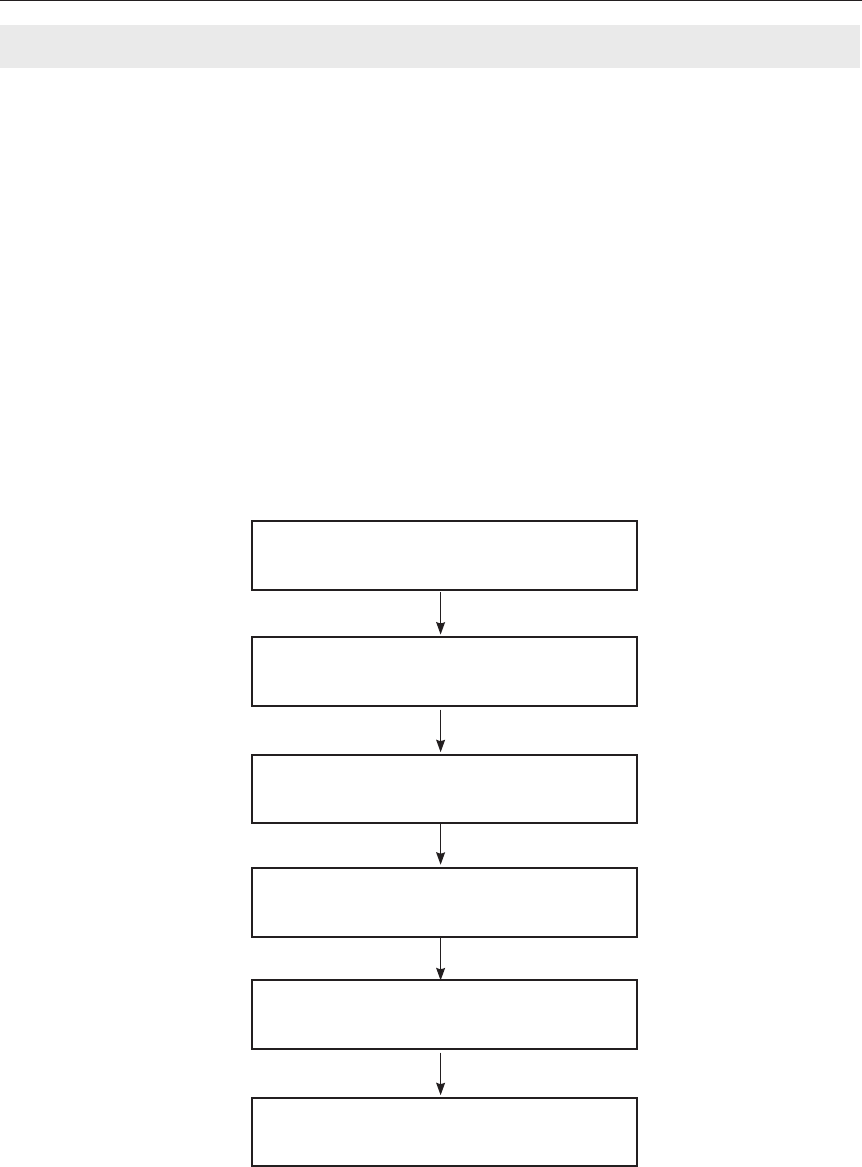
Communication Skills for Engineers
66
ACTIVITIES
6. Read out the following passage to the class loudly and clearly, and complete the activities
given below.
For centuries, the principal raw materials for making paper were coĴ on and linen ę bres
obtained from rags. Today, these have been largely replaced by wood pulp. Trees are cut
down, taken to the sawmill and chopped up into small pieces. The pieces of wood are then
ground up and mixed with water to make wood pulp. The wood pulp is then washed to clean
impurities. It may then be bleached to make the paper white. In the next step, starch or clay
may be added to improve the surface of the paper. The pulp is then fed into the paper making
machine. In this machine, the pulp is spread across large areas of wire mesh- sheets of metal
with a large number of holes in them. Here, the water is drained oě . The sheet is then passed
between rollers, which squeeze the water out.The dry sheet then travels through a series of
heated drums.At this stage, a coating may be applied to make the paper smooth and shiny.
This process produces a continuous sheet of paper, which is wound into giant rolls.It is then
trimmed to remove the rough edges, and cut to the desired width.
1. Listen to the description of how paper is made and complete the Ě ow chart.
67(3
67(3
67(3
67(3
67(3
67(3
Small pieces of wood are made into
paste and mixed with water

Listening Skills
67
2. State if the statements given below are true:
a. Good pulp is bleached to clean out the impurities.
b. The paper-making machine has a large wire-mesh on which the pulp is spread.
c. The pulp is adjusted, trimmed and cut at this stage to remove rough edges.
d. The sheets are passed between rollers to squeeze out excess water.
e. The heated drums are primarily used to give a glossy coating to the paper.
7. If you listen to the English of any good speaker carefully, you’ll realize that only a part of
a word or one part of the sentence is stressed at a time. Proper stress is very important in
determining the meaning of a sentence. Read the sentences given below, stressing only one
word at a time. Every time you read the sentence, stress only one of the words underlined
and discuss the diě erent meanings that emerge.
ST-1: Did Sita tell you that she was leaving?
ST-2: It is surprising that you mentioned this fact.
ST-3: Could you please leave me alone?
ST-4: I’ve never seen you so angry before.
ST-5: Did Saurav buy that black car?
Build dialogues around the diě erent meanings you ę nd in every sentence each time you
stress a diě erent word (Maybe, you could divide the work between ę ve groups and enact
them in front of the others)
Here is an example:
ST-1: Did Sita tell you that she was leaving?
Stress—Sita
A Hey! I just heard that Sita’s visa is through.
B Really? But I always thought she was strongly against people leaving the country.
A All that makes good talk, you see. When the opportunity comes who would like to re-
fuse?
B I still have my doubts about the whole story. Did Sita tell you that she was leaving?
(There should be two more dialogues from this sentence, one stressing on “you” and
the other on “she”. Take into account the changed meaning every time you change the
stress and compose the situational dialogues accordingly.)
SUMMARY
• Hearing is distinct from listening. It is listening alone that makes a communication
meaningful.
• Listening to somebody with the whole of your aĴ ention says, “you maĴ er to me”.
• We listen much faster than we can speak. ‘Understanding’ will ę ll the gap in speed.
• In listening, the listener is as much involved as the speaker is.
• Careless listening can snub the speaker and halt the entire communication process.

Communication Skills for Engineers
68
• To listen well, one does not have to agree with the speaker but try and understand the
speaker’s perspective.
• Since listening can be seen as fundamental to all communication, poor listening can
become a major barrier to communication.
• Listening is a much more conscious activity that demands a lot more than just physical
hearing.
• A person who listens well and engineers his body language appropriately is considered
a good conversationalist even though he actually speaks less.
• An eě ective and active listener, aĞ er grasping the content of the speaker, gets engaged
in trying to understand him and looks at the problem from the other person’s perspec-
tive and engineers his body language appropriately giving the listener constant feed-
back.
• Selective listening is listening to parts of the conversation while ignoring most of it.
• AĴ entive listening involves listening to the speaker completely, aĴ entively, without
glossing over or ignoring any part of the speech.
• Empathetic listening is the ultimate kind of listening that is done not just to listen and
understand, but understand the speaker’s world as he sees it. It is geĴ ing into another
person’s frame of reference.
• Most of the problems in listening arise because of the discrepancy in our speed of talk-
ing and listening.
• Physical reasons, age and aĴ itude, mental set, language and quality of listening are
some of the other factors that become either barriers to or enablers of good listening.
REVIEW QUESTIONS
1. How can we deę ne listening?
2. What is the diě erence between hearing and listening?
3. Discuss the concept of active listening.
4. What are the four types of listening?
5. What is the diě erence between ignoring and selective listening?
6. How do you relate aĴ entive listening to empathetic listening?
7. What are the barriers to good listening?
8. Discuss the role of aĴ itude in listening?
9. What do you understand by careless listening?
10. Discuss the role of language in eě ective listening.

CHAPTER 4
Speaking and Negotiation Skills
Three things maĴ er in a speech: who says it, how he says it, and what he says- and, of the
three, the last maĴ ers the least.
—John Morley
Chapter Objectives
This chapter aims to present a general overview of the speaking skill. Briefl y, it dwells on the general
factors involved in speaking, and intends to familiarize the reader with the crucial elements that need to
be given attention. The chapter discusses the important speech styles, presentation skills, group discus-
sions, role-plays and negotiation. Signposting, attention curve, audiovisual aids, power point presenta-
tions and important facts and styles used in communication situations that require negotiation are some
of the micro areas that are dealt in this chapter.
THE ART OF SPEAKING
Today’s world is one where speech abounds. The electronic media has brought in speech in
every form into our houses and our daily lives. In spite of this abundance of talk, however,
speaking skill is still a diĜ cult skill for many Indian students. This is because in India, oppor-
tunities for practicing speaking in English in an authentic, communicative seĴ ing are not suf-
ę cient. This is true in spite of the fact that English is widely used in education, career making,
business contexts and is also the associate oĜ cial language of the country.
Opportunities for speaking practice should be provided. Teachers and trainers need to
design activities involving pair work, group work, and role-plays and stimulate the students’
intrinsic problem-solving abilities. Speaking is an active process and students learning it need
to take an active role in developing themselves. Practice will become more meaningful if top-
ics and events from real world are used as starting points for establishing genuine communi-
cation among the learners.

Communication Skills for Engineers
70
SPEECH STYLES
Speaking manifests in society in various styles. Some of these are the formal, informal, polite,
normal, strong, blunt, tentative and direct styles.
These styles are context based and it is important for speakers to strike the right aĴ itude
and choose the right language. As with many other languages, in English also you have dif-
ferent ways of expressing the same content and message. The style you choose will depend
upon some or all of the following:
• The relationship you have with the people you are talking to; (e.g. whether they are
close friends, strangers, people in authority, etc.)
• The situation you are in; (at a friend’s party, an oĜ cial reception, etc.)
• The mood you are in; (angry, happy, nervous, etc.)
• The mood of the people you are talking to; (you will probably be careful when talking
to a friend who is in a bad mood.)
• What you are talking about; (you will be more careful in your choice of words if you
want to complain to a friend about his behaviour than you would if you were inviting
him for dinner.)
It is important to choose appropriate ways of saying things according to the situation you
are in. In many situations it will be appropriate to use normal or neutral language. In other
situations, it is necessary to use language items that are appropriate to special situations.
• We use tentative language when we are sincerely unsure of our facts or of how we feel.
E.g. It’s very kind of you to invite me, but I’m not sure if I can come.
We also use tentative language when we want to give the impression of being unsure in or-
der to be tactful and diplomatic. For example, if we want to disagree with a superior, it would
probably be too strong to say “I can’t agree with you” and it would be more appropriate to be
tentative and say I’m not sure if I’d agree with you.”
• Direct language is the opposite of tentative language; it gives the impression that the
speaker is very sure. This impression is appropriate if, for example, we want to agree
with someone. But it can sound rude and inappropriate in many situations like inviting
a superior to a party.
E.g. i. No .You are mistaken the statistics just cannot be this high.
ii. I see your point. But we’ll have to go ahead with our previous plan.
• We use polite language when we want to sound particularly polite without being tenta-
tive.
E.g. i. I’m sorry. But I feel there is a mistake somewhere. According to my calculations, the
statistics should not be so high.
ii. You deę nitely have a point. But I’m afraid this time we’ll have to go ahead. Next time
onwards, we’ll deę nitely consider these points.

Speaking and Negotiation Skills
71
• Formal language creates the impression of social distance between people. It occurs
mostly in oĜ cial situations e.g. business meetings, oĜ cial receptions.
E.g. i. I’d be delighted if you could make it to the party. We’ll all look forward to it.
ii. Forgive me if I sound curious. But isn’t this the same girl we saw him with yesterday?
• Informal language is used basically between friends. It is generally inappropriate to use
it with anyone else.
E.g. i. Cut it out will you? I’ve had enough of this.
ii. You ‘re coming to the party tonight, aren’t you? I just wont take ‘no’ for an answer.
• Strong language carries with it a strong sense of conviction. It usually sounds very di-
rect.
E.g. i. This is impossible! Hoe could you ever promise without consulting me?
ii. I’m gone without this project. I must get it come what may.
• Blunt language is extremely frank. It should be used with extreme care, as in most cases
it will simply sound rude.
E.g. i. I know you’re lying. You can’t fool me!
ii. I must tell you. Your work was not up to the mark and we’ll have to review your exte-
nsion.
In most cases we use normal and neutral language but sometimes, depending on the situ-
ations we are in and also on the basis of our co-speakers, we use special language. The type of
language we use shows our aĴ itude.
Silence, along with modesty, is a great aid to conversation.
—Montaigne
ACTIVITIES
1. Carefully look at the box given below. It is an illustration of how diě erent language pat-
terns can be used to express the same content.
Purpose: Asking Someone To Do Something.
Could/would you … please?(Polite)
Do you think you could…? (Polite)
I wonder if you could possibly… (Tentative)
Would you mind…? (Formal)
Can/will you…please? (Direct)
Do me a favor and…, will you? (Direct/informal)

Communication Skills for Engineers
72
2. Match the language snippets given in column A with the appropriate situations given
in column B.
AB
1 …well, in any case, it was a superb
concert.
the person is making a negative
comment on the book.
2 In other words, I feel there’s too lit-
tle information in this guide.
somebody is praising a music pro-
gram which he had aĴ ended.
3 there’s a lot of rubbish being shown
in this serial.
a viewer is commenting on a TV
program.
4 Please Rao. I know it’s a bit of an un-
pleasant job. But we have to do it.
a person discussing a very personal
problem with a friend
5 I really don’t know what to do Raj; I
think I’ll say no to him.
a person persuading his colleague
to take up some task
3. In the following situations, you must decide on the appropriate aĴ itude you would like
to convey and the language that you would actually use.
a. You are on a train and you want the window opened. You would like to ask an el-
derly gentleman siĴ ing near the window to open it, but you are not sure about his
response.
Suggested answer: you may use tentative language. E.g. I wonder if you could pos-
sibly open the window.
b. You want your water boĴ le, which is on a chair near your friend. You ask him to give
it to you.
c. A friend of yours has just called up to say that she would come tomorrow evening to
meet you. However, being busy yourself, you ask her to come the day aĞ er tomor-
row.
d. You are the secretary to the manager of a company. A person has just called up to
speak to the manager, but he is in a meeting. You ask the person to call back aĞ er an
hour.
e. You have decided to break your engagement with a boy. You parents had decided the
match for you and forced you to go through the engagement. Now you have heard
certain things about him and you are determined to break away.You want to do it
decently without creating bad feelings.
f. You are tired of instructing your junior about a certain procedure .You feel she’s not
willing to learn. You want to make it clear that either she has to learn or quit.
g. Both you and your wife are soĞ ware professionals. You come home late and work
even over weekends. You want to suggest that your wife could quit the job and take
up part time assignments.

Speaking and Negotiation Skills
73
PRESENTATION SKILLS
A speech is poetry: cadence, rhythm, imagery, sweep!
A speech reminds us that words, like children have
power to make dance the dullest beanbag of a heart.
—Peggy Noonan
Eě ective presentation skills form a very important aspect of our communication skills. It can
make or mar a communication situation. For an eě ective presentation, one has to choose a
style that suits one’s personality and ę ts the situation; carefully select and prepare the presen-
tation material; speak eě ectively and convey the right message.
Making an Effective Presentation
For making an eě ective presentation, one has to bear the following points in mind:
1. Break down the material into main points. Do not have more than ę ve or six main ideas,
as it is generally diĜ cult to remember more at a stretch.
2. Prepare notes or outlines.
3. Arrange them in a logical, coherent manner.
4. Make your information or facts eě ective. You may include statistics, illustrations, and
graphs etc if required.
5. Deduce recommendations based on your main points.
6. Use appropriate visual aids.
7. Deal with possible questions from the audience.
A presentation style can either be formal or informal. During a formal presentation, one
has to take care of the following:
Dressing appropriately: The ę rst impression one makes on one’s audience is always very vital.
The things that you should keep in mind are i) research your audience ii)dress appropriate-
ly. Organizations have their own dress code and people generally like people who look like
them. So adapt your outę t and be in tune with your audience; iv) Never let your appearance
overpower your message. Remember that the audience has come to hear what you have to
say, not see you.
Judging the audience: During a presentation, one has to carefully judge the audience- their level
of knowledge; the general aptitude etc. Finding out as much as possible about the persons you
are going to address will help you to pitch your talk at the right level. This information can be
about the audience’s age, profession, specialization etc. These have to be the determining fac-
tors in designing the talk and deciding the style. Here, one has to also consider whether it is a
large or a small audience. A presentation that is suitable for a group of ę ve or six, for example,
has to be diě erent from one meant for a group of 20 or 30.

Communication Skills for Engineers
74
Using the right style and language: A presentation deę nitely cannot be informal and casual. But
at the same time, it cannot be put in extremely formal, stiě or frozen language. Stumbling for
words and speaking haltingly will bore an audience. You need to develop Ě uency and a good
command over language and also learn to use it for your maximum advantage. The audience
would like to listen to a speaker who has a conę dent delivery and is in control of the situation.
Developing a positive aĴ itude to speaking will go a long way in increasing the conę dence
levels. The “you approach” too can be helpful. The audience feels a sense of involvement if
directly referred to.
Word order: Choose your word order in a way that you present the relevant information clearly
and distinctly. Instead of saying, “Britishers, Moghuls, Afghans and Aryans were all invaders
in India” it is beĴ er to say, “Britishers were invaders, so were the Moghuls, the Afghans and
the Aryans.”
Keep in mind the fact that the most important information comes in the front or near the
front.
Signposting: Sometimes, you know where you are proceeding and how. But your audience is
ignorant of it. It is important, thus, to have the important signposts, suggest the direction in
which you are moving. This will also help you plant the facts, clearly signify and categorize
the message that is to come. The following would be some of the signposts the audience ę nd
useful. They are suggested to give the required Ě ow to your presentation:
Expressions often used:
Openings:
I’m here today to report … and to present …
My purpose today is…
My main aim this morning is …
The title of my presentation is …
My topic today is…
Organization:
I have divided my presentation into sections.
The ę rst point I wish to make is …
The ę rst part of my presentation will deal with …
Firstly …
Secondly, I want to …
Finally I’d like to talk about …
In conclusion …
To conclude …
Drawing aĴ ention:
As you will notice, …
As you can see, …
I’d like to draw your aĴ ention to….
You will note that….

Speaking and Negotiation Skills
75
Linking:
As I said earlier, …
As I mentioned earlier, …
We shall move on to….
Later I’ll be talking about …
In addition to …
For this reason …
On the other hand …
To look at some of the other options …
Some advantages and disadvantages in the proposition are …
If this is one side of the picture, the other side is …
If we look at the picture holistically we ę nd …
Changing subject:
Moving on to the question of …
Let me now turn to …
Emphasizing:
What we have to realize is ….
What I ę nd most interesting is ….
What I’m geĴ ing at is …
Introducing evidence:
If you look at …
Let me show you that …
Let me explain …
Making recommendations:
I strongly urge that …
You ought to …
I recommend that …
I think you should …
Summing up:
Let me now sum up.
To summarize my main points…
To recapitulate
Points to Remember
1. Communicate at the right level with people
2. Select the right style for the occasion. Decide whether the situation warrants a for-
mal or informal style.
3. Moderate your speed.
4. Use your body language to make people feel at ease
5. Be in control of the situation

Communication Skills for Engineers
76
The Content of Presentations
During a presentation it is also important to prepare the presentation material with care. The
important points here are:
1. Researching the subject: It is important here to be clear about the objectives of the pre-
sentation, about the audience you are presenting to.
2. Selecting the content: Once the information has been gathered, it is necessary to ę lter
out the essential points. One has to group the ideas under separate headings; classify
the information depending on the available time; keep the maĴ er strictly to the point.
3. Planning for the talk: To get the message eě ectively across, one has to carefully draw
out a presentation layout. A well-planned presentation is always a well-received one.
The important factors to be considered at this stage are the following:
a. The Beginning: - During a presentation one is always sure of the ę rst few minutes
of the audience’s aĴ ention. One therefore has to be very careful about the beginning;
make an impression that will hold the aĴ ention of people. One can always start with
a quotation, a question, a dialogue or even an anecdote, a fable or a parable. A joke,
an unusual deę nition or a startling statement or statistics too can be eě ective at the
beginning.
b. The Middle: AĞ er making an impressive beginning one has to be able to deliver the
contents eě ectively. The contents should be well structured, they should be logically
connected and eě ectively lead towards a specię c goal. To sustain the interest of the
audience, it is important here to include examples and personal experiences, which
will make the material authentic and interesting.
c. The End: The way a presentation ends is again vary important. Primarily, this is
what the audience will remember the presentation as. It is important therefore to
give a presentation the right emphatic conclusion that will make a lasting impact on
the listeners.
Attention Curve
The aĴ ention of the audience during a presentation generally goes through an aĴ ention curve.
It starts on a high, drops a liĴ le ę rst and more steeply later. It rises again towards the end and
further up for the last few minutes. Some of the ways the audience can be kept interested are
the following:
1. Look into points where the aĴ ention curve drops and consider ways of varying the
texture. (If your presentation has been largely speech, bring in an audio-visual slide, or
have an interactive session that will ensure participation).
2. Keep the sections short, and ensure that every section ends on a high.
3. Get the audience involved decide what you want them to remember and stress on it.

Speaking and Negotiation Skills
77
Factors Aiding Effective Presentation
1. Use of audio-visual aids: During a presentation, audio-visual aids help ensure the at-
tention of the listeners. It creates the necessary shiĞ of aĴ ention and even increases
interaction between the presenter and the audience.
2. Eye Contact: Eye contact forms one of the most essential means of maintaining a rap-
port with the audience, receiving feedback and holding aĴ ention.
3. Intonation: The presenter has to use the right intonation with proper emphasis and
stress at the right points to convey the spirit of the message to be delivered.
4. Body Movements: During a presentation, the body movements too have to be carefully
monitored. They should neither show lack of conę dence nor be aggressive. Assertive
aĴ itude with the right facial expression and posture is ideal.
5. The Space: Depending on the situation and context of presentation the presenter has
to constantly negotiate the space between her/him and the audience. Preferably, he/she
should avoid the “public space”, and use more of the “social space”. Rather than being
static at one spot the presenter should be able to move and negotiate the points as well
as the space with ease.
6. Words/Phrasing: The choice of words and phrasing can be very important in a presen-
tation. Some of the general principles are:
a. Don’t use abstract or vague words.
b. Use active rather than passive sentences.
c. Cut out jargons or cliched phrases.
d. Adopt the “you” approach. Wherever possible, replace the third person with the
second person.
e. Bring in personal examples and experiences wherever you can.
f. Keep the main points as near the beginning of the sentence as possible.
g. Talk of the way you position yourself and indicate with linkers the way you are
moving.
How is it that our memory is good enough to retain the least triviality that happens to us,
and not good enough to recollect how oĞ en we’ve told it to the same person.
—La Rochefoucauld
ACTIVITIES
4. Pick out ę ve public speakers whom you oĞ en view on the TV. Can you isolate features
that distinguish them from one another? Try to ę nd points of commonality and features
that make them endearing.
5. Every movement or gesture of ours is a presentation of ourselves, either consciously or
sub-consciously—Discuss.

Communication Skills for Engineers
78
Use of Visual Aids
A room hung with pictures is a room hung with thoughts.
—
Joshua Reynolds
You must have all noticed that the use of pictures or visual aids always helps memory. It helps
in retaining one’s aĴ ention and also promotes understanding. In a presentation, similarly, the
use of visual aids makes a beĴ er eě ect on the audience. They help us remember the contents
beĴ er and assimilate the maĴ er more eě ectively. Sometimes visual aids save presentation
time and also make the presenter’s work easier. Some of the commonly used visual aids are:
• Flip charts
• Overhead projector
• Slides.
• PowerPoint presentations
Flip Charts
Flip charts are blank or prepared sheets of charts that are put up during a presentation as
visual aids. If there is a diagram or sequence of pictures to be projected, you can have pre- pre-
pared Ě ip charts. Sometimes Ě ip charts can also be used if you need audience participation .It
can be used to generate ideas or quickly record the responses that can be later organized and
ordered. Some of the guidelines while using the Ě ip chart are:
• Diagrams on the Ě ip chart have to be clear and aĴ ractive. Colors are more eě ective
when used on white rather than colored paper.
• MaĴ er on the Ě ip chart has to be visible to all the participants or audience. So spacing
between diagrams should be carefully arranged.
• If possible, do not crowd more than one diagram in a single chart. Have separate charts
for each diagram.
• If there are many charts, carry an appropriate box where all the charts can be kept.
• Always keep a spare pen in your pocket.
Overhead Projector (OHP)
The OHP like the Ě ip chart can be used in two ways. It can either be prepared in advance or
wriĴ en during the presentation as an alternative to using the Ě ipchart. Like the writing in the
Ě ip chart, the transparency sheet too has to be carefully prepared. Some of the factors to be
kept in mind while making an OHP presentation are:
• Use transparencies to show only the important points
• Do not crowd the transparency sheet with too many points on a single sheet.
• Do not switch on the light until the slide is in position, and switch it oě before you
move it away.
• Line up the OHP before you start the presentation and keep it in the right position.
• Control the lighting eě ectively. Make sure that it is not too bright or dim.

Speaking and Negotiation Skills
79
• Rehearse thoroughly so that you get used to placing and removing the slides without
any awkward movement.
• Take care not to stand between the projected picture and the audience.
• Take care to see that you use the right colors that are bright and aid clarity.
• Organize the information you have to give under main heads and subheads. Remember
that the organization you give will help organize the maĴ er in the participant’s mind.
PowerPoint Presentations
PowerPoint presentations today are the most frequently used for presentations. Power points
operate through slides and they have to be prepared very carefully. Sometimes they can make
or mar a presentation. They lessen the Ě exibility of a presentation. But the impact they have
can create a lot of interest; bring in variety and life into a presentation. If they go wrong how-
ever, the eě ect can be anything between mild confusion to total catastrophe. So they have to
be used very carefully with a lot of planning and expertise. Some of the factors one has to keep
in mind while doing PowerPoint slides are:
• Ensure that the slides are an integral part of the presentation.
• Space them intelligently so that they come in at regular intervals but more frequently
towards the end. This will keep the interest alive.
• Think and plan of the most important point you want your audience to take back with
them. Identify the slide or slides you must include and ensure that they are striking
enough to remain in the mind
• Missing an important slide is as dangerous as including unnecessary ones. So plan out
every slide carefully and thoughtfully.
• Never have a verbal slide that will have whole statements, sometimes several of them
numbered sequentially. This can spoil the readability.
• Do not put into a slide what you will say. All people listen at more or less the same
speed but read at diě erent speeds. To keep the audience together, thus it is necessary
that they hear things together rather than read.
• Follow a simple principle. Make your writing big enough and obvious.
• Keep the maĴ er- Words, charts and drawings- simple and clear.
• Use the colors very carefully. Always colored backgrounds are not more eě ective than
plain white ones. Also, try to integrate the colors meaningfully. Every color has signię -
cance. Understand it before using it.
Points to Remember
• A picture is worth a thousand words.
• Pictures save time.
• They bring in variety.
• They add impact.
• They remain in memory long aĞ er words have leĞ

Communication Skills for Engineers
80
ACTIVITIES
6 . You are the leader of a team of soĞ ware engineers who have devised an automated
system to monitor student aĴ endance and performance. The previous manual system
had the following problems:
• The large numbers made the systematic monitoring of aĴ endance almost impos-
sible.
• Their marks in internals etc. were being separately monitored and it was diĜ cult to
have an idea of student’s overall performance.
Your soĞ ware has been able to solve these problems by doing the following
• It can make the daily aĴ endance entry easy.
• It can show the monthly performance of each student separately in terms of aĴ en-
dance and marks.
• It can even give a picture of the performance of entire sections, subject wise.
Before installing the system, you have to make an OHP presentation of it in front of the
principal and the staě , most of who are not very well versed in computers. Prepare it, make it
in front of your friends, and ę nd out from them how eě ective you have been.
7. Given below is a short write up on Communication. Convert it ę rst into a presentation
with transparency sheets for OHP presentation and later into slides for a Power Point
presentation. Frame the text and choose the templates and decide on the maĴ er to be
put in the transparency sheets. Note how the two mediums of presentation need dif-
ferential treatment even though the maĴ er is the same:
“Communication is a multidimensional word that covers everything- interaction with
others; casual conversation, persuading, teaching, and negotiating. You cannot com-
municate with a toy, anything you do is meaningless, it gets no response. When you
communicate with another person, you see their response, and react with your own
thoughts, feelings and actions. Your ongoing behaviour is determined by your internal
responses to what you see and hear. It is only by paying aĴ ention to the other person
that you get any idea about what to say or do next.
You communicate with your words, with your voice tonality, and with your pos-
tures, gestures, and expressions. You cannot fail to communicate. Some message is con-
veyed even if you say nothing and keep still. So communication involves a message that
passes from one person to another. How do you know that the message you give is the
message they receive? You must have had the experience of making a neutral remark to
someone, and being amazed at the meanings they read into it.
Communication is so much more than the words we say. These form only a small
part of our expressiveness as human beings, Research shows that in a presentation
before a group of people, 55% of the impact is determined by your body language -pos-
ture, gestures and eye contact -38% by your tone of voice, and only 7% by the content
of your presentation”.
(Adapted from Mehrabian and Ferris, ‘Inference of AĴ itudes from Non-verbal Com-
munication in Two Channels’ in The Journal of Counseling Psychology)

Speaking and Negotiation Skills
81
Role-Plays
Introduction
Role plays are a very eě ective tool in practicing speaking skills at all levels .At the introduc-
tory level they ensure a level of involvement where the participants can start speaking with-
out much hesitation and inhibition. If the characters and situation is well drawn, they also
provide the participants a strong support on which they can depend upon and draw material
for a good speaking session. At a higher level they can provide good background material to
discuss interpersonal skills, body language, pitch, volume, etc Role plays can also be an im-
portant tool to teach etiqueĴ e in diě erent social contexts.
• Given below are role-plays that you need to enact in groups. Understand the characters
and frame a rough speech paĴ ern. Do not frame the dialogues in advance. Respond to
the situation as and when it develops. These role plays could be enacted aĞ er complet-
ing the chapters as indicated.
Role-play – 1
Number of Participants: 4
The Situation: The parents and sister (Saroja) of a 19 year old boy (Sanjiv) do not like the friends
he moves around with. They are highly critical of the group and advise the boy to move away
from them. The boy however ę nds no fault with any of them. He appreciates them for what
they are. He is further agitated because his friends’ families don’t bother much about who
they move around with. He sees this as an unnecessary interference. This is a scene where all
the four (father, mother, brother and sister) are siĴ ing together and discussing the boy’s poor
results. Naturally, the discussion leads to Sanjiv’s friends. The parents are trying to convince
him about what is good for him. But he is stubborn and tries his best to convince them that
both he and his friends are reasonable. The sister Saroja is the youngest. She is angry with
all his friends. She has come to know that they tease her friends in college. She has also seen
them smoking in the canteen and knows that teachers are highly critical of their general at-
titude and behaviour.
Role Descriptions
The Father : You are a 50-year-old senior government employee in a responsible position. You
have come up the hard way in life and you want that your children too should make a mark
in their lives. You have given them your best and you want them to give their best. Your son’s
poor results as well as his general careless aĴ itude is disturbing you. You are known for your
composure and rational behaviour. But this situation seems to be going out of your control.
You are on the verge of losing control over your temper.
The Mother : You are a 47-year old woman working as the principal of a school. You are also an
expert in child psychology. You were always proud of the way you brought up your children.

Communication Skills for Engineers
82
This turn of events suddenly baĝ es you. You don’t want to become authoritative and rule
over your son’s life. At the same time, you feel that he has to understand his priorities. You’re
trying the balance the situation at home.
Saroja : You are the youngest child at home. You are 16 years old and recently joined the same
college as your brother. You have seen his friends misbehaving and ragging your friends
when you joined college. You are very agitated because you have come to know that your
brother is friends with the same group. You were deeply concerned and had to come and re-
port about his friends to your parents. You and your brother have always been good friends.
Now, he is deeply hurt by your action. You did this aĞ er talking to him a couple of times. But
he showed no signs of improvement. In this argument, you are caught in between. You want
to protect your brother but at the same time you are agitated because he insists on keeping
bad company.
Sanjiv : Age: 19. You are irritated and angry with your parents and sister’s accusations. Your
friends might be a liĴ le energetic and fun loving. But there is nothing basically wrong with
them. You also feel that Saroja is unnecessarily over reacting.
Role-Play – 2
Number of Participants: 5
The Situation : Situation in a family where there is the father-in-law (Mohan) the mother-n-law
(Savitri) the son (Rajiv) and the daughter-in-law (Seema). Unfortunately, the son and the
daughter-in-law have no children and cannot have any. The daughter-in-law wants to adopt
a child from the orphanage. Her husband too is willing and supportive. The in-laws however
are dead against the proposal. They feel that if at all a child is to be adopted it should be from
within the family. Preferably, their daughter’s child. There is an old aunt (father-in-law’s sis-
ter, Parvati) also in the house. She agrees with the daughter-in-law in her decision. She has
been trying her best to bring about some balance of opinion in the family by negotiating with
her brother and brother’s wife. She hates to see the daughter-in-law suě er.
This is one day in the family when Seema and Rajiv have identię ed a child in an orphan-
age. It is a girl child, less than 6 months old. This is just what they wanted. Seema is happy but
apprehensive about her in-laws’ reaction. Rajiv feels he can convince his parents. The situa-
tion, however, turns unpleasant and both Rajiv and Mohan lose control over their tempers.
Role Descriptions
Mohan : You are 65 years old. You have all your life believed and taken pride in your superior
family lineage. You’ve been the unquestionable head of the family. In fact, your wish has
always been a command. You are worried about your son not having a son to carry forward
the family line. But you don’t understand his desire to “adopt” an outsider, moreover, a ‘girl’.
You are also disturbed and agitated because you feel that of late your son has started defying
you. You’re seriously thinking of going back to your ancestral village.

Speaking and Negotiation Skills
83
Savitri : You are 57 years old. You’ve been brought up the old fashioned way. Your husband’s
wishes are the only “truths” for you. You like your daughter-in-law as a person and even
believe in what she wants. But somewhere you dislike that both she and your son are all out
to go against the wishes of your husband. Rajiv, being the youngest is your favorite and you
feel you can make him come around and listen to his father.
Rajiv : You are a 36 years old, successful and dynamic interior designer, you’ve traveled
widely and moved away from the orthodox values of your family. You love your wife, respect
her for her views. You’re determined to stand by her in her decision. You’ve always thought
that your father was unreasonable. You strongly believe that you and your wife should have
the independence to decide on certain issues. You are the only son of your parents.
Seema : You are 33 years old. You started your career as an Interior Designer. But for some
time now you’ve stopped working because it was creating a lot of controversy at home. You’ve
plans of again starting your career seriously once the dust seĴ les. You were disappointed
when the doctor told you and your husband that you couldn’t have your own children. But
you always believed in adoption and you are happy that you’ve been able to convince your
husband. Your husband always wanted a daughter and you also feel the same way. Since boys
are anyway more sought aĞ er it is wonderful to give a “home” to a girl child. You don’t want
to create a riĞ in the family but the aĴ itude of your parents-in- law is beginning to unseĴ le
you.
Parvati : You are a 58 years old child widow. You’ve always thought that Rajiv has got his
independent and progressive thinking from you. As a young woman you had tried doing
many things. You had even started a cooperative society for the woman laborers in your
ancestral village. But your brother’s high handed, patriarchal views have always come in the
way. Your dependence on him has prevented you from rebelling openly. Now you feel Seema
and Rajiv should be allowed to live their life. Thanks to Soma’s encouragement, you are now
associated with many voluntary organizations and you’ve picked up the courage to disagree
with your brother. In a way, you now want to start living your life; move out of your brother’s
shadow and establish yourself. You are soĞ spoken by nature. But now you are strong and
determined. You have a quiet strength in you.
Role-Play – 3
Number of Participants: 4
The Situation : This is a typical corporate scenario. There is a new H.R. OĜ cer (Arundhati) in
oĜ ce who wants the company to invest in staě training and welfare programs. The company
is going into a slump and she feels the training programs will boost the morale of the employ-
ees, which, in turn, will have an eě ect on the production. The head of the ę nance department,
(Ravi) however, is totally against this proposal. He believes in a diě erent work culture which
others consider old fashioned.

Communication Skills for Engineers
84
According to him, this expenditure should be avoided till the situation looks up. He has
always had a big say at the decision-making level. But of late he thinks the new M.D. (Sourav)
is caught up with new fanciful ideas and his own proposals are being sidelined.
This is a board meeting where the budget for the next half-year is being discussed. Apart
from the three people mentioned above, the head of the marketing division (Rajiv) is also
present here. The M.D. has brought forth the proposal for new expenditure in training. The
new H.R.O is trying to justify the expenditure even at the time of ę nancial crunch. But the
head of Finance opposes the move. He has his reasons for it. In the course of the discussion
he even gets personal and vents his frustration at being overlooked. (Decide what kind of
conversation you want to have. Be careful about the language you choose)
Role Descriptions
Ravi : Age: 47. You have been in this company for the last 10 years and have seen the place
grow. In fact, you’ve had an important role in its growth. Now you are worried about the
ę nancial crunch and you are doing all you can to save and manage the ę nances well. The
change over in M.Ds had unseĴ led you at the beginning but you’ve pushed it to the back of
your mind now. But this new expenditure irks you. You feel it is entirely unnecessary. In
fact, the new H.R. OĜ cer too looks unnecessary. You are surprised that the M.D. has decided
to take her suggestions seriously in spite of your disapproval. You are concerned about the
ę nances but the whole episode is also a blow to your ego. You’ve decided to take on the mat-
ter headlong.
Arundhati : Age: 26. Youe graduated from one of the premier institutions of the country. You’re
always been a promising student and your two previous short stints of work have also been
satisfying. You are conę dent that your plan of action can help in pulling the company out of
the slump it is going through. The employees have to be re-charged. Their morale has to be
boosted to take up any new initiative successfully. Mr. Ravi, however, seems to have come up
as a major stumbling block. You’ve tried to reason out with him a couple of times but he is
very convinced about not leĴ ing your initiative take oě . Personally, you wouldn’t like to hurt
and insult him. But your work is important too!
Saurav : Age: 34. You have joined the company 6 months ago only to realize what a bad time
it has been going through. You were taken up with the reputation of the company before
joining. Mr Ravi is a senior employee and you also depend on him heavily. The new recruit
Ms Arundhati has some very good ideas, which you’d like to try out. But Mr Ravi is against
it and you feel that he’s unreasonable. At times he even seems to question your authority and
you don’t like it.
Rajiv : Age: 35. You are the head of the marketing division and at this time of slump you feel
there are more important things to concentrate on and this major riĞ is uncalled for. You are
not against the training program but you don’t think it is very important either. You are irked
both with Ravi and Arundhati for making maĴ ers diĜ cult for everyone. You have some very
important maĴ ers to discuss but the whole meeting seems stuck to one issue only.

Speaking and Negotiation Skills
85
Role-Play – 4
Number of Participants: 4
The Situation : This is a high level conę dential meeting of the cabinet commiĴ ee. The meeting
has been called to discuss the eě ects of a new drug. It is a tasteless, colorless drug that can in-
duce telepathy. The person who takes the drug will experience the emotions of people around
him. The only condition for the drug to work is that, there should be physical proximity be-
tween the person who takes it and the people whose emotion is to be experienced. As soon
as this fact was made known, the scientist who invented the drug has been kept under strict
observation and provided with Z category security. There has been mixed reaction in the top
government circles too. Some people welcome it; some are strongly against it. All agree that
it can be dangerous and has to be used very judiciously. This meeting has been called today
to discuss what has to be done next.
Role Descriptions
The Prime Minister : Age: 70.You are quite happy with the drug. You want it to be made available
for people occupying top political positions, especially those whose lives are under threat.
Basically you are a person who had to employ unfair means to get your post. You know that a
lot of people around are against you. And you’re eager to know what they are thinking and if
they have any plans to de-stabilize you. You are arrogant and impatient. You can tolerate no
opposition. Scheming and ploĴ ing is your second nature. You’re eager to procure the drug
and you are also the deciding authority as to who should be allowed to take it.
The Defence Minister : Age : 68. Known for your integrity and values. Rational thinking and
anticipating correctly are your strong points. You feel this kind of a drug might spell disaster.
Your experience tells you that every person is a bundle of contradictions. There are times
when it is beĴ er for others not to read your thoughts. It can create unnecessary problems
and further damage interpersonal relationships. It would become more diĜ cult to negotiate
issues with your opponents because knowledge of their negative emotions can aě ect your
judgment. You strongly feel that the whole story should be put to an end and the drug should
never be used. You suspect somewhere that the corrupt PM wants to use it for his own beneę t
and you are keen to stop him.
The Foreign Minister : Age: 68. You’ve been a collegemate and also a close friend of the P.M.
since childhood. He has helped you at many crucial points in your life. You share memories
of your childhood and youth with him. It is a bond you cannot break away from. But you
also disapprove of some of his moves. Personally, you wouldn’t like him to know that you
have mixed feelings for him. And you know that once the drug is made available he’ll use it
to test everybody, including you. Also, you agree with the defence minister that diplomacy
will become impossible once you achieve the ability to access the feelings and emotions of
your opponents. For both these reasons, you are eager to stop the entire process of procuring
the drug.

Communication Skills for Engineers
86
The Cultural Affairs Minister : Age: 47. You started your career as an actor. Even aĞ er political
success, you’re still an actor at heart. As an actor, it has been your habit to experience many
emotions and act them out. Now this prospect fascinates you. You feel that this capacity to
experience others’ emotions can make acting easier and more authentic. Also, you feel that
knowing and understanding the feelings and emotions of people belonging to diě erent cul-
tures can boost inter-cultural interaction in any country that has diverse cultures. You are
keen, therefore, to try out the drug yourself ę rst and then use it on other people subsequently
as and when necessary. You’ve been an actor for most of your life. So you talk rather dramati-
cally, and tend to dramatize your emotions whenever there is an opportunity.
Role-Play – 5
Number of Participants: 3
The Situation : A young lady, who is a computer professional (Karuna) has got an opportunity
to take up an important assignment which will involve constant globe troĴ ing for a couple
of years. It is a golden opportunity and it can give her all the exposure she needs to excel. It
can equip her with the latest know-how worldwide, boost up her C.V. and open up many op-
portunities in future. Her parents have always encouraged her in all she did. They are happy
about this also. But they would like her to get engaged to a boy they have seĴ led for her and
then go about her career. The boy’s family too is eager to ę nish the engagement. Karuna,
however is unwilling to commit herself in such a hurry. She is not opposed to marriage as
such. But she feels that she should be given some time to accept the boy and the idea of mar-
rying him. The boy (Anubhav) is reasonable. He understands both the perspectives. He is
willing to wait if Karuna insists. But he doesn’t mind geĴ ing engaged either. Either way, he
has leĞ the ę nal decision to her.
This is a situation where Anubhav and his parents had come to Karuna’s house, spoken
to Karuna and her parents and leĞ . Very categorically, Anubhav has mentioned before leav-
ing that Karuna need not come under pressure. Nonetheless, his parents have expressed the
desire to have a small engagement ceremony before she leaves. Karuna and her parents are
discussing the maĴ er now.
Role Descriptions
Karuna’s Father : Age: 57. You are a senior executive of a company. Your only dream in life now
is to see your daughter happily seĴ led-- not only in marriage but in career too. Anubhav, you
feel, is a dream come true. Personally if you wouldn’t mind if Karuna got engaged later, but
Anubhav’s parents and your wife are insistent. You have always been a soĞ , tender parent
and your daughter has always maĴ ered more than anything else to you. Now, you too are in
a dilemma.
Karuna Mother: You are 55 years old. You have always been a housewife. Karuna is your only
child and you are eager to see her seĴ led in marriage. You are proud because your daughter

Speaking and Negotiation Skills
87
has had such a Ě ying start in her career. But you feel that marriage is equally important. You
are very happy with Anubhav and his family and you just don’t want to let this opportunity
go. You know that your daughter is frank, sometimes too outspoken. She even has very ę rm
beliefs and convictions. So she will not be happy with just any boy. She needs someone who
is understanding, co-operative and broad-minded. You feel Anubhav has all these qualities.
Moreover, he seems to really like Karuna a lot. You’re happy that he’s prepared to wait but
you don’t want to delay the engagement any longer. You want to feel sure and secure for
Karuna.
Karuna : Age: 28. Life has really been playing hide-and-seek with you of late. You were on the
ninth cloud when you got this marvelous oě er but even before you could start celebrating,
this whole question of marriage has started troubling you. You like Anubhav, you respect him
as a person but you’re not sure if you’d like to marry him. You feel it is unfair to go through the
engagement when you yourself are not very convinced. You can explain your position to your
father and he’ll understand. But your mother is rather adamant on the issue. The last thing
you’d like to do is hurt her but you don’t like her feeling so insecure on your behalf. AĞ er all,
you are old enough and independent and why should Anubhav suddenly become a source of
security for you? You’re in a real ę x.
Role-Play – 6
Number of Participants: 5
The Situation : A group of ę nal year students are having a party aĞ er the ę nal results are out.
All of them are destined to move in diě erent directions. Some of them can meet frequently,
some can’t. They are all happy and excited abut starting a new life but there is also grief over
the parting. In all this, one of them, Anil, has got drunk and started behaving crazy. It’s past
midnight. All are ready to leave but looking at Anil’s situation his friends feel it is not safe
to let him drive. They want to drive his car, reach him home and only then go to their own
houses. But suddenly, Anil is insistent that he can drive back and take care of himself. This is
a situation where two of his friends (Rajesh and Krishna) are trying to tell him that they need
a liĞ and since Rajesh can drive, Anil might as well rest. A couple of others too are trying to
help but Anil is adamant.
Role Descriptions
Rajesh : You are 22 years old. You’ve got admission into a premier institution for the MS pro-
gram. You have to leave the next day and there is a lot of preparation to do. You’re already
late and your mother must be waiting for you to begin your packing. You want something to
be decided soon so that you can leave. You’ve always disapproved of Anil’s ‘drinking habit
and even fought with him a couple of times about it.

Communication Skills for Engineers
88
Krishna : Aged 22, you have always been good friends with Anil. He has some eccentricities
but at heart he is a very good person and a true friend. You’re very eager to see him safe at
home. You don’t at all approve of his driving in this state.
Sanjiv : Aged 21, you are part of the group. You’ve also had drinks but can hold it. You too
have to drive back. Anil has got stuck to the argument that if you can drive, he too can. You’re
trying hard to convince him.
Sanatan : Aged 21, you are a calm person, known for your negotiating abilities. You too have
to take a late morning Ě ight the next day and you want to hurry up and leave. You’re trying
your best to ę nd a way out.
Anil : You have just got a leĴ er that your application for a job has been rejected. Earlier, you
also failed to get admission into an institution you wanted to. Your friends have always been
sympathetic and helpful. Today in the party, however, you’ve been overwhelmed with self-
pity. Now that your friends feel you can’t drive back, you want’ to prove a point to them all.
It’s your way of telling them that you can take care of yourself, whatever be the condition
you’re in.
Role-Play – 7
Number of Participants: 4
The Situation : A world-class football team is going through a rather bad phase. They had
brought home medals in the past. They were known for the team synergy and their excellent
performing standards. There was always a very high rate of dependence on one another. Of
late, personal problems in the lives of a couple of players have aě ected their performance.
Since they were the key players in the team, the performance, in general, has declined. The
team ę rst lost a few times and now, losing has become a habit. The team’s morale is very low
and the selection commiĴ ee is under a lot of pressure to change the combination. They too
feel that changing some of the members will be for the good. But these are the key members
and removing them might give rise to public uproar. The coach of the team feels that remov-
ing players will eě ect the team performance in a big way. Instead, it would help if people are
given some time to recover, set things right at the personal front.
This is a discussion of the Selection Board, the Minister of Sports and Cultural Aě airs and
the Coach.
Role Descriptions
The Minister : Age 50. You have a point to prove to your predecessor and for that the team has
to perform and win medals for the country. Winning is all that maĴ ers to you. You are ruth-
less and believe in results. You are even out to change the selection commiĴ ee if they hesitate
to take hard decisions.

Speaking and Negotiation Skills
89
The Committee Members
Ramaiah : Age 46. You are quite close to the Minister. You believe in concentrating on your
own gains and right now, doing as the minister says is the way best way out. You’d like to
convince your other friends too that changing some of the players would be good for their
career.
Shekhar : Age 48. You have been a player yourself in the past. You know that such phases
can come in the career of any player. You have always stood by correctness and believed in
professional ethics. You are a strong and determined person and you are determined not to
let the play ground become the arena of politics.
The Coach (Chandra Shekar) : Age 42. You have been the coach of the team for the past one-year.
You were brought in an aĴ empt to boost up the dwindling performance of the team. You have
dealt with similar situations before and you feel a liĴ le time and moral boost can solve the
problem. You have always seen tremendous potential in each of the team members. More-
over, they are heavily dependent on one another. You feel that removing any of them now
will only make the situation worse.
Role-Play – 8
The Situation : The owner of a company that produces automobiles and spare parts had or-
dered for soĞ ware to regularize and streamline his business. He had asked one of the upcom-
ing soĞ ware companies to do the work. For some reason, however, the company could not
supply the soĞ ware in time. They extended the deadline much beyond the stipulated time.
Finally when they were ready with the product the owner, Subhash Reddy found faults and
refused to buy it. This is a situation where the representatives of the SoĞ ware Company have
come to meet Mr. Reddy and ę nd a solution to the problem. The following is a rough sketch
of the characters.
Role Descriptions
Mr Subhash Reddy : You are the owner of a reputed automobile company. You have come up the
hard way in life and you believe in hard work and punctuality. You had ordered the soĞ ware
for the following tasks:
1. Keeping an updated record of your orders and supplies
2. Maintaining the employees proę le.
3. Documenting the production procedure etc and regularizing it for later production.
You are irritated because the SoĞ ware Company could not give you the product in time. In
the meanwhile someone you know has got you soĞ ware from abroad at a much cheaper price
and now you do not require this product. The problem is that you had forgoĴ en to cancel

Communication Skills for Engineers
90
this order and earlier when they wanted an extension you had given it. You want to quote the
delay as reason and refuse to take the soĞ ware. Financially too you are under slight pressure
but you cannot reveal this to the company.
The Representatives
Dr Anuradha : You are the head of the team that has produced the soĞ ware. You know that
there has been a delay but that was primarily because your team was burdened with too much
work. You are eĜ cient but you are also known to have a quick temper. You feel that Mr. Reddy
is being unfair. He is known for his arrogance and unfair deals and you are determined to give
him a piece of your mind.
Ajay : You are a shrewd and experienced marketing man. You are sure that the soĞ ware can
be marketed elsewhere if not here. But this was a good deal and you want to give it one good
try. You also feel that it is important to maintain good relationships with Mr. Reddy for future
deals. You don’t mind even playing up to him if it means a long-term beneę t.
Sudha : You are a young girl of 25 who has just joined the company. The company belongs to
your father and of late because of his bad health you have had to take up more and more re-
sponsibilities. You have completed your M.B.A from a reputed university. And you are trying
to ę nd a solution to the problem. Your senior collogues tell you that you need to gain experi-
ence to be more eě ective. You are beginning to feel that all your study has been only theoreti-
cal. It hasn’t helped you much in solving real problems.
NEGOTIATION SKILLS
Let us never negotiate out of fear.
But let us never fear to negotiate.
—J.F. Kennedy
Speech as Negotiation
Negotiation is one of the chief activities in any speech situation. We commonly negotiate for
discounts, prices, timings or options. In organizations again it is one of the most commonly
needed skills that forms part of day-to-day communication. The outcome of a negotiation sit-
uation depends entirely on the values, aĴ itudes, personal beliefs and emotions of the people
involved in the situation.
Negotiation Styles and Their Contexts:
Depending on the context and the people involved in negotiation, we adopt diě erent kinds of
styles for optimum eě ect. The following are some of the negotiation styles we generally use:

Speaking and Negotiation Skills
91
One day, a small boy tried to liĞ a heavy stone, but could not move it. His father, watch-
ing, ę nally said, “Are you sure you are using all your strength?” “Yes I am!” the boy
cried. “No you’re not,” said the father, “you haven’t asked me to help you.”
—Internet
Negotiation styles To be used when
1 Collaborating: a cooperative approach
that stresses on win-win stance. Requires
creative problem solving.
• Issues are very important and involve
long term relationship.
• Commitment from both sides is neces-
sary to make things work.
2 Compromising: Here, both parties accept
some amount of win and loss.The objec-
tive is to ę nd some acceptable solution that
both parties will accept
• There is only this alternative to no
solution.
• You need short term seĴ lements.
• Long term interests of both have to
be kept in mind.
3 Controlling: Here, one ensures that his
personal goals are met whatever be the
consequences. It is a power-oriented ap-
proach where the only aim is to win.
• The action will be resented, but the is-
sue is very important.
• Quick action is vital and you believe
that you are right
4 Accommodating: The ę rst priority here
is on conĚ ict avoidance. It can be seen as
Lose-lose or Lose-win approach that al-
lows the other party to win
• You are in a weak position and you
wish to minimize lose
• Harmony and stability are more im-
portant than winning.
5 Avoiding: This style is characterized by
evasiveness and withdrawal from the is-
sue at hand.
• You are buying time.
• There are more important issues
Pressurizing you.
As we see, diě erent kinds of styles are used in diě erent situations. There cannot ever be
one style that is true of all situations. A successful negotiator will always judge the situation,
the people involved, and decide on an appropriate style.
Mother to young son:
“You ‘ll love school, my dear.
Think of it- a whole new world to mess-up!”
—Readers Digest

Communication Skills for Engineers
92
Points to Remember
In a communication situation that needs negotiation, always remember:
• Empathetic listening is the key to good negotiation
• Accept corrections if necessary.
• Remember the long-term consequences of your actions.
• Deal with deadlocks carefully. Try alternative methods, seek help from the opponent
or suggest the appointment of an arbitrator.
• Apologize if necessary. A statement like, ‘I’m very sorry, I didn’t realize, helps.
• Use humor and adjournment to dissipate tension.
• Emphasize on building an understanding and reaching an agreement together.
ACTIVITIES
8. Given below is a list of suggestions about how one is likely to react during negotiation.
Read them carefully and try to categorize them under the diě erent kinds of negotiating
styles. Where do you think you stand?
a. I change the subject to a neutral topic.
b. I complain until I get my way.
c. I threaten the other party.
d. I give up some points in exchange for others.
e. I sacrię ce my interests for the relationship.
f. I try to convince the other person of the logic of my arguments.
g. I postpone discussing the issue.
h. I ę ght it out physically.
i. I listen to the others’ feelings.
j. I look for a middle ground.
k. I avoid hurting others feelings.
l. I give up some points in exchange for others.
m. I try to ę nd out specię cally what we agree and disagree on.
[Sometimes you may feel that a particular stance overlaps two or more negotiation styles. In
such a situation try to create contexts and see when the stance can be said to be part of a par-
ticular style.]
9. Given below are a list of situations. See what style of negotiation will ę t in best.
a. You are seeking a promotion and you feel that your contribution to the organization
warrants this. You have to negotiate this with your boss.
b. You are the H.R chief in a company and you feel that the trade union leader is un-
necessarily spreading ill will about the management. You have been given the re-
sponsibility of negotiating with him.
c. You are the head of a soĞ ware engineering team. You have been instructed by your
boss to convince your team members and ę nish the work in half the time previously
alloĴ ed.

Speaking and Negotiation Skills
93
d. Your brother wants to get married to a good friend of yours who you know is a drug
addict. Neither you nor your family is happy with this decision. But you also feel
that they can be given a chance. A family meeting has been called for and you have
to negotiate the situation.
e. The municipal authorities will demolish your house, along with the entire colony
for the construction of a Ě yover bridge .You have been chosen by your colony mem-
bers to negotiate the seĴ lement amount with the government.
10. List out ten diě erent situations where you have to negotiate in your everyday life. Note
them down and see what factors contribute to your success and failure in each.
11. Case-Study
Pick up two students from the group or divide the whole group into two and ask the
groups to ę nd their spokespersons. Read out the ę rst part of the case study to the entire
class. Then, distribute the copies of the two character descriptions given below (the
character description of Dr. Subramanyam and Prof. Peter George) among the members
of the two groups. Take care to see that they do not read the other group’s sheet. Let the
discussion begin aĞ er both the groups have read the sheets and discussed the problem
with their individual team members.
Dr Subramanyam is the head of a research team that is experimenting on a new
kind of preventive medicine. Prof. Peter George works at a University where the entire
department of Chemistry is involved in developing a solution that can be sprayed in
the atmosphere to minimize the negative eě ects of ozone depletion. Both the scientists
belong to neighboring countries.
In Dr Subramanyam’s country, unfortunately, there has been an epidemic outbreak
of a new kind of disease that is aě ecting only children and if not contained it can kill
thousands of them. Dr Subramanyam and his team have been asked to work on a war
footing to produce a cure.
Prof. George too is in a high-pressure situation. Ozone depletion in his country
has reached an all time high and it has been found that unless something is not done
urgently it will aě ect a large part of his country and can cause deadly diseases in thou-
sands of organisms. Prof. George has been directed to ę nd a solution to the problem.
Dr Subramanyam: You (Dr Subramanyam) are the head of a research team that has
been working for the past two years on a preventive medicine. AĞ er trying synthetic
medicines your team has gone on to try natural products and now they have zeroed
in on the extract of the bark of a rare kind of herbal plant found only in the disputed
border area adjacent to your neighboring country. The plant takes four years to mature,
only aĞ er which the bark can be used. The outbreak of the present epidemic has been
devastating on the psyche of the country. With thousands of children on the brink of
death and thousands more likely to be aě ected, the whole country is in the grips of
panic. For you, too, it is a personal crisis because your only grandson has been aě ected
and your daughter is distraught with sorrow.
If the team gets the barks immediately, they will need a week to experiment and
ę nalize the formula. There is no time to grow the plant now and there is just about

Communication Skills for Engineers
94
enough time to save the children presently aě ected and prevent more children from
being aě ected.
The only problem in beginning the project is in procuring the plants. The disputed
area has been taken over by an international peace keeping body and you cannot get
access to the plant without prior permission. You have heard that the delay in giving
permission is because of pressure from the neighboring country. They too have an im-
mediate crisis and the same plant is necessary to help them out of the situation. The
international body feels that both the countries need the same plant and the amount of
raw material necessary will exhaust all the available plants. As a peacekeeping body
they do not want to take responsibility of deciding in anyone’s favor. They have asked
you and your team to come on to the negotiation table and seĴ le the problem agree-
ably. Since there is no time to grow the plant now you are convinced that you have to
convince the other party, get the plants, and save the children.
Prof. Peter George: You (Prof. Peter George) are the head of a research team in a re-
puted university. Your department has received a special international grant to ę nd a
solution to ozone depletion. And you have been working on the problem for the last
ę ve years and your research expenditure has overshot the estimation. But you have
been gracefully granted the extra amount too from the national fund .Now your coun-
try faces a crisis. The ozone depletion has suddenly worsened and is beginning to aě ect
all the people who already have delicate health. Your research, aĞ er a lot of search, has
shown that the liquid extract of the leaf of a plant can be used for the purpose. AĞ er
mixing it with some other solution it can be sprayed in the upper atmosphere and the
ozone depletion will be minimized for the next ten years. The rare plant, however, is
not available in your country. As far as your knowledge goes, it is available in only one
place-- the disputed area between your and your neighboring country. The area is in the
control of an international peace keeping body that prevents all kinds of operation in
the area. You have come to know from reliable sources that the same plant is urgently
necessary in your neighboring country too. And since their need too is urgent they re-
fuse to grant you the permission to use the plant.
The concessions you have already availed have made your position very delicate.
You have assured the government of your country that you are on the verge of ę nding
a solution to the problem. And now, unless you are able to deliver the formula, your
career and that of your colleagues will be in jeopardy. Moreover the sudden threat to
the lives of all the people who do not have good resistance has posed a new problem.
The ozone depletion has to be immediately checked or within months yours will be-
come a nation of sick people. The radiation has also proved to have adverse eě ect on
the mental development of children. AĞ er procuring the plants you will need to work
on it for about a couple of months to give the sprayable solution. Since there is no time
to grow the plant now, you are convinced that for yourself, your colleagues and for
your countrymen you have to clinch the deal and procure the plants immediately and
ę nalize everything at the earliest. AĞ er you puĴ ing a lot of pressure the international
body has agreed to allow you to negotiate with the representatives of the neighboring
country.

Speaking and Negotiation Skills
95
Conduct the discussion at the negotiation style.
AĞ er the discussion, discuss the way the negotiation process was conducted. What
factors contributed to their arriving at or not arriving at an agreement? Also discuss the
body language and aĴ itude of the discussants.
SUMMARY
• Eě ective speaking forms the crux of communicative skills: it is striking the right aĴ i-
tude and the right language at the right place.
• Researching the subject, selecting the content, planning for the talk is vital before a pre-
sentation.
• Remember to cut up your presentation sessions into short and brilliant sections. This
will ensure audience aĴ ention.
• An eě ective presenter should prefer ‘social space’, avoid ‘public space’ and use body,
eye, intonation eě ectively.
• Good visual aids can immensely improve the quality of presentation.
• Eě ective group behaviour is largely responsible for a good group discussion.
• Equitable distribution of participation leads to eě ective group discussion.
• It is important to network one’s ideas, build up the argument and give the discussion a
deę nite direction.
• Good listening forms an important part of group discussion.
• Negotiation is one of our commonest activities during day to day communication.
• Collaborating, compromising, controlling, accommodating, avoiding are diě erent
styles of negotiation.
• The outcome of an act of negotiation is dependent on the values, aĴ itudes, and personal
beliefs of the people negotiating.
REVIEW QUESTIONS
1. What are the diě erent factors one has to be sensitive about to become an eě ective
speaker?
2. What are the diě erent speech styles?
3. During a presentation, how does a speaker ensure audience involvement?
4. What is “aĴ ention curve”?
5. What preparations are necessary before giving a presentation?
6. What are the factors crucial to an eě ective group discussion?
7. What is the importance of turn taking during a group discussion?
8. Deę ne the concept of negotiation.
9. Mention some important factors that determine the success of negotiation.

CHAPTER 5
Reading Skills
Learning is a means of thinking with another person’s mind; it forces you to stretch your
own.
— Charles Scribner
Chapter Objectives
This chapter aims to present the basic principles of reading. Its objective is to familiarize the reader
with the mechanics of the reading process and its connection with the process of cognition. It also aims
to introduce different types of reading, and the situations they can be used in. The chapter also lists out
certain techniques like chunking and silent reading that enable fast reading and draws attention to the
SQ3R technique.
Very much like the skills of creativity, mind-mapping or negotiation, reading is a skill inti-
mately connected with thinking. It is not simply about gathering meaning by understanding
the structures and the vocabulary but also about cognitively processing the ideas, connecting
them with one another and ę nally constructing a meaning from what is ‘given’.
EYE MOVEMENTS AND CHUNKING
When we read anything, we actually rest the eye at places and take in a certain amount of
material at a time. We therefore read in jerks. Our eyes can only take in information when they
are stopped. So we proceed in a move-stop-read-move-stop-read movement. This can be ob-
served if we look at the eye movement of a person who is reading. The moving and stopping
activity of the eye takes about two seconds every time. So the lesser number of movements
we have, the lesser time we take to read a certain material. The secret of quick and eě ective
reading is to minimize the number of stops and maximize the number of words one sees at
each stop.

Reading Skills
97
Reading is to the mind what exercise is to the body.
—Joseph Addison
ACTIVITY
1. Here is a paragraph given below. Check the time you take to read it and also pay aĴ en-
tion to the number of eye movements you make in every line.
P.C. Mahalanobis is the genius who was primarily responsible for puĴ ing India in the
Statistical world map. He was a professor of physics at the Presidency College, CalcuĴ a
in the early part of the twentieth century–a time when Statistics was nowhere regarded
as an independent subject. He led an intellectual movement that ę rmly established Sta-
tistics as an independent discipline. He was also instrumental in the establishment of
the Indian Statistical Institute, which spearheaded the growth and development of the
discipline in the subcontinent.
Many of you would have taken in chunks as marked below.
P.C. Mahalanobis is the genius who was primarily responsible for puĴ ing India
in the Statistical world map. He was a professor of physics at the Presidency
college, CalcuĴ a in the early part of the twentieth century— a time when
Statistics was nowhere regarded as an independent subject. He led an
intellectual movement that ę rmly established Statistics as an independent
discipline. He was also instrumental in the establishment of the Indian
Statistical Institute, which spearheaded the growth and development of the
discipline in the subcontinent.
Consciously, try to reduce it to around three stops every line as shown below and try to check
the time again. Try to position your eye roughly at the centre of every chunk and extend your
vision to the right and the leĞ .
P.C. Mahalanobis is the genius who was primarily responsible for puĴ ing
India in the Statistical world map. He was a professor of physics at the
Presidency College, CalcuĴ a in the early part of the twentieth century— a time,
when Statistics was nowhere regarded as an independent subject. He led
an intellectual movement that ę rmly established Statistics as an independent
discipline. He was also instrumental in the establishment of the Indian Statistical

Communication Skills for Engineers
98
Institute, which spearheaded the growth and development of the discipline in the
subcontinent.
This would certainly reduce the time you take to read. If it does not happen the ę rst time, you
can deę nitely do it with some practice.
Points to Remember
To increase the speed of reading, you should:
• stop looking at every word, one at a time.
• try to take in words in groups,
• deliberately try to increase the number of words taken in at a time, thereby de-
creasing the number of times w e stop to make meaning of what we are reading.
SPEED READING
With ever-increasing literature in every ę eld, having a good reading speed is inevitable if one
is to be fairly acquainted with the developments in the various disciplines of study. A good
reading speed is something one cultivates with constant practice. Given below are some of the
ways in which this can be done.
1. Reading selectively
Learning to read well is also about learning what not to read. To read fast and to read eĜ -
ciently, you have to learn what to skip, ignore and choose what to focus on. It is important,
therefore, to immediately recognize the key words, identify repetitions or restatements, avoid
the structure words or the ę llers, make inferences about the meaning and focus on the rel-
evant chunks. This process implicitly involves making a quick mental map of the material to
be read so that one can organize the information mentally, get back to the relevant portions
when necessary and return easily to the place one had moved from. Eě ective reading, thus,
is not necessarily the act of reading word by word, line aĞ er line. More oĞ en than not, it is a
to--and –fro activity where you move foreword, come back, and proceed once again.
Points to Remember
Important factors while reading are:
• Focusing on key words and ignoring ę ller words.
• Skipping what you already know.
• Skipping material that does not apply to you.
• Skipping material that seems particularly confusing and coming back to it if nec-
essary aĞ er reading other sections
2. Reading without subvocalising.
Like the point discussed above, this is another way of increasing the speed of reading. OĞ en
while reading silently, we tend to pronounce the words in our mind. This slows down our
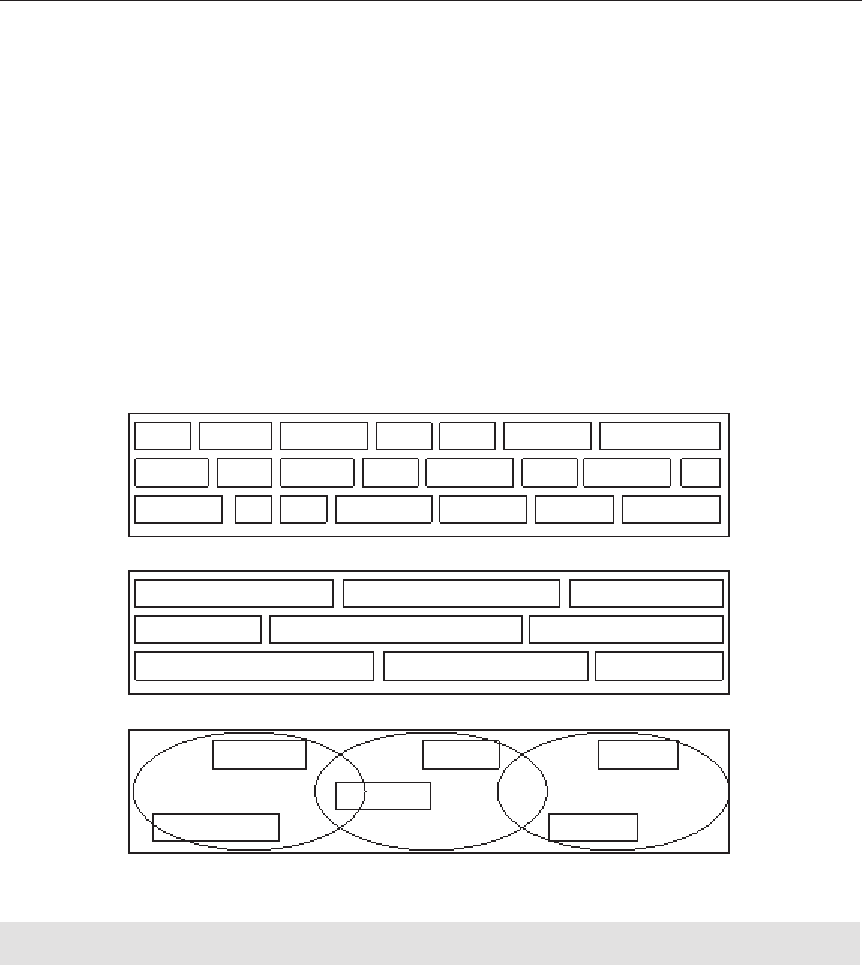
Reading Skills
99
reading speed, almost as if we were reading things aloud. This also forces us to read every
word, making it impossible to skip or infer. It is necessary, therefore, to consciously stop this
method of reading and practice reading and processing with the eyes only. To do this eě ec-
tively, one has to:
• Move from the "see o say (sub-vocally) ounderstand" to just "see ounderstand".
• Practise taking in semantic chunks at a time and practice what is called “mental read-
ing”.
This habit of taking in larger chunks of material at a time also helps in pulling out words
from diě erent lines and synthesizing meaning. Reading, hence, can become simultaneous
with thinking, a way of structuring meaning. One of the ways of adapting to multiple reading
speeds and styles is to practise to read with the eyes only.
Given below is a picture of three eye-movement paĴ erns showing how reading can be
chunked in larger and larger units in the same line and sometimes across lines.
Source: hĴ p://braindance.com/bdiread2.htm
ACTIVITIES
2. Very quickly gloss through the small passage given below in about 20 seconds. Next,
underline the words and sentences you focused on, to quickly get a sense of the mean-
ing. Compare it with the shaded parts of the passage given below.
The study of Mathematics is essential for all children as it has widely ranging
application in day-to-day life. The learning of Mathematics at the primary stage
provides the child with the basic mathematical concepts and skills needed to

Communication Skills for Engineers
100
tackle real-life problems. It helps to cultivate thinking and reasoning abilities,
thereby, strengthens the intellectual underpinnings of social interaction.
The study of Mathematics is essential for all children as it has wide-ranging
application in day-to-day life. The learning of Mathematics at the primary stage
provides the child with the basic mathematical concepts and skills needed to
tackle real-life problems. It helps to cultivate thinking and reasoning abilities,
thereby strengthening the intellectual underpinnings of social interaction.
It is quite possible that you too would have swept your eyes across the key words marked
to get a sense of the meaning. One has to do this while reading selectively and eě ectively at
the same time.
3. Again, read through the paragraph given below and make a note of the semantic chunks
that one has to focus on to get a general feel of the content. AĞ er reading, identify 10
most important words or phrases that would help one to construct the meaning.
The history of the ancient Egyptian state is one of successive periods of uni-
ę cation and fragmentation. Counterbalancing this, is a paĴ ern of civilization
– characterized by such features as the use of writing, an organized system of
religion and divine kinship, and dependence on the annual Nile Ě oods for the
fertility of the land—which links the diě erent periods together through a span
of 3000 years.
With the increasing amount of available information in every ę eld, it has become necessary,
in fact inevitable, that selects are information for reading. One way of doing this is to skim
through most of the material, select what is important and focus on the necessary information.
But this may not be possible in all reading situations. At times one has to read very closely,
focus on every word, even read in-between the lines (inferential reading) to get the meaning
implied.
4. Read the paragraph given below and answer the questions given.
India is a land of ancient civilization that had made fundamental contributions to hu-
man knowledge in the ancient past. Even the discovery of the positional number sys-
tem with the accompanying concept of ‘zero’ is aĴ ributed to ancient India. We already
have a population of more than a billion and may soon become the most populous na-
tion on Earth. Should we rest content with our ancient heritage and keep repeating that
our contribution to knowledge is ‘zero’? Should we continue to be mere borrowers and
users of modern knowledge and modern scientię c technology? When do we give back?
When do we become creators of fundamental knowledge?
1. According to the paragraph, the concept ‘zero’ is:
a. a part of the positional number system.
b. a product of the positional number system.
c. connected to the positional number system.
d. None of the above.

Reading Skills
101
2. Which of the statemets below is most correct?
a. The number system is the only contribution India has made to the world.
b. Ancient India has made many contributions to the world.
c. The contribution of ‘zero’ is the most valuable giĞ of India to the world.
d. None of the above.
3. “Should we … keep repeating that our contribution to knowledge is ‘zero’?” what does
the word ‘zero’ mean here? Does it have more than one meaning?
4. “We already have a population of more than a billion and may soon become the most
populous nation on Earth”. Why has this information been given here? How is it linked
with the questions that have been posed towards the end of the paragraph?
5. What is the meaning of fundamental knowledge? Are there some forms of knowledge
that are not ‘fundamental’? Given below are some knowledge ę elds. How many among
them can you consider to be fundamental?
a. Astronomical discoveries.
b. Diě erent applications of principles of physics in constructions ę eld.
c. Knowledge of herbal medicines.
The Ě ood of print has turned reading into a process of gulping rather than savoring.
—Raymond Chandler
In the activities above, you would have inferred that there are various kinds of readings.
Depending on the need and the type of material, we decide on a reading mode and proceed
accordingly. Most oĞ en, we categorize the speed of reading into the following two types:
1. Skimming
2. Scanning
Skimming is the skill of quickly going through a lot of material to gather the main points. It
is necessary to skim when we are trying to get a general idea or sorting out information, try-
ing to check what might be important or even rejecting information as irrelevant. It includes a
quick noting of conspicuous text like headings, subheadings, bold or italicized words.
Scanning is done to locate a particular piece of information while going through a general
document. It is also done to interpret or reconstruct a paĴ ern in the data presented. We scan
while closely examining schedules, meeting plans or train/Ě ight timings. We also scan the
index or the bibliographical references when we need certain information. This kind of activ-
ity needs close reading and detailed look at information. Sometimes, it might even involve
comparison of facts and data presented.
The categorization done above is based on reading speed. There can also be a categorization
on the basis of the kind of reading. They are:
1. Extensive reading
2. Intensive reading

Communication Skills for Engineers
102
Extensive reading does not focus on particular details but look at ideas and fact paĴ erns. One
does extensive reading while looking for a research problem, geĴ ing a grasp of work done in
a particular ę eld, looking at the trends of publication at a particular time or even reading for
pleasure.
Very diě erent from this, is intensive reading. Like scanning, this involves reading to get
specię c information. But while scanning generally refers to the close checking of lists and
tables, this pertains to reading texts and longer material. Intensive reading is done to closely
follow a line of argument, read in-between the lines and look for implied positions. Prepara-
tion for teaching very oĞ en involves intensive reading. It requires paying aĴ ention to minute
details and understanding detailed facts. Reading for research activity, too, requires intensive
reading.
ACTIVITIES
5. Look at the following data and state the general theme of the writing. What kind of
reading would you like to adopt for this?
In the summer of 1789 the most powerful monarchy in Europe was overthrown by a
popular revolution in favour of constitutional rule. There followed ten years of political
turmoil as moderate parliamentarians and radical republicans fought over the political
future of France. The many diě erent ideals presented by the revolution were impos-
sible to reconcile, and in 1799 a new era of authoritarian rule began under the dashing
revolutionary general, Napoleon Bonaparte.
6. Given below, are some situations in which we do reading. State what kind of reading
you would do in these situations? Remember, depending on your need you would read
the same material diě erently at diě erent points of time. So answer this, given your
present condition and necessities.
• The TV guide for the week
• An English grammar book
• An article in a popular magazine about the famous actors of yesteryears.
• The weather report in your local newspaper
• A bus timetable
• A fax that has come for you at the college oĜ ce.
• An email or leĴ er from your best friend
• A recipe
• A short story by your favourite author
THE SQ3R METHOD
The SQ3R method was put together by Francis Robinson in 1970 as an active and eě ective
method of reading. It is one of the methods best known for reading faster and retaining more.
SQ3R stands for the steps in reading: survey, question, read, recite, review. The following are
the steps in detail.

Reading Skills
103
Survey
Before reading, survey the material. Look through the main and the sub-headings and try to
get an overview. Skim the sections and read the ę nal summary paragraph to get an idea of
what the chapter is about. Pay aĴ ention to introductory and summary paragraphs and refer-
ences.
Question
Ask yourself what this chapter is about: What is the question the reading material is trying to
answer? Repeat this process with each subsequent section, turning each heading into a ques-
tion. Asking questions focuses your concentration on what you need to learn or get out of
your reading. This step requires conscious eě ort that it leads to active reading, the best way
to retain wriĴ en material.
Read
Read one section at a time, looking for the answer to the question proposed by the heading.
This is active reading and requires concentration. If you ę nish the section and have not an-
swered the question, reread it. Think while reading. Consider what the author is trying to say,
and think about how you can use that information.
Recite
Once you have read an initial section, write down (sometimes in the margins of the book it-
self) a key phrase that sums up the major point of the section and answers the question. Here,
it is important to use your own words, and make your own connections. Research shows that
we remember our own (active) connections beĴ er than the ones already provided. At this
stage, writing down the answers to your questions helps in retaining and consolidating your
understanding.
When you read a classic, you do not see more in a book than you did before; you see more
in you than there was before.
—Cliě Fadiman
Review
AĞ er reading the entire material, again ask yourself the questions that you have identię ed
right at the beginning. Review your notes for an overview of the chapter. Consider how it
ę ts with what you already know. Think of the signię cance it has in your general learning
scheme.

Communication Skills for Engineers
104
SUMMARY
• Reading is intimately connected with thinking.
• Taking in more material with every eye movement increases the speed of
• reading.
• Reading selectively and reading without subvocalisation are important.
• Learning skimming, scanning, intensive and extensive reading help us adjust the speed
and manner of reading according to the material to be read.
• The SQ3R technique is very eě ective when we need to do active reading for retention
as well as understanding.
REVIEW QUESTIONS
1. Give a brief account of the diě erent kinds of reading.
2. Look around you and make a list of three kinds of material you use for the diě erent
kinds of readings.
3. What are the diě erent methods one can adopt to practice fast reading?
4. Describe the SQ3R technique as an active reading process.

CHAPTER 6
Writing Skills
‘The thing that gives me and has always given me the most happiness in life, is writing.
The mind celebrates a liĴ le triumph every time it formulates a thought’
—Emerson
Chapter Objectives
This chapter aims to familiarize students with some important forms of writing like paragraph
writing, précis writing, instructional writing, summary and abstract writing. It also discusses
the factors critical for good writing like the processes of writing and sequencing. Further, it
brings into focus the important skill of note-making.
A drop of ink makes thousands, perhaps millions think.
—Byron
THE BASICS OF WRITING
“All language demonstrates three kinds of excellence: correctness, precision, and
elegance. Language also has the same number of faults, and these are the oppo-
sites of the qualities just mentioned”
—Quintilian
We can add a few more factors to those mentioned by Quintilian. All these factors contribute
to clear, Ě uent, and eě ective writing:

Communication Skills for Engineers
106
• Purpose: The reason for writing;
• Audience: The readers;
• Writer’s Process: GeĴ ing ideas, geĴ ing started, writing draĞ s, revising;
• Mechanics: Handwriting, spelling, punctuation;
• Grammar: Rules of verb, agreement, articles;
• Syntax: Sentence structure, stylistic choice;
• Content: Relevance, clarity, originality, logic;
• Word choice: Vocabulary, idioms, tone;
• Organization: Paragraphs, topic and support sentences, cohesion and unity;
Writing can also be seen as the skill of communicating with either the ‘now‘ audience/readers
or ‘later‘ audience/readers through the medium of paper/ screen/display. The eě ectiveness of
writing depends among other factors, primarily on clarity of expression. In addition to clar-
ity of expression, an eě ective writer also needs to have a good style that is appropriate and
unambiguous.
The act of writing anything involves an eě ort to express ideas through the constant use of
eyes. The hand and the brain and comprises a unique way of reinforcing learning and discov-
ering new ways of expressing ideas. Reading is a skill that is very closely related to writing.
Every act of writing is seen as an act of reading, and reading itself is a kind of writing. From
one perspective, writing is the way in which we evaluate or express reading skill, and read-
ing is the way in which we evaluate writing skill. The close relationship between writing and
thinking on one hand and writing and reading on the other makes writing a valuable part of
any language learning or skill-acquiring programme.
All eě ective writers avoid ambiguity. This can be ensured by being careful about the word
order. Ambiguous sentences can be entertaining in their double meaning, but can mar preci-
sion in writing.
ACTIVITY
1. Look at the following sentences and see what meanings can emerge from each and
change the word order to remove the ambiguity in them:
a. I saw our principal walking through the window.
b. Flying planes can be dangerous.
c. Visiting relatives can be boring.
d. He went to the market to sell the house along with his wife.
e. Available–4-bedroom house with lovely trees being constructed by a foreign archi-
tect.

Writing Skills
107
THE PROCESS OF WRITING
Any kind of writing can be seen as a process in three stages:
• Pre-writing
• Writing
• Post-writing.
But it should also be borne in mind that writing is too complicated a process to be broken
up into three neat stages. It is and has to be full of overlaps. It is recursive–oĞ en starts, stops,
loops backward and goes forward again. These stages can be seen as rough break points that
are to be kept as guiding principles while writing.
Pre-Writing
This is probably the most crucial stage in the writing process. It involves forming a thesis
statement and an outline. At this point, one has to formulate a clear idea about the purpose of
writing, the audience and generate ideas about the kind of information one wants to pass on.
Some of the commonly used techniques during this stage are brainstorming, clustering
and clubbing of ideas. Techniques like mind-mapping or using any other way of branching
and organizing would help in sequencing and forming idea clusters in the mind. If you have
been able to arrive at rough headings and subheadings, it is important to check out the fol-
lowing points:
• Do each of your headings describe one of your central ideas?
• Have you been able to add on further sub-points to each? Can you have one paragraph
on each of the main headings?
• Are all the headings free of overlapping ideas?
• Are the headings logically related to one another?
ACTIVITY
2. Take up any one of the given topics, try to brain storm around them and put the ideas
in any order you feel convenient.
a. Creating a sustainable environment.
b. The role of the media in creating stereotypes.
Writing
The next stage is the actual process of writing, elaborating and ę lling out the frame prepared
in the prewriting stage. The important concerns here are, dividing the writing into the intro-
duction, the body, and the conclusion.
In the introduction, it is important to:
• introduce the subject
• set the direction of the writing
• capture the imagination of the reader

Communication Skills for Engineers
108
In the body of the writing, one has to pay aĴ ention to the sequencing of ideas, the logicality
and coherence of presentation and a strong sense of direction. The body of the writing should
contain at least one fully developed paragraph about each of the central ideas listed out in the
prewriting phase. They could follow any logic in the order of presentation (either from the
least important to the most important or any other).
In presenting the main and the sub-points, you could either proceed from the general to the
specię c or from the specię c to the general. Very oĞ en people prefer moving from the general
to the specię c. It is called the funnel method of presentation.
The conclusion is largely responsible for giving the reader a sense of completion, a feel of
tying up the loose ends. It could be a summary or an evaluation of the ideas previously pre-
sented. A conclusion is largely responsible for reinforcing and concretizing the argument of
the writing. It also makes clear the writer’s position on the issue being discussed. One has to
be careful therefore about the way it is worded.
Post-Writing
This is the third and last step in the writing process. It includes the task of rereading the paper
to see what revisions might need to be made. This oĞ en means more than just proofreading
for minor mechanical errors, such as spelling and punctuation. A good writer will always be
critical of his/her writing at this stage. Here, it is important to:
• be objective
• keep the purpose of writing that you had developed in the prewriting stage.
• keep in mind the audience and their expectations.
Along with these factors, you have to focus on the appropriate formaĴ ing paying aĴ ention
to the space, margin and font. Finally, before submiĴ ing, it is important to once again check
for spelling, punctuation, omissions or any other careless mistakes.
Pre-writing Writing Post-writing
Time taken (25%) Time taken (25%) Time taken (50%)
Planning generating infor-
mation
Structuring, organizing that
information in an acceptable
fashion
Revising, polishing the draĞ .
Techniques used: Brain
storming, Branching, Flow-
charting
Techniques used: Com-
parison – Contrast Problem
– Solving
Techniques used: Adding,
Deleting, Simplifying, Eras-
ing errors
By three methods we may learn technical writing: First by education, which is noblest;
second by methodology, which is easiest; and third by planting your buĴ in a chair and
pecking out the damn document, which is the biĴ erest.
—Andrew Plato

Writing Skills
109
ACTIVITY
3. a. Given below are some points that could probably be generated while discussing the
ę rst topic in Activity 2. Put them in the form of main and sub-points in the way in-
dicated. Add more points if you can. Develop it into a well-organized and complete
piece of writing.
Creating a sustainable environment.
• an environment that can maintain itself.
• checking industrial growth.
• controlling harmful gasses/ chemicals/ industry waste.
• monitoring the ozone depletion, glacier melt.
• saving greenery/preserving ground water level.
• checking the contamination of sea water / protecting sea life.
• water harvesting /plastic use/ land ę lls
• saving forests/ planting new forests,
b. Follow the same method–generate ideas, put them in the form of points and sub-
points–and write an essay on the second topic.
PARAGRAPH
A paragraph can be seen as the basic unit of connected writing. A good paragraph is one that
carries a single idea and where the argument or the idea itself is organized logically and pre-
sented coherently. The topic sentence, which is the main sentence of a paragraph, conveys the
central theme or idea. It is generally wriĴ en in the beginning of a paragraph. However, it can
be wriĴ en either in the middle or at the end of the paragraph. If mentioned at the beginning,
the sentences aĞ er the topic sentence are explications or extensions of it. But if it comes at the
end, the sentences generally lead the reader to the topic sentence. Sometimes a topic sentence
can be implicit within a paragraph when it is not wriĴ en. In such a situation, the other sen-
tences of a paragraph should lend support and substantiate the topic sentence.
One of the skills needed to develop or organize a paragraph well is appropriate sequenc-
ing. While writing a paragraph, one has to keep in mind the logical ordering of ideas.
Sequencing
Sequencing is the skill of organizing a textual material, deciding the priority, the focus of the
diě erent points and consequently the order in which they should be presented in a paragraph.
Sequencing is also about linking up ideas and concepts and using the correct linkers to show
the relationship they have with one another. Linkers are essentially thought connectives. Some
of the widely used linkers are as follows:
In addition to; further; moreover; apart from; although; however; though; in spite of; whereas; on
the contrary; for example; for instance; thus; such; in addition; furthermore; then; in this case; indeed;
surely; above all; certainly; in the same way; on the other hand; in contrast; whereas; instead; similarly;

Communication Skills for Engineers
110
more importantly; additionally; in the same way, because, especially, then, of course, fortunately, before,
aĞ er, besides, well, in other words, even; but etc.
In addition to using linkers, sequencing also involves using the appropriate words and
making the writing brief, crisp and clear. AĴ empt the following activities.
ACTIVITIES
4. The following passages are in jumbled order. Read them carefully and sequence the
sentences to make the passages logical and coherent. The ę rst sentence (S1) of the pas-
sages has been given at the beginning:
S1. In every society, there has always been some or the other form of education, but not
necessarily schools.
a. In some places, pupils trained under a master craĞ sman in whose household he
lived with other trainees: here they were taught the skills, the ethics, the principles,
rules and customs of business.
b. In certain ways, they were beĴ er educated than their descendants today.
c. Two hundred years ago, very few people in India went to schools or colleges.
d. The peasant in the village learnt the arts and skills of farming, together with a lot of
traditional wisdom about the earth, the sky and living things.
e. But this lack of institutional education did not mean that people were not as or in
cases beĴ er educated than we are today.
S1. A detergent is one of a class of chemicals used for cleansing purposes.
a. They lather easily even in hard water.
b. Soapless detergents diě er from soapy detergents in that they contain no animal
fats.
c. The earliest known detergent was soap.
d. However, detergent foam in sewage works and rivers can cause problems. There-
fore detergents now are of a soĞ or biodegradable kind, which can broken down by
bacteria.
e. But there is also a soapless detergent as distinct from soap.
5. The sentences in the following passage are all jumbled. Rearrange them in a logical se-
quence. You may divide the passage into as many paragraphs as you consider correct.
It is not really a question, in spite of the question mark. The complications begin, of
course, when you must use two rules at once. A casual, yet correct introduction oĞ en
involves merely saying the two names, or formally saying – this is…, I’d like you to
meet…, may I introduce…? Children rise when introduced: a lady rises to meet a well-
known person or an elderly woman: and a gentleman rises for all occasions. Introduc-
tions form an essential part of social intercourse and have their own etiqueĴ e. When
one says – how do you do? – The reply is the same – how do you do? – though some

Writing Skills
111
people prefer – glad to meet you – either instead, or additionally. They are governed
by three simple rules. Introductions also have their own set phrases. In such cases, use
a mixture of respect and common sense. The normal reply is – how d’you do? – Intro-
duce the younger person to the older; introduce the less important person to the more
important; and introduce the male to the female. For example, introduce a very young
girl to a much older man.
6. Rewrite the following text appropriately by cuĴ ing out the redundant words and re-
phrasing the sentences.
“In many parts of the world there are large areas of potentially good land that cannot
be used for agriculture because they are either too dry or too wet. But by engineering
skill–devising eĜ cient methods of irrigation, drainage, or Ě ood control–and improved
agriculture, it is oĞ en possible to reclaim such land.”
7. You are taking a wriĴ en test for promotion in the company. Your ę rst question is a
badly wriĴ en passage. You are expected to correct and edit the passage appropriately:
“Research in solar energy is as sophisticated and intensive in India as anywhere else
in the world. For ten months with the year, six to eight hours in a day, much of India
receives high intensity, fairly uniform and equal sunshine. The India government has
therein given priority at six projects in the development of solar energy.”
8. Read the following passage and ę ll in the blanks appropriately. Choose from the list of
words given:
I like everything about my motorbike,
its colour and speed. recently, its
pickup has decreased. I don’t know why. I’ll take it to a mechanic
it becomes
worse. Most mechanics these days are undependable, but
my mechanic is reli-
able
being economical. Actually, I bought my bike in 1998, I have been
having a good driving time, except
for an occasional problem here and there.
It has been giving me a decent mileage. I feel the mileage will increase further in a few
days’ time,
I’m taking that extra liĴ le care of it. , I’ll have to wait and see.
But in the meantime, a friend of mine advised me to sell the bike and buy a diě erent
model. I don’t think I’ll do that, at least not in the near future. I will use it for ę ve more
years and
I’ll sell it may be. But the idea is very disagreeable to me.
List of words: but , because, especially, then, of course ,fortunately, before, aĞ er, besides,
well, in other words, even.
9. The editor of a daily has invited readers to send their views on the following topics. You
decide to write a paragraph on each. You may make use of the hints given:
a. Privatization of higher education – less strain on government; beĴ er quality; sincer-
ity and commitment; seĴ ing of value; placements
b. Global warming – decreasing green cover; rapid urbanization and industrialization;
aě orestation; environment-friendly aĴ itude and policies.

Communication Skills for Engineers
112
10. Read the following:
Only exceptionally, people ę nd a long journey by motorcar agreeable. Mostly a long
non-stop journey by train is much more comfortable and enjoyable. The tracks, the
coaches and the smooth though swiĞ motion all add to the pleasantness of the train
journey. Looking at the beautiful countryside from a window seat has its pleasures too.
One can experience a sense of adventure together with a restful sleep. Modern railway
travel is much more comfortable than in the past. It revives the childhood excitement of
visual and imaginative delight.
Now, write out a paragraph listing some advantages of motorcar journey over the train
journey.
11. Here are two topic sentences given. Write out two separate paragraphs building on and
supporting the topic sentences:
a. The computer has made the business world more eě ective.
Hints: saving of time and space; quickness in communication and trade.
b. Motivation is important for beĴ er performance in business and industry.
Hints: enthusiasm; alertness; self and company image; drive for prosperity.
Read the following:
The slogan of an anti-liquor campaign read: Alcohol kills you slowly.
The next day there was a rejoinder wriĴ en below it: We are not in a hurry.
INSTRUCTIONAL WRITING
Instructional writing is the ability to write out instructions precisely and unambiguously to
prospective readers. It generally has an overt or a covert style of puĴ ing across certain do’s
and don’ts in a given context. The most common form of instructional writing is found in
diě erent kinds of user manuals. The context can be commercial, academic, personal, social,
investigative or any other in nature. In a world of increasing gadgets and equipment, instruc-
tional writing has become an essential skill to be learnt. One has to have wriĴ en instructions to
be able to use a camera, to prepare income tax returns, to program VCRs and to run machines.
To write a piece of instruction, one has to do the following:
1. Deę ne the goal clearly.
2. Determine the audience.
3. Decide the most acceptable sequence.
4. Use visual aids where necessary.
It is important for instructional writing to ę rst deę ne the end result. One has to be clear
whether one wants the writing to help people understand the process involved in a gadget or
simply to operate the gadget.

Writing Skills
113
Determining the audience is equally important in instructional writing. One has to esti-
mate the awareness level of the audience in the ę eld, determine the kind of exposure they
have had and then determine the kind of instructions to be given.
To determine the right sequence of presentation in instructional writing, one has to oĞ en
foresee diĜ culties. One has to be able to think what can go wrong or where one can be con-
fused at each step, give the solutions and accordingly determine the steps. The following is
an example of the kind of instructions that are given to a beginner and to an experienced user
respectively.
Logging instructions
Beginner:
1. Flip on the power switch. It is on the back of the terminal to the leĞ .
2. Press the return key until ENTER CLASS appears on the screen.
Note that the computer has a 20-second time limit on the 6 instructions that follow. So you
must move right along or you will have to restart.
3. Type in “3”. The VAX is a class 3 option.
4. Press the return key. The computer will respond with “GO”.
5 The Computer Will then Display “User Name” On the Screen.
6. Type in “SHREE GANESH”. This is the training session user name.
7. Press the return key. “Password” will be displayed.
8. Press “ENTER” To Begin your work.
Advanced user:
Turn the terminal on.
Type return.
Type 3, Return.
Type, Return, Return.
Insert user name, Return.
Password.
Adapted from Technical Report Writing Today by Steven E. Pauley and David G. Riordan.
ACTIVITIES
12. Your friend is planning to come to your house for dinner. As he is coming for the ę rst
time he is not sure of the exact location of your house. Write out a set of instructions
mentioning the important landmarks. You may make use of hints like turn right, come
straight, crossroads, water tank, hotel and phone booth.

Communication Skills for Engineers
114
13. The makers of ALL-CLEAR washing machines in your town urgently need to print out
copies of the User Manual next week. You are engaged in writing a set of 5 instructions
for the manual. Write them out clearly and precisely. Use the following hints:
Running water tap; outlet pipe; select speed; soak facility; disconnect
14. You have been engaged by LUSTRE to write four instructions for their new hair dye
product named L’HAIRBL. Make use of the following hints:
Bowl, spoon, warm water, glove, comb
PRÉCIS WRITING
The word précis is adopted from French and signię es a ‘summary’ or an ‘epitome’. Writing
a summary of a text, whether it is a speech, a biography or any other, is a diĜ cult and useful
skill, demanding concentration, comprehension and condensation. AĞ er understanding a pas-
sage, we have to compress it. In compressing a passage, selection, rejection and generalization
are oĞ en useful. The general practice has been to prepare the summary of a paragraph in
about a third of the original. However, there is no ę xed rule about this. You may also give a
title to the summary.
Points to Remember
While writing a summary,
• separate the relevant points from the irrelevant ones
• arrange the ideas systematically in a logical sequence
• condense material in as short a form as possible
• avoid using the same words, phrases and expressions used in the text
• rephrase the material in simple language
• avoid comments, abbreviations, symbols and examples.
Look at the following example:
An old man came to Hyderabad for the ę rst time. His daughter was employed in Hyderabad
but she could not come to the station to receive him and take him home. The old man came out
of the station. He spoke to a taxi driver, negotiated the charges and gave him the address. He
got into the taxi; the taxi started but it moved at such incredible speed and in such an erratic
manner that it almost collided with a van; aĞ er sometime, it was about to knock down a traĜ c
personnel and collide with a lorry. The old man got scared. ‘Take care’, he cried out, terrię ed.
PaĴ ing on the driver’s shoulder to aĴ ract his aĴ ention, he said ‘you are frightening me by this
manner of driving. I am afraid I will be in the hospital instead of my daughter’s house. I want
you to be more careful. This is the ę rst time I am going by car. I am very nervous”. The driver,
who was sweating by now said, ‘I understand your nervousness; I sympathize with you. This
is the ę rst time I am driving a car!’ (About 190 words)

Writing Skills
115
Précis:
Their first attempt
A taxi hired by an old man who arrived in Hyderabad was traveling erratically at great speed.
It narrowly missed hiĴ ing other vehicles. The terrię ed passenger requested the driver to slow
down. He even said that it was the ę rst time he was traveling by car. The driver expressed his
sympathy and added that it was the ę rst time he was driving a car! (64 words)
As far as possible, it is preferable to use your own words in making a summary. However,
in the case of any important expression, the original words may be retained.
ACTIVITIES
15. Rewrite the following sentences, condensing them wherever possible without altering
the meaning.
Example: This is an engine-propelled road vehicle.
This is a car/bike.
1. It was not without substantial feelings of pleasure that I did the work for them.
2. The liĴ le feathered creatures in the sanctuary made such sweet sounds!
3. Aunts, uncles, grandparents, and cousins are generally helpful and useful.
16. Write a précis of the following passages, condensing them wherever possible without
altering the meaning.
First and foremost there are order and safety. If today I have a quarrel with another man,
I do not get beaten merely because I am physically weaker and he can knock me down.
I go to law, and the law will decide as fairly as it can between the two of us. Thus in
disputes between man and man, right has taken the place of might. Moreover, the law
protects me from robbery and violence. Nobody may come and break into my house,
steal my goods or run oě with my children. Of course there are burglars, but they are
very rare, and the law punishes them whenever it catches them. It is diĜ cult for us to
realize how much this safety means. Without safety those higher activities of mankind
which make up civilization could not go on. The inventor could not invent, the scientist
ę nd out or the artist make beautiful things. Hence order and safety, although they are
not themselves civilization, are things without which civilization would be impossible.
They are as necessary to our civilization as the air we breathe is to us; and we have
grown so used to them that we do not notice them any more than we notice the air.
(From Our Own Civilization, C E M. Joad, 209 words)
17. In democratic countries men and women are equal before the law and have a voice and
choice in deciding how and by whom they shall be governed. But the sharing of money,
which means the sharing of food grains and clothing and shelter and knowledge and
other such essentials is still very unfair. On one hand some people live in luxury, on the

Communication Skills for Engineers
116
other hand, many have not even enough to eat and drink and wear. Even in the rich-
est of the world’s cities thousands of people live in miserable surroundings. There are
many families of four, ę ve or six persons who live in a single room; in this room they
sleep and dress and wash and eat their meals; in this same room they are born, and in
this same room they grow up and die. And they live like this not by choice or for fun,
but because they are too poor to aě ord another room. It is, I think, clear that until and
unless everyone gets his or her proper share of necessary and delightful things, our
culture and civilization will be far from perfect. (188 words)
18. Yet another great defect of our civilization is that it does not know what to do with its
knowledge. Science, as we have seen, has given us powers ę t for the gods, yet we use
them like small children. For example, we do not know how to manage our machines.
Machines, as I have already explained, were made to be man’s servants; yet he has
grown so dependent on them that they are in a fair way to become his masters. Already
most men spend most of their lives looking aĞ er and waiting upon machines. And the
machines are very stern masters. They must be fed with coal, and given petrol to drink,
and oil to wash with, and must be kept at the right temperature. And if they do not get
their meals when they expect them, they grow sulky and refuse to work, or burst with
rage, and blow up, and spread ruin and destruction all round them. So we have to wait
upon them very aĴ entively and do all that we can to keep them in a good temper. Al-
ready we ę nd it diĜ cult either to work or play without the machines, and a time may
come when they will rule us altogether, just as we rule the animals.
(From Our Own Civilization, C E M. Joad, 212 words)
ABSTRACT WRITING
Abraham Lincoln always labored to keep his speeches short. He spoke a liĴ le
more than two minutes at GeĴ ysburg, some 50 minutes less than Bill Clinton did
at the 1992 Democratic convention.
An abstract is a brief summary of the contents of a research report, article or presentation.
Generally, the title and author(s) name are added to give it context. Traditionally, the abstract
covers an Introduction, Methods, Results and Discussion (IMRD format) – in the shortest
amount of space possible.
1. The Introduction typically describes the problem and its importance. It should in-
clude:
a. Appropriate problem description.
b. The specię c questions you are going to answer.
c. The purpose, motivation or relevance of your problem.
d. What you hope to learn or achieve from your research.

Writing Skills
117
2. The Methods are the framework, procedures, and tools for investigating your deę ned
problem. As part of this, you need to:
a. Summarize all the important information related to strategy and methodology
b. Describe the analytical techniques used.
3. The Results (or outcomes) of your work should be concisely and objectively listed in a
logical sequence. Here you should mention if:
a. any comparisons are being made to existing ideas.
b. you have developed soĞ ware or hardware.
c. you did a benchmark study and if it was appropriate to do so.
4. The discussion (or conclusion) oě ers an evaluation and interpretation of your ę ndings
and makes some suggestions about solutions to your stated problem. Can you make
generalizations or projections of new insights into your scientię c ę eld? Are there any
future improvements to consider?
The art of writing a good scientię c abstract is to:
• Address the four key elements of the IMRD format using two or three well-constructed
sentences per element.
• Use simple statements
• Use precise language
• Use well-known abbreviations to keep it short and simple
In today’s world of fast business transactions, the skill to write precisely yet brieĚ y has
become a necessity. For eě ective writing, you have to avoid unnecessary details, roundabout
expressions and come to the point directly. Look at the following excerpt from a leĴ er:
“We are in receipt of your esteemed leĴ er of 5 September and in reply beg to
state that we have conveyed the information to our head oĜ ce in CalcuĴ a. On
hearing from them we shall be in a position to convey to you our exact and con-
sidered decision.”
We can put the same information in the following form.
“Thank you for your leĴ er of 5 September. We have wriĴ en to our head oĜ ce in
CalcuĴ a and shall let you know our decision on hearing from them.”
Sentences can be abridged sometimes by substituting words or phrases or removing orna-
mental and superĚ uous expressions. Read the following illustrations.
1. a. His conduct was such that it could not be excused.
b. His conduct was inexcusable.
2. a. When I began to write my ę rst report it occurred to me that one method by which I could
make it more eě ective would be to include a series of diagrams.
b. While writing my ę rst report, I realized that including diagrams will make it eě ective.

Communication Skills for Engineers
118
ACTIVITIES
19. Abridge the following sentences:
a. He refused to accept the explanation given by the mechanic.
b. I cannot do this unless I have the instruments, which are necessary for the work.
c. AĞ er a thorough investigation was made, it was decided to make an exact estimate
of the value of the property that was damaged.
d. The immediate objectives or the short-term goals of any organization are present
along with the necessity of having long-term goals or goals of longer range. Even
while the incessant ę ght with daily crises like supervising, hiring, selling and proę t
making goes on, any forward-looking organization is also concerned with the com-
pany’s general growth, reputation, and more importantly, creating and establishing
an identity.
e. An appropriate understanding of a plan by the people who are concerned with a
company plays an essential part in its fulę llment. They should all be able to under-
stand the main lines or the direction in which development is expected to proceed
in the future. They should also be able to see the progress in diě erent directions and
establish the links necessary to relate to one another and see how it can be strength-
ened and how ę rmly establishing one area can help in strengthening other areas
too.
20. A new employee of your oĜ ce has just given in a clumsily wriĴ en passage. As the chief
editor, you need to edit it by making it concise and appropriate:
The very need for food, fodder and fuel has increased tremendously in the last few
recent decades. Trees are being cut down ruthlessly and mercilessly for non-forest pur-
poses like agriculture, dams, roads, defence and transport. This has resulted in and
led to depletion of forest wealth, which in towns is leading to Ě oods, siltation of dams,
water shortage, logging and also increaseing erosion of fertile soil.
21. Read the following passage and write out its abstract in about eighty words:
One of our most diĜ cult problems is what we call discipline, and it is really very com-
plex. Actually, society feels that it must control or discipline the citizen, shape his mind
according to certain religious, social, moral and economic paĴ erns. Now, is discipline
necessary at all? Please listen carefully, don’t immediately say “yes” or “no”. Most of us
feel, especially while we are young, that there should be no discipline, that we should
be allowed to do whatever we like, and we think, that is freedom. But merely to say that
we should be free and so on has very liĴ le meaning without understanding the whole
problem of discipline.
The keen athlete is disciplining himself all the time, is he not? His joy in playing
games and the very necessity to keep ę t makes him go to bed early, refrain from smok-
ing, eat the right food and generally observe the rules of good health. His discipline is
not an imposition or a conĚ ict, but a natural outcome of his enjoyment of athletics.
Now, does discipline increase or decrease human energy? Human beings through-
out the world, in every religion, in every school of philosophy, impose discipline on the

Writing Skills
119
mind, which implies control, resistance, adjustment and suppression—is all this neces-
sary? If discipline brings about a greater output of human energy, is it very harmful,
destructive? All of us have energy and the question is whether that energy through dis-
cipline can be made vital, rich and abundant, or whether discipline destroys whatever
energy we have. I think this is the central issue.
22. In the following paragraph, can you eliminate more than 15 words?
“Edit ruthlessly. Somebody has said that words are a lot like inĚ ated money—the more
of them that you use, the less each one of them is worth. Right on. Go through your en-
tire leĴ er just as many times as it takes. Search out and annihilate all unnecessary words
and sentences—even entire paragraphs.”
Read the following:
A legal secretary once sent a leĴ er to a client saying, “kindly aĴ end at my oĜ ce
in order that we might execute the necessary documentation”. AĞ er receiving
the leĴ er she called the oĜ ce and reread the instructions to her with a question
in her voice. “Does this mean I have to come in and sign some papers?”
Difference Between an Abstract and a Summary
Most reports consist of a synopsis, which is called an abstract or sometimes a summary. An
abstract tells what the report is about and gives the extent of coverage. A summary gives the
substance of the report without any illustrations and explanations. An abstract will give the
method of analysis, the signię cant ę ndings, the important conclusions and the major recom-
mendations. The abstract is generally about two to three per cent of the original while the
summary is about ę ve to ten percent. In order to facilitate quick and easy comprehension for
the reader, both these elements should be self-suĜ cient and intelligible, without reference to
any other part of the report.
NOTE-TAKING
Note-taking is a skill widely used by students and teachers alike. It is primarily a way to ę lter
and jot down the important ideas or comments. One can even make notes while going through
an experiment. This would involve commenting on the problem, the outcome and probable
solutions. Notes have to be taken in the classroom, while preparing for the examination and
also while referring to reference material. Notes are also taken to jot down important points
in a lecture, or to document an important discussion or presentation. These points can be put
in a linear form where the main points and the sub-points are aligned diě erently to make the
diě erence clear, or they can be put in the form of a Ě ow chart where the sub points emerge
from the nodal points. Finally, they can be even put in the circular form of a mind map where
they branch out from the centre to the margins. (This form has been discussed in detail in the
next chapter under mind-mapping.)

Communication Skills for Engineers
120
Given below are a few sentences and their main points. How can they be reduced to the
form of notes?
1. a. Artię cial intelligence is one of the most useful modules we have in this course
b. Art intll—very useful module.
2. a. It is important to get into a pollution-free mode of production. Otherwise, the price
we have to pay will be very heavy. Life under sea and on earth might even perish
b. Pollution-free environment is a must. If not, life might end
• On land
• In the sea
An important part of note-taking is identifying the main and the sub-points in a piece of writ-
ing. It helps you organize the ideas, and comprehend the meanings as related, yet distinct
chunks.
Look at the following example:
Recession
Economic growth occurs in a country when all the factories and oĜ ces are working and the
national income is going up. History shows that in most countries economic growth is not
constant. Even the advanced countries like the United States and Britain go into recession
on a regular basis. Unemployment increases, factories and oĜ ces are closed down, and the
economy produces fewer goods than it could if its resources were being fully utilized.
Sometimes the recession is particularly bad and develops into a depression. In the great
depression of the 1930s, the national income of the United States fell from $95.2 billion in 1929
to $48.6 billion in 1933. One in four workers became unemployed. Reduced imports dragged a
few other countries like Britain, Germany and Australia into depression too. Most people in a
country are likely to suě er from the eě ects of a depression. Wages may fall, cuĴ ing the spend-
ing power of workers lucky enough to keep their jobs. The unemployed and their families are
thrown into poverty. They have to rely on state beneę ts and charity for support.
One can make notes of this piece of writing in the following way:
1. Signs of economic growth
• Working factories/oĜ ces
• National income is up
2. Recession in advanced countries, a regular phenomenon
• USA in 1930’s
• One in four became jobless
• National income fell from $95.2 billion to $48.6 billion
• Reduced imports that aě ected other countries too.
3. Impact of recession
• Wages fall, cuĴ ing spending power.
• Unemployment increases
• Families, dependent on state support.

Writing Skills
121
ACTIVITY
23. Given below are some paragraphs. Make notes; try to minimize them like the ones done
before.
a. In the countries of the western part of the world, particularly those of Europe, and
America, rice (Oryza sativa ) is not a very important cereal, yet, it is the chief food
of about half of all the people in the world. This is because enormous numbers of
people who live in China, Japan and India, as well as other parts of Asia such as
Malaysia and the Philippine Islands, live mainly on rice. Rice yields more food per
hectare than any other grain and Asia does not feed itself with any other crop. Al-
though Asia produces more than nine-tenths of the world’s output, rice has still to
be imported in years of poor harvest. Time and again, in Asia, failure of the rice crop
has resulted in famine and starvation.
b. As the name implies, mini-computers are small computers. Unlike a mainframe
computer which might ę ll an entire room, a mini-computer may ę t in a single rack
or box. In fact, it is a scaled down version of the main-frame computer.
c. History is a process of recording the past. However, we should remember that past
was not always recorded the way we do it today in history books. Writing on stone
tablets, folklores, popular sayings, and temple documents were also recordings of
history. But these mediums envisaged history diě erently. The present form of re-
cording history, where authenticity and objectivity are emphasized, began only a
century and half ago.
d. The sun is the most direct source of energy. It powers the Ě ow of wind and water
cycle and sustains all life. Plants use this energy to synthesize carbohydrates from
simple substances like carbon dioxide and water. All the food is derived from the
process of photosynthesis. In fact, the energy by which animals including the hu-
man beings live is generated by oxidation of the food produced by the plants.
Points to Remember
• Make the notes brief:
(Never use a sentence when you can use a phrase.
Never use a phrase when you can use a word).
• Use abbreviations and symbols.
(Remember to use them consistently).
• While note-taking, focus on outline and be aware of the main and the sub-points.
SUMMARY
• Correctness, precision, and elegance are very important for good writing.
• Careful word order is important for clear as well as unambiguous writing.

Communication Skills for Engineers
122
• Pre-writing, writing and post writing are the three important processes involved in any
good writing.
• Paragraph along with sentence is the basic unit of writing. Proper sequencing is very
important here.
• Précis writing is generally done to reduce the given paragraph to one third of its
length.
• For summary writing, it is important to condense and also arrive at the most important
points.
• Note-taking is a means to ę lter out important points and organize the paragraph into
main and sub-points.
REVIEW QUESTIONS
1. What are the factors that contribute to clear, Ě uent, and eě ective writing?
2. What constitutes the content of any writing?
3. How do we organize our ideas while writing a paragraph?
4. What is a précis and what are the three main features of a good précis?
5. Discuss the notion of sequencing.
6. What do you understand by the term instructional writing?
7. What is the diě erence between abstract writing and summary writing?
8. What are the important features of note-making?

CHAPTER 7
Creativity and Mind-Mapping
Chapter Objectives
This chapter aims at examining the vital subjects of creativity and mind-mapping. It talks of the dif-
ferent manifestations of creativity and how they are important in our personal and academic life. The
chapter aims to make readers aware of how creativity can be nurtured and used. It also discusses mind-
mapping as one of the ways of expressing and developing creativity. It gives a detailed account of how
mind-mapping can be seen as working with and complementing the functioning of the brain while being
used effectively for organization and creativity simultaneously.
CREATIVITY
You have in you all and a thousand times more than is in all books.
Never lose faith in yourself; you can do anything in this universe. Never weaken your-
self, all power is yours.
—Vivekananda
Creativity can be described as a way of thinking. It is the manner of evolving new thoughts,
approaching solutions diě erently, or simply adapting to a diě erent manner of living or pro-
fession. With changing perceptions, we no longer believe that creativity is inborn. It is a poten-
tial that every one of us possesses. The diě erence lies in whether we have been able to nurture
it, develop it, or tried to give it an expression and direction. Similarly, every situation has the
potential to be creatively altered or improved. What is necessary is exploring alternatives, and
ę nding ways of doing things.

Communication Skills for Engineers
124
TIMES WHEN WE ARE CREATIVE
Even the most creative people are not equally creative at all times. Similarly every person does
become creative at certain times. Let us look at a few situations that are conducive for creativ-
ity, which make us think diě erently.
Thinking up a new idea
There are many occasions when suddenly we look at a problem diě erently, we ę nd a new
solution, and we phrase a thought or even try out a new recipe. All these, and many more are
expressions of our creativity. At times, it can be the understanding of the source of disagree-
ment or even a child discovering how to ę x a set of puzzles. We have to understand that cre-
ativity isn’t the realm of profound thinking only. BaĴ ing elegantly and with improvisation in
the cricket ę eld (or even writing a business report diě erently) is also creativity.
Leonardo da Vinci, creator of Mona Lisa’s smile was also the creator of the con-
tact lens. Back in the 1500’s, he found that the best way to correct poor vision was
to put a short water-ę lled tube sealed at the end of the Ě at lens against the eye.
This idea has become the contact lens of today.
In 1904, Arnold Fornachou, an ice cream vendor exhausted all his paper dishes
while serving icecreams to customers at a fair. Luckily, he was then standing
opposite to a baker who was selling thin waĝ es. History has it that he bought a
few, twisted them into cones, scooped ice creams into them and lo! the ice-cream
cone was born.
Doing something spontaneous
Sometimes, in a moment of inspiration, we give a speech oě -the-cuě , respond spontaneously.
We may try a new route or decide to try out a new combination of clothes successfully–some-
thing we never thought would jell before. All these are outlets to our personal creativity. They
are moments you cannot always repeat. These are also moments when we are at our best,
competent and conę dent.
Creativity and building relationships
Fostering a meaningful relationship too means creativity. Sometimes we change our approach
to meaningfully deal with a person. We steer a relationship to a win-win situation and create
a context that can be based on collaboration and cooperation. The way we establish and nur-
ture our relationships are indicative of the quality of our underlying creativity. The way we
express ourselves in our relationships, too, manifests creativity.

Creativity and Mind-Mapping
125
I cannot teach anybody anything. I can only make them think.
—Socrates
A ę rst-rate soup is more creative than a second-rate painting.
—Abraham Maslow
ACTIVITIES
1. Find out ę ve ways to:
a. avert environmental pollution 10 years from hence.
b. make cooking easier.
c. solve the problem of excess population 20 years hence.
d. lower the stress level of your friends.
e. convince your girl friend / boy friend to come to a movie with you.
2. List down the names of three people you dislike. However ę nd 3 qualities in each of
them, that is appreciable.
3. Make a note of two situations, which make you very uncomfortable. Devise 3 things
you can do in each of the situations to be more at ease.
1. ___________________ 2. __________________
a. ……………………… a. ………………………
b. ……………………… b. ………………………
c. ……………………… c. ………………………
WAYS IN WHICH YOU CAN BE CREATIVE
Creativity manifests itself in many ways. Diě erent people experience it diě erently. Some of
the ways in which creativity blossoms are:
Creativity through Visioning
One way of ę nding creative solutions to problems is by visioning, through which you seek the
ideal, long-term solution to problems. During visioning you let yourself go, imagine what it
could be like if dreams came true or if problems were solved. It oĞ en helps in providing direc-
tion, inspiration and momentum to creative projects. Questions like: What would I like to be
10 years from hence? Help us form long-term objectives and focus our eě orts.”
In 1961, J. F. Kennedy shared his vision with the nation. He had a dream that
within the next ten years the U.S. would send a man to the moon. By the time
Neil Armstrong ę nally took his “giant leap for mankind”, Kennedy’s vision had
become the vision of the nation.

Communication Skills for Engineers
126
In the 1850’s a 17-year-old tailor noticed that cloth trousers of miners wore oě
very quickly. He then started stitching overalls made of a stiě canvass that could
stand wear and tear. Years later he substituted the canvass with a fabric called
denim and dyed it blue to minimize the soil stains. Thus came the blue jeans.
The tailor’s name was Levi Strauss.
Creativity through Exploring
This method of exploring your creativity involves questioning and challenging the core as-
sumptions, making a radical breakthrough and coming up with new assumptions. This style
of creativity works without any consideration of long-term goals, even consideration of the
practical realities. The typical questions one asks in this process are: How can I break away
from all the givens and establish an alternative?
In 1948, a Swiss mountaineer was troubled by the prickly burrs that tightly clung
on to his socks. As he sat tearing them oě , an idea struck him. He studied the
burr’s clinging properties and invented a fastener that made the zipper obsolete.
This was the invention of the velcro. The man’s name was George De Maistred.
It is important to remember that each of our styles of creativity is a mixture of these. All of us
function in the ways mentioned above at one time or the other.
ACTIVITY
4. Look at the questions given below. Categorize them into one of the types of creativity.
a. What could give us a world-class processing unit?
b. None of this works. How can we rewrite the rules of competition?
c. How can we bring together the best we have in our diě erent teams?
d. How can we improve upon our core strengths?
e. What should be our long-term goals and strategies.
f. What could we possibly do to shake up things and bring about a total change?
DEVELOPING YOUR CREATIVITY
While talking about the ways in which we express our creativity and the styles we adopt to
be creative, the constant question that comes up is how do we develop our creativity? Does it
happen automatically or is there a way by which one can practice to make it happen.
If we analyze the nature of creativity we ę nd in it a mixture of intuition and logical think-
ing. All discoveries have been made with logical thinking acting as the base for insight to Ě ash
and make the ę nal connection or vice-versa. It is one followed by the other, or both operating

Creativity and Mind-Mapping
127
together to form a cognizable whole. It is seen as a phenomenon of ideas coming from ‘the
back burner of our minds – cooking away’ beyond our conscious awareness. Sometimes we
even place it there unintentionally until it matures and pops into our minds’.
This can happen at a time when the mind is relatively rested–alert but not involved in a
stream of thought. The art of developing creative skills, thus, is to train the mind to produce
these “spaces”, create opportunities for our intuition to act on our logic and form a whole. It
is important, therefore, to create this intuitive space.
Friedrich Kekule had been working for years to discover the molecular structure
of benzene. One night, he says, he dozed oě in front of the ę replace and saw a
vision as if in a dream: “Again atoms were juggling before my eyes… everything
was moving in a snakelike and twisted manner. Suddenly one of the snakes got
hold of its own tail and the whole structure was mockingly twisted in front of
my eyes. As if struck by a lightning, I awoke”.
He had envisioned the closed ring structure of benzene.
Srinivasa Ramanujam, the Indian Mathemetician, is known to have reported that
he arrived at the solutions to his problems in his dreams. He would dream of a
stream of blood where goddess Kali would write out the solutions for him.
There is no logical path to the natural laws. Only intuition, resting on the sympathetic
understanding of experience, can reach them.
—Einstein.
Creating the Intuitive Space
If we look into the history of inventions, we ę nd that the most original ideas arise from the
space in between our thoughts. To improve one’s creativity, thus, it is important to understand
these spaces. This is the phenomenon we can sometimes observe during anyone performing
at his or her best. What is signię cant is the ease, the grace and the conę dence that comes in
during this state of consciousness. The act is done as if it were natural, as if there was no other
way it could be done. We ę nd it during an athlete’s peak performance, a speaker giving one
of the best addresses or a writer writing the most intense parts of his masterpiece – alert and
active, yet loose and Ě uid.
Intuition is knowledge gained without rational thought. It comes from a stratum of
awareness just below the conscious level; it is slippery and elusive. New ideas spring
from a mind that organizes these experiences, facts and relationships to discern a path
not taken before.
—Roy Rowan

Communication Skills for Engineers
128
ACTIVITY
5. Whenever you need to relax, close your eyes and visualize the following:
a. The vast, expansive blue sea. Try to hear the roaring of the waves. Feel the waves
dashing against your legs and retreating.
b. Feel the cool evening breeze Ě owing over your skin. Try the recreate the cool, re-
laxed state it takes your mind into.
c. Think of the hot blazing aĞ ernoon sun. Feel your skin scorching in the heat, your
eyes glazed with the shine.
d. Visualize a forest thick with trees. See the blanket of green over your head, hear the
rustle of dry leaves beneath your feet.
FACTORS THAT BLOCK CREATIVITY
Look at the way a child plays. Carefully listen to the conversations they make. You will be
amazed at the number of creative ideas that spring forth every second. Children are creative.
But our adult life, our system of education and the thinking it promotes block our creativity,
stops the Ě ow. Many factors in our lives contribute to this. Some of them are:
Fear: Fear is one of the emotions that oĞ en forces us to limit ourselves. Fear of being rejected,
fear of uncertainty, fear of failure and sometimes even fear of success constricts us and holds
us back from moving ahead, ę nding new connections, exploring ourselves.
Anger and guilt: Guilt, depression or anger are emotions that blind us to the alternatives avail-
able to us. They prevent us from thinking of other possibilities, exploring all possible alterna-
tives. At the workplace, they block us from fruitfully working together and bringing in posi-
tive vibrancy that can entirely alter the way we function and look at work.
Stress: Stress that comes from our urge for growth and expansion can be positive, but the stress
that results from tension and anxiety can be damaging, can block the ‘Ě ow’ in our thinking.
To realize your creative self, remember:
• Stress is oĞ en more psychological than real. If we enjoy the work we do, we
rarely get stressed.
• Assume that all experiences can be positive and can help your personal growth.
• Envision what you want to be. Believe it, trust it.
• Allow yourself time. Innovative thinking has its own pace. Honour the seasons
of creativity.
In the ę nal analysis, it may be said that there is no one way to develop creativity. Every
mind is unique. Every mind functions diě erently. So, the best that can be done is to observe
and see. Find out what works best for you and your team and accordingly adopt the best way
of working.

Creativity and Mind-Mapping
129
ACTIVITY
6. Think of some situations when you had to break the rules, go against people and ag-
gressively implement your plans.
MIND-MAPPING: THE NETWORKING OF IDEAS
In the context of academic writing, one of the means of fostering creativity is by using mind-
mapping. It can be seen as a technique to utilize our creativity to make our academic perfor-
mance beĴ er. Mind-mapping can be seen as a graphic technique for representing ideas on a
particular topic. Here, ideas move out from the center to the outer fringes, branching out and
associating themselves with a network of other ideas. Every idea leads to a spray of associ-
ated ideas; each of these again, becomes the source of another spray of associations. This is a
method primarily developed by Tony Buzan. His inquiry began from basic questions like
• How does one learn?
• What is the nature of thinking?
• What are the techniques of memorizing?
• What are the techniques of creative thinking?
• How can one read faster and more eĜ ciently?
The Human Brain
The neural structure in the human brain is an amazing structure that looks almost like a super
octopus. It is made up of branches and tentacles moving out of nodal points. Information
passes through these branch-like structures called dendrites. This mechanism enables the cas-
cading of bio-chemical information across the brain, from one cell to the other. A small brain
cell can receive impulses from hundreds and thousands of connecting points every second
like a vast sophisticated telephone exchange and redirect it along the appropriate path.
Every time you think a thought, the bio-chemical resistance along the way that carries the
thought is reduced. The more you think a particular thought therefore, the easier it is for
the brain to think the thought. A paĴ ern is thus created and the brain re-creates the paĴ ern.
Learning puts it in the form of a familiar paĴ ern, hence, is much more easily remembered and
assimilated.
The Brain and the Gestalt
We have seen that the brain always creates and recreates paĴ erns. Naturally, therefore, it al-
ways tends to look for paĴ erns and completion. If we see ę ve pieces of wood, laying close
to one another our brain will invariably perceive a paĴ ern and make a complete picture of
disjointed wood pieces. Similarly, we perceive paĴ erns in Ě oating clouds and when someone
begins a story and leaves it incomplete, our mind completes it and produces a well-designed
whole. This is otherwise called the brain’s capacity to perceive wholes and perceive in pat-
terns. This, put very simply, is the mind’s potential for Gestalt.

Communication Skills for Engineers
130
Radiant thinking
We have seen that our brain works through associations. OĞ en a smell, a taste or a sight acts
as a triggering factor and starts a chain of associations or connections. Every stimulus enter-
ing the brain is like a central sphere that radiates millions of hooks that have other associations
connected with them. This process is otherwise called ‘radiant thinking’– the inherent process
of the brain’s functioning where thoughts move or radiate from one or many given centers and
proceed from one association to the next.
Mind map is the external manifestation of this internal process. It radiates or branches out
from a center to diě erent points and each point becomes, in turn, a sub-center of association.
This can proceed inę nitely, branching away or towards a common center.
The role of images and colours in remembering
The brain can be divided into two hemispheres—the leĞ and the right. The leĞ hemisphere
is largely logical and it controls functions like the learning of words, logic, numbers, linear-
ity, analysis and lists. The right hemisphere is more emotional. It helps in the perception of
rhythm, pictures, imagination, colours and dimensions. In most people we have either the leĞ
or the right side of the brain more developed. Successful people oĞ en combine both for eě ec-
tive learning. They use the total brain – the logical as well as the imaginative faculty – evolve
a learning strategy that draws from both and combines them eě ectively.
The most common mistake made when presenting material is that it is made monotonous
with similar looking lists and lines. It hardly triggers the brain’s creativity or does anything
to aid association or memory. Simple tricks sometimes make learning and remembering much
easier and pleasurable.
Colour variation or highlights of important points in diě erent colors aids memory. Some-
times, diě erent kinds of colour backgrounds are used to show the diě erent aspects of the
material being presented. Primarily, this helps the brain make and retain associations and
note variations.
Using images for experiments have shown that the brain’s capacity to store images is inę -
nite. Any material linked to images, thus, has more chance of being retained. It breaks down
the brain’s resistance to learning and creates a paĴ ern for the brain to rely on. DiĜ cult words
are thus beĴ er learnt if they can be broken down and each part associated with an image. It
has also been seen that children who have been categorized as having less IQ learn beĴ er with
images. (This also proves that our learning methods as well as IQ tests rely on only one kind
of learning i.e., learning through words, numbers and logic). In all this, the fact that ę nally
emerges is that imagination, pictures, colours and images are as important learning tools as
words and numbers are. And one has to be able to creatively use these faculties for eě ective
learning,
MIND-MAPPING AND THE LEARNING PROCESS
Mind-mapping, as we have seen, is an extremely powerful technique that can synthesize the
various capacities of the brain and powerfully harmonize it to form a coherent whole, stimu-
late creative thinking. The spray of associations can radiate from various centers, and each
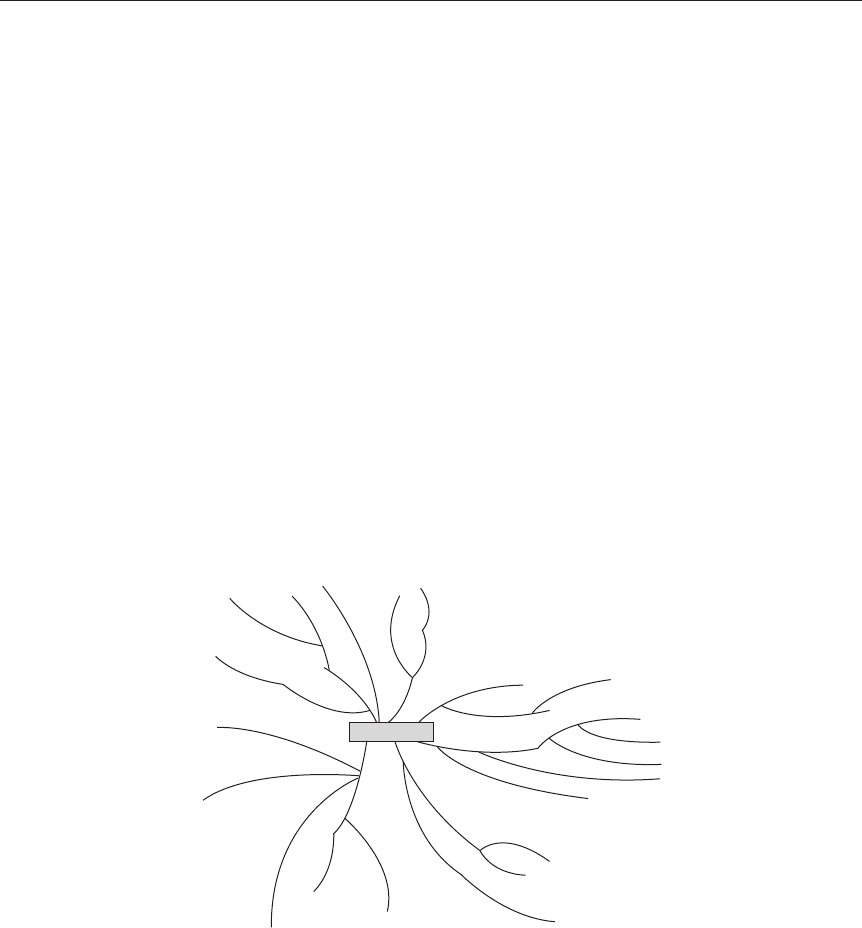
Creativity and Mind-Mapping
131
can go on to become a center for another spray of associations. The associations can be docu-
mented through images, words, varied colours and even varying lines of thickness.
There is another advantage the mind-mapping technique has over the others. If you have
forgoĴ en a point or feel that there is more that can be added, just leave blanks. Your brain’s
natural tendency to ę ll up gaps will eventually supply the missing point. This is otherwise
called the gestalt of the brain.
Some Guiding Principles in Making a Mind-Map
a. Use a central image.
b. Use images wherever possible
c. Use colours to separate one level of mental association from the other
d. Increase the line width to show main points and sub-points.
e. Underline, highlight, encircle or use any other means to highlight.
f. Use arrows or doĴ ed lines when you want to make connections across the branches.
g. Use one key-word per line.
h. Write the key-words on lines.
i. Always ensure that the line length is equal to the word length.
Given in Figure 7.1 the picture of a typical mind-map.
Figure 7.1 Mind-map of ‘creativity’
Note-Taking and Mind-Mapping
Note-taking, as we have seen before, is the process of receiving other people’s ideas from
speeches or books and organizing them into a structure that reĚ ects their thoughts. While
note-taking, it is inevitable that note-takers’ thoughts too become a part of the note. The
points which he/she thinks are important, or the structure that she lends to the material that is
to be transferred become very much a part of the ę nal note that is made.
Creativity
S
o
c
i
a
l
r
e
s
p
o
n
s
i
b
i
l
i
t
y
N
e
e
d
s
P
r
o
g
r
e
s
s
i
v
e
i
d
e
a
s
B
r
e
a
k
i
n
g
r
u
l
e
s
F
r
e
e
d
o
m
T
r
a
d
i
t
i
o
n
a
l
C
o
n
v
e
n
t
i
o
n
s
T
h
i
n
k
i
n
g
a
f
r
e
s
h
C
o
u
r
a
g
e
J
o
b
F
a
m
i
l
y
P
r
a
c
t
i
c
a
l
i
t
y
P
e
r
s
o
n
a
l
d
e
v
e
l
o
p
m
e
n
t
C
u
r
i
o
s
i
t
y
L
e
a
r
n
i
n
g
N
a
t
u
r
e
♥
F
o
r
t
h
e
u
n
k
n
o
w
n
I
n
v
e
s
t
i
g
a
t
i
o
n
E
x
p
l
o
r
a
t
i
o
n
I
n
t
e
l
l
e
c
t
F
e
e
l
i
n
g
s
D
i
s
c
i
p
l
i
n
e
T
o
o
l
s
V
i
s
i
o
n
G
o
a
l
D
i
r
e
c
t
e
d
P
e
r
s
p
e
c
t
i
v
e
A
p
p
l
i
c
a
t
i
o
n

Communication Skills for Engineers
132
The linear paĴ ern generally followed during note-taking does not allow one to make as-
sociations between points and sub-points, and they do not really take help from the associa-
tion-making power of the brain. Also, it does not utilize the brains paĴ ern-making capacity or
its image-retaining ability.
Interestingly, if put in the form of a mind-map, the process of note-taking can be made
creative and it can perform much more eĜ ciently by taking help from the unutilized parts of
the brain. The following steps can be taken to prepare a mind-map of the material you have
for note-taking.
a. Very quickly browse through the entire material to have a general feel of how it is orga-
nized.
b. Mentally, make an overview of the major headings, results and conclusions. Also, think
of the illustrations and graphics you might want to present. This will give a general
idea of the central image, the main branches and sub-branches.
c. Now, it will be easy for you to ę ll out the mind-map. See where you would like to in-
clude the images, diagrams and establish the links. See if you would like to use codes
and show the associated points. Use more than two colours to highlight the main-
points. Use images wherever possible. It will trigger the association-making capacity
in your brain.
d. Review the whole process again. Make sure that all the main points have been includ-
ed. If you have leĞ out any, complete it at a later stage.
Mind-mapping also helps in taking notes from lectures. Lectures are not always very struc-
tured. While lecturing, diě erent points recur in diě erent ways at diě erent points and they
also get associated in multiple ways. The circular structure of the mind map helps greatly in
documenting the main points. One can add points easily by extending a branch and linking it
up with other points. Remember that it is suĜ cient if you can simply put an image or a word
condensing the thought. The gestalt of your brain will automatically provide the details of the
information when you need to ę ll it out.
Mind-Mapping for Essays
An essay is a kind of note-making exercise where you have to ę rst identify the essential topics
of concern and then go on to explore the related elements.
a. Begin your mind-map with a central image or an idea representing the essay.
b. Decide on the basic ordering in terms of divisions and sub-divisions.
c. Allow your mind to move freely, documenting all the ideas that come. Keep in mind
the basic ordering principles and the levels to which the ideas belong. At this stage,
you’ll need to be analytical, decide the hierarchy and arrangement of ideas.
d. Use diě erent colours to show the diě erent hierarchical structures. You could even use
diě erent thickness of lines for diě erent levels. Use codes or symbols if you want certain
points to be linked in the writing. Draw arrows to show the Ě ow. Move back and forth
from one point to the other. Let the whole of your brain have its full play.
e. If you face any problems in making associations or if you have a ‘block’, leave blank

Creativity and Mind-Mapping
133
lines and continue working. Your brain’s natural capacity to form a whole will give you
material and ideas to ę ll the gaps.
f. Review the map for any other information and missing links.
g. Begin the writing of the ę rst draĞ of the essay. A well-ordered mind-map would give
you an ordered structure of the main and sub-points. Study the links, consider the
points and proceed with the main and sub-points.
h. At the end, review the essay while analyzing the mind-map. Give the ę nishing touches,
ensure that you have sign posted the diě erent points well. Check your use of linkers,
and check for general coherence.
i. Reconsider your conclusion, review, modify and expand it, if necessary.
The more I wrote and drew, the more things came to my mind. The more ideas
I got, the more brave and original they were. I have realized that a mind map is
never ending.
—Kartarina, a student, while doing a mind map.
Mind-Mapping for Examinations
Answering the examination paper eě ectively has always remained a problem for students.
Recollecting all the relevant points, puĴ ing them in order and then managing time – all these
remain problems eternally for students to solve. Using mind-mapping during examinations
can solve these problems to a large extent. Follow the steps given below to make eě ective
mind-maps during examinations.
a. Read through the question paper thoroughly, choosing the questions you want to an-
swer. Note down any point that occurs the your mind immediately.
b. Decide the order in which you want to answer them and the amount of time you want
to spend on each of them.
c. Start making your mind-map. Note down all the relevant points that occur to you.
Make the main points and sub-points related to each.
d. Give your brain full freedom to move to and fro, noting down all the points and asso-
ciations that occur to you.
e. Try to organize, re-organize making references and cross-references.
f. Start elaborating your points—a paragraph or two for each of the branches. By now,
you have all your main points as well as the sub-points. You should be able to assess
how much time you will need to elaborate each.
g. Stick to your time limit and organize every answer systematically and well.
It is similarly helpful to prepare mind-maps before ę nally seĴ ling down to write a report or
a project.
The gap between thinking and puĴ ing the words on paper is a process that is always
troublesome and time-consuming. Mind-mapping is one technique that can do this eĜ ciently.
It allows one to sketch out the main ideas and quickly see how they relate to one another. It
separates thinking from writing and when it is time to start writing, the ideas are already
structured with clear focus and direction.

Communication Skills for Engineers
134
Very oĞ en in today’s world, we stand at crossroads, confused over which career to choose,
what decision to take, etc. Using mind-maps at such times can be of immense help. It can give
you a beĴ er insight of yourself, your needs, desires and aims. It can also show you how you
can analyze yourself. A mind-map well done can be a complete reĚ ection of your personality.
So quickly draw a colorful mind-map that captures your personality. It might give you vital
clues about your strengths, weaknesses, your aptitude and dominant traits. The mind map
format can also be very eě ectively used to conduct a brain storming session. Collate ideas and
put them together.
Points to Remember
• Mind-mapping is a graphic technique for representing idea, using words, im-
ages, symbols and color.
• It is based on the paĴ ern found in the natural architecture of the brain.
• It allows one to access multiple intelligences and generates new ideas.
• Since it allows us to quickly scan our mind, it can help formulate clear ideas
about personal and professional goals.
• It can be an eě ective tool for note-making.
• Mind-mapping can also be helpful in writing reports, etc.
MIND-MAPPING: SOME DO’S AND DON’T’S
Do’s
• Begin from the centre. Naturally the brain focuses on the center ę rst, not the leĞ hand
top.
• Break stereotypes: Use butcher paper, colour pencils and pictures, however absurd.
• Think fast: Keep working
• Use symbols and key words. The brain works in bursts of 5–7 minutes. You should be
able to capture the thoughts.
• Make the surroundings pleasant. It generates beĴ er ideas.
• Stand up and work. It energizes you.
Don’t’s
• Don’t try to dismiss any idea, even if it appears irrelevant. Noting it down somewhere
will help the brain relax and proceed.
• Don’t stop very oĞ en to think. If nothing occurs, keep making empty lines. Your brains
gestalt will ę ll it up later.
• Don’t try very hard to organize when you are mapping. Note down all the ideas ę rst;
organization can come later.
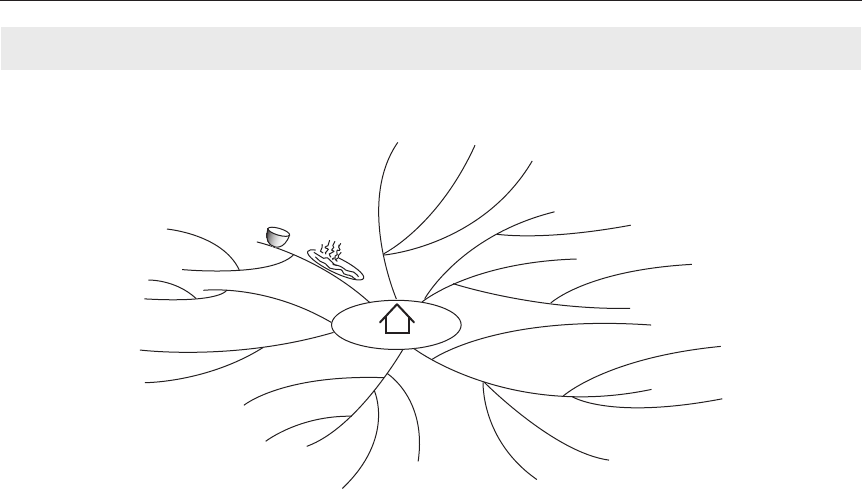
Creativity and Mind-Mapping
135
Figure 7.2 Mind-map of home
8. Add branches if you want to and compare it with what your friends have done. Use at
least three colours, to show the hierarchy of ideas. Also, use codes or symbols to show
associations among the branches.
9. Here is a write-up about craĞ smanship. Prepare a mind-map of it. Use colors, codes,
and symbols to make it striking.
Craftsmanship, then and now.
The advance of the age of machinery has not been all advantageous. In fact against all
that the machine has given us, there is one serious disadvantage – the decline in craĞ s-
manship. In days gone by, a furniture maker would use with care and pride the tools
which, over a period of time, had become almost a part of him, and a chair took shape
before his eyes. It was work not only of his hands but also of his mind, and expressed
something of himself; no other chair, even one made by his own hands, would be simi-
lar. So it was with all craĞ smen; everything they made was their own work, the result
of their skill in the use of their tools, and they could look on it with pardonable pride.
What is the position today? In large factories of the machine age, rows of men are
engaged in producing not a whole article, but merely one part of that article. The in-
dividual workman does not even have the satisfaction of feeling that this part is the
work of his own hands, because it is made by a complicated machine. All he has to do
is to feed the raw material into the machine, press a lever, and put the ę nished part on
a moving belt, which will convey it to the assembly lines. Thus the modern worker is
denied the joy of creation; his work is reduced to a monotonous repetition of automatic
movements that are carried out almost without the use of his conscious mind.
ACTIVITIES
7. Given in Figure 7.2 is a half-completed mind map of the concept home. Complete it.
HOME
J
o
y
S
m
i
l
e
M
u
s
i
c
B
o
o
k
s
C
o
m
f
o
r
t
W
o
r
r
y
S
e
c
u
r
i
t
y
P
e
a
c
e
R
e
s
p
o
n
s
i
b
i
l
i
t
i
e
s
S
i
b
l
i
n
g
s
C
h
i
l
d
P
a
r
e
n
t
s
S
p
o
u
s
e
♥

Communication Skills for Engineers
136
SUMMARY
• Creativity today has been redeę ned as the capacity to grow to one’s fullest potential,
and survive in a highly competitive environment or even eĜ ciently function in one’s
day-to-day activities.
• Fears, anger, guilt, stress, are all impediments to the Ě ow of creativity.
• One can develop one’s intuitive capability by learning to create blank spaces between
thoughts. Original intuitive ideas manifest themselves in these spaces.
• Teams/institutions/organizations with a high-integrity relationship are fertile grounds
where creative ideas can generate and Ě ourish.
• Mind-mapping, a replication of the brain’s working process, is an eě ective tool for note
making, essay writing and project writing.
• Mind-mapping makes use of colours, images and paĴ erns, which utilize not only the
leĞ brain, but also the right brain, thus tapping one’s creative potential.
REVIEW QUESTIONS
1. What is creativity composed of? Give instances of situations when we are creative.
2. Does creativity play an important role in determining our relationships around us?
Explain.
3. Can one develop creativity? Expand.
4. What are the factors that block creativity?
5. The mind-mapping technique closely resembles the brain’s information processing sys-
tem. Explain.
6. Do you think that the traditional ways of teaching and learning do not compliment
the brains natural learning or information-retaining system? Giver reasons for your
answer.
7. What are the functions of the right brain and the leĞ brain? State how the technique of
mind-mapping can use both eě ectively and make diě erent types of academic-writing
beĴ er.

CHAPTER 8
Résumé Writing, Curriculum Vitae (CV)
and Statement of Purpose (SOP)
Chapter Objectives
This chapter discusses the importance of writing effectively the résumé, the CV and the statement of
purpose (SOP). This is discussed in the context of their high career making value in relation to getting
job calls and academic admissions.
DEFINITION OF A RÉSUMÉ
A résumé is a one or two page summary of your education, skills, accomplishments, and
experience. Your résumé’s purpose is to enable you to gain the selector’s aĴ ention. A résumé
does its job successfully if it does not exclude you from their consideration. To prepare a suc-
cessful résumé, you need to know how to review, summarize, and present your experiences
and achievements on one page. Unless you have considerable experience, you don’t need two
pages. Outline your achievements brieĚ y and concisely. Your résumé is your ticket to an inter-
view where you can sell yourself!
Writing a résumé is serious business. OĞ en, it is the ę rst impression you will make on a
prospective employer. Hopefully, aĞ er looking over your résumé, the employer will grant
you the opportunity to make a second impression. If we look at job search as a marketing
campaign, we can then look at the résumé as a print advertisement or a marketing brochure.
If you take a look through a magazine you will see many advertisements. Try to ę nd one that
tells you to buy a product because the company needs to increase its proę ts. You will be hard-
pressed to ę nd such a insensitive one.
The advertisements you see tell you what the manufacturer’s product can do for you –
make your smile bright, your hair shiny, or simply make your life beĴ er. When puĴ ing to-
gether your résumé, evaluate the needs of the employer and then determine how you can ę ll
those needs. If you have access to a computer and a quality printer, you can design a targeted

Communication Skills for Engineers
138
résumé for every job that you apply for. If you have to mass produce your résumé, you will
have to do a liĴ le guesswork to come up with one that will impress everyone. There are three
types of résumés. They are, (a) functional résumé, (b) chronological résumé and (c) combined
résumé.
Functional Résumé
The functional résumé focuses on your skills and accomplishments. It highlights what they
are, not when you developed them. It is best for:
a. People with lots of job experience and many jobs.
b. People just entering the work force with no track record.
c. People who are returning to work aĞ er a long absence.
d. People who are changing careers who want to highlight their skills and credentials.
e. People who are closer to retirement age.
f. People whose career growth has not been good.
g. Military personnel who are seeking civilian jobs.
Its contents include:
a. Contact information
b. Objective
c. Skills
d. Work experience
e. Education
Chronological Résumé
The chronological résumé is the most common. It is a chronological listing of your jobs and
experience with most recent mentioned ę rst. It is best for:
a. People who have practical work experience without long periods of employment and
minimal job changes.
b. People who have demonstrated growth in a single profession.
Its contents include:
a. Contact information
b. Objective
c. Work experience
d. Education
Combined Résumé
A combined résumé includes elements of both the chronological and functional formats. It
may be a shorter chronology of job descriptions preceded by a short ‘Skills and Accomplish-
ments’ section (or with a longer summary including a skills list or a list of ‘qualię cations’); or,

Resume Writing, Curriculum Vitae and Statement of Purpose
139
it may be a standard functional résumé with the accomplishments under headings of diě erent
jobs held.
There are obvious advantages to this combined approach: It maximizes the advantages of
both kinds of résumés, avoiding potential negative eě ects of either type. One disadvantage
is that it tends to be a longer résumé. Another is that it can be repetitious: Accomplishments
and skills may have to be repeated in both the ‘functional’ section and the ‘chronological’ job
descriptions
Power Words
Use power words to describe your experience and accomplishments. Here are some power
words to use:
accelerated, accomplished, achieved, addressed, administered, advised, allocated, answered, appeared,
applied, appointed, appraised, approved, arranged, assessed, assigned, assisted, assumed, assured, au-
dited, awarded, ability
bought, briefed, broadened, brought, budgeted, built
capable, capability, cataloged, caused, changed, chaired, clarię ed, classię ed, closed, collected, combined,
commented, communicated, compared, compiled, completed, computed, conceived, concluded, conduct-
ed, conceptualized, considered, consolidated, constructed, consulted, continued, contracted, controlled,
converted, coordinated, corrected, counseled, counted, created, critiqued, cut, capacity, competence,
competent, complete, completely, consistent, contributions
dealt, decided, deę ned, delegated, delivered, demonstrated, described, designed, determined, developed,
devised, diagnosed, directed, discussed, distributed, documented, doubled, draĞ ed, demonstrated, de-
veloping
earned, edited, eě ected, eliminated, endorsed, enlarged, enlisted, ensured, entered, established, esti-
mated, evaluated, examined, executed, expanded, expedited, experienced, experimented, explained, ex-
plored, expressed, extended, educated, eĜ cient, eě ective, eě ectiveness, enlarging, equipped, excellent,
exceptional, expanding, experienced
ę led, ę lled, ę nanced, focused, forecast, formulated, found, founded
gathered, generated, graded, granted, guided, global
halved, handled, helped
identię ed, implemented, improved, incorporated, increased, indexed, initiated, inĚ uenced, innovated,
inspected, installed, instituted, instructed, insured, interpreted, interviewed, introduced, invented, in-
vested, investigated, involved, issued, increasing
joined
kept, knowledgeable
launched, learned, leased, lectured, led, licensed, listed, logged

Communication Skills for Engineers
140
made, maintained, managed, matched, measured, mediated, met, modię ed, monitored, motivated,
moved, major, mature, maturity,
named, navigated, negotiated, nationwide
observed, opened, operated, ordered, organized, oversaw, outstanding,
participated, perceived, performed, persuaded, planned, prepared, presented, processed, procured, pro-
grammed, prohibited, projected, promoted, proposed, provided, published, purchased, pursued, perfor-
mance, positive, potential, productive, proę cient, proę table, proven,
qualię ed, questioned, ,
raised, ranked, rated, realized, received, recommended, reconciled, recorded, recruited, redesigned, re-
duced, regulated, rehabilitated, related, reorganized, repaired, replaced, replied, reported, represented,
researched, resolved, responded, restored, revamped, reviewed, revise, record, repeatedly, resourceful,
responsible, results
saved, scheduled, selected, served, serviced, set, set, up, shaped, shared, showed, simplię ed, sold, solved,
sorted, sought, sparked, specię ed, spoke, staě ed, started, streamlined, strengthened, stressed, stretched,
structured, studied, submiĴ ed, substituted, succeeded, suggested, summarized, superseded, supervised,
surveyed, systematized, signię cant, signię cantly, sound, specialist, substantial, substantially, success-
ful, stable,
tackled, targeted, taught, terminated, tested, took, toured, traced, tracked, traded, trained, transferred,
transcribed, transformed, translated, transported, traveled, treated, trimmed, tripled, turned, tutored,
thorough, thoroughly,
umpired, uncovered, understood, understudied, unię ed, unraveled, updated, upgraded, used, utilized
verbalized, verię ed, versatile, vigourous, visited
waged, weighed, widened, won, worked, wrote, well educated, well rounded, worldwide
GUIDELINES FOR EFFECTIVE RÉSUMÉ WRITING
• Be clear, direct, eě ective and professional. Make your résumé easy to read.
• Use bulleted statements to facilitate skimming. Avoid long paragraphs and large blocks
of text.
• Try to keep it to one or two pages. If you have less than 10 years of experience, a single-
page résumé is a good rule-of-thumb. The reader should be able to skim your résumé
in 25 – 30 seconds.
• Determine a format and stick with it through the résumé i.e., ensure section headings
have the same placement and font treatment throughout the résumé.
• Put dates next to the right-hand margins.
• Information about your most recent job may use current or past tense depending on
your current status, only use past tense to describe previous accomplishments, since
they are completed actions.

Resume Writing, Curriculum Vitae and Statement of Purpose
141
• Accurately use up-to-date terminology relevant to the industry you have targeted.
• Spell out terms. Avoid abbreviations and acronyms.
• Identifying information should be listed on the ę rstpage in a balanced, organized lay-
out, including:
ȡ Name (should stand out, i.e., bold, all capital leĴ ers etc.)
ȡ Street address
ȡ City / state / zip code
ȡ Home, Mobile and/or Cell Phone (include 10-digit telephone numbers with area
code)
ȡ Work phone
ȡ Email address (include personal not work)
• If your résumé is more than a single page, be sure to place name and page number in
upper right hand corner of the second page.
Points to be Included
a. Name and gender
Given the ę rst and last name only because that’s how you are introduced and introduce
yourself. Sometimes mentioning the gender is useful especially where names are not
revelatory of it in themselves and when you are sure you will not be discriminated be-
cause of your gender.
b. Address
Give complete address. Do not abbreviate.
c. Telephone number with area code.
d. Objective
Keep it short in just one or two sentences. Adjust to ę t the position for which you are
applying. If résumé is going to be circulated a lot, the broader the beĴ er.
e. Education
If you are a recent graduate, place education before work experience, if not, place af-
ter.
f. Skills
List all that are appropriate to the type of work you are seeking. Include computer skills
and languages (understood, read, or spoken) for every job.
g. Dates
Include some type of reference of when you had the job. Be consistent with your nota-
tion
h. Job titles
Adjust to ę t the position for which you are applying. If résumé is going to be circulated
a lot, the broader the beĴ er. If appropriate, use the title of the position for which you are
applying.

Communication Skills for Engineers
142
i. Company name
The company with whom you were employed. City and state are suĜ cient for the ad-
dress.
j. Responsibilities
This is an essential part of the résumé. Highlight the responsibilities of your previous
jobs that are related to the position for which you are applying.
k. Professional licenses
Include if important to line of work
l. Publications and patents
Use if important to your ę eld or profession.
m. Professional aĜ liations
Exclude mention of political, social, religious or any other controvesial group. The em-
phasis is on your professional memberships, not personal.
Points to be generally excluded
a. A résumé title
It should be obvious what it is.
b. Availability
Apparently you are available; you are looking for work. It decreases the life span of
your résumé and your eĜ ciency if you do not get a job by the specię ed date.
c. Salary
If your request is too high, you are eliminated immediately. If it’s too low, they may still
trash your résumé, or worse they may pay you what you asked, which is thousands less
than you are worth.
d. Mention of age, race, religion, or national origin
It is just not good business sense to mention these. Discrimination does happen to ev-
eryone now and then.
e. Photographs
Unnecessary, unless applying for a modeling or acting career. Then, a portfolio is rec-
ommended.
f. Charts and graphs
Nobody’s résumé should have that much void space. You can do beĴ er.
g. Weaknesses
It is counter-productive. The purpose of the résumé is to accentuate the positives.
h. Reason for leaving
It is inappropriate for the résumé. If the employer wants to know, he or she will ask
you.
i. References
Do not list references because it is unprofessional. State instead, “References are avail-
able upon request,” at the very end of your résumé.

Resume Writing, Curriculum Vitae and Statement of Purpose
143
A Sample Résumé
a. Name and Gender:
GYAN PRAKASH (Male)
b. Address:
H.No: 1149, B.Nagar, Secunderabad, AP, India Pin: 500061
c. Telephone:
091 40 2707 0798, Cell: 98482 49777
d. Objective:
A soĞ ware sales position in an organization, seeking an extraordinary record of
generating new accounts, exceeding sales targets and enthusiastic customer rela-
tions.
e. Education:
Bachelor of Engineering (Computer);
Master of Business Administration (MBA-Marketing)
f. Skills
Computer skills (hardware and soĞ ware)
Languages:
Understood: English, Telugu, Oriya, Tamil, Kannada, Urdu, Hindi,
Bengali, French
Read: English, Telugu, and Hindi
Spoken: English, Telugu, and Hindi
Interpersonal skills: Wide network of friends and contacts.
g. Job Titles:
No work experience/ fresh graduate/ seeking job for the ę rst time.
h. Professional AĜ liations
Member of State Management Graduates Association
CURRICULUM VITAE (CV)
A curriculum vitae more commonly referred to as CV, is a longer (two or more pages) and a
more detailed synopsis than a résumé. It comprises a summary of your educational and aca-
demic background, as well as teaching and research experience, publications, presentations,
awards, honors, aĜ liations, and other details. Your CV ought to be clear, concise, complete,
and up-to-date with current employment and educational information. The following is an
appropriate format of globally acceptable curriculum vitae.

Communication Skills for Engineers
144
Curriculum Vitae Format I
Your Contact Information
Name, address, telephone, cell phone, email.
Personal Information
Date of birth, place of birth, citizenship, passport no / visa status, gender
Optional Personal Information
Marital status, spouse’s name, children
Education:
Employment History
List in chronological order, include position details and dates work history, Aca-
demic Positions
Research Skills:
Presentations:
Publications:
Grants and Fellowships:
Awards and Honors
Skills and Qualię cations:
References:
Curriculum Vitae Format 2
Name
Date of Birth:
Citizenship:
Address:
Phone:
Oě :
Phone: Fax:
E-Mail:
Academic Degrees Earned:

Resume Writing, Curriculum Vitae and Statement of Purpose
145
Academic Positions Held:
Research Interests:
Publications:
Teaching Experience:
Conferences AĴ ended:
Future Invitations:
Refereeing and Book Reviewing:
Seminar and Conference Organization:
Prizes and Awards:
Computer Skills:
References:
Sample Curriculum Vitae I
Sunil Kumar
Street, City, State, Zip
Phone: 888-777-2345
Cell: 255-366-466
Personal Information
Date of Birth: 17-08-1968
Place of Birth: Delhi
Citizenship: Indian
Passport no / Visa Status:
Gender: Male
Optional Personal Information
Marital Status: Married
Spouse’s Name: Anita
Children: 2
Education:
Ph.D., Psychology, University of Hyderabad, 2006
Thrust areas: Psychology, Community Psychology
Dissertation: A Study of Learning Disabled Children from Low Income Groups
M.A., Psychology, M.K.G University at Visakhapatnam, 2003
Optionals: Psychology, Special Education

Communication Skills for Engineers
146
Thesis: Speaking Skills of Learning Disabled Children
B.A, Psychology, Delhi State University, New Delhi, 2000
Employment History
Academic Positions: Associate Professor, Psychology
Instructor, 2004 – 2006
University of Hyderabad
Course: General Psychology
Teaching Assistant, 2002 - 2003
M.K.G University
Courses: Special Education, Learning Disabilities
Research Skills:
Extensive knowledge of statistical programs.
Presentations:
Sunil Kumar(2006)., The behaviour of learning disabled adults in the classrooms. Paper
presented at the Psychology Conference at the University of Hyderabad.
Publications:
Sunil Kumar (2005)., The behaviour of learning disabled adults in the classroom.
Journal of Educational Psychology, 12 – 15.
Grants and Fellowships:
Sigmund Grant (University of Hyderabad Research Grant, 2005), Rs.48,000
Workshop Grant (for ASPA meeting in Mumbai, 2004), Rs.5,000
Awards and Honors:
Jung Scholar, 2005
Academic Excellence Award, 2003
Skills and Qualię cations:
MicrosoĞ OĜ ce, Internet
Programming ability in C++ and PHP
Fluent in Hindi, English, and French
References:
Prof. A. K. Mehrotra, Dept. of Psychology, University of Hyderabad, AP, India
Prof. A. M. Rao, Dept. of Philosophy, Delhi State University, New Delhi, India
Your CV is your own logo and also the company proę le of you as a brand!
Are you able to market your functional skills, expertise and achievements? Is your résumé
a mere reĚ ection of your skills? If you are looking for a job, then it is important that you un-
derstand how best to oě er yourself to an employer. This is done by writing a ‘CV’ (curriculum
vitae – Latin for ‘life story’), called ‘Bio Data’ in some countries.
Companies receive hundreds of résumés/CVs for one job opening. However, only few are
short-listed for the interview. This short listing is done on the basis of your résumé/CV. On
an average a Curriculum Vitae will receive no more than 30 seconds of initial consideration.

Resume Writing, Curriculum Vitae and Statement of Purpose
147
In that time, it needs to make an impact. To get someone to look at it longer, it must quickly
convey your capabilities, competence and ‘essence’.
We need to understand the diě erence between the scope of the résumé/ CV of a thorough
professional and that of a new recruit. With years of experience behind you, your résumé
should focus on your strategic capabilities and your business acumen. It should document
how your presence had been valuable in driving the organization up the ladder of corporate
success.
When it comes to salary negotiations, a well-wriĴ en CV plays an important role. If your CV
conveys your full worth you are likely to get a higher salary oě er than you might have done
with a poorer CV. A CV is personal, but it is neither a biography, nor a paragraph, nor even a
novel, in which you tell the story of your professional life!
Sample Curriculum Vitae II
Kalikrishna
228 SMR Layout, Hosur Rd, Bangalore 560012, India
Email: [email protected]
Phone: 91-80-2345-5678
EDUCATION
B.Tech. Computer Science and Engineering, Indian Institute of Technology,
Mumbai (2002 – 2006)
Thesis Title: Eě ective Algorithm for Terrain Simplię cation – Fast Rendering
Advisor: Subhadra Rao
Summary: Improves the state of the art in occlusion plane detection, given ter-
rain data. My implementation showed …. 2 – 3 lines
St. Xavier’s School, Mumbai (Graduated 2000)
Ranked 1st in school in 12th C.B.S.E. Board Examination.
PROJECT WORK (B. Tech)
• Developed an optimizing compiler for mC++, a C++ subset with support for
dynamic object migration over the network between compatible type-spac-
es.
• Designed a user-level distributed ę le system based on NFS with write-
through caching, fault tolerance and consistency guarantees.
WORK EXPERIENCE
• Research Assistant, TIFR, Mumbai (Aug – Dec 200X): implemented a library
of image processing functions for edge detection and de-skewing on scanned
images. Adapted an oě -the-shelf OCR package to operate on scanned mail
images with 95% address recognition accuracy at the city/pin-code level and
90% at the street level.

Communication Skills for Engineers
148
• Project Trainee, Spontaneous Networks, Bangalore: (Jan 2005-present): Joined
a 17-person startup implementing campus-wide video-on-demand system for
corporate training. Implemented the streaming video component with buě -
ering for jiĴ er reduction. Also, bit-rate reduction in the event of congestion to
meet frame-rate guarantees. Extensive performance testing was conducted.
COMPUTER SKILLS
• SoĞ ware: SQL Server, Apache, CVS, Mathematica, Latex. Also, audio/video
formats and codecs. Languages: C/C++, STL,
• Platforms: Linux, FreeBSD, NT 4.0, 2000.
PUBLICATIONS
Occlusion Culling using Hyperplane Projection, Anil Choudhary, and Subhadra
Rao. Graphics Interface ‘01(2004) pp. 323–333.
AWARDS
• Best B.Tech thesis – 2004. Dept. of Computer Science, IIT Mumbai; Medalist
at the International Mathematical Olympiad (IMO), 2003, Seoul, S. Korea.
• Ranked 26th in IIT Joint Entrance Examination – 2001.
REFERENCES
• Prof. Aloknath Kumar, Dept. of Computer Science, IIT Mumbai; Prof. Sub-
hadra Rao, Dept. of Computer Science, IIT Mumbai
• Dr. G. V. K Raju, TIFR, Mumbai
STATEMENT OF PURPOSE (SOP)
It is an essay wriĴ en by a prospective candidate for admissions into any academic pro-
gramme.
How to write an eě ective statement of purpose?
1. Establish your purpose in writing the statement
Usually the purpose is to persuade a particular admissions commiĴ ee that you are an
applicant they should choose. You may want to show that you have the ability and
motivation to succeed in your ę eld, or you may want to show that, on the basis of your
experience, you are the kind of candidate who will do well in the ę eld. Whatever the
purpose, it must be explicit to give coherence to the whole statement.
a. Pay aĴ ention to the purpose throughout the statement so that irrelevant material is
excluded.
b. Keep in mind the audience (commiĴ ee) throughout the statement. Your audience is
made up of faculty members who are experts in their ę eld. They want to know that
you can eě ectively go through the paces of learning, given your purpose.

Resume Writing, Curriculum Vitae and Statement of Purpose
149
2. Establish the content of your statement
Sometimes, there are pre-given questions in the admission document itself. Ensure that
you answer such direct questions completely. Analyze the questions or guidance state-
ments thoroughly and answer all parts to build the statement.
For instance: “What are the strengths and weaknesses in seĴ ing and achieving goals
and working through people?” (Observe closely the small words. This example ques-
tion says through people not with people, if it says with people, answer that way). This
question points at six parts to be answered. They are,
a. Strengths in seĴ ing goals,
b. Strengths in achieving goals,
c. Strengths in working through people,
d. Weaknesses in seĴ ing goals,
e. Weaknesses in achieving goals and
f. weaknesses in working through people.
Usually graduate and professional schools are interested in the following:
a. Your purpose in graduate study. This implies that you must have thought this through
before you try to answer the question.
b. The area of study in which you wish to specialize. This demands that you know the ę eld
well enough to make such decision.
c. Your future use of your graduate study. This would comprise career goals and plans for
your future.
d. Your special preparation and ę tness for study in the ę eld. This is the context to link your
academic background with your extracurricular experience to show how they com-
bine to make you an exceptional candidate.
e. Any problems or inconsistencies in your records or scores such as a bad semester. Be con-
ę dent to explain positively and justify the explanation. Since this is a refusal argu-
ment, it should be followed by a positive statement about your skills and talents.
f. Any special conditions that are not revealed elsewhere in the application such as a sub-
stantial (25 hour a week) work load outside of school. This also should be followed
with an aĜ rmative statement about yourself and your future.
g. You may be asked, “Why do you wish to aĴ end this school?” This demands that you
have obtained prior information about the school and realize its special appeal to
you.
h. Most importantly, the statement of purpose ought to comprise information about
you as a person. They know nothing about you that you don’t tell them. You are the
subject of the statement.
3. Determine your approach and the style of the statement
There is no such thing as “the perfect way to write a statement.” There is only the one
that is best for you and ę ts your circumstances.
1. There are some things the statement should not be:
a. Avoid the “what I did with my life” approach. This would be ę ne for school essays
on “what I did last vacation.” It is not good for a personal statement.

Communication Skills for Engineers
150
b. Equally simple is the approach “I’ve always wanted to be a __________.” This is only
suitable if it also reĚ ects your current career goals.
c. Also avoid a statement that indicates your or your family member’s ill-health.
These are some things the statement should do:
a. It should be objective while being self-revelatory. Write directly and in a straightfor-
ward manner that tells about your experience and what it means to you.
b. It should form conclusions that explain the value and meaning of your experiences
such as: (a) what you learned about yourself; (b) about your ę eld; (c) about your
future goals; and (d) about your career concerns.
c. It should be specię c. Document your conclusions with specię c examples or draw
your conclusions as the result of individual experience..
d. It should be an example of careful, credible writing.
Considerations about Form and Language
1. Keep to the page limit. Reviewers have to read many of these applications; don’t over-
strain them with extra pages.
2. Do not leave any typographical errors and do not use unacceptable and inappropriate
language. You should not want to be taken less seriously due to these.
Words and phrases to be used discretely and with explanation
Signię cant, Invaluable, appealing to me, interesting, exciting, excited, appealing aspect,
challenging, enjoyable, enjoy, I like it, satisfying, satisfaction, I can contribute, it’s im-
portant, rewarding, valuable, fascinating , gratifying, helpful, appreciate, meaningful,
useful, helping people, meant a lot to me, feel good, I like to help, stimulating, remark-
able, people, incredible
Sample SOP I
Graduate School/ Engineering and Computer Science MS 1
I have been interested in problem solving from a very young age, especially
problems relating to mathematics. The computer also has been part of my home
for many years and I feel most comfortable working on it. My undergraduate
studies have included SoĞ ware Engineering, Computer Graphics and Visualiza-
tion, Human Computer Interaction, Design and Analysis of Algorithms, Com-
putational Mathematics, and Formal Logic for use with artię cial intelligence
systems. My own sphere of special interest in the ę eld of computer science com-
prises the dynamic relationship between soĞ ware and intelligence systems.
Now that I have completed my bachelor’s degree, I look forward to a new
challenge of studying in a graduate school. I see graduate school in Computer

Resume Writing, Curriculum Vitae and Statement of Purpose
151
Science as a new level of growth where I can reach an advanced level of pro-
fessional ability that I shall seek to reę ne during the later part of my life. To
end this, I am applying to study towards an M.S. degree in Engineering at the
Department of Computer Science at the University of XXXX because I feel very
strongly that this is the best location for continuing my studies in the area that I
am most interested. I look forward to direct access to the Department of Math-
ematics Statistical Consulting Service and its assistance with experimental de-
sign, data display and analysis, and the interpretation of ę ndings relating to
statistical soĞ ware engineering.
I would like to study in XXXX as your program ranks among the very best.
I strongly believe that I am an ideal candidate for your program because I am
an extremely dedicated worker who never ceases to explore most cuĴ ing-edge
technologies. I have very strong analytical and problem-solving skills and I am
a team player who looks forward to working with development teams in the ad-
vancement of soĞ ware procedures, methods, tests, and systems. Furthermore, I
am keen to participate in advanced testing, planning, and scheduling in order
to assure that soĞ ware products are optimally eĜ cient and fulę ll the purposes
for which they were developed. Towards this, I have labored with algorithms
and have mastered the basics of Formal Logic, always with an eye on artię cial
intelligence.
I especially look forward to working with problems and issues that have
to deal with cognitive sciences, neural networks, and the development of
AI solutions and products that will be useful for soĞ ware of the future.
Moreover, I am interested in computer graphics, visualization and am eĜ -
cient in the implementation of 2D and 3D modeling using OpenGL. I would
like to someday design and develop algorithms and new statistical meth-
ods for soĞ ware engineering that would beĴ er integrate computer graph-
ics into soĞ ware visualization, thus exploiting the advancement of computer
graphic processors that are now able to handle complex algorithms, for visual
development. In this context, I would like to inform you that I was chosen to be
a member of the International XXX Society and that XXXX, Inc had contacted me
regarding a position with their company as an engineering intern. I had com-
pleted various projects including the development of underlying email support
(90%), X, Y, Z etc.
I would like to thank you for having considered my application.
Sample SOP II
Graduate School/Mechanical Engineering MS 1
I am from India who determinedly wants to study the M.S. Degree program in
Mechanical Engineering at your XXXX University. Last year, I completed my
undergraduate degree in XX in India with a special focus in the area of produc-
tion. I am therefore keen on doing graduate work in the area of Manufacturing

Communication Skills for Engineers
152
Engineering, Mechanical Engineering, and Operational Research. I bring in lot
of dedication in my studies and my long-term goals include studying towards
a Ph.D. degree aĞ er completing my M.S. For the future, I am planning to study
Game Theory since I have a fascination for this area.
During my undergraduate studies, I was a member of the Production En-
gineering Student Association, and in this capacity I organized various paper
presentations, computer games, and seminars. This experience was especially
helpful for learning how to work with a team and I think that these experiences
will be helpful to me at the graduate school, especially when it comes to working
with a diverse group of people from all over the world. Furthermore, I have also
other social interests and am very determined to give something back to society.
This is why I am an active member of the National Service Scheme, have partici-
pated in a Blood Donation Camp and also worked on tree plantation work, in
addition to other community services.
I am currently working for XXXX Ltd as a Graduate Engineer Trainee. This
is India’s largest diesel engine manufacturing company. This forthcoming July,
I will have one year experience in diesel manufacturing and I am sure that this
will also be helpful to me in doing well at the graduate school. I worked hard
to develop my leadership and team skills throughout my college days and am
presently working with one of the biggest manufacturing companies in India, I
am learning the art of negotiation, and how to eĜ ciently manage people. I feel
that the greatest contribution that I would be able to make to society in the fu-
ture would be to distinguish myself in the area of Operations Research.
Considering all of this, I earnestly feel that I shall do well at the Graduate
school and I would like to thank you for having considered my application.
SUMMARY
• A résumé is a one or two page summary of your education, skills, accomplishments,
and experience.
• To prepare a successful résumé, you need to know how to review, summarize, and
present your experiences and achievements on one page.
• There are three types of résumés. They are functional résumé, chronological résumé,
and combined résumé
• Use appropriate power words to describe your experience and accomplishments
• A curriculum vitae (CV), is a longer and a more detailed synopsis than a résumé.
• It comprises a summary of your educational and academic background, as well as
teaching and research experience, publications, presentations, awards, honors, aĜ lia-
tions, and other details.
• Your CV ought to be clear, concise, complete, and up-to-date with current employment
and educational information.
• Statement of purpose (SOP) is an essay wriĴ en by a prospective candidate for admis-
sions into any academic programme.
• Usually the purpose of an SOP is to persuade a particular admissions commiĴ ee that
you are an applicant they should choose.

Resume Writing, Curriculum Vitae and Statement of Purpose
153
REVIEW QUESTIONS
1. What is a résumé?
2. What are the features of an eě ective résumé?
3. What are the aspects to be avoided while writing a résumé?
4. What is a CV and what does it consist of?
5. How does a well-wriĴ en CV help in negotiating the salary?
6. Recalling and analyzing experience – write short paragraphs on the following:
a. Pick a memorable accomplishment in your life. What did you do? How did you ac-
complish it?
b. What sort of important activities have you engaged in? With whom? What role did
you play?
c. What work experiences have you had? What was your job? Responsibility? How did
you carry it out?
7. Write two short paragraphs on the following:
a. What career have you chosen? What factors made you take this decision?
b. What evidence shows that this is a correct choice? That is, how can you show that
this choice is realistic? (Personal experience in the ę eld is a good place to begin.)

CHAPTER 9
Team-Talk, Group Discussion
and Interviews
Chapter Objectives
This chapter discusses the importance of talking effectively among members of a team and the dynam-
ics of such a talk including confl ict management. It spells out different team types. It distinguishes and
explains the different roles which members of a team take on at different times. The chapter also deals
extensively with the dynamics of group discussion and interview.
Coming together is a beginning, staying together is progress, and working together is
success.
—Henry Ford
IMPORTANCE OF TALK IN A TEAM
Teamwork, as we all know, has become a very important part of corporate work culture today.
Forming the right kind of team, causing the right chemistry to work and creating the right
working atmosphere form an important part of geĴ ing the right results. It is very important,
thus, to have a proper understanding of a team. One eě ective way of recognizing a well-struck
team is to understand team-talk. Teams work together through conversations, whatever the
channel might be – phone, fax, mail or face-to-face.
Language plays a very important role in teamwork. It reĚ ects and even creates thoughts
and feelings in both the speaker and the listener. It enhances or diminishes relationships,
works towards learning and problem-solving in a team. Talk is also an indicator of how the

Team-Talk, Group Discussion and Interviews
155
team relates itself to the organization. It provides a perspective of the team dynamics – how
the team members think, feel and act with one another. Look at the following statements:
• I am a team player, but I want rewards to be individual.
• I feel my image suě ers by their lack of performance.
• The team leaders here are not experienced in managing conĚ ict.
• I have the primary responsibility for the product, but I’m also dependent on them to
achieve my own objectives.
All these are statements oĞ en heard and expressed during teamwork. They show the inevi-
tability of individual initiative and responsibility along with the necessity of teamwork. They
also reveal a paradox between independence and interdependence, a primary contradiction
that all teams have inbuilt in their structure. Team members necessarily have diě erence in
terms of knowledge, skills and experience. Without these diě erences, in fact, it is diĜ cult to
manage a team task. At the same time, it is also necessary that these diě erential factors are
combined and integrated as one.
The paradox in a team is the contradiction between diě erentiation and integration. Similar
is the case with identity and interdependence. Every member enters the team as a specialist
with a distinct identity. But at the same time, a group can function well only if the members
can eě ectively depend on one another. For group work, individual and independent judge-
ment is as important as group thinking. The third paradox every team operates with is the
paradox of trust. Team members have to trust one another while at the same time, remain vigi-
lant. There has to be the right balance between trust and scrutiny. While trust, in this context,
is very important for the collective functioning of the team, a constant testing and assessment
of others’ opinion is also important.
Many of us are more capable than some of us . . . but none of us is as capable as all of
us!
—Tom Wilson
ACTIVITY
1. Look at the following statements and discuss the kinds of paradox they reveal.
a. You, as an individual, succeed in achieving your goal. However, you are expected to
show a willingness to set aside personal gain for the good of the organization.
b. There is a confusion between her and me. There is a crossover in tasks. She is straight
an R & D person. I’m from the manufacturing division. However, I shall now be do-
ing product development work and she will be doing manufacturing.
c. You need a level of trust in teams. Unless there is that mutual trust, people won’t let
their guard down. And unless they come out, they cannot perform.
d. You have to be able to let go of your own ego. You have to give up your own ideas
in favour of the team consensus. This is tough.
e. The power of a good team is to convert diě erences into diversity that enriches itself
as a whole.

Communication Skills for Engineers
156
f. As an engineering person, I try to meet my deadlines relentlessly, but as a member
of this team, I have to take the other circumstances into consideration.
g. When I feel frustrated, it feels like there are two extremes. The best thing to do is to
be nice to people. But then I would get the axe because the management sees me as
not being able to deliver.
h. I don’t want to tell them they can take more time, because they’ll anyhow take it.
i. In a team, you are never absolved of responsibility. Whose job is it? It should have
been someone else’s, but if you want to achieve your objectives you have to go be-
yond your own job.
j. I want them to own up and add to the plan, but I am not willing to risk a complete
deviation from my own objectives. If they go too far, I have to stop them some-
times.
CONFLICT MANAGEMENT
In teamwork, conĚ ict is both inevitable and desirable. But at the same time, it is true that con-
Ě ict has to be tactfully managed and circumvented. Researchers have identię ed four diě erent
kinds of tactics used to manage conĚ ict. These are avoidance, accommodation, compromise
and collaboration. The linguistic signs of accommodation, avoidance and collaborative tactics
include soliciting all members’ views and preferences, redeę ning compromise and recording
problems, mentioning other problems to breakaway from the conĚ ict situations, etc. ConĚ ict
management is also done through negotiation. Negotiation, in this context, predominantly in-
sists on only two distinct processes among negotiators: Win-lose and win-win. The former fo-
cuses on the competitive aspect while the laĴ er seeks to integrate parties and viewpoints. Lin-
guistically, a win-lose orientation is manifest through explicit expressions of position, words
that refer to debt, concession, winning and losing. A win-win process, however, is shown
through elaboration of ideas, exploration of the other’s ideas and re-evaluation or re-framing
of one’s own interests in the light of others. The following are some of the language paĴ erns
that are used generally in win-lose and win-win situations.
Examples of expressions that show either win-loss or win-win form:
Win-Lose Forms: These expressions show
the positions we take up and competitive
spirit.
We have always said we need our supply
before we consider your demand
We’ll be out-selling everyone soon
Win-Win Forms: These statements show
aĴ empts to balance needs, considering a
number of other strategies, etc.
As long as I can stay within our budget, I
can go ahead with this.
What if we justię ed the trip?
What feedback do we all need to have to en-
sure that this joint proposal passes?
ACTIVITIES
2. Recall any incident where you witnessed conĚ icting interests between two groups. Re-
trieve some of the expressions that express the following categories.

Team-Talk, Group Discussion and Interviews
157
a. Avoiding
b. Accomodating
c. Collaborating
d. Compromising
3. Read the following statements and recognize the processes they reĚ ect.
a. I can understand things only from a “design” point of view.
b. I want to clarify that all these things are central.
c. We can talk and try to come up with some kind of agreement.
d. Today was tremendous… there was good interface on how the issue aě ects all of
us.
e. You have made us think what we’re doing and how. This has saved a lot of frustra-
tion and animosity.
When he took time to help the man up the mountain, lo, he scaled it himself.
—Tibetan Proverb
COMMUNICATION IN TEAMS
The previous discussion concentrated on the diě erent kinds of teams, the nature of interaction
between them and the linguistic identię ers to recognize the team type. Along with decipher-
ing the talk, it is also important to understand the kinds of roles the team members play in a
team. This is important because the role-type determines their talk in more ways than one.
You must have noticed during any team talk that someone in the team initiates the discussion,
some people add information and when the discussion gets serious, someone cracks a joke
to relieve the tension. Some people with their general goodwill hold the team together, while
some become the unappointed norm keepers.
Role-Taking in Teams: Task Roles, Building Roles,
Maintenance and Negative Roles
If we were all determined to play the ę rst violin we should never have an ensemble.
Therefore, respect every musician in his proper place.
—Robert Schumann
It is important to note that the kinds of roles people take up will in turn, determine the kind of
language they use and the kind of aĴ itude they adopt. The roles people take up during a dis-
cussion can be divided into Task Roles, Building Roles, Maintenance and Negative Roles.
They can be summed up as the following:

Communication Skills for Engineers
158
Task Roles
Task roles include the communication functions necessary for a group to accomplish its task.
Roles in which we perform diě erent tasks in the team like the initiator, the information giver,
the collaborator, the orienter and the evaluator are seen as task roles. These tasks can involve
us in problem-solving, decision-making, exchange of information or conĚ ict resolution.
Building and Maintenance Roles
These roles build and sustain the group’s interpersonal relationships, helping everyone to
feel more positive about the group’s task and interact constructively and harmoniously. These
roles include those that keep the team together like the harmonizer who compromises dif-
ferences; tension reliever who induces humour; norm-keeper who ensures that norms are
followed and the solidarity builder, who expresses and creates positive feelings reinforcing
group cohesiveness.
Negative Roles
Intra-team behaviour may also be negative and self-centered in nature. These are the roles
that are not constructive for the groups. They prioritize self-interest over group-interest. They
are:
Blocker : a blocker constantly objects to ideas or suggestions, insisting that nothing will work.
He may also repeatedly bring up the same topic or issue aĞ er the group has considered and
rejected it.
Aggressor : this is the kind who insults and criticizes others and shows jealousy and ill will.
Storyteller : this is the one who tells irrelevant, oĞ en time-consuming stories and enjoys dis-
cussing personal experiences.
Recognition seeker : this is the kind that interjects comments that calls aĴ ention to his achieve-
ments and successes.
Dominator : this is the one who tries to monopolize group interaction.
Non-contributor : a non-contributor is reticent, uncommunicative and fails to respond to other’s
comments. He refuses to cope with conĚ ict or take a stand on an issue.
Confessor : he is the kind who aĴ empts to use the group as a therapeutic session and asks the
group to listen to personal problems.
Special-interest pleader : he represents the interests of diě erent groups and pleads on their be-
half.
ACTIVITIES
4. Imagine that you will have to make a team of all your acquaintances and friends for
conducting a workshop. List down the names and depending on their predominant
behavioural paĴ ern, allot appropriate roles to each of them, thus ensuring optimum
eĜ ciency.

Team-Talk, Group Discussion and Interviews
159
5. The following are some of the expressions that were used during an animated discus-
sion. Identify them with the roles you think their speakers were enacting at that point.
a. This is sheer non-sense. We cannot allow this.
b. I think all of us have been speaking about… .
c. I have a wonderful idea; why don’t we… .
d. I completely agree with you. .
e. See, when I was the leader last time… .
f. Let’s not ę ght over it any longer. .
g. How about giving the third party a chance? .
h. I’m sure all of us will agree to this. .
GROUP DISCUSSIONS (GD)
Very oĞ en, conversations are beĴ er among three than between two, for the reason that
then one of the trio is always, unconsciously, acting as umpire, interposing fairplay, see-
ing that the aggressiveness of one does no foul to the reticence of the other.
—Christopher Morley
A group discussion is an exchange of information, opinions, views, perspectives and ideas
about a topic among members of a group. There is no particular number of participants that
has to constitute the discussion group. But generally it has been found that in a group of ten
or more some tend to avoid participation. But a group of ę ve or less suě ers from a lack of
diversity of opinion and knowledge. Between ę ve and nine can be therefore considered to be
an appropriate number. As the discussion proceeds, one of the participants may emerge as a
leader.
The expectation is that there will be smooth Ě ow of information and interaction, and ę -
nally they can arrive at an agreed solution or strategy of action. A GD is an exercise and test of
both your speaking and listening skills, in addition to being an experience of group dynamics
in a face-to-face situation.
An eě ective GD is one where there is an equitable distribution of participation by all instead
of being focused on individuals. Some participants may be very shy and inhibited, others may
be very aggressive and dominating and a few others may be downright unruly, abrasive and
disruptive. The success of a GD is ensured only if the members maintain certain decorum,
discipline, harmony and balance.
GDs have become important in job selections as well as for admissions to professional
courses. During the discussion, the candidates are generally judged for intellectual ability,
creativity, and approach to problems, qualities of leadership, tolerance and group behaviour.
In real life, group discussions contribute much to problem-solving.
To make a group discussion successful, it is important to pay aĴ ention to the following
points:

Communication Skills for Engineers
160
• Content
To make an impact in a group discussion, it is important to have a good knowledge of
the topic given. It is important thus that you have fairly good general knowledge and
awareness of the current situation. This will prevent the ideas from drying up fast and
keeps the discussion alive and lively. If you are entirely unfamiliar with the topic given,
wait for someone else to come up with important information and facts. Then quickly
formulate your stance and come in with your perspective.
• Communication
Along with the knowledge of content it is very important to know how you can com-
municate them eě ectively. It always helps to have a good grasp of vocabulary and Ě u-
ency in speech. Using the right word at the right time gives clarity to the discussion and
also highlights your role in generating ideas in the group. Remember not to exhaust
your ideas at one go. Every time you contribute, make your talk brief and relevant. It
is beĴ er to break into the discussion more number of times with a new idea each time
rather than exhausting all your points the ę rst time itself.
• Thinking
Thinking is one of the important activities that have to go on during a group discus-
sion. During a discussion you have to listen and understand the arguments of the other
participants and at the same time decide what points you should raise and how. A good
discussion always involves a lot of networking. And networking involves active think-
ing, building on one another’s points, negotiating, persuading and collating views.
• Group behaviour
Group behaviour is one of the qualities that is put to test during a group discussion. In
fact group discussions are conducted to test initiative-taking abilities, leadership quali-
ties and capacity to coordinate diverse viewpoints. Although expressing your views
emphatically will be appreciated in a G.D, it is equally important that you draw the
more reticent participants into the discussion and involve them in the decision-making
process.
If everyone listens to each other’s ideas, the truth will gradually and calmly emerge.
—Jean Vanier
STRUCTURING THE GD
Here are a few language tips that will help in structuring the group discussion:
Entering a discussion
Make comments on previous contributions and show your relation to them. You may have to
change the trend of discussion by agreement, disagreement, amplię cation or by restricting the
scope of the discussion.

Team-Talk, Group Discussion and Interviews
161
Opening
We ‘re here today to discuss….
Let’s decide how to proceed about the discussion.
Let’s start oě with no.1.
Can you please give your views on…?
Comments
What I think is…
I feel that…
The main point I wish to make is…
I agree up to a certain point but….
I must disagree with your opinion…
I would question that whether…
It seems to me that…
As far as I’m concerned…
I don’t agree with the previous speaker…
Please, let me ę nish.
I think we are moving away from the main point.
If I may turn, now, to…
I want to comment brieĚ y on…
I intend to make … points about…
Now, to elaborate on the ę rst point…
I strongly believe that…
With all due respect…
If we look at it in another light…
On the contrary…
I don’t think any one could disagree with…
I can’t help thinking…
People change and forget to tell each other.
—Lillian Hellman
Successful Group Discusion
A good and successful group discussion is one where the topic has been discussed threadbare.
To ensure that, do the following:
• Analyze the topic word by word. Identify the frame of reference you would be using
during the discussion.
• Look at the topic from the point of view of all the aě ected parties.
• Look at the topic from all the various angles and all possible perspectives.
• At the end of a discussion or when you know that the discussion time is up, it is neces-
sary to give an appropriate conclusion. To do this, quickly try to recap the important
points that have come up during the discussion, emphasize the points on which there
were diě erences and where there was convergence of opinion and make the concluding
remark.

Communication Skills for Engineers
162
Points to Remember
• Prepare well by reading and reĚ ecting on the topic.
• Anticipate the points of others.
• Alertly listen and understand the points made by others.
• Break in and make your point without waiting to be called upon to do so, ensuring
relevance to the context.
• Be loud enough to be heard by everyone.
• Make brief remarks oĞ en rather than giving long speeches and come in frequently
into the discussion.
• Be open-minded and conciliatory rather than dogmatic.
• Avoid personal aĴ acks and name-calling. Accept criticism with dignity and rebut it
with solid points.
• Back your arguments with evidence and authority.
• Maintain eye contact with group members.
ACTIVITY
8. Given below are some topics for group discussion. See how many points you can build
into each of them.
a. All the world is a stage.
b. Black is beautiful.
c. Deforestation is harmful.
d. Working mothers are more equipped to bring up children today.
e. Marriages are made in heaven.
f. The ceiling is high
g. Beauty lies in the beholder’s eyes
h. The sky is blue
Try to bring around six people together and discuss these topics for around twenty minutes
each.
INTERVIEWS
Viewpoint
The mention of interview creates nervousness in many people. There are not many who are
undisturbed by the idea of facing an interview. In fact, in our day-to-day lives, we go through
interview-like situations very regularly without being conscious of them. For instance, when
siĴ ing in a railway waiting room for your train to arrive, you may possibly start a conversation
with the person in the adjacent chair. You may talk about your names, destinations, occupa-
tions, etc. When you visit your doctor, you are once again in an interview mode. The doctor
asks for the details of your problems in order to diagnose and treat you. Many such situations

Team-Talk, Group Discussion and Interviews
163
happen all the while and we deal with them easily, quite free of tension. However, while fac-
ing a formal interview for admission or recruitment we are very conscious of the situation.
Such interviews require a great deal of mental preparation.
Interview is a head-to-head interpersonal role situation in which the interviewer asks the
interviewee specię c questions with the purpose of assessing the interviewee’s suitability for
admission, recruitment, or promotion, or for an opinion. Hence an interview is a psycho-so-
cial instrument. It is an organized method of contact with a person to know his or her views.
It is regarded as one of the important methods of data collection.
Interview is a systematic method by which one person enters more or less imaginatively
into the inner life of another who is generally comparatively stronger than him.
—P.V. Young
Major Purposes of an Interview
1. Collecting information Face-to-Face
An interview is a direct technique of accumulating data by the interviewer. Its advan-
tage is that lots of information needed in social and scientię c research or assessment can
be compiled from the respondents, only on the basis of direct questioning.
2. Hypothesis Formation
An interview is an investigative device to help identify variables and relations to sug-
gest a hypothesis and to guide diě erent phases of the research. This is relevant only to
interviews for research.
3. Value-Based Qualitative Facts
Social facts are essentially qualitative in nature. They are expressed in the form of ideas,
feelings, views, faith, and beliefs. These social facts are both individual as well as collec-
tive. The interview method is an eě ective way to collect qualitative facts.
4. Additional Information
By this method, we can accumulate from respondents, additional information that we
oĞ en get through normal schedule or questionnaire. There are persons who are capable
of providing additional information or suggestions and this can be done well through
the interview method. This is possible as there is a direct dialogue with the respon-
dents.
Significance of the Interview Method
1. GeĴ ing Information about Feelings: No other method of social research provides bet-
ter information about a person’s feelings, emotions and sentiments than an interview.

Communication Skills for Engineers
164
2. Securing information from persons of varying levels: The questionnaire method is
useful only for the literate. Sometimes, questionnaires cannot elicit the required re-
sponse from persons of diě erent levels of intelligence. This disadvantage is surmount-
ed by the interview method.
3. Psychological study: It is a psychological and scientię c technique of observation which
helps the interviewer to understand the person he is interviewing.
4. Mutual motivation: As a result of two or more persons coming in contact during an
interview they motivate and enliven one another mentally. This helps the respondent
to give the answers that are required of him. By observing the respondents closely, an
interviewer can ascertain some aspects of the candidate’s behaviour.
5. Ver ię cation: Information obtained through questionnaires and observation cannot be
verię ed easily. However in an interview, it is possible to verify the information that has
been gathered from sources like the CV or the application form.
TECHNIQUES OF INTERVIEWING
There are diě erent types of interview techniques that are designed. Companies, government
organizations, autonomous bodies, and private organizations shortlist candidates in a variety
of ways. The diě erent interview techniques are:
Series Interview
A company or a government organization selects its candidates through a series of interviews
where the candidate has to face several people, individually, in succession rather than facing
them all in a group. Each interviewer submits his/her report and the reports are compared to
arrive at the ę nal decision. The series interview is useful if there are a number of candidates
to be interviewed for a job. It would be diĜ cult for a panel of experts or senior managers to
interview all of them in a limited time.
Filter Interview
In this, the applicants who do not have the minimum required qualię cations are ę ltered out. If
there are a large number of candidates who qualify, the minimum criteria are revised in order
to recommend not more than a ę xed number of candidates for further selection procedures.
The ę lter interview may be done face-to-face, by phone, or some other method.
Set Interview
In such an interview, the interviewers ask all the candidates the same set of questions. It is a
structured form of interview in which computers may be used to store, retrieve, and compare
the data provided by the candidates. In a set interview, candidates do not talk to one another
and do not disclose the questions.

Team-Talk, Group Discussion and Interviews
165
Simulation Interview
The aĴ empt in this is to simulate the conditions under which the job needs to be done. A situ-
ation is imaginarily created and the candidate is asked to demonstrate his/her skills and traits
in dealing with the situation. The interviewer poses ‘if’ and ‘when’ questions to assess the
candidate’s reactions. Such interviews consist of just two or three situational questions. The
answers need to be given carefully. It is beĴ er to express lack of knowledge about a situation
than to pretend knowledge.
Spot-Calibre Interview
This kind of interview tests a candidate’s meĴ le to ę nd out how he would respond to diĜ cult
situations. In this, the chairperson aĞ er the initial formalities, indicates to a panelist to begin
the interview. The candidate is subjected to stress by one or more of the following methods.
• being asked many questions at a time;
• being asked further questions without being given adequate time to respond;
• being interrogative in a dominating tone and voice, and
• being asked an irrelevant set of questions;
• being asked a provocative set of questions;
In this, it is beĴ er to stay calm and ask for time to answer the questions. The tone must be
guarded and there must be no retort or retaliation or angry responses.
Panel/Board/Committee Interview
This is the most common type. An interview commiĴ ee is set up with members from ad-
ministration, ę nance, management and subject-specię c experts. The chairperson of the panel
conducts the interview with the help of the members and experts.
PREPARING FOR AN INTERVIEW
The following points must be borne in mind when presenting oneself for an interview.
Time Management
You must ensure that you are punctual. You must report for the interview at least half-an-hour
before the given time. Punctuality creates a good impression and if you are on time you will
be cool, calm and collected. If you ę nd that you are going to be late for the interview, try to in-
form the concerned oĜ ce so that the interview can be rescheduled. Be polite to everyone you
meet both before and aĞ er the interview as this will also help you retain your balance.

Communication Skills for Engineers
166
Appearance
First impressions are immediately formed by our appearance. A smart and pleasant appear-
ance enables you to gain a favourable impression from the board. It is essential to be well-
dressed
and well-groomed. The clothes you wear must look neither too casual nor uncomfort-
ably formal. They must have a washed and ironed look. Footwear should feel comfortable and
be polished.
Body Language
A candidate’s body language tells us a lot about personality type. Stooping shoulders and
bent forward back are signals that signify subservience and a lack of conę dence. You should
walk into the room and sit down with a straight back posture. Ask permission to sit by saying,
“May I sit down?” Shake hands with a ę rm grip while maintaining eye contact and a smile.
Your handshake is a basic act of friendliness. Therefore, a domineering handshake will irritate
the interviewers who will subconsciously feel intimidated. Also, if your handshake is Ě oppy,
you could be considered a weakling.
A pleasing appearance with a liĴ le smile enhances your personality. A smile is like an an-
tibiotic to the many of man’s problems. A frowning, tired, or harsh expression can irritate the
interviewer. You must therefore try to look cheerful and conę dent.
A good interviewee listens keenly, is alert and is able to draw the interviewer’s aĴ ention as
well. AĴ entiveness means being in tune with the other person’s needs, wants and questions.
It is being sensitive and treating each and every person in a special, distinctive way that rec-
ognizes his/her individuality. Good listening skills are vital if one wants an interaction to be
eě ective because most people, in general, love to talk to those who listen to them keenly.
Points to Remember
• Do not sit in your chair in a very stiě or in an overly relaxed way.
• Do not get too near to the interviewer.
• Do not keep hands in your pocket.
• Do not cross arms.
• Do not get your hands or ę ngers over your mouth when you speak.
• Do not avoid a reasonable eye contact with the interviewer.
Communication Skill
Once you start speaking, it improves upon or negates the ę rst impression made
by your appearance and body language. Hence, eě ective speaking includes both
content and
delivery. Delivery refers to your tone, voice, choice of words and phrases. A
candidate can make a beĴ er impression if the pitch of the voice is modulated, well based on
syllable stress and context.

Team-Talk, Group Discussion and Interviews
167
Enthusiasm
A candidate is given more quality aĴ ention from the board if he/she expresses more enthusi-
asm during the interview. Enthusiasm is reĚ ected in the energetic way you express your ideas.
You should never be laid-back or playful, but maintain all along a cheerful disposition and a
pleasant appearance.
Brevity
Eě ective communication does not mean speaking in a garrulous and Ě owery language. Au-
thentic communication means speaking brieĚ y with clarity and in an unambiguous way. A
talkative person is oĞ en taken lightly.
Listen Carefully
Very oĞ en people do not exercise patience to listen to others as they are anxious to speak or
express themselves. Listening is the mother of all communication as it pleases the speaker as
well as orients you positively. You can more so understand the question properly and give ap-
propriate response. Try not to speak before the question is completed.
Be Honest
You should never aĴ empt to deceive the interviewers by telling lies. If you do not know the
answer, it is correct to acknowledge it. You gain respect for your integrity and honesty. You
can tactfully steer the interview to areas that are familiar to you.
Adapt Yourself
It is always useful to keep the interest of the interviewer intact. An element of enterprise is
always helpful in facing an interview. You must have an idea about the interests of the inter-
viewer and talk about it. If the interest of the interviewer seems to decrease, you can trigger
his interest by making appropriate change in your tone, by lowering or raising your voice, or
by speaking faster or slower.
Maintain Proportion and Poise
You should answer informatively but not consume much time. The interviewer may ask gen-
eral question such as, “I would like to talk a liĴ le about your home background”. Do not give
monosyllabic answers or ramble. Yet, do not talk so much that you may weaken your candi-
dature.

Communication Skills for Engineers
168
Demonstrate Leadership Qualities
You ought to exhibit initiative, willingness, and resourcefulness. You ought to demonstrate
team spirit, cooperation, organizational skill, strength of character, and more importantly, a
strong decision-making ability. DiĜ dence, selę shness, and a withdrawn nature will be coun-
terproductive.
Points to Remember
• Walk in smartly and cheerfully.
• Shake hands ę rmly without crushing.
• Maintain a reasonable amount of eye contact with the members.
• Give him your full aĴ entive listening and observation.
• Modulate your voice such that your reply is audible to every member of the interview
board.
• Neither raise your voice rudely nor speak in a low tone.
• Do not be in a hurry to answer. Speak distinctly in normal accent and pause to make
points eě ectively.
• Do not move your limbs aimlessly. Restrain their movements to the minimum.
KINDS OF QUESTIONS EXPECTED AT INTERVIEWS
Alec Rodger came out with a discussion on interviews and said that interview questions fall
under seven headings. These are (1) physique, (2) aĴ ainments, (3) general intelligence, (4)
aptitudes, (5) interests, (6) disposition, and (7) circumstances.
Physique consists of health, appearance, manners and other related aspects of personality.
AĴ ainments include educational achievements and experience. General intelligence is seen
as a broad area of common sense. Aptitudes comprise mechanical, verbal, musical, or artistic
skills. Interests comprise outlook and hobbies. Disposition includes personality and related
aspects like acceptability, whether you are self-motivated, whether you are dominant or sub-
missive, extrovert or introvert, etc. Circumstances give a pointer to the interviewer to put your
achievements in a perspective.
Nonetheless, the expected questions fall within four groups:
Leading Questions
These generally have a response built into them. Normally, the chairperson begins the inter-
view with these leading questions. An interviewer is usually friendly and cooperative; he
would like the candidate to feel at ease. Such questions help a candidate feel comfortable and
conę dent to do well.

Team-Talk, Group Discussion and Interviews
169
Open-Ended Questions
These questions usually come aĞ er the leading questions. The purpose of these questions is
to help a candidate to talk, explain, and illustrate something that he/she knows or has done
before.
Probing Questions
These questions measure your depth of understanding. These questions are intended to test
how you would react to a situation or how you would organize follow-up questions.
Close-Ended Questions
These questions try to elicit information on specię c items and to test your knowledge of facts
and ę gures.
THE INTERVIEW PROCESS
Step 1: Initiation of the Interview
The interviewer’s task is not to bamboozle the candidate but to get the best out of him. Nor-
mally, therefore, the interview begins with encouraging, lively questions. There are many
methods of initiating an interview; some of them are discussed below.
Initiation based on candidate’s background : In many cases the chairperson tries to begin the in-
terview with questions relating to the educational or the family background of the candidate.
He may enquire about the place the candidate belongs to, its important places, features or per-
sons. The purpose is to break the ice, make the candidate feel at ease and to make the process
of interview interesting for the candidate.
Initiation based on the candidate’s interests and hobbies : The chairperson could put a question
relating to the candidate’s ę eld of interest. Candidates must be honest in mentioning their
hobbies and interests. Wrong information could lead to a question, the answer to which may
not be known to the candidate.
Initiation based on general knowledge : Sometimes the member may initiate the interview with
questions that test the general awareness of the candidate. This is a tough beginning. Ques-
tions may be asked on subjects from the evolution theory to the www, from nuclear prolif-
eration to the current visit of the PM, from global climate to the problem of living styles etc.
Thus, candidates must work hard and possess wide knowledge on a variety of subjects. They
should read newspapers and magazines regularly, listen to news, and discuss current aě airs
with friends and relatives regularly.

Communication Skills for Engineers
170
Initiation based on academic topics : This method is actually convenient for the candidates be-
cause the questions asked are relating to subjects of specię c interest to the candidate. He/she
should, therefore, be thorough with the basics, fundamental concepts, and the latest informa-
tion regarding the discipline concerned. He/she must develop the conę dence to explain or
clarify any related question.
Initiation based on tricky questions : Sometimes, the interview can begin with perplexing ques-
tions. Such questions are meant to measure the ability of the candidate in an awkward situa-
tion. Candidates ought to remain calm under such circumstances.
Step II: Investigating the Tenor of Behaviour
Since an interview is an appraisal of the total personality of the candidate, it is essential that
the interviewer investigates the implications of the behavioural tenor of the candidate right
from beginning to the end of the interview. The dialogues between the interview members
and the candidate also reveal many aspects of the candidate’s personality.
Step III: Assessing the Candidate’s Knowledge and Understanding
The board evaluates the candidate’s general knowledge, study of specię c subjects, under-
standing relating to current aě airs, interest in and critical awareness of all things happening
around. The candidate’s ability to apply this knowledge in a given situation or for a social
problem is also tested. His ability to organize ideas and information into a coherent concept
or approach is also tested. Candidates must make a rigorous study of their subjects and have
an up-to-date knowledge of current aě airs. For this, they should read editorials and impor-
tant articles from magazines and newspapers, and go through the analyses ov various topics,
either in newspapers or on television.
Step IV: Assessment of Interpersonal and Social Qualities
Generally, the questions asked at diě erent stages of an interview themselves reveal the social
personality of the candidate like sense of responsibility, co-operation , adaptability, integrity,
group work and persuasiveness. However, the interview board may also ask specię c ques-
tions which will reveal the above qualities of the candidate.
Step V: All-in-All Assessment
In this last stage of the interview, the board generates a ę nal impression of the candidate.
Therefore, some questions may get repeated to judge whether the candidate is consistent and
ę rm in his aĴ itude.

Team-Talk, Group Discussion and Interviews
171
Norms for Assessment of a Candidate
An interview is basically an assessment of the overall personality of a candidate. Personal-
ity does not just mean mere outward appearance or intelligence or the ability to get going
in a situation; it is a blend of various qualities of mind, body, and spirit. Personality can be
categorized under four heads: 1. disposition, 2. knowledge, 3. communication skill, and 4.
leadership traits. These four heads can be further classię ed as given below:
1. Disposition
a. Appearance
b. Social manners
c. Dynamism
d. Mental power
e. Overall impression
2. Knowledge
a. Range of knowledge
b. Depth of knowledge
c. Application of knowledge to real situation
d. Coherence of thought
e. Overall impression
3. Communication skill
a. Language
b. Voice, tone, rhythm
c. Clarity and logic
d. Convincing power
e. Overall impression
4. Leadership traits
a. Initiative
b. Organizational skill
c. Deciding power
d. Character
e. Overall impression
(DFKEDVLFKHDGFDQEHDOORWWHGPDUNV1HJDWLYHPDUNLQJFDQDOVREHGRQH
SUMMARY
• Teams work together largely through conversations.
• All teams have in-built in their structure, both independence and interdependence.
• Team members have to trust one another, while remaining vigilant at the same time.
• Acknowledgement of mutual interest, proposals for joint action and soliciting others’
views and preferences for taking independent decisions are indicative of the interde-
pendence or independence of the team members.

Communication Skills for Engineers
172
• Certain language forms like calling one another by their nicknames, using informal
paĴ ern of speech, sharing views and showing concern for one another’s interests and
wants, express closeness among team members.
• Task accomplishing, building a group’s interpersonal relationships and maintaining
balance in a team are some of the positive roles of individuals in a team.
• A blocker, an aggressor, a storyteller, a recognition seeker, a dominator, a non-con-
tributor, a confessor and a special-interest pleader play negative and self-centered roles
within teams.
• A group discussion is an exchange of information, opinions, views, perspectives and
ideas about a topic among members of a group and is a test of both speaking, listening
skills and group dynamics.
• It is important to network one’s ideas, build up the argument and give the discussion a
deę nite direction.
• The appropriate number of participants for a GD is between ę ve and nine and is ef-
fective when there is an equitable distribution of participation by all instead of being
focused on individuals.
• The success of a GD is ensured only if the members maintain a certain decorum, disci-
pline, harmony and balance. Good listening forms an important part of group discus-
sion.
• GDs have become very important in job selections as well as for admissions to profes-
sional courses.
• To make a group discussion successful, it is important to pay aĴ ention to the content,
communication, thinking, group behaviour and ensure that the topic has been dis-
cussed threadbare.
• Interview is an interpersonal role situation with the purpose of assessing the interview-
ee’s suitability for admission, recruitment, or promotion, or for an opinion
• Interview is a psycho-social instrument.
• Preparation for an interview involves improving aspects relating to one’s time manage-
ment, appearance, body language, communication skills, enthusiasm, brevity, listening
ability, honesty, adapting power, tendency to maintain proportion and poise and dem-
onstrating leadership qualities.
• Interview questions fall under seven headings—physique, aĴ ainments, general intel-
ligence, aptitudes, interests, disposition, and circumstances.
Interview questions may also be classię ed under four groups — leading questions,open-
ended questions, probing questions and close-ended questions.
REVIEW QUESTIONS
1. State the inherent and inbuilt contradictions that are present in every team. Explain
each of them with examples.
2. What are the diě erent parameters we can use to judge a team? Give a short account of
each.

Team-Talk, Group Discussion and Interviews
173
3. Give a detailed account of power diě erentiation. Show the variables that signify power
and explain with illustrations the speech types that co-relate with each of them.
4. What are the diě erent ways in which teams manage conĚ ict? Give illustrations to ex-
plain each method and show the language forms that go with them.
5. How do interdependence and independence of team members get conveyed?
6. How does closeness among team members manifest itself?
7. What are the diě erent team types?
8. Discuss the term ‘collaborative team’.
9. What are some of the positive roles of individuals in a team?
10. Who are the typical negative role players in a team? Discuss.
11. What is a group discussion and what is its ideal number of participants?
12. What is the importance of turn taking during a group discussion?
13. What is an interview?
14. How should a candidate prepare for an interview?
15. What are the diě erent interview techniques?
16. How many types of interview question have been identię ed in the chapter?

CHAPTER 10
Telephone Skills,
Meetings and Minutes
Chapter Objectives
This chapter discusses the important aspects relating to telephoning, conducting of meetings and min-
utes writing. It focuses on the do’s and the dont’s of these processes. The purpose of the chatper is to
familiarise students with these concepts and enable them to use it when necessary.
TELEPHONIC COMMUNICATION
Telephones are a common means of oral communication. It is not always possible to have
face-to-face contact with the personnel within and outside one’s organization. But it is easy
to contact one another on the telephone. Planning telephone calls is a simple, yet important
activity, which does not take much time. Planning calls saves speaking time and money. We
can always prepare an item list and have the relevant papers at hand, before making a call.
Some points with regard to telephoning
1. Positive (Do’s)
• Calls are to be answered promptly.
• Pen and message pad have to be kept at hand.
• Statements and replies are to be given with the appropriate information. E.g. Extension
227, Ravindran speaking.
• Responses are to be spoken into the mouthpiece pleasantly and distinctly.
• Voices of people we know are to be recognized and their names used or the caller’s
name has to be obtained politely.

Telephone Skills, Meetings and Minutes
175
• People who may have to be put on hold on the phone while waiting for information
have to be assured periodically that their concern would be addressed at the earliest.
• Callers have to be given the chance to ring back instead of being placed on hold for a
prolonged period..
• Messages have to be taken and wriĴ en out correctly so that the recipient will be able to
read them easily. The messages have to be kept at a place where they will be seen.
• When callers become annoyed or impatient, the receiver should exercise self-control.
• Knowing enough about one’s organization helps the employee to re-route calls that
come to him by error.
• Instructions are to be leĞ , when an employee is expecting a call during his absence.
• During a call, distractions are to be avoided.
• Cultivate a lively telephone voice. Find out how you sound from your friends or rela-
tives.
• A lot of care has to be taken while speaking to foreigners.
• Be very clear and distinct while giving names and numbers.
• If the person the caller wants is not available, oě er a return call.
• Before calling anybody, ask yourself if it is the right time to call and why you want to
call.
• Before making a call, jot down the points to be made and keep all the necessary docu-
ments at hand.
• Have a clear idea of the message for the person you are calling.
• When someone answers your call, greet him or her and identify yourself.
• Apologize, in case you get through to a wrong number.
• When you get through to the right person, check if it’s the right time to talk to him or
her.
• Re-dial if the line gets disconnected. When the call is complete, thank the person you
have spoken to.
• AĞ er making a call, jot down the key points of the conversation for future use and also
to avoid forgeĴ ing them.
2. Negative (Don’ts)
• The instrument should not be misused.
• Slang expressions should be avoided.
• A conversation should not be carried on with someone else in the room while aĴ ending
a call.
• A person who is wanted on the telephone should not be called across the room unless,
the mouthpiece is covered.
• Do not ramble during a call. Be considerate to the other person, as he or she may be in
a hurry.
• Before answering a call, don’t let the phone ring more than two or three times.
• Do not allow the phone to interrupt a meeting or anything equally important.

Communication Skills for Engineers
176
On the phone: A few patterns
1. Ram: Dials/connects/
(Phone rings)
Operator: Hello, NTPC.
Ram: Hello / Good Morning / Good AĞ ernoon /
I am Ram here. May I speak to Zaheer?
Could you put me on to Zaheer?
Could I speak to Zaheer?
Operator: Yes sir, please be on the line.
2. Ram: Hello, Ram here. May I speak to John, please?
John: Speaking.
Ram: Good Morning, Mr. John.
3. Ram: Hello, This is Ram speaking. Could I speak to John please?
Operator: Just a moment please. I’ll put you through.
John: Hello, John here.
4. Kumar: Hello! Could I speak to Ram please?
Operator: Sorry, there is no Ram here. May be it’s a wrong number.
Kumar: Oh, I’m sorry.
Operator: It’s all right.
MEETINGS
Some people must learn that a meeting of minds and a bumping of heads are
quite diě erent things.
—Dell Pencil Puzzle and Word Games
A meeting may be deę ned as a formal gathering of a group of people at a pre-arranged
time and place. Though generally formal in nature, a casual and informal meeting with no
prior notice is also possible. Meetings are generally held for the following purposes:

Telephone Skills, Meetings and Minutes
177
• Information gathering
• Information giving
• Persuading
• Problem solving
• Decision taking
• SeĴ ling disputes
• Formulating policies
Guidelines for Effective Meetings
• Circular or information has to be sent to all participants in advance about the time,
place and probable length of the meeting.
• The agenda of the meeting should also be circulated. The topics to be discussed may be
placed in order and the last item should be listed as AOB (any other business with the
permission of the chair).
• As far as possible, the purpose of the meeting should be achieved through negotiation,
consensus or majority vote. If the participants are unable to agree, it must be recorded.
• Notes of the meeting should be made for preparing the minutes.
Conducting a Meeting
If the responsibility of conducting a meeting falls on you, you will need all the skills at your
command to maintain control and create the right atmosphere for discussion. You should
start the meeting with a summary of the objectives of the meeting and deę ne the terms and
scope of discussion. This will help you to keep the discussion relevant and on track. Very of-
ten, participants tend to cross talk or indulge in private discussion in groups. Diě erences of
opinion may emerge and tempers do get lost. It is necessary for you to be calm and restrain
the over-enthusiastic members. This can be done by ensuring that everyone gets a chance to
speak, particularly the silent ones. The meeting should be concluded with a ę nal summary
that reiterates the conclusions of the meeting and provides information about the date of next
meeting. Make sure that someone takes down notes to prepare the minutes. Firmness but
openness with sensitivity to individual speakers and listeners are the hallmarks of an eě ective
chairperson.
Participating in a Meeting
Be sure of your facts and information. Be clear in your mind about what you want to say and
say it with clarity and conę dence. It is true that due to power equations, it may not be possible
to be forthright but you may express yourself by giving your reasons for your point of view.
If you have to interrupt other participants, do so politely. The same applies when you are
contradicting or criticizing others.

Communication Skills for Engineers
178
The Language of Meetings
The following are some of the phrases generally used during meetings:
Chairing a meeting
• Good morning/aĞ ernoon/evening
• I welcome you all to this meeting
• The copy of the agenda is in your hands.
• We shall begin with…
• ____, would you like to begin with…
• Your aĴ ention is drawn to…
• I particularly wish to draw your aĴ ention to…
• Are we all agreed that…?
• We seem to be losing sight of the main point…
• We seem to be geĴ ing sidetracked
• We can talk about it later when we have got all the information.
• I should like you to vote in this issue.
• If no one has any objection, I propose that we leave this maĴ er in abeyance till we can
discuss this further.
• I’m afraid that we’ll have to end here.
• To summarize, we decided that…
• Thank you all for coming.
• I would like to thank you all for your cooperation.
• That concludes our business for today and I declare the meeting closed.
Taking part in a meeting
• Excuse me, Mr Chairman, may I say something.
• May I comment on what…has just been said?
• Could I say something here, please?
• Could I make a point about…?
• May I add to what he has just said?
• It sounds like a good idea but….
• That doesn’t sound to me like a very good idea…
• Let’s not forget that…
• Are you sure that…
• I should like to remind the gathering that …
• Perhaps I haven’t made myself clear…
• Under no circumstance can…
• I agree to…

Telephone Skills, Meetings and Minutes
179
While refusing ice cream aĞ er lunch, a professor told the students that he had a
health problem. AĞ er a pause, he said it all, “Some people have dental problems,
and some others have transcendental problems.”
MINUTES WRITING
A report covering the proceedings of a meeting of a business organization is known as ‘min-
utes of the meeting’. The minutes of any meeting – whether it is a company’s board meeting
or a managing commiĴ ee/executive commiĴ ee meeting of an association – are wriĴ en by the
secretary of the organization. As the minutes represent a legal record of the proceedings of
meeting, the decisions taken are recorded in the form of resolutions. Personnel references are
avoided as far as possible. Passive voice sentences are generally preferred.
E.g. Instead of saying: “Mr Bhujang’s proposal that a new storeroom should be built for
the corporation was passed”, in the minute book it is recorded as “Resolved that a
new storeroom be built for the beneę t of the corporation”.
If the minutes are minutes of narration, personal references are included but not when the
maĴ er is of a defamatory nature. In the minutes of decisions, no names are mentioned.
Minutes have to be correct. Normally resolutions are numbered in the serial order and
the serial numbers are carried forward from one routine board meeting to another. Formal
changes of the oĜ ce-bearers have also to be recorded. Misrepresentation of facts regarding
the proceedings of a meeting is an oě ence and hence the normal custom is to read out the min-
utes of a meeting at the beginning of the next meeting and get them approved by the members
before the chairman signs them.
Pattern of Minutes
LETTER- HEAD OF THE COMPANY/NAME OF THE COMPANY
Day and date of the meeting:
Venue and the kind of the meeting:
Members present:
Mr
, Chairman
Mrs
, President
Mr
, Director
Ms , Treasurer
In AĴ endance:
Mr
, Secretary
Mr , Solicitor

Communication Skills for Engineers
180
On the agenda:
a.
b.
c.
d.
No. Title Details
1. Minutes of the previous meeting
2. Transfers
3. X
4. Y
5. Vote of thanks The meeting ended with a
vote of thanks to the Chair.
Date: Chairman
The following are the important features of a well-wriĴ en minutes:
1. The minutes are generally wriĴ en on the leĴ erhead of the company.
2. At the beginning of the minutes, there are details such as the day and date on which
and the time at which the meeting was held, the venue of the meting and the kind of
meeting it was supposed to be.
3. This is followed by a list of those who were present at the meting.
4. The ę rst resolution is normally the conę rmation of the minutes of the previous meeting
and the last resolution is normally the formal vote of thanks to the Chairman.
5. If any member/Director is absent and has wriĴ en for permission, this resolution comes
second. But if a condolence resolution is to be passed, it comes aĞ er the approval of the
minutes of the previous meeting.
6. When an appointment is recorded (individual/group/sub-commiĴ ee) the sentence says
that the person or the commiĴ ee “is hereby appointed”. Similar wording is used when
someone is authorized to do something in the name of the company.
7. At the end of the minutes, there should be provision for the date and the Chairman’s
signature. This data is the date on which the minutes are conę rmed and signed.
ACTIVITY
1. DraĞ the minutes of the monthly executive commiĴ ee meeting of your cooperative
society at which, among other things, the following items were on the agenda:
a. To consider the proposal for increase in the loan amount.
b. To consider the need for acquiring a permanent structure for the society.

Telephone Skills, Meetings and Minutes
181
Minutes of Routine Board Meetings of Companies
Minutes of the routine meetings of Boards of Directors of Companies are guided by the agenda
that is given. Some routine activities besides the agenda can also be recorded in the minutes,
if these have been undertaken during the meeting. Prominent among these are consider-
ations of applications for transfer of share certię cates etc. The major items on the agenda are
normally given in advance. If the agenda contains proposals that cannot be subject to spot-
decisions, commiĴ ees are appointed for further investigation or study of the problem. When
commiĴ ees are appointed, the convenor and the members are mentioned by names, and the
date by which they have to report to the Board is specię ed.
Sample 1: Minutes of a Routine Board Meeting
Minutes of the monthly board meeting of Bibliophile Publications Ltd. at which, among other
things, the following items were on the agenda:
a. To consider the proposal for extension of the administrative oĜ ce building of the com-
pany at Narayanguda.
b. To consider the request for building a welfare center for the employees of the com-
pany.
c. To consider the suggestion of appointing a Liaison OĜ cer for the company.
BIBLIOPHILE PUBLICATIONS LTD.
Minutes of the Routine Board Meeting of the Directors of Bibliophile Publications Ltd, held on
February 17, 2003, at 4-00 p.m. at the registered oĜ ce of the company in Hyderabad.
Present : Mr Madhusudan
Mr Janakiram Rao
Mr Adinarayan Rao
Mr Muniraj
In AĴ endance: Mr C. Thrinath (Secretary)
No. Title Details
1. Minutes of the Previous Meeting The minutes of the previous board meeting
were read, approved and conę rmed.
2. Share Transfers Resolved that the request for transferring share
certię cates (no.9076 to 9087) be granted
3. Extension of Administrative Wing Resolved that the proposal for extending the
administrative oĜ ce of the company by taking
over the recently vacated oĜ ce at Balaji Towers
be accepted. The Secretary was authorized to
negotiate for this in consultation with the solici-
tors of the company.

Communication Skills for Engineers
182
4. Construction of Welfare Center Resolved that a sub-commiĴ ee is for employ-
ees: hereby appointed to ę nd out the feasibil-
ity and the cost of construction of a welfare
center for the employees of the company. Fur-
ther resolved that Mr Satish be designated the
convener of the commiĴ ee and Mr Kumar and
Mr Gaurav be members of the commiĴ ee and
that the commiĴ ee should submit its report by
March 15, 2003.
5. Liaison OĜ cer Resolved that a Liaison OĜ cer be appointed
at the head oĜ ce of the company and that the
Secretary is hereby authorized to advertise for
the post.
6. Next Meeting Resolved that the next meeting of the board
will be held at 6.00 p.m. on March 30, 2003 at
the same venue.
7. Vote of Thanks The meeting ended with a vote of thanks to the
Chair.
Date: Chairman
Sample 2: Minutes of the Meeting of Board of Directors (meeting held
before the Annual General Meeting).
The board of directors holds a routine meeting before the annual general meeting to prepare
for the annual general meeting. This meeting is known as the meeting of the board prior to
the annual general meeting. Among the most important items of business transacted at this
meeting, will be those recommending the dividend deciding on the date of the annual general
meeting, deciding on the dates on which the register of the company will be closed, etc.
(Minutes of the Board Meeting (before the Annual General Meeting)
PRIME ATTIRES LTD
Minutes of the meeting of the Board of Directors of Prime AĴ ires Ltd. held on August 27, 2003,
at 5-00 p.m. at the registered oĜ ce of the company at New Delhi.
Present:
Mr Kishore
Mr Jaisimha
Mr Vħ ayachander
Mr Osman Ali
Mr Aditya, Secretary.

Telephone Skills, Meetings and Minutes
183
1R
Title Details
Minutes of the Previous Meeting The Secretary read out the minutes of the
previous meeting and the same were con-
ę rmed and signed.
Leave of Absence Resolved that the leave of absence requested
for Director Mr Reddy be granted.
Annual Accounts and Balance Resolved that the annual accounts and the
balance sheet of the company as audited and
prescribed at the meeting be approved.
Books of Transfer Resolved that the share transfer books of the
company be closed from August 25 to Sep-
tember 4, both days inclusive, for year end
work. Further resolved that the Secretary
should arrange to announce this oĜ cially to
the members.
Annual General Meeting Resolved that the annual general meeting of
the company be held on September 29, 2003
at 4-00 p.m. at the registered oĜ ce of the
company. Further resolved that the Secretary
should inform the members about this and
arrange to send copies of the accounts and
the Director’s report along with the notice.
Dividend Resolved that aĞ er providing for general re-
serve fund an amount of Rs.__________ lakhs
from the proę ts for the current year, a divi-
dend fund of 10% be recommended to the
members as the dividend on equity shares of
the company.
Director’s Report Resolved that the draĞ copy of the Director’s
report submiĴ ed at the meeting be adopted
as it is.
Vote of Thanks The meeting ended with a vote of thanks to
the Chair.
Date: Chairman

Communication Skills for Engineers
184
SUMMARY
• Telephones are a common means of oral communication
• Planning telephone calls is a simple, yet important activity, which does not take much
time.
• Planning calls saves speaking time and money.
• We can always prepare an item list and have the relevant papers at hand, before mak-
ing a call.
• A meeting may be deę ned as a formal gathering of a group of people at a pre-arranged
time and place.
• Though generally formal in nature, a casual and informal meeting with no prior notice
is also possible.
• Meetings are generally held for various oĜ cial and semi-oĜ cial purposes.
• Certain guidelines for conducting eě ective meetings including preparing an agenda,
should be prepared.
• In a meeting, an eě ective chairperson has to be ę rm but open and sensitive to indi-
vidual speakers and listeners.
• A report covering the proceedings of a meeting of a business organization is known as
‘minutes of the meeting’
• Minutes writing is an important aspect of meetings in modern business
REVIEW QUESTIONS
1. What are the essentials of an eě ective telephone call?
2. What are the beneę ts of a telephone?
3. What are some of the do’s and don’ts of telephone conversation?
4. What is a meeting and an agenda?
5. What are the purposes of conducting meetings?
6. What is meant by ‘minutes of a meeting’?

CHAPTER 11
Business LeĴ ers,
Technical Writing, E-mail Writing
Chapter Objectives
This chapter discusses most of the signifi cant aspects relating to business letters, technical writing, and
electronic mail (e-mail) messages which have become popular alongside other skills and important
features of today’s world.
BUSINESS LETTERS
Business leĴ ers are leĴ ers wriĴ en in the context of business transactions between individual
business personnel or between business organizations. It is essential to familiarize yourself
with business leĴ er formats and styles in diě erent business situations and to gain some prac-
tice in writing a leĴ er in a given business context. The other formats covering leĴ ers of inquiry,
request, replies, orders and business reports. Diě erent forms of layout like the indented form,
hanging indention, block form, modię ed block and semi-block are also explained.
A visitor to a certain college paused to admire the new Hemingway Hall that
had been built on campus.
“It’s a pleasure to see a building named for Ernest Hemingway,” he said.
“Actually,” said his guide, “it’s named for Joshua Hemingway. No relation.”
The visitor was astonished. “Was Joshua Hemingway a writer, also?”
“Yes, indeed,” said his guide. “He wrote a check.”
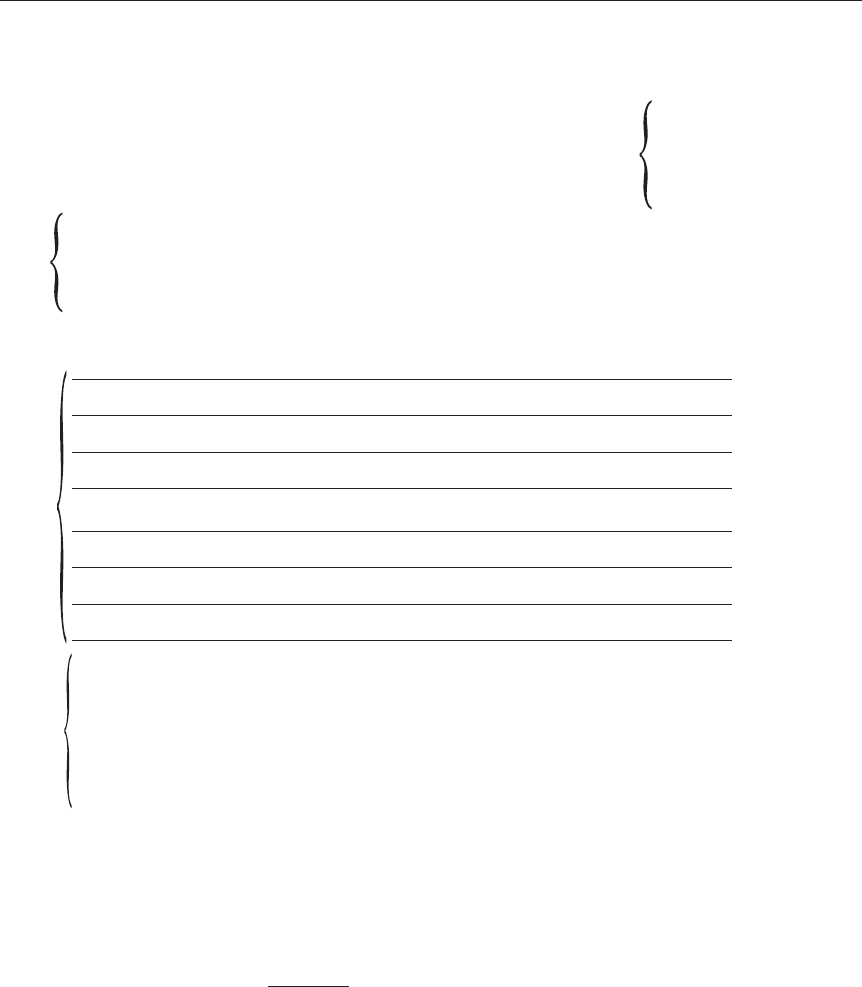
Communication Skills for Engineers
186
Business Letters: General Layout
115, Right Street
1
Mayanagar
Hyderabad – 500 029
12 Aug, 2002
Mr R Shermani
2
Manager
Bank of Baroda
Hyderabad.
3. Dear Sir,
4
I hope to receive an early reply
I am,
5 Yours faithfully,
Signature
(Name In Bold LeĴ ers)
The general layout of a well-wriĴ en leĴ er has the following important features:
1. Heading
The address, the date, no name
a. 115 Right Street Presently the open-punctuation
Mayanagar (no commas, full stops etc.) system is
Hyderabad-20 widely followed.
August 12, 2002 Preferred American style

Business Letter, Technical Writing, E-mail Writing
187
August 12, (Date without (th, nd, rd are pronounced but not wriĴ en)
th, nd, rd followed by a comma)
OR
8-12-2002
OR
8/12/’02
b. August 12th, 2002 Preferred British style
OR
12/8/02
(th, nd, rd are usually wriĴ en)
c. 12 August, 2002 Preferred international style (the date is
placed ę rst and this style is followed all
over the world)
d. All the styles are acceptable.
e. A full stop is used aĞ er St. and Rd. – short forms for ‘street’ and ‘road’.
2. Addressee’s name above ‘Dear’.
If you are addressing a person by name give the oĜ cial designation also; if one is apply-
ing for a job then only the designation is given and not the name. In business leĴ ers,
aĞ er the name of the person ‘Esq’ may also be added: R. Shermani, Esq. ‘Esq’ is an ab-
breviation for ‘Esquire’. Never write both Mr and Esq:
E.g. Mr R. Shermani Or R. Shermani, Esq.
a. “Esquire’ (British English) is used as a title of politeness usually wriĴ en in its shortened
form aĞ er the full name of a person
e.g. Kerry Packer, Esq.
Titles and decorations awarded by the State are placed before university degree.
e.g. Mr C. M. Murali Mohan, M.P., Ph.D.
b. ‘Messrs’ (Abbreviation for ‘Messieurs’ which means Gentleman)
is not used when addressing a company whose name is not personal.
e.g. The General Trading Co. Ltd.
but Messrs Shiv & Co. Ltd.
c. In the Indian context, some people use Smt/Sri/Kum in their correspondence.
3. The Salutation
Dear Sir, My Dear Sir
Dear Gentlemen, My Dear Madam,
Dear Madam, Dear Mesdames,

Communication Skills for Engineers
188
1. If the name is not known, ‘Dear Sir’ is used.
2. If the leĴ er is addressed to a woman, ‘Dear Madam’ is used.
3. If the leĴ er is addressed to an organization or ę rm, ‘Dear Sirs’, or ‘Dear Gentlemen’ is
used.
4. If it is addressed to an all-women organization, use ‘Dear Mesdames’.
5. In a general circular, use ‘Dear Sir or Madam’.
6. In formal oĜ cial leĴ ers, one may use ‘Sir’.
7. ‘My dear Sir’ is rather old-fashioned.
8. OĜ cial designations aĞ er the title may be used in the salutation in leĴ ers addressed to
persons in their oĜ cial capacity;
Dear Mr President,
Dear Mr Governor,
Dear Madam Secretary,
9. Titles other than Mr, Mrs, Miss, Dr are spelt in full
Dear Professor Rao,
Dear Ambassador Kumar.
4. The Body
Common openings in business leĴ ers:
1. Thank you for your leĴ er of Aug. 12…
2. Received your leĴ er of Aug. 12…
3. I should like to order …
4. I should like to inquire whether …
5. I wish to …
6. I wish to apply for the position of … advertised in the …
7. I wish to complain about …
8. I have to complain about…
9. Would you please …
10. I wonder if …
Formerly, most business leĴ ers had a formal style. However, modern business leĴ ers are less
formal. Avoid the chaĴ y, casual element of the personal leĴ er, but do not use the stiě , imper-
sonal, distant tone that was once adopted for all oĜ cial and business leĴ ers.
The body of the leĴ er may be wriĴ en in paragraphs. The ę rst line of each paragraph is
indented, unless the writer follows open punctuation.
Business jargon, once so popular, is now giving way to plain English;

Business Letter, Technical Writing, E-mail Writing
189
Business Jargon Plain English
Inst., or instant of this month
Ult., or ultimo of last month
Prox., or proximo of next month
We are in receipt of your We have received your leĴ er
esteemed communication
We hereby beg to inform you We wish to inform you
‘Re’ With reference to
5. Common Endings or Subscription
e.g. Yours faithfully (British style in formal business leĴ ers)
Yours sincerely (British style in leĴ ers between people who know each
other by name)
Yours truly (British style in leĴ ers where there is no personal
relationship between the writer and the addressee)
Yours cordially (British style in a formal leĴ er where there is a desire to
sound respectful)
‘Y’ in Yours must be a capital leĴ er.
– In most cases, American usage prefers to put the adverb before ‘Yours’; Sincerely yours,
Cordially yours. (‘Yours’; Sincerely yours, Cordially yours. (‘yours’ in this case does not
begin with a capital leĴ er.)
– ‘Yours’ does not have an apostrophe. (Your’s is wrong).
– Sometimes ‘I am’, ‘I remain’, ‘We remain’ are used.
e.g. I am,
Yours faithfully,
Signature
– Avoid ending a leĴ er with a present participle construction
e.g. Hoping to receive an early reply - (wrong) (unacceptable)
I hope to receive an early reply (acceptable)
I am (Open punctuation)
Yours faithfully

Communication Skills for Engineers
190
BUSINESS LETTER: SAMPLES
1. A Letter of Inquiry
123, Chickal Road,
CuĴ ack 795 001
12 March 2002
Vħ aya Furniture Company,
CuĴ ack 795 361.
Dear Sirs,
From your advertisement in the Indian Express of March 4, I understand that you supply
wooden and steel furniture in various latest designs.
I would be grateful if you could send me a brochure of the furniture you supply. I am
particularly interested in buying furniture for my drawing room
Yours truly
Sd/-
(A.S.KELUCHARAN)
Writing is a kind of therapy. Sometimes I wonder how all those who do not
write, compose, or paint can manage to escape the madness…which is inherent
in the human condition.
—Graham Greene

Business Letter, Technical Writing, E-mail Writing
191
2. Reply letter
VIJAYA FURNITURE COMPANY
CUTTACK 795 361.
Telephone: 8621
Telegram: Vē AFUR
20 March 2002
Mr A. S. Kelucharan
123 Chikal Road,
CuĴ ack 795 001.
Dear Sir,
Thank you for your leĴ er of March 12, asking for a brochure of the items of furniture we
can supply.
We are happy to send you herewith details of the wooden and steel furniture available
with us. Diě erent designs of furniture for the drawing room are shown on page 14 of the
brochure. You have a choice of teakwood and rosewood for these items of furniture.
Wooden furniture can be supplied in a week. The delivery for steel furniture will take
up to three weeks.
If there is any other information you wish to have, please write to us. We shall be happy
to let you know.
Yours faithfully,
For Vē AYA FURNITURE COMPANY
( X X X )
Sales Manager

Communication Skills for Engineers
192
3. Placing an Order
VIJAYA FURNITURE COMPANY
CUTTACK 795 361
Telephone: 8621
Telegram: Vē FUR
Our Ref:
Your Ref:
2nd April 2002
Messrs. Azeem Brothers,
Timber Merchants,
Hyderabad – 500 021.
AĴ ention: Mr Abdul Azeem
Dear Sir,
Sub: Our Quotation for teakwood planks
Your leĴ er containing details of your teakwood stock was received today.
We think the teak wood sizes that you can supply will not meet the needs of our custom-
ers. Could you, therefore, send us details of planks in plywood you can supply within a
month?
A full statement of the sizes and number of planks we need is enclosed. We would be
happy to hear from you soon.
Yours faithfully,
For Vē AYA FURNITURE COMPANY,
Sd/-
(P RAMA RAO)
Managing Partner
Encl:
Copy to: Incharge, Carpentary Section

Business Letter, Technical Writing, E-mail Writing
193
This leĴ er has some extra features. Top leĞ , we ę nd two reference numbers. When there is
a long correspondence on a subject and the mail has to be ę led for future reference, reference
numbers are given. With the help of the reference numbers, the party concerned will be able
to trace the previous correspondence on the subject and gather the information required for
taking decisions. AĞ er the inside address we see another feature, namely, the aĴ ention line.
Here the name of the person incharge of the subject is mentioned. In a large ę rm with several
sections, the aĴ ention line will ensure that the leĴ er reaches the right person in time. Next to
the signature at the close of the leĴ er, the number of enclosures with the leĴ er is mentioned
at the leĞ hand margin. We can mention either the number of papers enclosed, or give a list
of the enclosures.
e.g. Encl: 1. Brochure of items of furniture in stock
If a copy of the leĴ er has been sent to anyone else, that is shown below the list of enclo-
sures.
e.g. Copy: Incharge Head, Carpentry Section.
CHARACTERISTICS OF A GOOD BUSINESS LETTER
• A business leĴ er has to be courteous and considerate.
• It has to be precise and clear.
• It has to be complete.
• It has to be brief.
Read the following model leĴ ers. LeĴ er A and LeĴ er B are wriĴ en by two diě erent secre-
taries of a company. In both the leĴ ers, the purpose of the writers is the same, that is, company
sends donation to a social organization.

Communication Skills for Engineers
194
LETTER: A
RADHA IRON AND STEEL INDUSTRY
BB 276, WALKER TOWN, SECUNDERABAD, A.P. 500 032
Tel. 27833056 Ref:
Date: 8/3/03
The Secretary,
R. K. Mission Seva Samstha,
Domalguda,
Hyderabad – 009.
Sir,
We came to know from your notię cation inst., about your need for funds for a cancer
ward in your hospital. As you do social service, you need help from business people like
us. We are sending a cheque for Rs.10,000/- in this connection.
Yours faithfully
Sd/- XXX
(Rakesh Bhimani)
Secretary
Radha Iron and Steel Industry

Business Letter, Technical Writing, E-mail Writing
195
LETTER: B
RADHA IRON AND STEEL INDUSTRY
BB 276, WALKER TOWN, SECUNDERABAD, A.P. 500 032
Tel. 27833056 Ref:
Date: 8/3/03
The Secretary,
R. K. Mission Seva Samstha,
Domalguda,
Hyderabad – 009.
Dear Sir,
In the beginning of this month, we read with interest your appeal for funds for the new
cancer ward that is being extended in your hospital.
We are aware that your Samstha is doing noble service to the people who need help.
Therefore we feel that your Samstha deserves all possible help.
We enclose our cheque for Rs.10,000/- and are sure that your new cancer ward will be of
great beneę t to many patients.
With best wishes,
We remain,
Yours faithfully,
Sd. XXX
(Umesh Chander)
Secretary
Radha Iron and Steel Industry

Communication Skills for Engineers
196
It can be observed that leĴ er E is very curt and rude. The tone of the addresser is very ar-
rogant and patronizing. Further, the leĴ er does not follow any of the in-use layout forms. The
addresser has also used the archaic business expression ‘inst.’ The leĴ er is wriĴ en in a single
paragraph. Although the leĴ er is brief, it cannot be called a courteous and a polite leĴ er. On
the contrary, LeĴ er F reads well and is very appropriate. The tone of the writer is appreciative
and humble. The leĴ er also follows the in-use-indented form of layout. It is clear, brief and
can be called a very courteous leĴ er. The leĴ er also conveys understanding and appreciation
on the part of its addresser. Hence, secretaries for company correspondence can consider Let-
ter F as a good model of business writing.
Business Report Letter
This leĴ er is a simple ‘business report’. It is a blend of the formal and the informal leĴ ers: the
salutation is generally ‘Dear Mr XXX’ and the subscription is ‘Yours sincerely’. The Regional
Manager reports on consumer surveys, company related accidents, insurance claims etc., to
the General Manager.
The body of the leĴ er generally has three parts:
1. The introduction: the ę rst paragraph of the leĴ er gives a lead to the main part of the re-
port. The introduction to a report contains the background information and the ‘why’,
‘who’, and ‘what’ of the report.
2. The body of the report: This contains all the facts or ę ndings. The reporter’s remarks are
not expressed in this part. If the report requires exhaustive data, an appendix is gener-
ally enclosed. The body of the report gives only the gist of the data.
3. The conclusion: The conclusion contains the following:
a. Explication of the facts,
b. Reporter’s remarks, and
c. Suggestions

Business Letter, Technical Writing, E-mail Writing
197
Look at a sample business letter report:
TOIPS (INDIA) LTD
Nariman Point, Mumbai 400 011.
Branch Office: 20 R.P. Road, Secunderabad 500 002.
20 May 2002
Mr L. K. Basehwar
General Manager,
TOIPS (INDIA) LTD.
Mumbai.
Dear Mr Basehwar
As decided at the meeting of Regional Managers of the company at Mumbai in January,
a survey of customer response to our new product FAIR toilet soap was made in Hyder-
abad during April 1992.
The survey reĚ ected the mixed response of the customers.
1. 30% of a representative selection of the population use FAIR toilet soap.
2. 60% of the users like the soap, 30% of them ę nd nothing unique in the soap, but would
continue using it. 10% expressed dissatisfaction about the soap.
3. Nearly 60% of the users complained that the soap dissolved quickly in water, and lasted
for a very short time. However they said that the soap did give enough leĴ er.
In view of the results of this survey, I recommend that the Research and Development
wing look into the shortcomings and faults, and their ę ndings be placed before the subse-
quent meeting of Regional Managers in August 2002.
Yours sincerely,
Sd XXX
(P. K. S. Murthy)
Regional Manager
FORMS OF LAYOUT
Business leĴ ers can adopt any one of the many acceptable formats. The acceptable formats are
as follows:
1. Indented Form (traditional form)
2. Hanging Indention
3. Block Form (more modern form)
4. Semi Block
These diě erent forms of layout are shown below:

Communication Skills for Engineers
198
Layout 1: Indented Form
SENDER’S NAME AND ADDRESS
Tel. Ref.
E-mail: Date:
Mr R. Shermani,
Manager,
Bank of Baroda,
Hyderabad.
Dear Sir,
Complimentary close
and Signature

Business Letter, Technical Writing, E-mail Writing
199
Layout 2: Hanging Indentation Form
SENDER’S NAME AND ADDRESS
Tel. Ref.
E-mail: Date:
Mr R. Shermani,
Manager,
Bank of Baroda,
Hyderabad.
Dear Sir,
Complimentary close
and Signature

Communication Skills for Engineers
200
Layout 3: Block Form
SENDER’S NAME AND ADDRESS
Tel. Ref.
E-mail: Date:
Mr R. Shermani,
Manager,
Bank of Baroda,
Hyderabad.
Dear Sir,
Complimentary close
and Signature

Business Letter, Technical Writing, E-mail Writing
201
Layout 4: Modified Block Form
SENDER’S NAME AND ADDRESS
Tel. Ref.
E-mail: Date:
Mr R. Shermani,
Manager,
Bank of Baroda,
Hyderabad.
Dear Sir,
Complimentary close
and Signature

Communication Skills for Engineers
202
Layout 5: Semi Block Form
SENDER’S NAME AND ADDRESS
Tel. Ref.
E-mail: Date:
Mr R. Shermani,
Manager,
Bank of Baroda,
Hyderabad.
Dear Sir,
Complimentary close
and Signature
ACTIVITIES
1. DraĞ a business report leĴ er on the basis of a consumer survey conducted for your
company’s product -an intercom telephone system.
2. You agreed to supply intercom telephones to a newly built hotel by a certain date.
Write a leĴ er to the hotel manager requesting for extension of time for supplying the
equipment.
3. An electronic gadget purchased by your department last month is not functioning
properly. Complain to the manufacturer who has given you a guarantee for one year.
4. A social organization contacts your company and seeks donation for their hospital ex-
tension. Write a leĴ er, which is brief, clear courteous and considerate, to the organiza-
tion in your capacity as Secretary of the company, refusing donation.

Business Letter, Technical Writing, E-mail Writing
203
"I hate quotations. Tell me what you know."
—Ralph Waldo Emerson
TECHNICAL WRITING
Put it before them brieĚ y so they will read it, clearly so they will appreciate it, pictur-
esquely so they will remember it, and above all, accurately so they will be guided by its
light.
—Joseph Pulitzer
Introduction
Technical writing is a typical form of writing diě erent from expressive, expository or descrip-
tive writing. Typically, technical writing requires give and take, a dialogue, a follow up, input
and action. Most oĞ en, it creates action, causes the person at the other end to react or respond.
It is also a form of documentation where processes are described, recorded and analyzed.
Documentation could also be about the diě erent phases of a product life cycle or even the
responses to a certain experiment or exercise. Most oĞ en, these are in the forms of reports. It
is important to emphasize here that there may not be a single, one and only procedure of re-
porting or documenting. It is always need, and situation-specię c. There are three factors very
important for technical writing – purpose, audience and tone. The purpose of writing and the
audience very oĞ en sets the ‘tone’ of a piece of writing. If you are writing to someone above
you, you are probably requesting or recommending action. But if it is someone below you,
you are directing action, instructing. Again, if you are writing a report solely for the purpose
of documenting, your language will be diě erent. Similarly, if you are presenting a proposal
and trying to convince your colleagues, your tone will have to be persuasive.
Technical writing can be of various kinds. There can be reports or documents such as pro-
posals, product specię cations, or quality test results. There can be instructions like user guides,
online help, training and user manuals. There can even be business proposals, status reports,
customer documentation, and e-mail reports. All these kinds of technical writing have unique
formats, but there are general features that are common to all of them.
All writing is aimed at achieving some purpose or the other. But technical writing is very
specię cally aimed at achieving certain purposes. A good training manual will do exactly what
it is intended to do. A well-designed and well-wriĴ en piece of technical writing has to take
into consideration some important factors even before the process of writing begins.
Present to inform, not to impress; if you inform, you will impress.
—Frederick P Brooks

Communication Skills for Engineers
204
Organization and Language
AĞ er deciding why the document is to be wriĴ en, the objectives it is supposed to achieve and
the audience it is meant for, the most important factor you must concentrate on is the organi-
zation and the language.
Organization
One very important factor in technical writing is clear and orderly organization. Faulty or-
ganization can result in the information being distorted and hinder communication. To write
with clarity one has to ę rst have an outline of what one is going to present. There is no specię c
format for an outline. But it has to be variable and Ě exible to suit the subject and scope of cov-
erage. To have a good outline you must have:
• A clear and emphatic summary of the subject maĴ er.
• The perspective from which you are looking at it.
• Evidence in support of the thesis.
Some of the other techniques that can be used to make writing more organized are:
• Introduction to the subject maĴ er.
• Headings in large font to express transition to new ideas.
• Bulleted lists to draw aĴ ention to the subject maĴ er and make comprehension easy.
• The use of ę gures and illustrations and the help of diagrams and graphs to give imme-
diate visual representation of what is being said.
• A summary that restates the main idea and emphasizes the perspective.
Documentation is the castor oil of programming
—Gerald Weinberg
I guess it’s beĴ er to have too much information than too liĴ le. It makes the manufacturer
feel good, keeps writers employed, and makes aĴ orneys work a liĴ le harder. Besides, it
gives me something to read as I’m eating those chewy white peanuts that came with my
new computer.
—Dave Glardon
ACTIVITIES
5. Read the following passage. Give it a title. Identify the main idea, the supporting idea
and organize them systematically. (Your answer will appear similar to the paĴ ern given
below the passage)

Business Letter, Technical Writing, E-mail Writing
205
Post-independence generations of Indians came to associate the term ‘scientię c temper’
with the maker of modern India, Jawaharlal Nehru. It was he who invited fellow In-
dians to participate in the adventure of building a strong and forward-looking nation
with the help of modern science and technology. A scientię c temper required a new ap-
proach to life and things, free from obscurantist ideas steeped in irrational dogmas and
superstitions. It needed an educational system expressly wedded to the promotion of
democratic, socialist and secular values. In actual terms, it meant adoption of the kind
of culture that prevailed and prospered in the last three hundred years in Europe and
America. The industrial revolution and all that made it possible was part of that cul-
ture. Empiricism and experimentation are its backbone. A certain objectivity and avid
pursuit of truth based on verię able facts are its essential concomitants. Such a temper
is, in fact, both a cause and an outcome of the modern world.
Title
1.
i.
ii.
iii.
iv.
2.
i.
ii.
iii.
6. Given below is a write up on the diě erent kinds of crossword puzzles. Give it an ap-
propriate shape, edit it and format it with aĴ ention to the font size, numbering paĴ ern,
etc.
Three types of crosswords
Prize competition—here the winner surely gets a big prize. It is primarily a gam-
ble where many answers are equally appropriate. By paying a small entry fee
here, one can win a big prize.
Intellectual crosswords—here there is only one possible answer to every
question. The answer is elusive and calls for some detective work. The clue gives
only hints about the word and your comprehension and general knowledge are
put to test. It is primarily an intellectual exercise.
Educational crosswords — this is the kind of crossword puzzle where clues
or hints about word are given and they have to be found and put in their proper
place. The words have to be put in the proper place in the crossword square.
This kind of exercise is very helpful as a vocabulary exercise. They can be con-
sidered entertaining as simple exercises in problem-solving too!
Theory without practice is sterile, practice without theory is blind.

Communication Skills for Engineers
206
Technical Description
A technical description can be part of a report or a report itself. It is especially used when the
description talks of a new tool, device or a concept. The following are some of the ways in
which a technical description is made eě ective.
Comparisons: technical descriptions oĞ en include depiction of unfamiliar objects. This can in-
clude description of shapes, angles, colors, size and structures in exact meaningful forms. To
do this, we oĞ en need to give comparisons with familiar objects. Screws thus have ‘heads’,
saws have ‘teeth’, switches have ‘backs’ and the computer has a ‘desktop’. Some of the dimen-
sions along which descriptions are oĞ en given are: color, texture, size, quantity, shape.
Something that is being described thus could be parallel, perpendicular, cylindrical, grainy,
slippery or smooth. Technical descriptions require that the writer should empathize with the
reader and have an idea of the visual image that will be created. Thus very much contrary to
common belief, a technical writer has to be creative, has to visualize and empathize with the
audience to be able to make an eě ective presentation that reaches out and communicates.
The following is an example of the use of comparison in technical writing:
A word processor is a piece of soĞ ware that enables a computer to function like
an automated oĜ ce. With the soĞ ware the computer works like a typewriter
so that you can create your own ę les: memos, leĴ ers, reports and graphics. The
computer memory, commonly a disk, acts as a ę le cabinet from which you can
retrieve ę les, edit them when necessary, and save ę les inę nitely. Acting as a sec-
retary and copier, the word processor controls the format, type font, and the
number of copies to be printed on the printer. Some word processors also contain
a dictionary and thesaurus to check spelling and word choice and a mail merge
function for automatic addressing, which relieves secretaries of these duties.
Generally, a description of an object or device will contain the following:
1. Description of the function; the when and why of its use.
2. The physical appearance of the object and its component parts one by one. This will
include a general description of the object or device and include the dimensions, ap-
pearance and components.
3. An account of the components in sequential and logical order, including the descrip-
tion of each of them and their relationship with other components. In other words, the
manner in which these parts play into the larger function of the devise itself.
4. The deę nition of the idea or object, its overall characteristics, followed by a detailed
description of the parts in a logical order.
If you are trying to talk about the computerization of a hotel management system, for ex-
ample, you’ll have to include the following features:

Business Letter, Technical Writing, E-mail Writing
207
• A detailed description of why this system has to be computerized. This has to include
an account of the existing system; the problems in the system and where and how the
changes should be brought about.
• The detailed plans of the proposed system—the requirement, the cost estimation and
even the models that can be used.
• The ‘designing’—the physical and the logical designing and the “coding”
The last two features that are extremely important are “testing” and maintenance”. Part of
maintenance can also be preparation of user manuals etc., which need instructional writing
and a very exact use of descriptive writing to explain and describe the functioning or prod-
ucts.
ACTIVITIES
7. Describe a computer to an adult rural Indian who has never seen a computer. While
doing so, take care to mention the following:
a. the most general use
b. comparing it with familiar objects
c. giving an overall picture of the parts and describing their interconnection
d. Describing the parts in greater detail, their use etc.
8. Describe a water ę lter to a person who has seen it but never used it before. Ensure that
you give the correct expressions regarding the shape, size, and texture and functioning
of the diě erent parts.
Process Description
The technical description of a process talks about how something works. It talks of the over-
all function of the process and the materials or skills required. The description most oĞ en
includes a Ě ow chart or a diagram that can illustrate the sequence of action and the decisive
points. A typical process description will have the following elements:
• Introduction or deę nition that says when and why the process is performed.
• The general operation, which gives an idea as to the skills and time required, the pre-
operation and the post-operation conditions.
• Description of the steps—why and when it takes place, how long it lasts and what are
the human interventions required.
Whether process description is the description of an operation, a mechanism or a system,
the following steps have to be followed:
1. Deę ning the audience: Process descriptions are oĞ en used to decide whether a new pro-
cess should be implemented or a project should be started, etc. Careful choice of the language,
words and information thus should be eě ective and relevant to the audience the material is
being presented to.

Communication Skills for Engineers
208
2. Selecting an organizational principle: The next important factor in process description
is, selecting an organizational principle. The organizational principle for a process is gener-
ally chronological. The writer starts with the ę rst action and continues in order till the last.
While in some processes, the sequence is obvious, some others require careful examination to
determine the most logical sequence. If you were describing the development of cinema, for
example, you would clearly follow the chronological order. But if the topic is the complex Ě ow
of material from a plant, the sequence has to be based on the audience’s knowledge level and
the intended use of the description.
In the interests of clarity, it seemed necessary to constantly remind myself to pay not
the slightest aĴ ention to the elegance of the presentation; I adhered conscientiously to
the rule of the brilliant theoretician, Ludwig Boltzmann, to leave elegance to tailors and
shoemakers.
—Albert Einstein
3. Choosing appropriate visual aids: The third important factor in process description is the
use of visual aids. Graphic representations like a Ě ow-chart can eě ectively represent a process
and explain the sequences involved. A decision tree can help us to decide whether or not to
perform a certain action in a certain situation. Here, at each point, the reader must decide yes
or no and then follow the appropriate path.
The following is the description of the hand lever and piston of a paper micrometer, a
mechanism used to measure the thickness of paper.
The Hand Lever:
The hand lever, shaped like a handle on a pair of pliers, raises and
lowers the piston. It is made of chrome-plated steel and aĴ aches to
the frame near the base of the dial. The hand lever is four inches
long, ½ inch wide, and ¼ inch thick. When the lever is depressed,
the piston moves up, and the hand on the dial rotates. When the
hand lever is released and a piece of paper is positioned under the
piston, the dial shows the thickness of the paper.
[Analogy]
[Relationship]
[Eě ect]
The Piston:
The piston moves up and down when the operator depresses and
releases the hand lever. This action causes the paper’s Thickness to
register on the dial. The piston is 3/8 inch in diameter, Ě at on the
boĴ om and made of metal without a ę nish. The piston slides in a
hole in the frame. The piston can measure the thickness of paper up
to 0.300 inch.
[Functioning]
[Description]
[Function]

Business Letter, Technical Writing, E-mail Writing
209
ACTIVITIES
9. You have all opened the computer and saved new ę les. Describe the process to some-
body who is operating the computer for the ę rst time.
10. In one paragraph, describe how to start and set your vehicle in motion. Your audience
is a group of class of students who are learning about diě erent vehicles. Use this plan:
a. Name and deę ne the vehicle in the ę rst or the second sentence.
b. Present the details in several sentences.
c. Chronologically order the sequence of action.
d. Roughly try to talk of the link each has with the other.
e. Make a diagram to show the sequence. If you can, make a Ě ow diagram
Good writing is clear thinking made visible.
— Bill Wheeler
E-MAIL WRITING
Basics of E-mail Messages
Electronic mail (e-mail) is the medium of communication that sends and receives messages
via particularly designed computer networks. Subsequent to the growth of information tech-
nology along with the rapid use of the Internet, e-mail has become the most popular medium
of communication. Increasingly, people are using the internet for sending e-mail messages.
Undoubtedly, because of its high speed, low cost and eĜ ciency, e-mail today is one of the
most vital channels of communication. Similar to business leĴ ers and memos, e-mail mes-
sages help to strengthen professional and business relations. Routine business dealings and
activities would be extremely diĜ cult without e-mail. E-mail can be used both as a means to
get in touch with people outside an organization, and to send messages within an organiza-
tion.
All this entails eě ective e-mail writing skills as we write a number of e-mail messages ev-
eryday. Since e-mails are faster than leĴ ers and memos and are used for quick transmission of
information and ideas, they serve varied purposes including the following:
• Conveying routine information about new products, procedures, services, policy
changes and market strategies;
• Seeking information or resources;
• Inviting people to business meetings, conferences, seminars, workshops, or sympo-
siums;
• Asking for explanations, feedback or clarię cations;
• Discussing problems and possible solutions;
• Persuading people to take a course an action; and
• Furnishing feedback, suggestions, or recommendations.

Communication Skills for Engineers
210
Benefits of E-mail
1. Speed is the main beneę t of using e-mail. Contrary to regular mail, which may take days
or weeks to reach its readers, e-mail reaches almost immediately irrespective of dis-
tance, place or person receiving it. We just need to type the name(s) and e-mail address
(es) of the addressee and click the mouse on the send buĴ on, and our message is sent.
2. Low cost is yet another beneę t of using e-mail. Because sending an e-mail does not in-
volve printing and copying, it is less expensive than any other channel of communica-
tion (that is, postal mail, telephone, fax etc.). A dozen e-mail messages may be sent in
twelve minutes and the cost could be as low as six or seven rupees. Interestingly, the
size of the message or the distance to the recipient does not aě ect the cost.
3. E-mail makes for quick and easy distribution. Messages can be transmiĴ ed to multiple
recipients simultaneously without involving repetition and wastage of time.
4. E-mail enables total Ě exibility to the entire process of writing. Before sending an e-mail,
the user may edit, revise, modify, and redesign the message without printing or copy-
ing it. Furthermore, the user has the option to receive or compose e-mails at one’s own
convenience.
5. E-mail enables easy aĴ achment of ę les, photographs, clippings, drawings video clips,
sound recordings, etc to the message. For instance, resumes, scanned copies of testimo-
nials, transcripts, and other documents can be aĴ ached to job applications sent through
the e-mail.
6. E-mail is relatively less formal and less structured than leĴ ers. It is generally in the
form of a private conversation, where the sender wants to say something and expects a
response from the reader. Thus, e-mail promotes ease during upward and downward com-
munication. While sending an e-mail the writer need not worry about a serious, ę xed
style of communication and may follow the format of any set paĴ ern or style of writing
that suits the writing context.
Features of Effective E-mail Messages
The use of e-mail for business and professional purposes continues to become more wide-
based due to its remarkable advantages. It is increasingly becoming the most used profession-
al communication channel. Eě ective e-mail messages however have certain features, which
include conciseness, accuracy, clarity, conversational tone, and single theme.
1. Conciseness is the most important feature of an eě ective e-mail message. An e-mail
should contain only the essential information. Unessential explanations, repetitions,
wordy expressions, and exaggerations should be avoided. Points should be so orga-
nized that the e-mail makes its point with as few words as possible. The recipient may
not have the interest or time for a very long and detailed message.
2. Accuracy is vital to eě ective e-mail writing. The format and structure used should be
accurate. Correct e-mail addresses should be put in. Messages certainly bounce if an
incorrect e-mail address is used. You should check the content of the e-mail for factual
accuracy. E-mail messages should be glossed over for spelling, punctuation, and gram-
matical mistakes.

Business Letter, Technical Writing, E-mail Writing
211
3. E-mails ought to be simple and clear. Simple, familiar, direct and specię c words, appro-
priate linkers, and transitional signals ought to be used to write crisp sentences and
paragraphs.
4. The tone of e-mail messages is usually semi-formal but conversational. It is advisable to
use a tone which gives a personal feel to e-mails. Nevertheless, one should avoid being
too informal or emotional. The test is to maintain professionalism without being too
oĜ cial.
5. An eě ective e-mail message generally deals with only one topic. In order to be focussed,
you need to concentrate on a single theme. Developing a single theme logically and
substantiating it with related ideas is important.
Format of an E-mail Message
While e-mail systems normally come with a readymade format, we need to adhere to stan-
dard writing conventions and implement it eě ectively. Thus, an awareness of current e-mail
conventions and standard practices is very essential. To write an appropriate e-mail, it should
be follow a correct format.
When we get an Internet e-mail message, we ę nd that it usually contains many line seg-
ments before the beginning of the actual text. These line segments consist of the “header” of
the message. Basically, it is a record of the path the message took from the writer’s computer
to the reader’s computer. Headers also contain information of the time and date and indicate
if any ę le is aĴ ached to the message.
The three most important items of information in the header are the e-mail addresses of the
sender and the recipient, and a subject line that may tell what the message is about. All e-mail
messages contain these three items of information.
When a person sends an e-mail message, the programme usually inserts the sender’s name,
return e-mail address, and date automatically. Therefore, the sender need not type the name,
e-mail address, and date again. The sender just needs to ę ll in the “To” line with the recipient’s
e-mail address, the “Subject” line with a clear and concise description of the subject of the
message, the Cc (carbon copy) line with the e-mail address of anyone who is to receive a copy
of the e-mail message, and the Bcc (blind carbon copy) line with the e-mail address of anyone
who is to receive a copy of the e-mail message without the knowledge of the main recipient
and the Cc recipient. If many names are kept in the Bcc line, each of the recipients will be ig-
norant about who else is included as Bcc recipient.
An E-mail includes the following:
• Heading
• Salutation
• Body
• Closing
• Signature
Heading:
The heading segment of an e-mail includes the following six items:
• Date
• From
• To
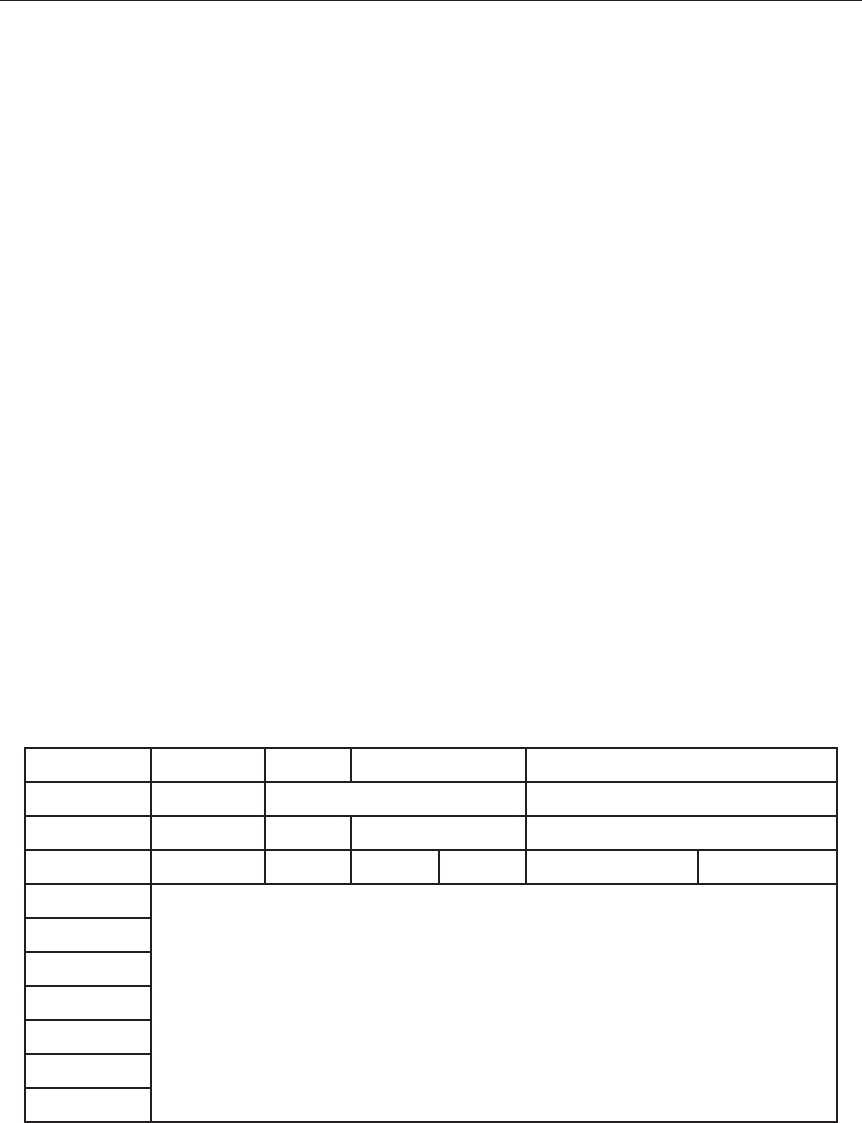
Communication Skills for Engineers
212
• Subject
• Cc
• Bcc
The Date line indicates the date the e-mail was wriĴ en. It includes the day, month, year and the
exact time. While sending an email message, the date line usually appears automatically.
Example: Date: Tue, 25 Nov 2009 12:58:20 + 0100(BST)
The ‘from line’ contains the sender’s name and e-mail address. The name does not include any
personal title such as Ms, Mrs, Mr, or Dr while sending an email message, the return address
usually appears automatically.
Example: From: “kishore kumar” [email protected]
The ‘To line’ includes the recipient’s email address.
Example: [email protected]
Subject The subject line summarises the topic of the email in a few words. It includes clear
and complete information about the theme of the e-mail in phrase form. Figure 1 shows email
heading.
Example: Subject: New syllabus details
Cc The Cc line (carbon copy) may include the e-mail address of any one who is to receive a
copy of the e-mail message. It is an optional line.
Example: Cc: [email protected]
Bcc The Bcc line (blind carbon copy) may include the email address of anyone who is to re-
ceive a blind copy of the email message. That is, it includes anyone who is to receive a copy
of the e-mail message without the knowledge of the main recipient and the Cc recipient. It is
an optional line.
Example: Bcc: swami_nanda@rediě mail.com
Figure 11.1 shows a sample e-mail heading.
0DLO $GGUHVVHV &DOHQGHU 1RWHSDG NDVK\DSQ#\DKRRFRXN>6LJQRXW@
&KHFNPDLO &RPSRVH 6HDUFK0DLO±0DLO2SWLRQV
&KHFN2WKHU0DLO 3UHYLRXV 1H[W %DFNWRPHVVDJHV 3ULQWDEOHYLHZ±)XOO
>(GLW@ 'HOHWH 5HSO\ 5HSO\$OO )RUZDUG $VDWWDFKPHQW
0RYHWRIROGHU
)ROGHUV>$GG@
'DWH7XH1RYHPEHU
)URP³0XUDOL&³FPNUL#JPDLOFRP!
7R³1DQGLODO<DGDY³QDQDY#\DKRRFRXN!
6XEMHFW8*&3URMHFW
&FFWVYNNVJ#UHGLIIPDLOFRP
%FFVLYDQLVKLNV#\DKRRFRP
,QER[
'UDIW
6HQW
%XON>(PSW\@
7UDVK>(PSW\@
0\)ROGHUV>+LGH@
Figure 11.1 E-mail heading.
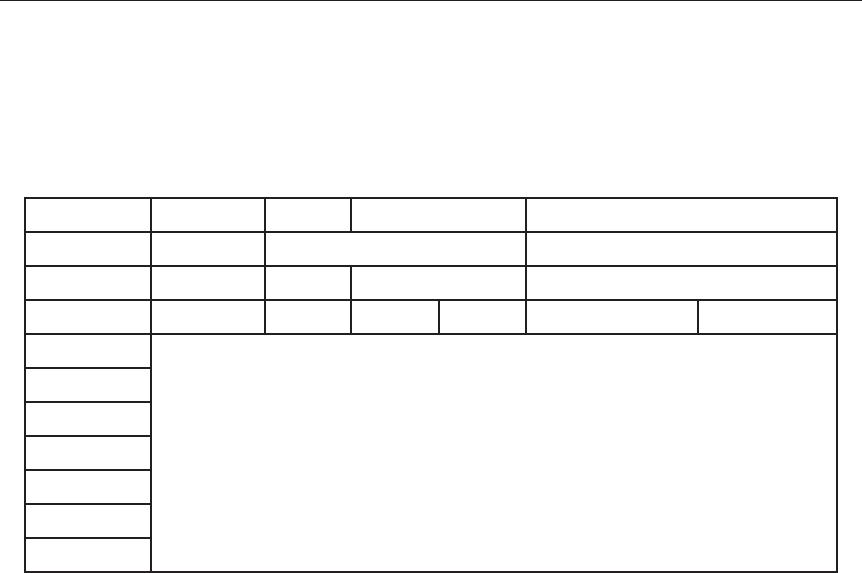
Business Letter, Technical Writing, E-mail Writing
213
Salutation
A salutation should be used as in Figure 11.2, if e-mail is being used as a means to reach out to
people outside the senders organization. The same name as in the To line can be used with a
personal title such as Ms, Mrs, Mr, or Dr. However, salutation may be omiĴ ed if the e-mail is
being used to send information inside the sender’s organization.
Examples: Dear Dr.Kumar, Dear Professor Shivram, Hello Jaya, Hi Ram
0DLO $GGUHVVHV &DOHQGHU 1RWHSDG NDVK\DSQ#\DKRRFRXN>6LJQRXW@
&KHFNPDLO &RPSRVH 6HDUFK0DLO±0DLO2SWLRQV
&KHFN2WKHU0DLO 3UHYLRXV 1H[W %DFNWRPHVVDJHV 3ULQWDEOHYLHZ±)XOO
>(GLW@ 'HOHWH 5HSO\ 5HSO\$OO )RUZDUG $VDWWDFKPHQW
0RYHWRIROGHU
)ROGHUV>$GG@
'DWH7XH1RYHPEHU
)URP³0XUDOL&³FPNUL#JPDLOFRP!
7R³1DQGLODO<DGDY³QDQDY#\DKRRFRXN!
6XEMHFW8*&3URMHFW
&FFWVYNNVJ#UHGLIIPDLOFRP
%FFVLYDQLVKLNV#\DKRRFRP
'HDU0U<DGDY
,QER[
'UDIW
6HQW
%XON>(PSW\@
7UDVK>(PSW\@
0\)ROGHUV>+LGH@
Figure 11.2 E-mail salutation
Body
The body of an e-mail message describes, explains, and discusses the main idea of the e-mail.
The content of the e-mail should be organized logically. The ę rst paragraph may begin with a
warm opening followed by a statement of the main point. The next paragraph should begin by
justifying the importance of the main point. In the next few paragraphs, justię cation should
be continued while providing background information and supporting detail. The closing
paragraph should reinforce the purpose of the e-mail and, sometimes, request some type of
response or action. Figure 11.3 shows the body of an e-mail message.
Closing
An external e-mail message may be concluded with a suitable closing such as Best regards,
Kind regards, Regards, Sincerely, Yours faithfully, Thank you and regards, All the best, Best
etc.
Signature
The signature line in an e-mail message generally contains only the writer’s name. However,
it can sometimes include the title and organization of the sender.
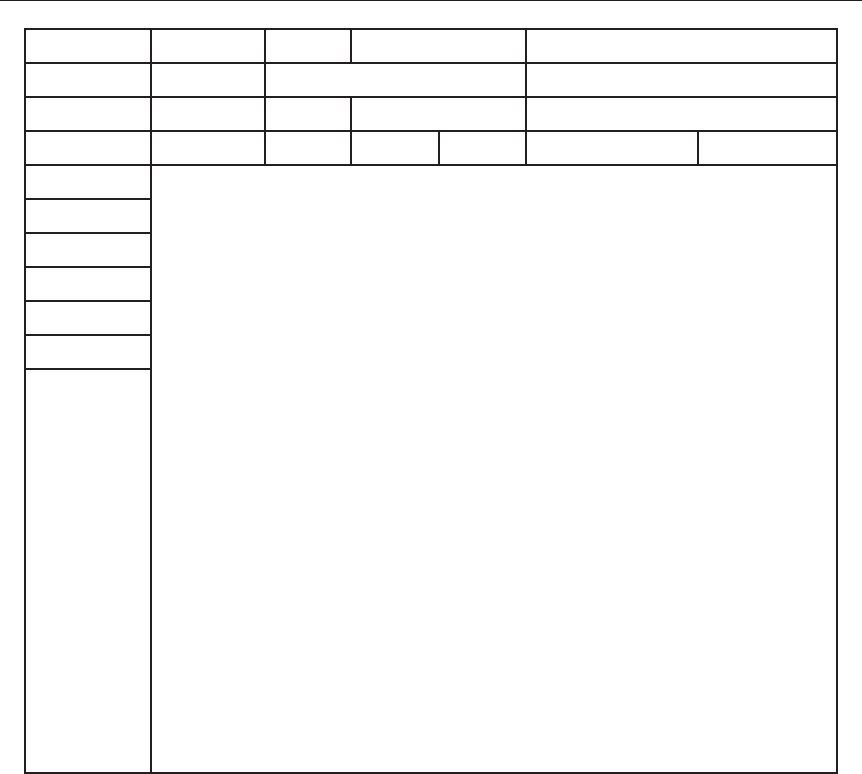
Communication Skills for Engineers
214
0DLO $GGUHVVHV &DOHQGHU 1RWHSDG NDVK\DSQ#\DKRRFRXN>6LJQRXW@
&KHFNPDLO &RPSRVH 6HDUFK0DLO±0DLO2SWLRQV
&KHFN2WKHU0DLO 3UHYLRXV 1H[W %DFNWRPHVVDJHV 3ULQWDEOHYLHZ±)XOO
>(GLW@ 'HOHWH 5HSO\ 5HSO\$OO )RUZDUG $VDWWDFKPHQW
0RYHWRIROGHU
)ROGHUV>$GG@
'DWH7XH1RYHPEHU
)URP³PDQDJLQJHGLWRU³PDQDJLQJHGLWRU#HQJLQHOFRP!
7R³6XQLWD³VXQLWDP#\DKRRFRLQ!
6XEMHFW(QJLQH&RPPXQLFDWLRQ
&FUXWKVLPRQ#JPDLOFRP
%FFGRXJODVNHU#\DKRRFRP
'HDU6XQLWD
7KHQHZLVVXHRI(QJLQH,VVXH1R1RY'HFLVQRZUHOHDVHGDQGFDQEHYLHZHGDWZZZ
HQJLQHFRP7KHµIRFXV¶LVRQ%ULWLVK$PHULFDQ%ULGJHPRGHOVWKDWKDYHPXFKLQFRPPRQDQGVHDP
OHVVO\PHUJHLQWRHDFKRWKHU(GLWHGE\'U.XPDUWKHVHFWLRQSUHVHQWVLQWHUHVWLQJYLJQHWWHVIURPERWK
WKHVLGHV,QWKHµ)HDWXUH¶VHFWLRQZHSUHVHQWWKHIDVFLQDWLQJGHVLJQRIWKHVKRUW)2%VHGLWHGE\$ODN
,WWDNHVDEULHIORRNDWWKHVKRUW)2%IRUPVLQ%ULWLVKFLYLOHQJLQHHULQJKLVWRU\7KHUHJXODUVHFWLRQVRI
6WUXFWXUHG\QDPLFVDUWLFOHVERRNUHYLHZVVWUHQJWKRIPDWHULDOVDGGWRWKHULFKEOHQGRIIDUHRQRIIHU
7KHUHKDVEHHQDGHOD\RIDOPRVWDZHHNLQWKHUHOHDVHRIWKLV,VVXHPDLQO\GXHWRZRUNLQWKHIDPLO\
:HUHJUHWWKLVGHOD\DQGKRSHWKDWLWZLOORQO\EHDRQHWLPHRFFXUUHQFH,DPWKDQNIXOWRP\FROOHDJXH
$QDQGLZKRJDPHO\WRRNRQWKHRQHURXVWDVNRIHGLWLQJWKH,VVXHLQP\DEVHQFH1RWEHLQJWRRFRPIRUW
DEOHZLWKWKHWHFKQLFDODVSHFWVVKHOLWHUDOO\KDGWRGDUHWKURXJKWKHURXJKWLGH6KHZDVDEO\VXSSRUWHG
E\$QMDQIURPWKH86DQG&KDQGUVHNKDUIURP+\GHUDEDG:HDUHJUDWHIXOWRERWKRIWKHP
2XUQH[WLVVXH±WKH$QQLYHUVDU\,VVXH±ZLOOWDNHDORRNDWUHFHQWWUHQGVLQ,QGLDQ6WUXFWXUDO:RUNV
XQGHUWKHHGLWRUVKLSRI3URI*5DMRI-18'HOKL:HLQYLWHRXUPHPEHUVWRFRQWULEXWHWRWKHVHFWLRQ
7KHVHZLOOKHUHDIWHUEHFRPHDQQXDOIHDWXUHVWREHSUHVHQWHGLQWKH-DQ)HELVVXH
:LWKNLQGUHJDUGV
6UDYDQ
*6UDYDQ5DR0DQDJLQJDQG&KLHI(GLWRU(QJLQH
,QER[
'UDIW
6HQW
%XON>(PSW\@
7UDVK>(PSW\@
0\)ROGHUV>+LGH@
Figure 11.3 Body of an e-mail message.
Regular E-Mail Practices
As e-mail messages are methodical aĴ empts to work together with colleagues and other pro-
fessionals, regular e-mail practices n eed to be followed. The following suggestions will help
in organizing and presenting e-mail messages methodically:
Follow Established E-mail Principles Every organization maintains certain rules regarding elec-
tronic communication. Some organizations may consider certain messages unsuitable for the
company e-mail system. In many of the organizations, e-mail is not used to send conę dential
messages such as conę dential reports, company secrets, maĴ ers relating to organizational
business and sensitive personal business dealings. It is important for us to be conversant with
established e-mail conventions of the organization we work in. As a rule, e-mail is not used to
send conę dential, complex, embarrassing or sensitive messages. As e-mail creates a permanent

Business Letter, Technical Writing, E-mail Writing
215
record that can be used against the sender, it should not be used to convey anything that is
inappropriate for public consumption.
Check Mailbox Regularly As speed is the main beneę t of using e-mail, everyone wants a quick
response to their e-mail. We ought to check our mailbox daily so that we can read every e-mail
message sent to us and respond appropriately. In case, we cannot respond because of some
reasons, an acknowledgement should be e-mailed back.
Correctness Many people have a tendency to be casual while sending e-mail messages. Care
should be taken about accuracy of information as well as of presentation. It is very important
that the sender is ę rst satisę ed regarding the accuracy of information that is being sent before
clicking the ‘send’ key. The following should be cross-checked.
• the electronic address/addresses of the receiver;
• the subject, Cc, Bcc lines;
• content of the e-mail message; and
• aĴ achments, if any.
Further, it is important to edit and revise e-mail messages so as to improve their presenta-
tion quality. E-mail messages should be reviewed to analyze whether they can complete their
purpose. They should be edited to correct their format, mechanics, grammar, spelling and
punctuation. The spelling and grammar check inbuilt into the programme can be used for this
purpose.
Brevity E-mail messages should preferably be kept short. Very few people like reading very
lengthy e-mail messages. Unessential information, wordy expressions, repetitions, and exag-
gerations should be avoided. The e-mail message should make its point in as few words as
possible. Sentences and paragraphs should be wriĴ en short.
Readability In order to make a message reader-friendly, the sender must keep the computer
screen in mind while composing the e-mail message. Bring in features such as introductory
summary, headings, sub-headings, listings, bullets in order to improve readability if messages
are slightly long.
Tone You ought not to use a tactless or negative tone as this can lead to confusion and misun-
derstanding. A formal but conversational tone, which lends a personal touch to your e-mail is
beĴ er. The sender must adopt the expressions to suit the context of the message and the needs
of the readers. First person pronouns (I, we) and conversational contractions (you‘ll, he’ll,
she’ll, can’t, don’t, doesn’t) can be used by all means.
Email Writing Process
In order to compose an eě ective e-mail message, the writer should identify the problem/con-
text that led to the writing of the e-mail message and analyze the possible audience to under-
stand their needs. The writer should decide the scope of the message, and prepare an outline
of the main points that are to be included in the e-mail. Once the sender has decided what
should be covered in the e-mail, the message can be organized by selecting an appropriate

Communication Skills for Engineers
216
organizational paĴ ern. The sender can then write the ę rst draĞ . AĞ er review and revision of
the ę rst draĞ , the ę nal draĞ is wriĴ en.
If a response to an e-mail message has to be made, the message should be read carefully
to understand what the writer wants. AĞ er deciding the scope of the message and organizing
the message, the ę rst draĞ can be wriĴ en. The draĞ is reviewed, revised and edited before
composing the ę nal draĞ .
SUMMARY
• Business leĴ ers are leĴ ers wriĴ en in the context of business transactions between indi-
vidual business personnel or between business organizations.
• Business leĴ ers normally follow a general layout.
• A good business leĴ er has to be courteous, considerate, precise and clear, complete, and
brief.
• A simple business report is a blend of the formal and the informal leĴ er.
• Business leĴ ers can adopt any one of the many acceptable formats. The acceptable for-
mats are the indented form (traditional form), the hanging indention, the block form
(more modern form), and the semi-block form.
• Technical writing is a kind of documentation that involves the act of recording a process
or an event for future reference.
• The three important factors for technical writing are purpose, audience and tone.
• In technical writing, it is important to deę ne the purpose and deę ne the audience.
• Organization, language and presentation style are equally important.
• Many phrasal verbs and prepositional phrases are used in formal/ technical/ business
writing contexts as they have diě erent ranges of use, meaning or collocation.
• Electronic mail (e-mail) is the medium of communication that sends and receives mes-
sages via particularly designed computer networks.
• Because of its high speed, low cost and eĜ ciency, e-mail, today, is one of the most vital
channels of communication.
• E-mail can be used both as a means to get in touch with people outside an organization,
and to send messages within an organization.
• The beneę ts of e-mail speed are low cost, quick and easy distribution, total Ě exibility,
easy aĴ achment and ease during upward and downward communication.
• Eě ective e-mail messages however have certain features, which include conciseness,
accuracy, clarity, conversational tone, and single theme.
• An E-mail includes heading, salutation, body, closing and signature.
• As e-mail messages are methodical aĴ empts to work together with colleagues and oth-
er professionals, regular e-mail practices need to be followed.

Business Letter, Technical Writing, E-mail Writing
217
REVIEW QUESTIONS
1. Describe the features of a typical business leĴ er.
2. What are the diě erent layout forms of modern business leĴ ers?
3. What are the features of a well-wriĴ en business leĴ er?
4. In technical writing, why is it important to identify the purpose of writing and the audi-
ence? Explain the signię cance of these two.
5. What is the signię cance of comparison in a technical description?
6. Describe a duster used to clean the writing board in a classroom. Carefully use the pri-
ciples of technical description in doing this.
7. What kind of a language is preferred in technical description? Explain with suitable il-
lustrations.
8. Assume that you are Shankar Rao, a student doing B.Tech. in mechanical engineering at
JNTU, Hyderabad. Write an e-mail message to Bharadwaj Kumar, the personnel man-
ager of Bluestar Industries (e-mail address: bharadw[email protected]) requesting him to
allow you to do short vacation training at the Balanagar plant of the company, as part
of your academic assignments.
9. Your are Narasimha Rao, Purchase OĜ cer, BHEL, Hyderabad. Write an e-mail to the
Sales Manager of Thambi OĜ ce Needs Limited, Secunderabad OĜ ce. You want ę Ğ y
desktop computers at the quoted price of Rs.23, 000/- each. Request the Sales Manager
to send details regarding the payment system, delivery charges and the delivery time.

CHAPTER 12
Report Writing, Project and
Proposal Writing
Chapter Objectives
This chapter aims to give the students the basics of report writing. It gives the basic structure of reports
and provides samples of report types, the letter form and the schematic form of report writing. The
specifi c report forms that have been discussed are the feasibility reports, the empirical research report
and the proposal format.
This report, by its very length, defends itself against the risk of being read.
—Winston Churchill
REPORT WRITING: THEORY AND PRACTICE
Modern corporate culture is highly dependent on management information system. This sys-
tem is based on reporting. Important decisions, facts and information have to be conveyed
at various levels and at various stages. The information has to be accurate and up-to-date.
The data collected must be properly organized and valid. Ensure that it gives the necessary
information suitable for further analysis and action by the management. At this point it is im-
portant to remember that there is no single way of writing a report. Many organizations have
their own formats. Formats may also vary depending on the kind of report being wriĴ en and
the purpose it is supposed to serve. At times, a report can even be put in the ‘memo’ format
if it is being communicated to someone within the organization. Or it can be a voluminous
research report giving factual details and analysis.

Report Writing, Project and Proposal Writiing
219
Structure of a Detailed Written Report
The structure of the report can be divided into three main parts—The front maĴ er, the
main body, and the back maĴ er.
The Front Matter
The front maĴ er consists of the title page, the forwarding leĴ er, the preface, the acknowledge-
ments, table of contents, the abstract and the summary.
Title Page :
The title page of a formal report generally has the following features—
The Title
The Sub-title
Name of the author
Name of the authority for whom the report is wriĴ en
The contract, project or job number
The date
(Although there is no strict rule as to how the title page should be designed, the following
is a sample of how it could look).
Title Page
Report Number: 385
HYDERABAD TEXTILES CORPORATION
A REPORT
ON
INSTALLING A NEW PRODUCTION UNIT
Prepared for
The Managing Director
By K. L. Kumaraswamy
Special Research oĜ cer
30th Sep’02

Communication Skills for Engineers
220
Forwarding LeĴ er and Preface
A forwarding leĴ er is a kind of introductory leĴ er through which the author establishes a rap-
port with the reader, puts the book or project in the proper perspective. It also makes some
important points regarding the scope, contents and purpose of the book. The preface serves
more or less the same purpose but while the “preface” is wriĴ en by the author himself, an ex-
pert customarily writes a “foreword”. In most cases it might suĜ ce to simply have a preface.
It is also possible at times to have a table of contents, an abstract or a summary aĞ er the ę rst
page and directly go on to the “Introduction ”.
Such decisions largely depend on the kind of report you are writing and the usual practice
at the place of work.
Acknowledgements:
In the acknowledgements, we generally list out the names of the people and organizations
that have helped in the making of the report.
Table of Contents:
If a report is several pages long and deals with various aspects of a problem, it is necessary to
have a table of contents. Its function is to give the reader an overall view of the report, help
him locate a particular topic or subtopic. Given below is the structure of the table of contents.
Note that the Arabic numerals begin only from “Introduction” onwards.
Table of Contents
Preface
Acknowledgements
Summary
1. Introduction.. . .. . .. . .. . .. . .. . .. . .. . .. . .. . .. . .. . .. . .. . .. . .. . .. . .. . .. . .. . .. . .. . .2
2.
. .. . .. . .. . .. . .. . .. . .. . .. . .. . .. . .. . .. . .. . .. . .. . .. . .. . .. . .. . .4
2.1 . .. . .. . .. . .. . .. . .. . .. . .. . .. . .. . .. . .. . .. . .. . .. . .. . .. . .5
2.2 . .. . .. . .. . .. . .. . .. . .. . .. . .. . .. . .. . .. . .. . .. . .. . .. . .. . .7
2.3
. .. . .. . .. . .. . .. . .. . .. . .. . .. . .. . .. . .. . .. . .. . .. . .. . .. . .8
3. . .. . .. . .. . .. . .. . .. . .. . .. . .. . .. . .. . .. . .. . .. . .. . .. . .. . .. . .. .10
3.1
. .. . .. . .. . .. . .. . .. . .. . .. . .. . .. . .. . .. . .. . .. . .. . .. . .. .11
3.2 . .. . .. . .. . .. . .. . .. . .. . .. . .. . .. . .. . .. . .. . .. . .. . .. . .. .12
4. Conclusions .. . .. . .. . .. . .. . .. . .. . .. . .. . .. . .. . .. . .. . .. . .. . .. . .. . .. . .. . .. . .. . .. .15
5. Recommendations . . .. . .. . .. . .. . .. . .. . .. . .. . .. . .. . .. . .. . .. . .. . .. . .. . .. . .. . .. .17
Abstract / Summary:
Most reports consist of a synopsis, which is called an abstract or sometimes an executive sum-
mary. An abstract tells what the report is about and gives the extent of coverage. A summary
gives the substance of the report without any illustrations and explanations. However, a sum-
mary will give the method of analysis, the signię cant ę ndings, the important conclusions

Report Writing, Project and Proposal Writiing
221
and the major recommendations. The abstract is generally about two to three per cent of
the original while the summary is about ę ve to ten percent. OĞ en, a combination of both is
presented as the synopsis. The executive summary forms an important part of the report. It
should contain the following:
• why the work was done
• how the work was done
• what was found—results, conclusions, recommendations.
A good abstract should be complete, concise, specię c and self-suĜ cient. And it is to be wriĴ en
only at the end of a report.
Main Body
Introduction
An introduction familiarizes the reader with the subject of the report. It lists out the following
items of information:
• Historical and technical background
• scope of study with its limitations and qualię cations
• methods of collecting data and their sources
• authorization for the report and terms of reference; and deę nitions of special terms and
symbols.
While preparing the main body of the report, it is necessary to divide it into the main and the
sub points. This improves clarity and aids understanding. An “Introduction” sets the scene
and prepares the reader. Thus it needs to state in a sincere and unambiguous manner that
which it is going discuss.
Discussion or Description:
The main business of the report is discussed in this section. Containing most of the illustra-
tions, it ę lls most of the report. The main function of this part is to present data in an orga-
nized form, discuss their signię cance, analysis and the results. If the data is too voluminous,
it is given in the appendix. There is no one particular procedure for writing the discussion.
Some writers prefer to use a backward order i.e., ę rst stating the results and then describing
how they were arrived at. Or at times, the data and procedure is mentioned ę rst and the re-
sults follow.
Conclusions:
This term refers to the body of logical inferences drawn and the judgements made on the basis
of analysis of data presented in the report. All conclusions are supported by what has gone
before; nothing new is included at this stage. If their number is large, they may be itemized in
the descending order of their importance.
Recommendations:
Conclusions comprise the inferences and the ę ndings, whereas the function of recommenda-
tions is to suggest the future course of action. A busy executive may sometimes read only

Communication Skills for Engineers
222
this part of the report and take decisions. Thus, recommendations are formulated aĞ er con-
sidering all aspects of the question examined in the report. The terms of reference generally
indicate whether recommendations are required or not. If required, recommendations can
be listed out in the descending order of importance. If their number is more, they may be
grouped under diě erent subheadings.
Back Matter
Appendices:
The appendix contains material, which is necessary to support the main body of the report,
but is very lengthy to be included in the text. It should be such that, not reading it should not
eě ect the reader’s total understanding of the report. However, it should, if one wishes to ex-
amine, provide all the evidence and documents.
Bibliography:
A bibliography is a list of published or unpublished works, which are consulted while pre-
paring a report. While writing a bibliography, care has to be taken about the order of authors
or authors’ names and surnames, the sequence of details, the punctuation marks, and the
layout.
Examples:
1. Atkins, Douglas, G., and Michael L, Johnson. Eds. 1986. Writing and Reading Diě erently:
Deconstruction and Teaching of Composition and Literature, Lawrence: University Press of
Kansas.
2. Sundarajan Rajeshwari. Ed. 1992. The Lie of the Land: English Literary Studies in India,
Delhi: OUP.
Glossary:
A glossary is a list of technical words used in the report, with their meanings explained. The
need for a glossary depends on how familiar the readers are with the topic discussed.
Index:
The index serves as a quick guide to the material in the report. It helps the reader to locate
easily any topic, sub-topic or an aspect of the contents. The index is useful in bulky reports
where the table of contents is not suĜ cient. Entries are made in alphabetical order with cross-
references. The page numbers on which information about an entry is available are mentioned
against it.
Not that the story need be long, but it will take a long while to make it short.
—Henry David Thoreau

Report Writing, Project and Proposal Writiing
223
Apart from the detailed report above, there can also be the following kinds of reports—
Reports of Routine Nature
In all organizations, there are routine reports that go to management personnel at ę xed in-
tervals like every day or every fortnight or every month or every quarter. These are called
routine reports. They are related to maĴ ers relating to production, labour eĜ ciency, cash Ě ow
and sales performance. In fact, these routine reports are mainly statistical, and the clerk or
the junior executive in some cases can collect the data in a predetermined form and present
it without much use of language. In eĜ cient organizations, there are readymade forms for
major reports and only the ę gures need to be ę lled in. The function of these routine reports
is to collect precise data and submit it on time to enable the management to take corrective
action before it is very late.
Reports that Are Special
At times, vital decisions of the management are dependent on special reports. These reports
concern things that are not repetitive and routine in nature. When the management calls for
a report, it also specię es who has to report and to whom. The instructions further contain a
clear-cut statement of the objective behind seeking the report. At times, the special reports
are a consequence of routine reporting. For instance, let us say shortage of raw material is re-
ported several times aĞ er adequate material has been ordered. The management may suspect
theĞ s of material and may ask a person or a commiĴ ee to investigate and report. For many
reports of this kind, it is necessary to collect data, interpret and analyze it, and even give sug-
gestions. Data can be collected by visiting a place, directly assessing a situation, interviewing,
corresponding with people or even holding meetings.
Points to Remember
• A report is a statement of facts
• Clarity and conciseness are of great importance.
• Charts, tables etc can help clarity.
• Passive voice suits a report more than active voice in expression. At appropriate
places, it helps to have expressions like:
“It was observed that…”
“It is recommended that …”

Communication Skills for Engineers
224
METHODS OF REPORTING
There are two methods by which individuals can write reports:
The Letter Method
It may take the form of an ordinary leĴ er. That means that usual formality of heading, ad-
dress, inside addresses, salutation etc. should be maintained in the report. Below the saluta-
tion, the title of the report should come.
The next paragraph should show what procedure the report writer followed and what per-
sons he interviewed. The rest of the paragraphs should show the ę ndings and the last para-
graph should give the conclusions or the considered opinion of the report writer. In short, it
is just a more systematically wriĴ en leĴ er.
The Schematic Method
This method is more common in commiĴ ee reports.
Here, the title of the report is given ę rst. Then, the contents of the report are given under
the following subtitles.
a. Terms of reference: This section should give the source or the authority that ordered the
report. It also describes the scope of the report and its objectives.
b. Procedure: This section should give the method followed by the report-writer. It may
mention the places visited, persons interviewed, etc.
c. Findings: The facts as they exist are presented in proper order here.
d. Recommendations or Conclusion: This section should give the considered opinion of the
report–writer based on the facts as interpreted by him. It has got to be an expert opin-
ion based on incontrovertible facts.
The end may have the signature and designation of the report writer
Easy reading is damn hard writing.
—Nathaniel Hawthorne
The following is a report presented in both the leĴ er method and the schematic method:
1. Report on workers’ discontent presented in the Letter form
DECCAN ENGINEERING CO. LTD.
2-2-344, Balanagar, HYDERABAD 500 011.
Ph.040-27938966/67/79
April 24, 2003
The Directors,
Deccan Engineering Co. Ltd.
Balanagar,
HYDERABAD 500 011.
Report on workers’ discontent at the Company’s auxiliary unit
In accordance with the instruction given to me on April 9, 2003, I visited the auxiliary unit of
the Company in order to ę nd out the cause and extent of discontent among the workers.

Report Writing, Project and Proposal Writiing
225
I interviewed supervisors, plant-operators and 25 workers selected at random in this con-
text.
I found out the following facts that are responsible for this trouble:
There seems to be widespread discontent amongst workers. Several other personnel point-
ed out that the number of incidents of breach of discipline and general non-cooperative aĴ i-
tude had gone up considerably. They expressed the view that the situation was deteriorating
and that a serious outbreak of misbehaviour might result. The workers, on their part also had
some complaints. According to them the supervisors were inadequate; the workers were
given long hours on the production line and skilled personnel were not eager to explain the
working of the machinery to apprentices. There were other avoidable lapses that the workers
resented. The skilled personnel, to save their own time, leave the machines dirty so that the
unskilled workers have to clean them. Safety precautions in the machine room are continu-
ally being ignored. There is a widespread belief that the rates paid to workers are the lowest
in the area.
I am of the opinion that immediate action must be taken to prevent further disturbances. It
is also felt that there is evidence that all the complaints are well-founded. In particluar, ignor-
ing safety precautions is an oě ence against the Factories Act and must be stopped.
Regarding pay and allowances, it is necessary to bring to the notice of the workers that our
rates compare favourably with those paid to apprentices in other similar units. It is therefore
my considered opinion that the following suggestions will go a long way in reducing the
discontent:
• A special oĜ cer may be appointed and he should be asked to draw up a systematic
program for the unit.
• All supervisors must be strictly advised to keep machinery clean and observe all safety
precautions.
• The Personnel OĜ cer must point out to the workers that the rates of payment enjoyed
in this factory are very favorable.
Yours faithfully,
Sd/-
Trivikrama Rao
Company Secretary
2. Report on workers’ discontent in the Schematic form
The same report can be presented in the schematic form with sub-headings for diě erent
points.
DECCAN ENGINEERING CO. LTD.
2-2-344, Balanagar, HYDERABAD 500 011.
Ph. 040-27938966/67/79
Report on workers’ discontent at Company’s Auxiliary Unit
Terms of reference: In accordance with the instructions given to me on April 9, 2003, I visited
the auxiliary unit of the Company in order to ę nd out the causes and extent of discontent
among the workers.

Communication Skills for Engineers
226
Procedure: In this connection, I interviewed supervisors, plant-operators and 25 workers se-
lected at random.
I found out the following facts that are responsible for this unrest.
Findings: There seems to be widespread discontent amongst workers. Several other person-
nel pointed out that the number of incidents of breach of discipline and general non-coop-
erative aĴ itude had gone up considerably. They expressed the view that the situation was
deteriorating and that serious outbreaks of misbehaviour might result.
The workers, on their part, also had some complaints. According to them the supervisors
were inadequate, the workers were given long hours on the production line and skilled per-
sonnel were not eager to explain the working of the machinery to workers. There were other
avoidable lapses that the workers resent. The skilled personnel, to save their own time, leave
the machines dirty so that the unskilled workers have to clean them. Safety precautions in the
machine room are continually being ignored. Further, there is a wide spread belief that the
rates paid to workers are the lowest in the area.
Conclusion: I am of the opinion that immediate action must be taken to prevent further
discontent and ill will. There is evidence to believe that all complaints are well-founded.
Deliberately ignoring safety precautions is an oě ence against the Factories Act and must be
stopped.
Regarding pay and allowances, it is necessary to bring to the notice of the workers that our
rates compare favourably with those paid to apprentices in other similar units.
Recommendations: It is therefore my considered opinion that the following suggestions will
go a long way in reducing the discontent:
• A special oĜ cer may be appointed and he should be asked to draw up a systematic
program for the unit.
• All supervisors must be strictly advised to keep machinery clean and observe all safety
precautions.
• The Personnel OĜ cer must point out to the workers that the rates of payment enjoyed
in this factory are very favorable.
Sd/-
Trivikrama Rao
April 24, 2003 Company Secretary
Feasibility Report
A feasibility report is one of the most frequently used report forms. It is generally wriĴ en as an
evaluation of whether or not a particular course of action is desirable. It is wriĴ en to help the
decision-makers choose between two or more courses of action. Sometimes, the choice is be-
tween maintaining the status-quo and choosing the alternative being suggested. Sometimes,
the choice can even be between two or more choices when the decision about the change has
already been taken. An automobile industry, for example, might be considering the possibil-
ity of using hard plastic for certain parts for which metal has always been used. The choice
here could also be between hard-plastic or some other alloy recently discovered that is costly
but more durable.

Report Writing, Project and Proposal Writiing
227
The feasibility report has to make a very careful consideration of :
• The various alternatives or the alternative suggested.
• The methods used to test the viability of using the alternatives.
• The advantages and disadvantages of the various alternatives. (This can be presented
in a tabular form to make comparison easy at a single glance).
• The alternative that you think is viable and why.
Structure of the Feasibility Report
The following are the main parts of a feasibility report. Remember that only the main parts
are being mentioned here. Other elements of the report such as the title page and synopsis
have to be wriĴ en according to the conventions of the workplace and the kind of report being
wriĴ en.
The Introduction: “Introduction” of the feasibility report is generally the answer to the ques-
tion: why should we consider these alternatives? For this, one has to identify the problem the
feasibility report will help us solve, study the alternative courses of action considered and also
brieĚ y consider the methods used to investigate and arrive at the conclusions.
Evaluation: In a way, the evaluation is the heart of the feasibility report. A detailed point-
by-point evaluation of the course of action being recommended is what the feasibility report
is about. The manner in which we present the maĴ er for evaluation will determine the type
of report that is being prepared. An important part of “evaluation” is dismissing unsuitable
alternatives.
Conclusions: The conclusion will consist of a detailed assessment of the course of action the
evaluation section has spoken about. You can mention your conclusion in more than one place
in the report. The summary at the beginning can mention the conclusion. The introduction,
again, can mention the conclusion ę nally arrived at. And ę nally, you should be able to pro-
vide a detailed description of the conclusion in the section following the “Evaluation”.
Recommendation: A feasibility report generally ends with what the writer of the report feels
about the alternatives. Since you have studied the situation so thoroughly, you should be in a
position to make sensible recommendations that suggest a course of action.
Points to Remember
• A feasibility report is wriĴ en to help people choose among alternatives. Present the
alternatives carefully.
• State the methods you have used for investigation.
• Decide how to present the maĴ er for evaluation aĞ er carefully considering what the
reader needs from the report.
• Always put the most important point ę rst.
• Mention your conclusion more than once: For example, in the summary, the intro-
duction, etc.
• Make ę rm and sensible recommendations. AĞ er all, you have studied the problem
minutely.

Communication Skills for Engineers
228
ACTIVITY
1. You are an engineer in the army responsible for laying roads to remote regions. There
is an army post in the remote area of Gangtok very near to the border, which depends
only on air traĜ c for its connectivity with the rest of the country. In view of the increased
communal problems and terrorism, there has been a proposal to lay a road through the
mountainous region and make the place more accessible. The task however is formidable
and will require a lot of ę nance. There has been very mixed opinions regarding the road
at the decision making level. You have been given the task of consulting other experts,
studying the situation and giving feasibility report on the issue.
The Empirical Research Report
The empirical research report is prepared aĞ er careful investigation or observation. It is pre-
pared when, for example, scientists are trying out a new technique to improve the communi-
cation system through satellites or a group of social scientists are trying to ę nd methods to im-
prove the creative faculty in students. This kind of report will have the following structure.
Introduction The subject and objectives and the research
The importance
Methods of collecting data
Results / Facts The results of the research
Discussion Interpretation of the results
Conclusions The signię cance of the results
Recommendations The action to be taken next
Introduction: The Introduction of a research report should begin with the announcing of the
subject. If you have been working on genetic engineering for example, to produce a superior
variety of rice, your introduction can begin like this.
This work is primarily concerned with the genetic engineering techniques that can be issued to
enhance the quality of rice grains being produced in our country.
Importance of the work: This work is extremely important keeping in mind the fact that India
has to compete now with the global market with respect to food products.
Objectives of the Research: A research report has to have carefully deę ned objectives. This
helps the writers of the report to be focused, select the appropriate research methods and
shape the manner in which the result is to be interpreted. The research on the grain quality,
for example, can have the following approach.
Particularly, the work shall look into how beĴ er grains can be engineered and supplied to the farmers
at less cost. We also would like to look into the possibility of making them longer and if possible, aromatic.

Report Writing, Project and Proposal Writiing
229
Our aim is to have it ready by the time the Indian farmer is made to face the global challenge.
The Method: Details about the method of research help in many ways: It convinces the reader
about the soundness of your research proposal, it gives the reader a rough idea of what your
research result will be like. And ę nally, it becomes a documented guideline of the steps that
need to be taken if similar research is to be conducted. The methods of the report discussed
earlier could read like this:
First, the grains widely used by farmers were taken up for analysis and compared with some of the
best quality grains in the global market, etc.
The Results: The results of the study undertaken should be presented in a form that is easily
accessible to the readers. It could be put in the form of a table and explained diagrammati-
cally, if necessary.
Discussion: The ‘Discussion’ will include primarily the interpretation of the results. It is pos-
sible to sometimes present the Results and the Discussion together. Even if they are presented
in separate columns, it is necessary to weave them together. Sometimes, if there are many
aspects of the Results that are signię cant, every aspect has to be taken up individually and
discussed at length.
Conclusions: AĞ er interpreting the results, it is important to explain their signię cance in the
light of the original stance taken in the “objectives”. It is necessary to restate the results and
closely coordinate it with the objectives. In a way, it should tie up the loose ends, restate the
focus and make the study a coherent whole. in the report being discussed, the conclusion
could read like this.
The study shows that the quality of the grains can be enhanced. The process will necessitate sophis-
ticated technicalities and a few imported machinery. As for the cost factor, the initial cost will be more
that what the farmers incur right now. But subsequently, the proę ts will more than make up for the
initial expenditure.
Recommendations: If the research project is based on a practical problem, the readers would
deę nitely like to know what the writer thinks should be done. In the example discussed
above, the recommendations could be regarding the following:
A number of research stations could be set up to fasten the process, the method of quickly procuring
the machinery involved and a loan system could be considered to enable the farmers to make the initial
investment.
Points to Remember
• The subject and objective of the research has to be mentioned clearly at the begin-
ning.
• It is important to mention why the work is important.
• Link up the work with organizational goal. Put it in perspective.
• Give details of the method of research. It is important for future research.
• The results should be presented clearly and systematically.
• During the discussion interpret the results side by side.

Communication Skills for Engineers
230
• The conclusions should back and address the objectives of writing the report.
• Tie up all the loose ends of the report while making the Conclusion. Show how the
results relate to the objectives.
• Make sure that the recommendations are practical. Take an overall perspective of the
situation before framing them.
Sample Report: Empirical Research Report
Report Title
Deę ning the Shipping Distribution Environment
with Electronic Data
Report has been prepared by
Jagdish Mathur
Prepared for:
P. Gopichand (MD)
Marketing division.
December 19, 2001
Table of Contents
1. Introduction ...........................................................................................3
2. Data recorders’ accuracy .......................................................................3
3. Accuracy and functioning of mechanical data recorders ................3
3.1 One use impact indicators
3.2 Shock level recorders
3.3 Threshold indicators
4. Functioning of electronic data recorders ............................................4
5. Accuracy of electronic data recorders ................................................5
6. Test plan development ..........................................................................5
7. Reduced cost by deę ning the distribution .........................................6
7.1 Decreased damage .........................................................................7
7.2 Source reduction ............................................................................8
8. Conclusion ..............................................................................................9
Introduction
Presently many companies are using mechanical data recorders to deę ne the shipping en-
vironment. However, a few companies do not consider the use of data recorders at all. This
paper explains why companies must seriously consider using electronic shock and vibration
data recorders.

Report Writing, Project and Proposal Writiing
231
With a view to showing why the electronic data recorders are beĴ er than mechanical data
recorders, this report will discuss the following:
• Diě erences in the two types of recorders vis-à-vis accuracy and functionality
• The possibility of creating beĴ er test plans using an electronic data recorder
• How electronic data recorders reduce costs by deę ning the distribution environment
and refuting damage claims?
• The advantages in the facility of downloading and analyzing data by means of an elec-
tronic data recorder.
Data Recorders Accuracy
The earlier mechanical data recorders are not as accurate and dependable as the electronic
data recorders. Most of the older devices were purely mechanical in nature and used a paper
graph or a visual indicator to quantify shock levels. These devices are popular and presently
in use due to the relatively low cost and ease of use. These devices may be cheaper, but they
do not seem dependable. The accuracy and functioning of the electronic data recorders will be
discussed next to show the relative advantage.
Accuracy and Functioning of Mechanical Data Recorders
These devices are of three main types, each having diě erent functions. All these types, how-
ever, have limitations. The mechanical data recorders discussed in this paper include
a. One-use impact indicators
b. Shock level recorders
c. Threshold indicators
One-use impact indicators: Many mechanical shock devices are designed for single-time use.
These devices detect a problem only if the product has been tilted or tipped beyond a preset
limit. They indicate that the shock has exceeded a certain g level, indicating the force of grav-
ity. However they do not show just how many g levels have been experienced. They also do
not indicate how many times the package was dropped.
Shock level recorders: Shock level recorders print shock level data on the chart paper. The height
of the spike on the paper indicates the level of shock. These shock recorders are easy to use,
but the results are complex requiring thorough interpretation by experts in comparison with
electronic PC-based devices.
Threshold indicators: Threshold indicators show those shock events that go beyond a certain
level. These devices indicate that the shock exceeded a certain g level. However they do not
show how many g’s the package experienced, nor do they give an idea of how many drops the
package received.
All things considered, it is a fact that can be convincingly established that the mechanical
data recorders are not as accurate as the electronic data recorders. If the main purpose of using
these recorders is to accurately deę ne the distribution environment, then they must be able
to furnish reliable data. If the recorders don’t furnish accurate data, they are a waste of time

Communication Skills for Engineers
232
and money. Hence, using electronic data recorders, instead of mechanical data recorders, is
preferable.
Functioning of Electronic Data Recorders
The electronic data recorders generally make use of a tri-axial accelerometer to catch dynamic
events and store them in memory for processing on a PC at a later time. A tri-axial acceler-
ometer can measure shock emanating from all and any direction, as against many mechani-
cal data recorders that can measure shock in only one or two directions. Most of these data
recorders are equipped with soĞ ware programs for downloading the data and converting it
into charts and graphs.
The electronic devices show the acceleration/shock that a package receives in actuality. The
orientation of the shock is recorded too. Using a mechanical recorder that could read shock
in only one direction, such as Ě at-on-boĴ om shocks, one realizes how much packaging pro-
tection is needed for the boĴ om of the shipped product. However one would not know how
much protection is needed if the package is dropped on its side or the other end.
The orientation of the shock information is as useful as the drop height information. By
using electronic data recorders, that are able to measure shock in all directions, one can accu-
rately deę ne how much protection is required for each side of the product. Instead of a pack-
age with two inches of foam on all sides, one can make a package with two inches of foam on
the boĴ om, one-half inch of foam on top, and one inch of foam on the sides and ends. Such
a design surely saves packaging material, saves money, and, most importantly, protects the
product. The expense involved in the purchase of these data recorders is naturally much more
than the mechanical models, but the units are more accurate, dependable and valuable.
Accuracy of Electronic Data Recorders
A study undertaken by me (1998) compared two electronic data recorders, the EIS by ‘Delhi
Instruments’and the FES by the ‘Mitra Sensor Technology’. The FES measured shock values
with a margin of error of approximately 1% overall, while the margin of error for the EIS
varied between 10% and 25% for similar shock values. A mean error of approximately 5% is
acceptable by all standards for most shock measuring instrumentation. As you can see in
Table 1, the electronic data recorders are more accurate than the mechanical recorders.
Table 1: Data Recorder Accuracy
Recorder type % error
Single use Mechanical 35
Shock level recorder Mechanical 175
EIS Electronic 10–25
FES Electronic 1

Report Writing, Project and Proposal Writiing
233
Test Plan Development
AĞ er working in a test laboratory for a rigorous period, I realized that test planning was one
of the most diĜ cult tasks of my job. It was diĜ cult to determine what drop height to use
and what vibration intensity to use. Some companies have a tendency to follow blindly the
Standards generally used to qualify a product. According to Kalyan Kumar, the Packaging
Incharge at the NII of Vishakhapatnam, the test levels in the Standards are generally not high
enough.
In other words, if you want to ensure zero product damage, you must use the electronic
data recorders to measure the shipping environment, instead of relying only on the Stan-
dards.
For a package to be eligible for shipment according to the Standards, it must initially pass
a multiple drop sequence of specię c heights and a vibration test. The drop heights and vibra-
tion test intensities are determined by the test technician, who decides test levels based on the
package weight, cost of the product, method of shipment, and the proposed mode of ship-
ment for the package. Stating theoretically, the higher the weight of the product, the lower the
drop height it will be subjected to.
The test technician takes into account this type of information when deciding what test
intensity to use:
• If the product is heavy, the cost high, and the product to be shipped in a small parcel
environment, the technician will very likely choose Assurance Level I (the highest test
level).
• However, if the package is heavy, the product is inexpensive, and the product will be
shipped by trucking, the technician will probably choose Assurance Level III (the low-
est test level).
Standard test levels can underestimate actual shipping conditions. Many people think that
by opting Assurance Level 1 they are being conservative. But actually they are not; they are
underestimating the actual vibration intensity, this means that your package could pass the
Standard test, but when you ship the product it may get damaged.
During the research, test levels were determined by the Standards by analyzing past ship-
ping data and taking the average of these shipping situations to develop standard test levels
that try to match these situations. How does one know if a shipping situation is average? One
may answer this question by using the electronic data recorders to measure one’s shipping
environment, and also by deę ning the actual shipping conditions. Then one can test at those
levels to see if one’s package will protect the product adequately.
Standards state that if more detailed information is available on the transportation environ-
ment, it is recommended that the procedure be modię ed to use such information. Electronic
data recorders are conducive for gathering this kind of information. By determining the real
shipping conditions, the time spent to develop a test plan is reduced and, as we all know, time
is both money and resource.
We have determined that an important condition that must be considered in a package
design is the drop height. In an experiment done by Anant, a small 3-kg cushioned package
was shipped 120 kms via a carrier who kept it ę ve days. The package received seven drops
with an average drop height of 12.7", the highest drop being 43.8". But the initial results

Communication Skills for Engineers
234
suggested a design drop height of 43”. The author stated that this was only an initial test,
and that it should be repeated several times to generate a database. If you compare this drop
height to drop heights given in Standards you will see a major diě erence. Standards suggests
a drop height of 16", plus one drop of 31". In fact, JTP 18/4 recommends 32" drop.
Reduced Cost by Defining the Distribution
When a package is shipped, irrespective of whether it contains an expensive piece of equip-
ment or perishable food items, shock and vibration can badly aě ect the contents. There are
many beneę ts that are gained by using the electronic data recorders to rebut damage claims or
to deę ne the shipping environment. This section will highlight these beneę ts. All the beneę ts
add up to cost savings.
Given below is a detailed discussion of the advantages in using an electronic data
recorder.
Decreased damage
Decreased damage may be the main reason for using electronic data recorders. Freight dam-
age claims cost businesses billions of rupees a year. You may have the best-designed product,
but if it is not packaged properly to withstand the wear and tear of shipping, you could end
up with a broken product. Trucking forms the greatest risk of product damage. A package will
be handled 10–12 times and will travel on seven diě erent trucks for an average shipment.
The way to cut the shipping damage is to deę ne the distribution environment. A package
could be shipped by many diě erent modes of transportation. The hazards for each mode of
transportation and for each specię c carrier can vary greatly. Although packaging may protect
a product in one situation, it may not protect it in another because of transport quality and
varying road conditions.
Source Reduction
Another way to cut costs is to reduce waste by ensuring no over-packaging. Over-packaging
accounts for big percentage of the money spent on packaging materials. Clearly, by decreasing
the amount of material used to package a product, cost is decreased. Further, if the package
size is decreased the shipping cost is decreased, since it may weigh less and more packages
may ę t in a truck. Less material translates directly into money saving on material and ship-
ping costs.
Conclusion
This report elaborates the reasons why companies should consider using electronic shock and
vibration data recorders. The older mechanical data recorders were compared to the newer
electronic models and it has been proved beyond doubt that the older models used tradition-
ally are not as accurate as the electronic versions. The gains of using the electronic data record-
ers are many. Some of the factors that have been discussed in detail in the report are ease of
developing test plans, cost savings and ease of data analysis.

Report Writing, Project and Proposal Writiing
235
Both the above two kinds of reports i.e., feasibility and empirical, along with the ensuing
section on proposal writing use a certain structure, style and format, which together consti-
tute the dynamics of Project Writing. However the themes of project writing are numerous
and diverse. These themes can be projects dealing with empirical studies, feasibility studies
and project proposal writing.
PROPOSAL WRITING
A proposal is a persuasive communication, generally wriĴ en when the readers are to be per-
suaded to adopt a course of action you would like them to. This is something you will have
to oĞ en do in your career. You might have to write a proposal for a new product you want
to develop or try to persuade your employers to make a few costly changes. Or, may be, you
would want to suggest a few changes in the marketing policy of your company. To do all this,
you will have to write good proposals, present them persuasively and convincingly. In writ-
ing a good proposal, there are basically three things you need to identify.
• The Problem: In a proposal, it is important to state the problem convincingly, talk about
the needs, and why the proposal is important.
• Solution: The solution to the problem is another important feature in a proposal. The
readers will be interested in proving what you want to propose exactly and how it re-
lated to the problem presented earlier.
• Costs: The next most important thing in a proposal is the cost factor. What will be the
cost of the changes and is the cost worth the change.
The Overall Structure
As mentioned before a proposal is a highly persuasive communication that has to be care-
fully. A typical proposal has the following features.
Topic Point of Persuation
1. Introduction What do you propose to do.
2. Problem Why is it important.
3. Objectives The features necessary to make a successful solu-
tion
4. Solution The detailed, overall plan of what you plan to do.
5. Plan of action The resources with which you have to do the
Method work, the schedule you have ę xed for it and your
Resources plan to execute it.
Schedule
Management plan
6. Costs How reasonable is the cost.

Communication Skills for Engineers
236
Introduction: At the beginning of the proposal it is important to announce what the proposal
is about. If the proposal is complex, you might have to give some background information to
help readers understand what you have in your mind. If you have a proposal, for example,
to introduce a device or a new soĞ ware that will help automate the examination system, you
can start the “introduction” in the following way:
This is a proposal to automate the examination system in colleges and universities…
Problem: Once you have made clear what you are proposing, it is important to state what
problem it will address. You will have to persuade your readers that the problem is signię cant
to them. The manner in which you describe and present the problem is very important for
the success of the proposal. Although you show that the project will achieve its objectives and
you are equipped to carry it to its logical end, the readers have to be convinced ę rst that the
work needs to be taken up. And to do this you will have to present the problem from their
point of view and convince them that it will be their concern too. The ę xing of the problem
can be of diě erent types. One, where the problem is already deę ned. Second, where the
broad area is vaguely mentioned and you will have to hit upon a issue. The third is where you
will have to persuade your readers that a problem exists and it needs to be solved.
Objectives: Stating the objectives clearly is a vital link between the problem and the action. It
talks about how the action will solve the problem to make the objectives convincing. Be care-
ful and ensure that every objective grows out of the problem. If we take the automation of the
examination system, for example, the objective can be to
1. devise a system where the probability of subjective and careless marking can be minimized.
2. make the whole examination process less cumbersome and error-free.
Similarly, if we take the example of the booking of conference rooms, our objectives can be
1. To maintain an up-to-date schedule of reservation that will be accessible to every person in the
company.
2. Enable only the assigned people in every department to make or cancel reservations through
their terminal.
Solution: This is a section that will describe the plans for achieving the objectives. In both
these cases, for example, we should be able to give a basic explanation of the computer pro-
gramming and an idea of how it would help to achieve the objectives. A good solution has the
following properties.
1. It addresses each of the objectives.
2. It is desirable. In fact, it is the best way of achieving the objectives.
It is important also to take the reader into consideration when you are presenting the solu-
tion. It can be technical, or you might have to simplify it at times if you feel that it will be more
acceptable. You may even have to skip some explanation if you feel that they are obvious to
the reader.
Plan of action: It is necessary to provide the plan of action because the audience sometimes
needs to be assured that you have the planning and the capacity to do what you want to do.
Here, you have to give a detailed account of the following:

Report Writing, Project and Proposal Writiing
237
Resources: It is necessary to be able to tell your audience that you have the resources, the equip-
ments, the expertise etc., necessary to carry out the proposal. At this point it is also necessary
to state what else you would need for the work and how they can be procured.
Schedule: Schedule is one of the important elements in a proposal. You should be able to give
your audience a very clear picture of how much time the work will take. This is necessary for
several reasons.
1. You should be able to say how much of your time you would like to divert for this proj-
ect.
2. The audience need to feel that the schedule is sound enough for the proposal to be
eě ective. A good proposal that takes too much time might lose its eě ectiveness. Simi-
larly, an ill-timed proposal may not have the kind of beneę ts it would otherwise have
had.
A proper schedule and the right timing thus are among the most important things in the mak-
ing of an eě ective proposal.
Costs: Invariably, a proposal means that you are asking your audience to invest their money.
To convince them to do so, you should be able to give a clear picture of the costs to be incurred.
It is important to be able to show that the costs are reasonable. This can be done beĴ er if you
could also give a calculation of how much can be saved as a result of the project.
Points to Remember
• A proposal is a persuasive communication.
• State the problem convincingly.
• Make your objectives clear.
• Link up your solution to the objectives.
• Mention the resources you have at your disposal.
• Present a viable and suitable schedule.
• Be realistic about the cost but show that it is necessary.
• Think from the point of view of the readers. Keep their goals and perspectives in
mind when you are trying to persuade.
ACTIVITY
2. You are a soĞ ware engineer who has newly joined a company. The company too has
been established only recently. You would like to make a proposal of buying some
costly soĞ wares that can enable the company to take up assignments concerning build-
ing architecture. You are an expert in the ę eld and you are convinced that the demand
will persist and the company can more than make up for the expenditure made in less
than six months. You did speak about it to a board member but he felt that the expendi-
ture might be a liĴ le too much at the moment. Still, he wanted you to present it at the
board meeting. Consider all the reasons you would like to give and make a convincing
proposal for the purchases.

Communication Skills for Engineers
238
SUMMARY
• Reports form an important part of information management in the corporate and in-
dustrial segments.
• The report can primarily be divided into the Front MaĴ er, the Main Body and the Back
MaĴ er.
• Routine reports are those that go to management personnel at ę xed intervals but there
are special reports that determine a lot of management decisions.
• A feasibility report is generally wriĴ en as an evaluation of whether or not a particular
course of action is desirable.
• The empirical research report is prepared aĞ er careful investigation or observation of
an issue or problem
• Project writing involves writing about themes that can be taken up as project work.
These themes can be projects dealing with empirical studies, feasibility studies and
project proposal writing.
• A proposal is a persuasive communication, generally wriĴ en when the readers are to be
persuaded to adopt a course of action you would like them to.
• In writing a good proposal, there are three things you need to identify. They are, the
problem, the solution, the costs.
REVIEW QUESTIONS
1. How would you deę ne a report? Give an account of the structure of a report showing
how each of the parts plays a vital role in constructing it.
2. What is the diě erence between the empirical and the feasibility report? Illustrate with
examples.
3. How and why is a proposal important in professional and academic contexts? Give the
main elements a proposal should contain.
APPENDIX
7KLVSDJHLVLQWHQWLRQDOO\OHIWEODQN

APPENDIX A
Vocabulary Expansion
THE IMPORTANCE OF VOCABULARY
Though symbols, signs, and gestures are used signię cantly for human communication, it is
basically through words that we think and convey our feelings, ideas, and needs to others.
Our understanding of the thoughts of others is largely done through words. This ability to
understand and communicate depends to a large extent on the size and accuracy of a person’s
vocabulary, i.e., the total number of words known and used by the person. In order to speak
and write eě ectively, it is necessary to acquire suĜ cient and diversię ed vocabulary. This can
be done through extensive listening and reading but this process requires much time before it
produces appreciable results. Hence a systematic study is needed for enlarging and enriching
one’s vocabulary. In this appendix, you can study some aspects relating to English vocabulary,
which would enable you to express yourself eě ectively and precisely in speech and writing.
English Vocabulary
Of all the languages in the world, English has the richest and most extensive vocabulary –
nearly a million words. Half of them are listed in the Oxford English Dictionary; the other
half remain uncatalogued. In comparison, the French language has about 1,00,000 words and
German about 1,85,000. No one can ever hope to learn the million words in English nor is it
necessary to learn them all as most of them are superĚ uous to the normal requirements of an
ordinary person. The size of a person’s vocabulary is determined by the nature of his work
and interests. Thus, a scholar will need more vocabulary than a manual worker. It is desirable,
however, for everyone to have a vocabulary in the range of 20,000 to 30,000 words, consisting
of both receptive and productive categories.
Recognition and Production Vocabulary
All persons have two categories of vocabulary–words they can recognize while listening and
reading and words which they can actually use in speaking and writing. The ę rst category
is known as Recognition or Passive Vocabulary and the second as Production or Active
Vocabulary.

Appendix
242
Recognition
Vocabulary
1. Words recognized while listening
2. Words recognized in reading
Production
Vocabulary
1. Words used in speaking
2. Words used in writing
A person’s recognition vocabulary is words he she can more or less understand when he/
she hears them, or reads them without being sure of their meaning. Production vocabulary
is words a person can actually use in speech and writing without doubt or hesitation. The
two, however, will not remain constant. Words will move from recognition to production vo-
cabulary when their spelling, pronunciation, meaning, grammar and usage are mastered and
when they are used in speech and writing. If neglected, they would be forgoĴ en or remain
passive.
Content and Function Words
Words in English can also be classię ed into two groups–content and function words. Content
words are those that express meanings like names (nouns), actions (full verbs) and qualities
(adjectives and adverbs). They are unlimited in number, which goes on increasing with time.
In contrast, function words are almost empty of meaning individually. They are grammati-
cal or structural Words like articles, prepositions, conjunctions, pronouns and auxiliary verbs
which are required for grammatical construction of phrases, clauses and sentences. They are
limited in number (about 160).
Confusibles
There are many English words that are somewhat similar in sound and/or spelling though
they are diě erent in meaning. This oĞ en leads to confusion and misuse. So, whenever you are
in doubt, you must look them up in a dictionary to be quite clear about the diě erences in their
use. Words which oĞ en cause confusion can be divided into the following groups.
a. Homophones
Words that sound alike but have diě erent spellings and meanings, are a common source of
confusion. Below is listed a selection of such pairs of words.
allowed aloud elusive illusive
altar alter fair fare

Appendix
243
ascent assent Ě our Ě ower
bare bear forth fourth
berth birth grate great
boar bore hall haul
board bored hear here
buy by hole whole
canon cannon horde hoard
cite, site sight lead led
complement compliment lessen lesson
course coarse meat meet
cue queue naval navel
die dye oral aural
draĞ draught peace piece
dual duel
pedal peddle tear tier
plain plane there, they’re their
pray prey throne thrown
principal principle tied tide
rain rein, reign to, two too
read red its it’s
right, write rite, wright know no
role roll waist waste
root route wait weight
sole soul weather whether
some sum week weak
stationary stationery
b. Homographs
Homographs are words that have the same wriĴ en form but diě erent pronunciations and
meanings.
Examples: lead—lead; tear—tear

Communication Skills for Engineers
244
c. Homonyms
Homonyms are words that are both spelt and pronounced alike but have diě erent meaning.
Example: bear, to bear
d. Confusing pairs of words
accept except forego forgo
adapt adopt judicial judicious
aě ect eě ect later laĴ er
alternate alternative loose lose
angel angle meter metre
breath breathe negligent negligible
childish childlike oĜ cial oĜ cious
continual continuous personal personnel
council counsel practical practicable
dairy diary quiet quite
economic economical responsible respectful
eě ect aě ect virtuous virtual
e. Collocation
Collocation deals with “what usually goes with what” i.e., an arrangement of words which
sounds very acceptable. Faulty collocation leads to comic eě ect, as for example, if someone
were to say, “I want a cup of powerful coě ee” instead of “I want a cup of strong coě ee”. In
English, the words “strong” and “coě ee” collocate, i.e., usually go together. Similarly, it would
be wrong, to say, “I don’t want to speak a lie” instead of “I don’t want to tell a lie” or “He is a
far relation of mine” instead of “He’s a distant relation of mine”. You can ę nd out about cor-
rect collocation of English words by referring to any ELT dictionary.
Phrasal Verbs
Phrasal verbs are idiomatic verb forms made up of a verb and an adverb particle i.e., they
are made up of two words or sometimes three words. These verb-adverb combinations have
meanings which cannot be built up from the meanings of the individual verb and adverb.
Phrasal verbs thus are verbs plus prepositions or adverb complexes that acquire idiomatic
meanings. A new verb with a diě erent meaning is produced by a phrasal verb. For example,
the expression go with when used as a phrasal verb means to take the same view as and not ac-
company.

Appendix
245
Sometimes the meaning of a phrasal verb can be similar to the original verb as in the fol-
lowing. Example: The train slowed down very much before reaching the station (speed has
become slow).
Look at other examples
1. I get up at 6 in the morning. (wake up)
2. The plane took oě at 12 in the aĞ ernoon. (liĞ ed itself in air)
3. We shall pick you up outside the bus stand. (receive someone with a vehicle to go back)
4. Arun wants to give up smoking at last. (stop a long habit or practice)
5. I can’t go with you on that point. (agree with)
Phrasal verbs can also have more than one idiomatic meaning:
Example:
Sambar goes with (suits) idlis very well.
English is very rich in phrasal verb usage. Phrasal verbs can be learnt easily with the help
of a dictionary and also by thinking out situations in which they can be used.
Examples:
Who’s looking aĞ er (taking care of) the children?
He looks down on (disdains) all his relatives.
He looked through (examined) the accounts for her.
Things are looking up (improving).
He always looked up to (respected) her.
Look at the following list of some important phrasal verbs:
answer for be responsible for
bank upon depend on
be aĞ er want
blow up become angry
book in reserve a place
break through achieve something new
bring up vomit
brush up improve
call on visit
cash in on exploit
check in arrive
check out leave
chicken out run away
come by obtain
come down with fall ill

Communication Skills for Engineers
246
come into inherit
come up with produce
cough up provide money
cut in interrupt
cut out suitable
dig into eat heavily
dish out supply
fall in with agree
fall under come under
get at obtain
get round persuade
go along with agree
go in for like
have out discuss
iron out resolve
live up to maintain
look down on hold in contempt
look into investigate
make out understand
mess around disturb
muddle along manage somehow
open up speak frankly
pass for be taken for
play down reduce
pull oě complete successfully
pull through recover from illness, rough times
put in for request
put up with tolerate
rope in persuade, include
run aĞ er pursue
run down disparage
run through read brieĚ y
see through ę nd the truth
stand for represent
stand in replace
stand up for defend
take aĞ er resemble

Appendix
247
take to begin to like
talk to reprimand
touch upon mention brieĚ y
Idiomatic Expressions
Idioms are expressions peculiar to a language. They are ę xed group of words the meaning of
which cannot be inferred from an understanding of the component parts. They have only one
form and can be used in only one way. English is very rich in idioms and the accurate and ap-
propriate use of idioms is necessary for vividness and variety of writing and speaking.
Do not look for the literal meaning of an idiomatic expression. Thus, if somebody advices
you not to put all your eggs in one basket or not to count your chickens before they are hatched he
is not talking about poultry precautions but only cautioning you not to risk everything on one
aĴ empt, and also not to depend on something before it materializes. Thus, the special meaning at-
tached to an idiom must be learnt carefully.
The form of an idiom is unchangeable and has to be learnt whole. It cannot be changed at
will. Thus, the idiom to rain cats and dogs meaning to rain heavily cannot be changed to ‘to rain
dogs and cats’ or ‘to rain a cat and a dog’.
There are idiomatic combinations of a verb and adverb, or a verb and preposition (or verb
with both adverb and preposition). Such combinations are called phrasal verbs as we have
seen in the previous section. As in the case of idioms, their meanings cannot be guessed from
the meaning of the verb alone. Apart from ‘phrasal verbs’, idioms are also formed by making
use of other parts of speech. Here is a list of idiomatic phrases using the word ‘mind’ (noun):
1. bear/keep in mind: to remember
Please bear in mind my words.
2. be in one’s right mind: to be mentally well
Are you in your right mind to suggest this?
3. be of one mind: to have the same opinion
All the oĜ cers are of one mind about the problems.
4. be of/in two minds: to be undecided
As the organizers were of/in two minds, it was not possible to come to a decision.
5. be out of one’s mind: to be mentally ill
The old man is out of his mind as seen by his behaviour.
6. Call to mind: to remember
Try however hard, I am not able to call to mind the lines in question.
Important English Idioms
The following list presents a collection of important idioms employed most frequently in writ-
ten and spoken English, today. The list contains only pure idioms i.e., ę xed expressions whose
meanings are quite diě erent from the literal sense of the words. Semi-idioms, phrasal verbs
and proverbs are not included in the list.

Communication Skills for Engineers
248
A to Z thoroughly and completely
A B C of the basic facts or principles of
Achilles’ heel a weak point in something that is otherwise without
fault.
acid test a decisive test of ability, etc.
add fuel to the Ě ames increase anger on any other strong active feeling.
all in all on the whole, the main object of love and devotion
apple of one’s eye greatly loved person
ask for the moon ask for something impossible
at loggerheads quarrelling
at one’s wit’s end very confused
at sea in a state of ignorance or bewilderment
at the eleventh hour at the last possible moment
back the wrong horse make a wrong decision
be in the soup be in trouble
beat about the bush approach a maĴ er in a round about way; speak indi-
rectly
bed of roses an easy, luxurious life
black list list of persons or organizations regarded as untrust-
worthy
black sheep (of a family) disreputable member
blow one’s top become very angry
blow one’s own trumpet praise one’s own abilities
blue-eyed boy favourite
bread and buĴ er living
by hook or by crook by using any means possible
by leaps and bounds very quickly
call a spade a spade speak plainly and directly
carrot and the stick reward and punishment
change one’s tune change one’s opinion
climb on to the band wagon join the victorious party
cock and bull story an absurdly incredible story
close shave danger just avoided
dead wood something that is no longer useful
deliver the goods achieve desired results
donkey’s ears very long time
drag one’s feet act very slowly

Appendix
249
eat one’s words take back a statement
every Tom, Dick and Harry everyone and any one
face the music diĜ culties arising from something one has done
ę sh in troubled waters try to gain an advantage from a confused state of
aě airs
ę ght tooth and nail ę ght with great determination
free lance person who acts independently
get cold feet become nervous
get the boot be dismissed
hat trick triple success
hot water (be in, get into) trouble
head and shoulders above far superior
in black and white in writing
in the long run ę nally
jack of all trades person who has the ability to do diě erent kinds of
work but none of it very well
keep one’s ę ngers crossed hope that nothing will go wrong
kick the bucket die
last word best example
live from hand to mouth live from day to day
live wire an active, lively person
look, stock and barrel completely
maintain a low proę le be unassertive
lose heart become discouraged
lose face feel humiliated
much ado about nothing make great fuss about a triĚ e
on one’s toes aĴ entive
on the top of the world happy and healthy
out of the blue unexpectedly
out of the wood out of danger
out of turn out of the correct order
read between the lines understand more than is actually wriĴ en or spoken
red-tape too many formalities/regulations
red herring side issue to divert aĴ ention
stick out one’s neck take a risk
storm in a tea cup a lot of fuss over a trivial aě air
stone’s throw a short distance

Communication Skills for Engineers
250
take up the cudgels support or ę ght strongly for something
throw up one’s hands give up hope
time of one’s life very enjoyable time
touch and go a very risky situation
turn over a new leaf make anew and beĴ er start
turn the tables change a situation to one’s advantage over one’s en-
emy
up to one’s ears have too much work to do
wet blanket one who by criticism discourages a person
wet behind the ears lacking experience
weather the storm survive a crisis
white elephant an expensive and useless possession
with Ě ying colours very successfully
writing on the wall warning of future.
wool gathering day dreaming
worlds apart very diě erent, complete opposites
SINGLE WORD SUBSTITUTES
a place where animals are killed for food abaĴ oir
the repetition of the same sound at the beginning of two or
more words alliteration
a person who does something as a hobby and not for money amateur
at home equally on land or in water amphibious
the study of human society, customs, etc. anthropology
a person who travels in space astronaut
a person who does not believe in god atheist
medical examination of a dead body autopsy
a person with two wives bigamist
a person with stubborn opinions bigot
a person who leads an unconventional life bohemian
a fussy government oĜ cial bureaucrat
a doctor who treats heart diseases cardiologist
unthinking enthusiasm for one’s country or cause chauvinism
a person who sells sweets and pastimes confectioner
a person with excellent taste and judgement connoisseur
unlawful goods contraband

Appendix
251
a person who is recovering from illness convalescent
a person who rouses people with emotional speeches demagogue
a doctor who treats skin diseases dermatologist
a person who has only slight interest in any subject dileĴ ante
a person who always thinks about himself egoist
a doctor who treats diseases of glands endocrinologist
a person who starts a commercial venture entrepreneur
a person who enjoys eating epicure
a person who is more outward than inward looking extrovert
painless killing of people suě ering from incurable and painful
diseases euthanasia
exact reproduction facsimile
a person who sells Ě owers Ě orist
a list of words with meanings glossary
a person who enjoys good food and drink gourmet
a doctor who treats diseases of women gynecologist
ranks of persona in order of importance hierarchy
killing of one person by another homicide
a person who constantly worries about his health hypochondriac
a person who aĴ acks popular beliefs iconoclast
a person who comes into a foreign country to seĴ le immigrant
killing of children infanticide
unable to pay debts insolvent
dying without a will intestate
a person who steals without intending to do so kleptomaniac
a person who edits a dictionary lexicographer
a person who gives his life for a cause martyr
a person who hates women misogynist
a fertile spot in a desert oasis
a doctor who deliver babies obstetrician
a doctor who treats eye diseases ophthalmologist
a person who makes and sells spectacles optician
a person who looks at the bright side of things optimist
a doctor who treats diseases, and injuries of bones orthopedist
a doctor who treats diseases of children pediatrician
a doctor who studies diseases pathologist
a person who always looks at the dark side of things pessimist

Communication Skills for Engineers
252
a person who sells medicines pharmacist
a person who collects postal stamps philatelist
a person who poses to impress others poseur
a doctor who treats mental diseases psychiatrist
a story spread over a number of weeks serial
not planned beforehand spontaneous
a person who does not drink teetotaler
act of quiet walking stroll
any construction to commemorate great events or persons monument
amount deducted from the declared price discount
a man who accompanies another in a crime accomplice
a building where dead bodies are kept before burial mortuary
custom of having more than one wife at the same time polygamy
collection and discussion of essays by several persons on a topic symposium
cruel killing of a large number of people massacre
custom of marrying only within the clan endogamy
disease accompanied by pain , stiě ness and inĚ ammation of
muscles and joints rheumatism
easy solution for all problems panacea
excessive formalities in oĜ cial or public business causing
unnecessary delay red-tapism
expressing sympathy with people in their loss of their dear ones condolence
group of small islands in a sea archipelago
imitate others to cause amusement mimicry
information of death given in newspapers with a brief history obituary
institution where persons suě ering from tuberculosis are
given treatment sanitarium
knowledge of everything omniscience
of the same kind or nature homogeneous.
Linkers or Thought Connectives
Read the following sentences and note the underlined phrase in them:
1. He engages himself in social work in addition to being the secretary of a Ě at owners’ as-
sociation.
2. She worked very hard to get that job, however, she was not lucky enough to get it.
3. The temperature appears to be stable, although it has been raining for the last two
days.

Appendix
253
4. He is good at mathematics, but weak in grammar.
5. She is good at painting and playing music.
The words/expressions underlined in the above sentences are called linkers or thought
connectives. Using the correct linkers helps us in sequencing and linking up ideas and con-
cepts in a piece of writing. Here are ę ve sets of some important linkers that we use in our
diě erent forms of writing and speaking:
1. in addition to; further; moreover; apart from; although; however; though; in spite of;
2. whereas; on the contrary; for example; for instance; thus; such as ; in addition;
3. furthermore; then; in this case; indeed; surely; above all; certainly; in the same way;
4. on the other hand; in contrast; whereas; instead; similarly; more importantly;
5. additionally; in the same way, because, especially, then, of course, fortunately, before,
aĞ er, besides, well, in other words, even; but.

APPENDIX B
Common Errors in English
Communication
WRONG USE OF PREPOSITIONS/PREPOSITION PHRASES.
Unnecessary Use of Prepositions
There is a general tendency in most people to add prepositions aĞ er verbs where their use
is unnecessary. In the following sentences, the underlined prepositions are unnecessary. You
must try to avoid them in your speech and writing:
1. The manager admired for our home guard’s bravery.
2. The security admiĴ ed him in.
3. They hope you would answer to their request soon.
4. My cousin approached to me for help.
5. The boss asked to the clerk why she was late.
6. The leaders aĴ acked upon the Chairman’s views.
7. The guard was awarded with a cash prize for his alertness.
8. The company could not bear up the burden of heavy taxes.
9. Computers have greatly beneę ted to the communication network in the country.
10. The management refused to bow down to the worker’s demands.
Omission of Prepositions
Another tendency in many people is to omit prepositions in places where they are necessary.
The following are some samples. They should be used with the preposition as given in brack-
ets.
1. That is an idea we fully agree. (agree with)
2. She came and asked the car. (asked for)
3. The manager assured us loan. (assured us of)

Appendix
255
4. We will have to bear her short temper. (bear with)
5. Would you care some juice? (care for)
6. We could not convey him the bad news. (convey to him)
7. They have to explain us the problem. (explain to)
8. If they go there, they will have to put up many diĜ culties. (put up with)
9. My colleagues presented him an expensive giĞ . (presented him with)
10. They will write us again soon. (write to us)
Use of Wrong Prepositions
The following sentences are examples of the use of wrong prepositions. The correct use is giv-
en in the brackets. Replace the preposition underlined with the one given in brackets against
each sentence.
1. She was trying to aim her remarks against her friend. (at)
2. My boss is angry against me. (with)
3. That child is bad in spelling. (at)
4. That manager has great conę dence about his secretary. (in)
5. She is very good in tennis. (at)
6. That thief confessed about his crime. (to)
7. That staě member has been charged of misappropriation. (with)
8. The boy is suě ering with malaria. (from) l
9. We want to dispense of his services. (with)
10. Will you sign the document with ink? (in)
USE OF WRONG TENSES
In the following sentences, the verbs are in the wrong tense. They ought to be replaced by the
form of the verbs given in brackets against each sentence.
1. I am hearing that you are leaving for the West Indies next month. (hear)
2. He is forgeĴ ing to do his duties very oĞ en. (forgets)
3. We think to hold the tournament next month. (are thinking of holding)
4. They have booked our tickets yesterday. (booked)
5. He is playing cricket from his 6th class. (has been playing)
6. It happened when I stood in the bus stand. (was standing)
7. Ask him about the document when he will arrive. (arrives)
8. On Sunday next week, I am eating biryani. (am going to eat)
9. I am understanding the lecture with some eě ort. (understand)
10. she is remembering me very well. (remembers)
11. she is loving her friend. (loves)
12. I am having a headache. (have)

Communication Skills for Engineers
256
USE OF WRONG WORDS
One of the mistakes commiĴ ed by many people is the use of inappropriate words in sentences
because of the confusing nature of similar looking words or near synonyms. In the following
sentences, the underlined words are to be replaced by the words in brackets.
1. She refuses to hear me when I give my suggestions. (listen to)
2. I liked the travel a lot. (journey)
3. The staě strike didn’t have any aě ect on the boss. (eě ect)
4. He doesn’t seem to care for his vehicle. (take care of)
5. No one of the leĴ ers has reached in time. (none)
6. This medicine seems to be very eĜ cient. (eě ective)
7. She didn’t do this mistake. (make)
8. He wanted to know the last score. (latest)
9. The boss doesn’t seem to have any principals. (principles)
10. We shall discuss this issue sometimes tomorrow. (sometime)
11. They shall do all the arrangements. (make)
12. The parties reached a wide agreement on the issue. (broad)
13. He denied to accept the giĞ . (refused)
14. The patient was released last evening. (discharge)
15. This soldier is working on the boundary of the country. (border, frontier)
USE OF WRONG AGREEMENT
1. He don’t know the problems involved. (doesn’t)
2. They doesn’t believe in superstitions. (don’t)
3. I doesn’t appreciate this technology. (don’t)
4. You doesn’t understand what I am going through. (don’t)
5. They always does like that. (do)
6. I didn’t came to know about the accident.(come)
7. They didn’t knew about the function. (know)
8. She didn’t went to the market yesterday. (go)
He does
She doesn’t
It
I do
You
We don’t
They
He works
She
It
I work
You
We
They

Appendix
257
In these sentences, the singularity or plurality of subjects determines whether
the verb will be singular or plural. In the sentences 9–13, we also ę nd that when
two subjects are joined by “and’, the verb can be singular or plural, depending
on whether the subjects are notionally singular or plural.
9. Dosa and chutney are what we generally have for breakfast. (is)
10. Sheela and Saheen is going shopping today.(are)
11. These days, a few hundreds rupees are a meager salary. (is)
12. The United States have the largest share of gold reserves.(has)
13. The audience have utmost respect for the performer. (has)
If the subjects in the sentence are joined by “either ….or”, “neither…nor”, the
verb agrees with the subject nearest to it.(rule of proximity)
14. Either my sisters or my brother are coming. (is)
15. Neither the principal nor the students is interested. (are)
When two subjects are joined by connectors like “with”, “along with”, “as well
as” etc., the ę rst subject assumes more importance. Hence, controls the verb
form.
16. The books, along with the stationery, has to be returned.(have)
17. The cow as well as the shepherds are not to be seen since yesterday.(is)
When the subjects are preceded by words like “each”, “every”. “one”, “every-
one”, etc, the verb is always singular.
18. Every book and journal on the racks are torn. (is)
19. Each of the students in the college want to have a copy of the book.(wants)
20. One of the ships have a red mast.(has)
21. Everyone in this room have a valid reason to be angry. (has)

APPENDIX C
Practice Exercises
FILL IN THE BLANKS WITH THE RIGHT FORM OF THE VERB(S) GIVEN IN BRACKETS.
I Simple Present Tense
1. I cricket everyday. (play/plays)
2. My friend Raj
movies always. (watch /watches)
3. The sun
in the east. (rise/rises)
4. They the problem now. (understand/understands)
5. Hari always in the evening. (swim/swims)
6. Millie
a cold. (have/has)
II Present Continuous Tense
1. I in the garden now. (play)
2. Sssh! Don’t talk, someone about in the backyard. (move)
3. He now. (jump)
4. See there, all the boys
. (shout)
5. Why you so loudly? (talk)
6. Jaleel his dinner now. (have)
III Present Perfect Tense
Wife : you all the rooms, Jaspal? (lock)
Husband : Yes, I have. And I all the doors and windows. (check)
you
the milkman to stop the milk? (tell)

Appendix
259
Wife : Yes, I have. Where is the cat? you it to the man
next door? (give)
Husband : No, I
but I am sure it will be all right. (have not)
Wife :
you the newspapers? (stop)
Husband : Yes, I have.
you the thermos Ě ask with coě ee?
(ę ll)
Wife : Of course, I have.
we anything? (forget)
Husband : No, I am sure we haven’t. Come on. Let us make a move. (The husband tries
to start the car but it won’t go.)
Wife :
you to ę ll petrol? (forget)
Husband : My God! Yes, I have.
IV Present Perfect Continuous Tense
1. It for two hours. (rain)
2. I
for you here for half an hour. (wait)
3. She for a rich man all her life. (look)
4. Ever since Sheela refused to go to university, her father her to get
married. (press)
V Simple Past Tense
1. I the B.A. degree examination in 1968. (pass)
2. Mr Raheem in Hyderabad in 1948. (seĴ le)
3. He a piece of land in the suburbs two years ago. (buy)
4. The Municipal Engineer
for a bribe last week. (ask)
5. Jayram
to Spain last year. (go)
VI Past Continuous Tense
This morning, I (walk) along the road. I (go) to the bus-
stop to receive my friend. When I reached the bus-stop my friend had already arrived.
He (wait) for me. We greeted each other and aĞ er a while, we started
homeward. When we reached our house, my parents (wait) for us. Few
minutes later we heard a cry from outside. All of us came out to know what the maĴ er
was. When we came out, some people
(stand) in the middle of the road
because of some accident.
VII Past Perfect Tense
1. I already my ticket, so I went into the theatre. (buy)
2. When the devotee in the river, he went back to the temple. (bathe)

Communication Skills for Engineers
260
3. The salesman showed her a new gadget yesterday, but she a new one
the day before. (buy)
4. He reached the airport at seven, but the plane
half an hour earlier.
(land)
5. Her husband
coě ee before Reena got up. (prepare)
6. I
him before he leĞ for London. (see)
VIII Past Perfect Continuous Tense
1. When Mr Krishna came to the school in ‘85, Mr Rao already
there for 5 years. (teach)
2. At 8 o’clock last night, I
a book for two hours. (read)
3. When I saw him, he for his friend over half an hour. (wait)
4. Jeevan
in New York for ten years before he moved to London.
(live)
5. For a quarter of a year in 2009, he
karate, the martial art. (practise)
6. Before India became independent, the British (rule) us for over 200 years.
7. Sandhya (teach) in a school for two years before she started teaching in
an undergraduate college.
8. Venu
(work) in a diě erent organization for 12 years before he joined this
company.
IX Simple Future Mood
1. I him tomorrow. (see)
2. Tomorrow
Sunday. (be)
3. He
me the money next week. (give)
4. If you ask him, he
you. (help)
5. The machine
if you switch it on. (function)
6. You a wonderful job if you work hard. (get)
WRITE SUITABLE VERBS FORMS CHOOSING FROM THE GIVEN ALTERNATIVES
1. I have (came/come) from Africa.
2. We (doesn’t/do not) know how to cook rice.
3. When we went to her house yesterday she
(is/was) speaking to someone
over telephone.
4. He (has/had) not ę nished the work that I gave him.
5. They have been (work/working) for the national company for the last
ę ve years.
6. She has (take /took/taken) leave for ten days.

Appendix
261
FILL IN THE BLANKS WITH THE CORRECT TENSE FORM OF THE VERB GIVEN IN
BRACKETS
1. Sharks (live) in water.
2. The President (speak) to the victims yesterday.
3. Have you ever (be) to PuĴ aparthi?
4. I
(has) not completed my work yet.
5. He (get) up daily at 5 a.m.
6. We (drive) up to work generally.
7. The teams
(visit) the universities every ę ve years.
8. The thieves (leave) by the time the police arrived.
READ THE FOLLOWING SENTENCES AND FILL IN THE BLANKS WITH THE CORRECT FORM
OF THE VERBS GIVEN IN BRACKETS:
1. Please be quiet, I (try) to ę x this machine.
2. Let’s not go out now. It (rain).
3. Excuse me, I
(look) for a phone booth. Is there one here?
4. Listen! Can you see those members (discuss) the issue?
5. The ę nancial situation is already bad and it (worse) now.
6. The lab
(open) at 9 a.m. and (close) at 6 p.m.
7. What time do the banks (close) in Hyderabad?
8. The number of people without jobs (increase).
9. I don’t understand the word ‘mantle’. What
it (means)?
10. How oĞ en the car (break down)?
COMPLETE THE FOLLOWING SENTENCES CHOOSING THE APPROPRIATE WORD/PHRASE
FROM AMONG THE CHOICES GIVEN:
1. The Prime Minister himself to help expand solar energy projects.
(a) vowed (b) supported (c) pledged (d) swore
2. Proposals are being
for public comment.
(a) laid (b) up (c) advised (d) drawn up
3. As soon as the monsoon
transport in the inner city becomes more and
more diĜ cult.
(a) have started (b) had started (c) started (d) starts
4. I don’t mind the cook but I am not going to have anything to do with
washing clothes.
(a) to help (b) helping (c) help (d) for helping

Communication Skills for Engineers
262
5. Did you watch the last episode of the serial µHum¶ on the TV last Saturday?
(a) No, I didn’t. (b) Yes, I didn’t. (c) No, I did. (d) I did.
6. All of a sudden, ę re
in my neighbor’s farm.
(a) broke away (b) broke through (c) broke down (d) broke out
READ THE FOLLOWING SENTENCES AND FILL IN THE BLANKS WITH AN APPROPRIATE
PHRASAL VERB CHOOSING FROM THE LIST GIVEN BELOW:
1. He the manager’s proposal.
2. The statute
only a single interpretation.
3. Why didn’t you my warning?
4. One of the members
of the agreement.
5. To
such a contention would set a dangerous precedent.
(backed out; backed up; accede to; act on; admiĴ ed of; give up; cash in)
LOOK AT THE FOLLOWING PHRASAL VERBS. DISCUSS THEIR MEANINGS WITH YOUR
GROUP MEMBERS AND WRITE INDIVIDUAL SENTENCES OF YOUR OWN USING EACH OF
THESE PHRASES:
put aside; reach out to; gone through it; transform into; hold it down; peel oě ; turn up;
hang about; mount on; tuck in; ę t into; intrude on.
READ THE FOLLOWING PASSAGE ON HENRY FORD AND FILL IN THE BLANKS WITH THE
CORRECT VERB FORMS:
Ford (be) among the most successful motor companies in the world. Today
its cars
(range) from the practical and the sporty to the luxurious. But it is
for mass production and for
(make) the car aě ordable to everyone that its
founder, Henry Ford, is best remembered. Ford was
(born) in 1863 on a farm
in Michigan. He
(be) the eldest of six children. For all the farming families,
life
(be) a struggle. Henry’s father, William Ford was more successful than
many Michigan farmers. Growing up on a remote farm, Henry soon
(show)
signs that he belonged to a new generation of Americans
(interest) more in
the industrial future than in the agricultural past. Henry
(hate) farm work and
(do) everything he could to avoid it. He was not lazy but his interest
(lie) in mechanics. He would set to work eagerly if he were
(give) a mechanical
job. When he was twelve, he
(become) almost obsessively (interest)
in clocks and watches. Soon, he was
(repair) them for friends.

Appendix
263
READ THE FOLLOWING PASSAGE ON ‘HELP’ AND FILL IN THE BLANKS WITH THE COR-
RECT VERB FORMS:
It (be) a terrible thing not to help others in need. However, such people who
do not
(help) others are not many, but the few can (be) very cruel.
It is
(believe) by many that service to man is service to God and it
(seem) to be an important belief. These days, we
(ę nd) many young people
very forthcoming to help others. Here we are
(remind) of Vivekananda. His
exact words
(be), “Unselę shness is more paying than selę shness, only, people
do not
(have) the patience to practice it.”
READ THE FOLLOWING PASSAGE ON THE STEPHENSONS AND FILL IN THE BLANKS WITH
THE CORRECT VERB FORMS:
George Stephenson and his son Robert Stephenson (make) a tremendous con-
tribution to the development of railways. George did not
(invent) the steam
locomotive, but he
(ensure) that the insights and discoveries, which were
(begin) to come together from a variety of sources, were (engineer)
into a practical machine. In this context, a man of relatively humble origins
(become) one of the world’s greatest engineers. He
(be) brilliantly pragmatic in
(ensure) that his son, Robert, was (give) all encouragement in assisting
the engineering of the early railways. The passage of time has
(do) nothing to
pale the remarkable achievements of the two Stephensons (for it is unwise to separate
father and son). Their inventive genius was most brilliantly
(display), probably
during the year 1829–30, but this
(be) surely not the end. They (stamp)
their ę nal mark on the shape of the locomotive when, in 1833, they
(add) a
pair of carrying wheels behind the ę rebox to produce the ę rst 2-2-2 engine ‘Patentee’.
This
(become) a benchmark passenger type in both France and Great Britain
and was
(build) in the Great Britain until 1894. Their ę nal major contribution
(be) in 1842, when they became the ę rst to provide engines with link motion
valve gear. This
(be) a fascinating invention, which was so extremely suitable
for locomotives that it continued to be (use) for new construction in the last
phase of the great days of steam.

APPENDIX D
Model Question Papers
Model Question Paper – 1
Max. Marks 100
I. Choose ONE of the topics given below and participate in a group discussion.
(25 marks)
1. Computer is only a tool. Its intelligence is a myth.
2. Students should be tested on only the subjects of their choice at the end of the
B.Tech course.
3. Teacher aĴ itude in the classroom is more important then the knowledge he/she
imparts.
4. Spiritual quotient is necessary for success.
5. Evolution is not about progress.
(Note to teachers: a GD can be conducted on one of the topics to test the students’ spoken skills
in groups of 6–7 students. The evaluation for this discussion could be based on the following
parameters;
• initiative, leadership – 10 marks
• language, Ě uency, logicality, connectivity – 10 marks
• team work – 5 marks. )
II. What are the important elements in any human communication? Explain with the help of
examples. Keep the diě erence between the spoken and the wriĴ en mode in mind while
answering this question. (Marks – 10)
III. Given below are a number of situations. State which of the elements of human communi-
cation is predominant in each of them. Explain why. (Marks – 10)
1. A telephonic conversation.
2. A teacher talking to students, trying to explain why it is important for them to use the
right kind of study skills.
3. A session where you have to say how you found a certain course useful, interesting.
4. A group discussion where you have to express your views on whether government
funds should be diverted for primary or higher education.
5. A conversation with your principal, where you are trying to convince him about not
detaining students with less aĴ endance.

Appendix
265
IV. Read the paragraph given below and prepare notes. Maintain alignment between the
main and the sub points. (Marks –15)
Abbreviation is a shortened form of a word or a group of words. An abbreviation is used
in writing to save time and space. Some abbreviations are also used in speaking. Abbrevia-
tions are oĞ en made by taking the ę rst leĴ er of the word or the ę rst leĴ er of each important
word in the group and writing it in capitals. For example, PO stands for post oĜ ce and COD
for collect on delivery or cash on delivery. Sometimes, the ę rst leĴ er is printed as a small let-
ter followed by full stop, as in the case of m. for married and b. for born. In some cases, other
leĴ ers of the word are also added. Thus, ms. means manuscript and Ğ . means foot. Sometimes
abbreviations are made from the initial leĴ ers or syllables of a group of words and they spell
out a word, such as NATO or WAVES. Such abbreviations called acronyms are not followed
by a full stop. LeĴ ers used in abbreviations are sometimes doubled for the plural form, as in
the case of ll., used for lines, and pp., used for pages.
For certain abbreviations, small capital leĴ ers may be used instead of large capitals. The
abbreviations AD, BC, AM, and PM are oĞ en printed in small capitals. Of course, abbrevia-
tions are most oĞ en used to stand for common words such as the names of days, months, of
states, and of countries. Long words and phrases are oĞ en abbreviated too, such as Lieut., for
lieutenant and RFD for rural free delivery. Titles and academic degrees are usually abbrevi-
ated; DD is used instead of the longer Doctor of Divinity, and HRH instead of His (or Her)
Royal Highness. In modern business Co. means Company; Ltd. means limited.
V. Give the structure of a feasibility report. State only the outline of the structure.
(Marks – 5)
VI. Answer any three of the following short answer question topics. (Marks – 3 × 5 = 15)
1. Write a short note on the need for creativity in communication.
2. Distance and positioning as body language in a communicative situation.
3. Routine reports.
4. Speed reading.
5. The don’ts in a telephonic conversation.
VII. Answer the following questions relating to grammar
1. Look at the following sentences and identify the main and the auxiliary verbs in each.
(Marks – 5)
a. The opinions of the people were not revealed.
b. The glaciers in the North and the South Pole are melting fast.
c. The air is geĴ ing polluted very fast.
d. The rare birds had leĞ their habitat before the team of experts could reach them.
e. I have broken my hand.
2. Fill in the blanks by using the right form of the verb given in brackets. (Marks – 5)
a. The shopping mall
(open) at 9am everyday.
b. We oĞ en (see) English movies.

Communication Skills for Engineers
266
c. I have a jeep but I (do) drive it oĞ en.
d. The river Amazon Ě ows into the Pacię c Ocean.
e. How oĞ en
(does) you write to your parents?
3. A friend of yours has just come back from a holiday. You are asking her about it. Make
complete sentences, using the clues given, as answers given by your friend (Marks – 5)
a. stay/cousin
b. place/see/many
c. meet/old friends
d. visit / famous temple
e. walk up / the mountain
4. In the sentences given below, ę ll in the blanks by puĴ ing the verbs in the correct form
– Present perfect or the Present perfect continuous. (Marks – 5)
a. Look! Somebody
(spoil) the freshly painted wall.
b. I smell cooked food. Have you
(cook).
c. Shekhar is an actor. He (appear) in several ę lms.
d. I (read) the book you gave me. But I (ę nish) it yet.
e. I (lose) my key. Can you help me look for it?
Model Question Paper – 2
Max. Marks 100
I. Make a presentation for about 15 minutes on any one of the given topics. (Marks – 25)
1. Creating a sustainable environment.
2. Rainwater harvesting.
3. Waste management.
4. Modern lifestyle and growing pollution.
5. The relevance of engineering science for rural India.
(Note to the teacher: This can be a PowerPoint presentation where students are encouraged to
take material from various sources and do a liĴ le bit of research on the topics. Marks can be di-
vided for:
• Language and delivery – 10 marks
• Organization and presentation of material – 10 marks
• Relevance of material – 5 marks. )
II. What are the diě erent types of interpersonal communication? Explain with examples.
(Marks – 10)
III. Given below are expressions that are related to negotiation situations. Explain what para-
doxes they reveal, and. how. (Marks – 2 × 5 = 10)
1. ‘How boring. I wish I could do this work soon. I don’t mind doing it all
myself.’
2. ‘This was my idea. But now, the entire team will get credit for it.’

Appendix
267
IV. You work for a reputed bakery. There is a proposal to open a branch of the bakery in
another part of the city. You have been sent to study the feasibility of such an extension.
Given below are some of the conditions you have observed. You think the venture will be
proę table. Write a formal report conveying the same to your proprietor. (Marks – 20)
• People in this part of the city are already aware of the popularity of the bakery.
• It has quite a few colleges around. The young mass will be the regular clients.
• The area is also surrounded by residential complexes with largely an upper middle-
class population.
• The number of working women in the locality seems to be fairly large.
• There is a good access road to the place and a shopping complex with pre- existing
parking facility.
V. Write answers to any three of the following question topics. (Marks – 3 x 5 = 15)
1. Johari window and interpersonal communication.
2. Types of listening.
3. Basics about conducting and participating in a meeting.
4. Factors that block creativity.
5. Hearing and listening.
VI. Answer the following questions relating to grammar
1. Make sentences using the words in brackets. Use them in the Simple past or the Past
continuous form. (Marks – 5)
a. (phone/ring/have/a shower)
My phone
b. (watch/a ę lm/television/news Ě ashed)
We were
c. (sleep/lightening/struck)
I was
d. (discuss/ the issue/ director/walk in)
We were
e. (listen / music / guests / arrive)
I was
2. Fill in the blanks, using verbs of your choice in the appropriate passive form.
(Marks – 5)
a. No decision on this maĴ er can
till next morning.
b. The book will have to
as soon as possible.
c. The injured man to the hospital.
d. It is customary for the luggage to
by the customs oĜ cials.
e. We all wanted to before day break tomorrow.
3. Fill in the blanks, using either the simple present or the present continuous (be –ing
form) of the verbs put in brackets. (Marks – 5)

Communication Skills for Engineers
268
a. Arun is in India now. He (stay) at the Taj Krishna. He generally
(stay) there whenever he visits.
b. My parents
(live) in Delhi now. But we are from Hyderabad.
c. I
(teach) English. But this semester, I (teach) Psychology too!
d. I generally (drive) the bike. But because of backache I (use) the
car these days.
e. He never (drink) alcohol at home.
4. Fill in the blanks using the right form of the verbs given below. (Marks – 5)
a. Jim was not at home when I reached.
He
(already / leave)
b. The man was a complete stranger to me.
I
(never/ see/before)
c. I was very tired when I reached home.
I
(play / tennis / wholemorning)
d. Mr Mathur no longer has his car.
He (sell / last month)
e. I invited Margaret for dinner. But she could not come.
She (promise / someone else)
Model Question Paper – 3
Max. Marks 100
I. Read the following situation and negotiate appropriately. (Marks – 25)
This is a situation where a group of engineers with diě erent specializations are meeting the
government agencies for the ę nalization of a low cost housing project. The group constitutes
young bright engineers who are very enthusiastic to take up this work and carry out certain
experiments. But the government has certain objections. It is also possible that they would like
to give the project to a well-known agency they have worked with before.
(Teacher’s note: Organize a negotiation situation around this theme. You could conduct the
negotiation session with students as the group, which wants to take up the project and the staě
members as the representatives of the government who are apparently examining the proposal.
Please take the help of the staě teaching engineering subjects for this. You could ask each of the
students to face the negotiation situation individually or in groups of two or three. Mark them
for:
• The negotiation strategy they are adopting.
• The manner in which they are manipulating the language, tone, intonation, etc.)
II. What is mind-mapping? Explain how it can be used productively for essay/project writing
and note taking in the classrooms. (Marks – 20)

Appendix
269
III. What are the features of a well-wriĴ en business leĴ er? You are the manager of a ę nancing
company that ę nances business ventures. A group of fresh B.Tech graduates have taken
your help to set up a computer ę rm. Even a month aĞ er they should have paid the ę rst
installment, you have heard nothing from them. They have been reminded once by your
company. Write a ę rm second reminder. Complete your leĴ er with names of company,
etc. (Marks – 20)
IV. Answer any three of the following question topics. (Marks – 3
× 5 = 15)
1. Minutes writing.
2. Active listening.
3. Positives (Do’s) in a telephonic conversation.
4. Language of technical writing.
5. Importance of eye movement and chunking while reading.
V. Answer the following questions relating to grammar
1. Change these sentences into reported speech, changing the words where necessary.
(Marks – 5)
a. “I’m listening to the programme”, he said.
b. “I stayed awake the whole night because of headache”, she said.
c. “We can phone home once we reach the station”, they said.
d. “I have to see you tomorrow”, my manager said.
e. “I met her about three months ago”, the engineer told.
2. Complete the following passage by ę lling in the correct tense form of the verbs given in
brackets. (Marks – 6)
There
(is) a lot of excitement before the songs competition (begin) yes-
terday. All the participants
(are) busy (do) last minute rehearsals. When
it (start), there was silence everywhere. One by one, the participants
(stand) on the dais, faced the audience and
(sing). When my turn (come)
I (overcome) my nervousness by trying to focus only on my rendering. I
(do) a fairly good job. My joy (know) no bounds when the results were
(declare). Looking back, I now feel happy that I won it.
3. Given below are some sentences. Read them and write down another sentence with the
same meaning. Begin the sentence the way it has been suggested and note whether you
are using the active or the passive voice. (Marks – 4)
a. All the clients may write their suggestions in the register kept at the counter.
Suggestions
b. The Principal postponed the meeting due to his ill health.
The meeting
c. Somebody might have issued the book if it is not here.
The book

Communication Skills for Engineers
270
d. A short circuit might have caused the breakdown.
The breakdown .
IV. Read the sentences given carefully and make new sentences with similar meanings. Use
the reported speech. (Marks – 5)
a. “Listen to the music with eyes closed”, he told us all.
b. “Don’t you ever come on Sundays”, he told him strictly.
c. “Open the door please”, my brother told me.
d. “My parents are arriving tomorrow”, she said.
e. “We visited her this morning”, the nurse told.
Model Question Paper – 4
Max. Marks 100
I. Answer the following questions in about 150 words each. (Marks – 5 × 5 = 25)
1. What are the diě erent factors one has to be sensitive about to become an eě ective
speaker?
2. During a presentation, how does a speaker ensure audience involvement?
3. What preparations are necessary before giving a presentation?
4. What are the factors crucial to an eě ective group discussion?
5. What is the importance of turn-taking during a group discussion?
II. Answer any four of the following questions in about 150 words each.
(Marks – 4 × 5 = 20)
1. What is Information Technology?
2. What are the eě ects of MIS on organizations?
3. What is communication?
4. What factors are necessary for eě ective communication?
5. What is creativity in the context of day-to-day communication?
6. What is the function of language?
7. What are the elements of human communication?
III. Given below are some situations in which we do reading. State what kind of reading you
would do in ANY 5 of these situations? Remember, depending on your need you would
read the same material diě erently at diě erent points of time. So answer this, given your
present condition and necessities. (Marks – 5 × 4 = 20)
1. The TV guide for the week.
2. An English grammar book.
3. An article in a popular magazine about the famous actors of yesteryears.
4. The weather report in your local newspaper.
5. A bus timetable.

Appendix
271
6. A fax that has come for you at the college oĜ ce.
7. A recipe.
8. A short story by your favourite author.
IV. Answer any three of the following question topics in about 100 words each.
(Marks – 3 × 5 = 15)
1. Radiant thinking.
2. Process description in technical writing.
3. Basics of minutes writing.
4. ‘Johari window’
5. Diě erent levels of communication
V. Answer the following questions relating to grammar
1. Fill in the blanks using the right form of the verbs given below. (Marks – 5)
a. Rajesh was not at home when I reached.
He
(already / leave)
b. The person was a complete stranger to me.
I (never/ see/ before)
c. I was very tired when I reached home.
I (play / cricket / whole morning)
d. Mr Mukesh no longer had his car.
He
(lost / last month)
e. I invited Farhana for dinner. But she could not come.
She (promise / someone else)
2. In these sentences you have to talk about your future plans. Use the right words to an-
swer these questions. (Marks – 4)
a. i. Which car are you going to buy?
ii. I am not sure. I
(Maruti Suzuki)
b. i. Is Raghu coming with us to the picnic tomorrow?
ii. He said he would try to. He
(even/bring/his sister) along with him.
c. The computer is troubling me a lot. I (take it/ workshop.)
d. i. Where are you going to be transferred to?
ii. I (have to/shiĞ /Bangalore).
3. Fill in the blanks, using verbs of your choice in the appropriate passive form.
(Marks – 5)
a. No decision on this maĴ er can
till next morning.
b. The book will have to
as soon as possible.
c. The injured man
to the hospital.
d. It is customary for the luggage to by the customs oĜ cials.

Communication Skills for Engineers
272
e. We all wanted to before day break tomorrow.
4. Match the following phrasal verbs with their correct meanings from the list given be-
low in brackets and make sentences with any six of the phrases.
(Marks – 6 × 1 = 6)
a. get round
b. go along with
c. go in for
d. have out
e. iron out
f. live up to
g. look down on
h. look into
(stop, agree, overcome, discuss, hold in contempt, dislike, investigate, like, maintain,
persuade, resolve)
Model Question Paper – 5
Max. Marks 100
I. Answer the following questions in about 150 words each.
(Marks – 5 × 5 = 25)
1. What are the elements of human communication?
2. What is empathy?
3. Each of us is naturally endowed with the capacity to read and analyze body language.
Discuss.
4. What is mirror imaging? State its role in the communication situation.
5. What are the implications of the Johari window?
II. Answer any four of the following questions in about 150 words each.
(Marks – 4 × 5 = 20)
1. In a communication situation, what is the ratio of verbal vis-à-vis non-verbal commu-
nication? State in short the various factors involved in communication.
2. How is the nature of a specię c interaction determined?
3. What are the diě erent kinds of basic emotions the face can express?
4. Can we always interpret cross-legged gestures to be defensive gestures? Give reasons
for your answer.
5. How many signię cations does the ‘arms behind the back’ posture have? State any two
with examples.
6. Deę ne the concept of negotiation.
III. Answer any FIVE of the following questions in about 100 words each.
(Marks – 5 × 5 = 25)
1. How can we deę ne listening?
2. What is the diě erence between hearing and listening?

Appendix
273
3. Give a brief account of the diě erent kinds of reading.
4. Describe the SQ3R technique as an active reading process.
5. What are the features of a well-wriĴ en business leĴ er?
6. What does ‘Pointing” mean? What can you infer from a person’s feet pointed towards
the door?
7. What is the diě erence between “scratching the neck” and “stroking the neck”?
8. Mention some important factors that determine the success of a negotiation.
V. Read the following text and ę ll in the blanks with the appropriate words from the list
given below the text. (Marks – 10)
Ambiguity is an inevitable and
(1) part of our lives and thinking. The state
of ambiguity is natural for most of us most of the time. But this becomes
(2) for the computer because it can function only when these ambiguities are
(3) and it is given very
(4) instructions as to what is to be done. But should
issues always be deę ned clearly? And even if it can be done, don’t they oĞ en
(5) their critical edge? Considering the
(6) perspective, issues have to be
unambiguously
(7) to make the computer work but it also means that
we are forced to
(8) to the computer when we use it. From the view of the
man-machine
(9), the victims of inequality here are the human beings. This
problem cannot be (10) unless the computer is developed enough to be
able to handle ambiguity.
(Practical, interface, indispensable, critical, precise, conform, deę ned, solved, resolved,
lose, danger, façade, manage, outrun)
VI. Read each sentence to ę nd out whether there is any error in any underlined part.
(Marks – 10)
1. She insisted on my agreeing to meet her in the evening to discuss about the
a b c d
new topic. No error.
e
2. Who could deny that he had a remarkably kindly disposition that won him
a b c d
friends wherever he went ? No error
e
3. One of the conditions laid down are related to the extra expenditure he keeps
a b c
talking about. No error.
d e
4. At college, I had many choices but I did not hesitate to oě er Mathematics and
a b c d
Music. No error.
e

Communication Skills for Engineers
274
5. Giving the examination at such a short notice will at best get me a third. No error.
a b c d e
6. It was disgraceful that someone should aĴ empt to wreck a project aimed for
a b c
giving relief to the unemployed. No error.
d e
7. There can be liĴ le doubt that the problem of unemployment is growing; the
a b
statistics speak in themselves. No error.
c d e
8. In some areas children moving from primary to secondary schools are still
a
elected according to their current level of academic aĴ ainment. No error.
b c d e
9. The traditional Western aĴ itude towards work makes full-time employment
a
and the desire for promotion the central motivating force in life. No error.
b c d e
10. It is by now increasingly recognized that workers may be thrown out by
a b c
industrial forces beyond their control. No error.
d e
VII. Read the following text and ę ll in the blanks with the appropriate words from the list
given. (Marks – 10)
I like everything about my motorbike,
its color and speed. recently,
its pickup has decreased. I don’t know why. I’ll take it to a mechanic
(it be-
comes worse). Most mechanics these days are undependable, but
my me-
chanic is reliable
(being economical). Actually, I bought my bike
in 1988, I have been having a good driving time, except
for an occasional
problem here and there. It has been giving me a decent mileage. I feel the mileage
will increase further in a few days time,
I’m taking that extra liĴ le care of it
, I’ll have to wait and see. But in the meantime, a friend of mine advised me to
sell the bike and buy a diě erent model. I don’t think I’ll do that, at least not in the near
future. I will use it for ę ve more years and I’ll sell it, may be. But the idea is
very disagreeable to me.
(List of words: but, because, especially, then, of course, fortunately, before, aĞ er, be-
sides, well, in other words, even, always, beforehand, aĞ erwards, give up)
Bibliography
Andrea J. Rutherford, Basic Communication Skills for Technology, Pearson Education, Inc.
New Delhi, 2001.
Anne Dannellon, Team Talk: The Power of Language in Team Dynamics, Harvard Business School
Press, Boston, MassachuseĴ s, 1996.
Antony Jay and Ros Jay, Eě ective Presentation: How to be a Top Class Presenter, Universities
Press (India) Limited, 1999.
Ashraf M. Rizvi, Eě ective Technical Communication, Tata McGraw-Hill Publishing Company
Ltd., New Delhi, 2005.
Daniel Goldman, Emotional Intelligence, New York, Bantam Books, 1995.
Friedrike Klippel, Keep Talking, Cambridge University Press, London, 1984.
Georgi Lozanov, Outline of Suggestology and Suggestopedia, London, Gordon and Breach, 1978.
G. V. Raj, Vocabulary Expansion and Reading Comprehension, Gamaliel Publishers, Hyderabad
(unpublished, limited edition for private circulation)
Hari Mohan Prasad and Rajnish Mohan, How to prepare for Group Discussion and Interview,
2
nd
Edition, Tata McGraw-Hill Publishing Company Ltd., New Delhi, 2005.
Jean M. Hiltrop and Sheila Udall, The Essence of Negotiation, Prentice-Hall of India, New Delhi,
1997.
Jeremy Harmer and John Arnold, Advanced Speaking Skills, Essex, Longman Group Limited,
1978.
Joseph O’Connor and John Seymour. Introducing NLP: Psychological Skills for Understanding and
InĚ uencing People, Thorsons, Hammersmith, London, 1990.
K. K. Sinha, Business Communication, Galgotia Publishing Company GPC, New Delhi, 1999.
Lewis Hedwig, Body Language: A Guide for Professionals, Response Books (a division of Sage
Publications India, Pvt. Ltd.,) New Delhi., 1998.
MaĴ hew M, Monipally, Business Communication Strategies, New Delhi, Tata McGraw-Hill
Publication Company Limited, 2001.
N Krishnaswami, Modern English: A Book of Grammar, Usage and Composition, McMillan India
Limited, 1974.
Patricia Hayes Andrews and Richard T. Herschel, Organizational Communication: Empowerment
in a Technological Society, Houghton Miĝ in Company, USA, 1998.
R. C. Sharma and Krishna Mohan, Business Correspondence and Report writing, Tata McGraw-
Hill Publishing Company Ltd., New Delhi, 1978.
R. P. Bhatnagar and Bhargava Rajul, English for Competitive Examinations, Mcmillan India
Limited, 1989.

Communication Skills for Engineers
276
Richard Palmer, Brain train, London, Spon Press, London, 2003.
Rob Nolasco and Lois Arthur, Conversation, Oxford University Press, London, 1987.
Robert Heller, Essential Managers: Communicate Clearly, Dorling Kindersley, London, 1998.
Saroj P. Karnik, Comprehensive Business Communication, Orient Longman, 1977.
Satyanand Saraswati, Yoga Nidra, Monghyr, Bihar School of Yoga, 1976.
Stephen R. Covey, 7 Habits of Highly Eě ective People, Pocket Books, 1999.
Steven E. Pauley, Daniel G. Riordon, Technical Report Writing Today, Houghton Miĝ in
Company, USA, 1999. (Published in India by All India Traveler Bookseller, Delhi, 1999)
Terry Burrows, Creating Presentations, Essential Computers, Dorling Kindersley Books, 2000.
The Secrets of Body Language, (A book produced by the Readers Digest Association Limited),
London. 1977.
Tim Hinhle, Negotiating Skills, Essential Managers, Dorling Kindersley Books, 1998.
Tony Buzan, The Mind Map Book, BBC Consumer Publishing, 1993.
V. R. Narayanswamy, Strengthen your Writing, Orient Longman, 1979.
William C. Miller, Flash of Brilliance: Inspiring Creativity Where You Work, Reading, Massachu-
seĴ s, 1999.
Wycoě J., Mindmapping, Your Personal Guide to Exploring Creativity and Problem Solving,
Berkley Books, New York, 1991.
